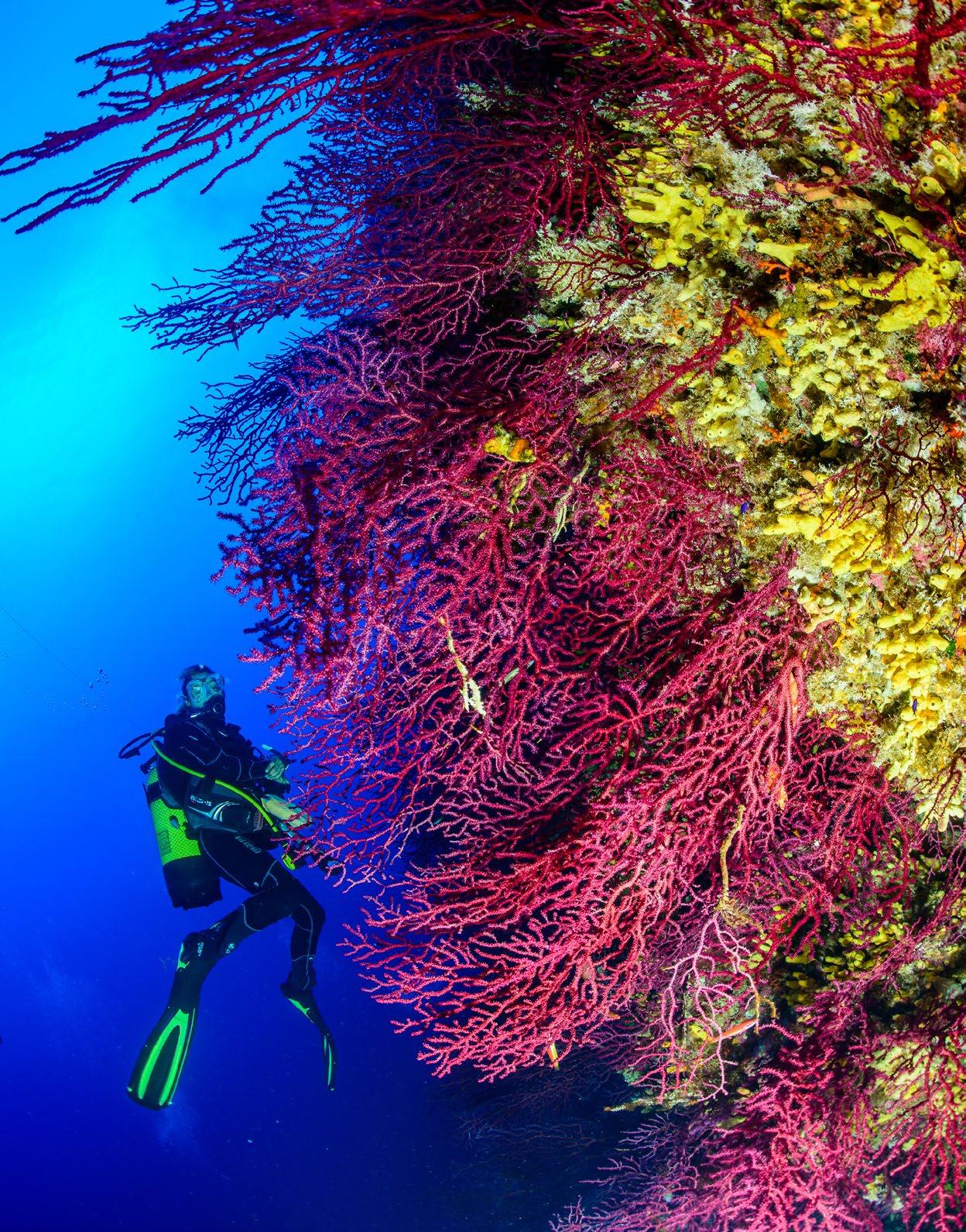


The power of love











The power of love







Ningún viaje a Ibiza está completo sin sumergirse en el patrimonio gastronómico de esta isla transformada por siglos de influencias y recursos. Fenicios, romanos, árabes y catalanes dejaron sus sabores, aromas y técnicas en el recetario de Ibiza, que se descubren a través de rutas gastronómicas por el municipio de Santa Eulària des Riu.
La guía gastronómica Tradición a la Carta, editada por el Ayuntamiento y disponible también en formato descargable en PDF, presenta más de 20 restaurantes especializados en cocina ibicenca, además de ofrecer información y curiosidades sobre recetas tradicionales y productos autóctonos. Gracias al contenido de interés de esta guía, los visitantes pueden sentarse a la mesa del patrimonio gastronómico ibicenco durante su estancia, ya sea durante las vacaciones de verano o en una escapada invernal, pues la mayoría de los restaurantes tradicionales permanecen abiertos en temporada baja.
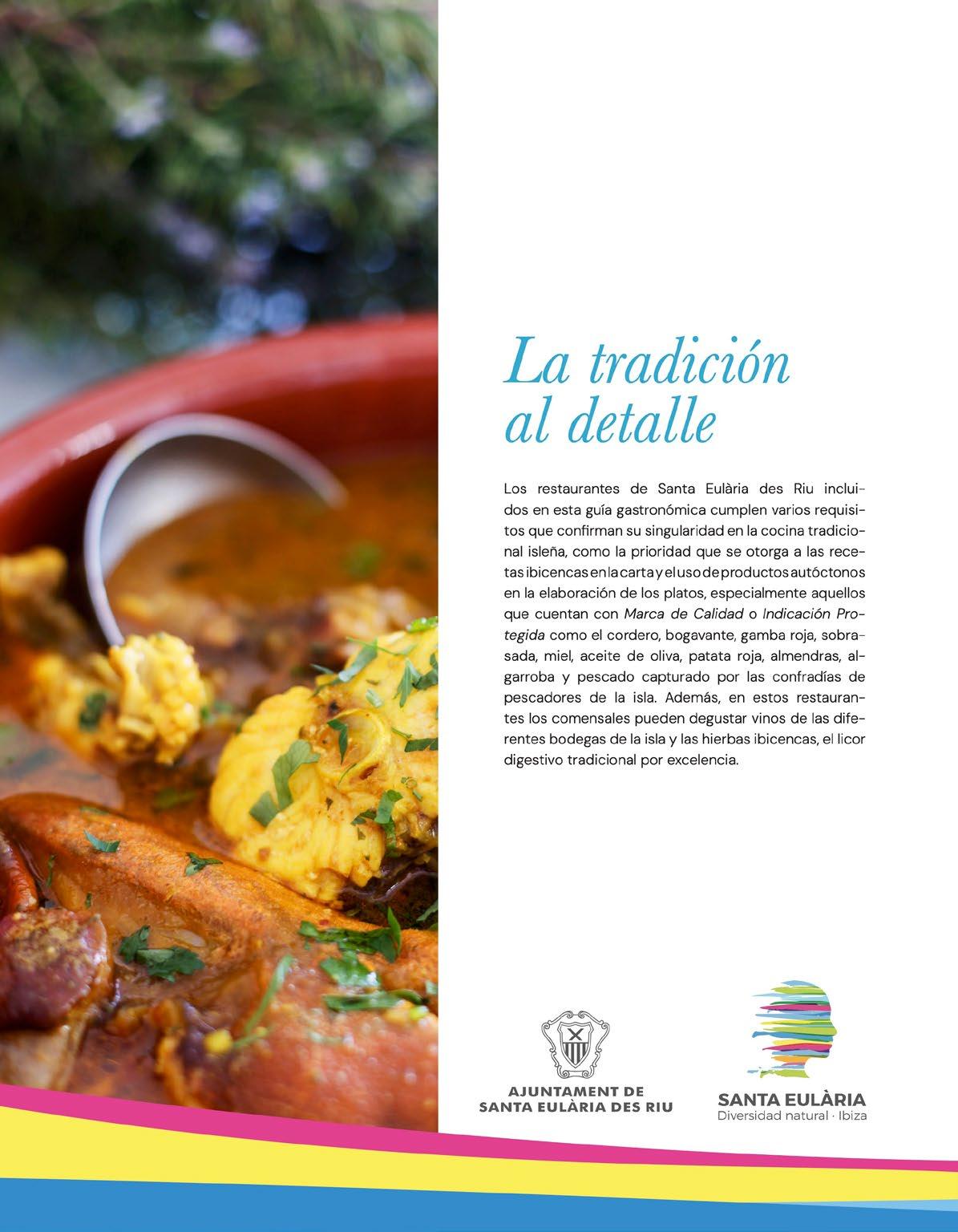



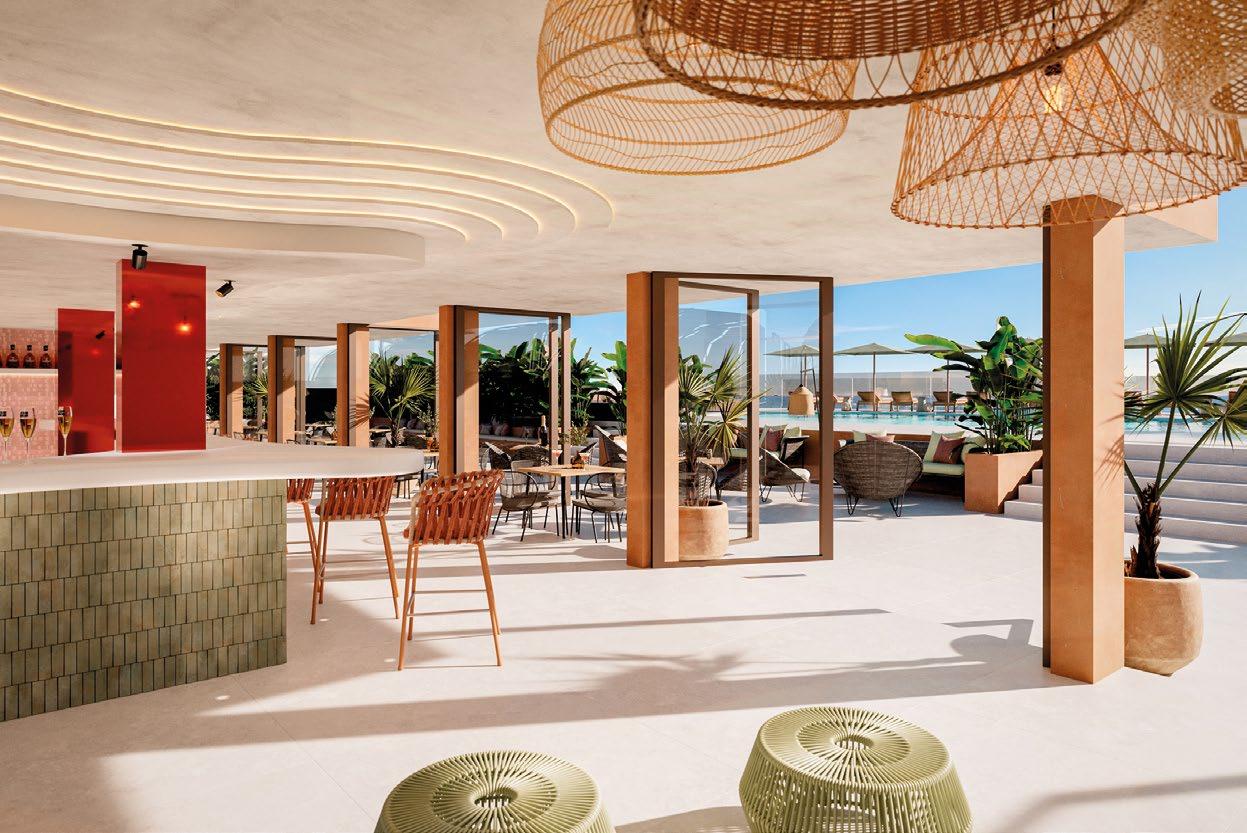

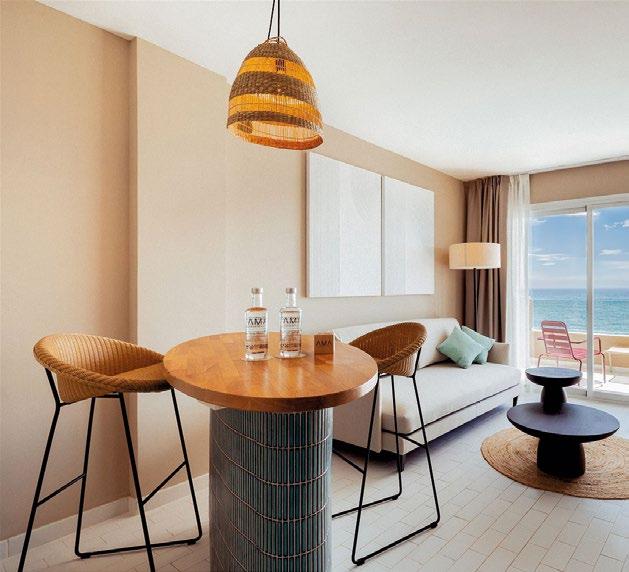

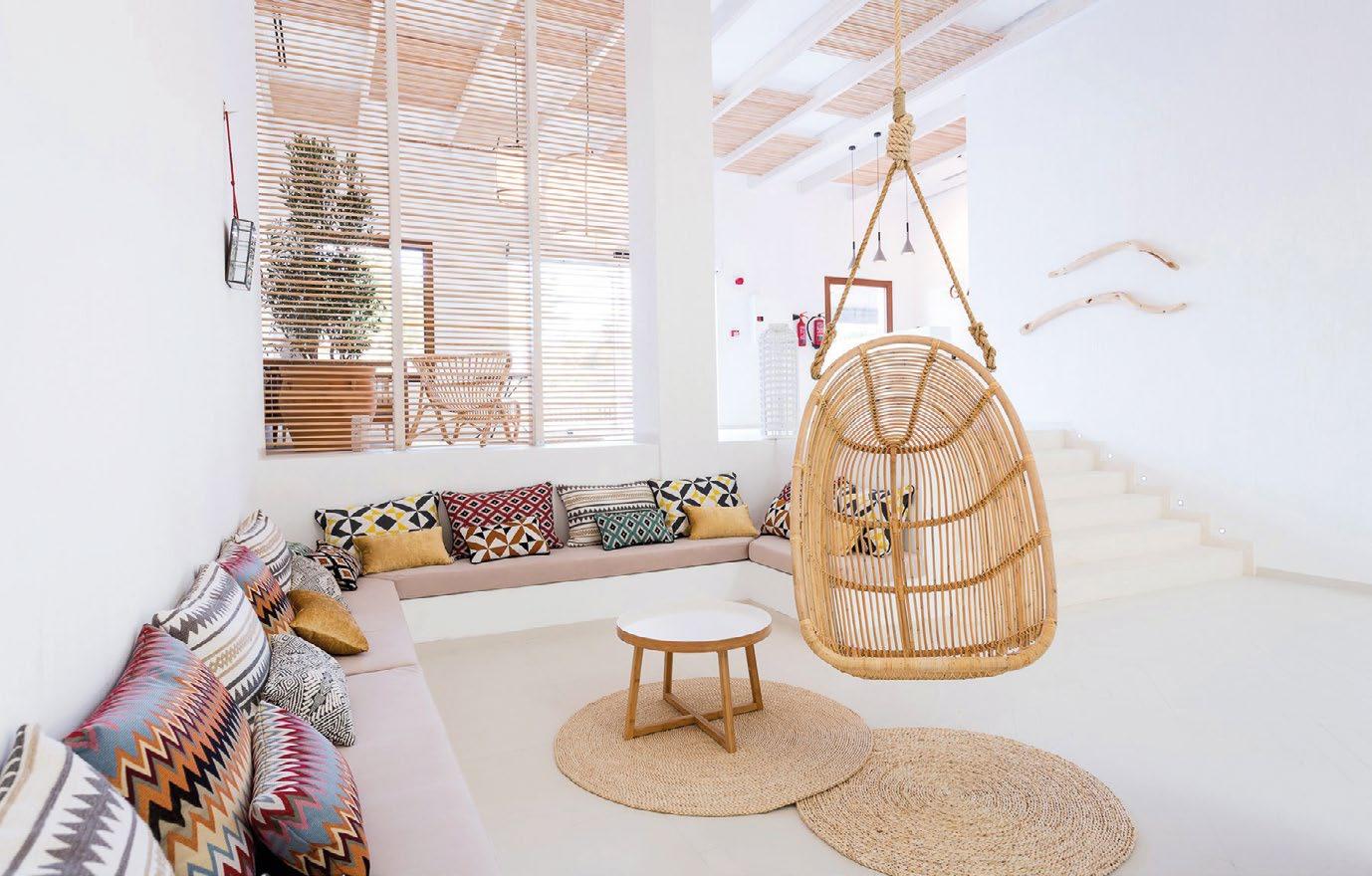

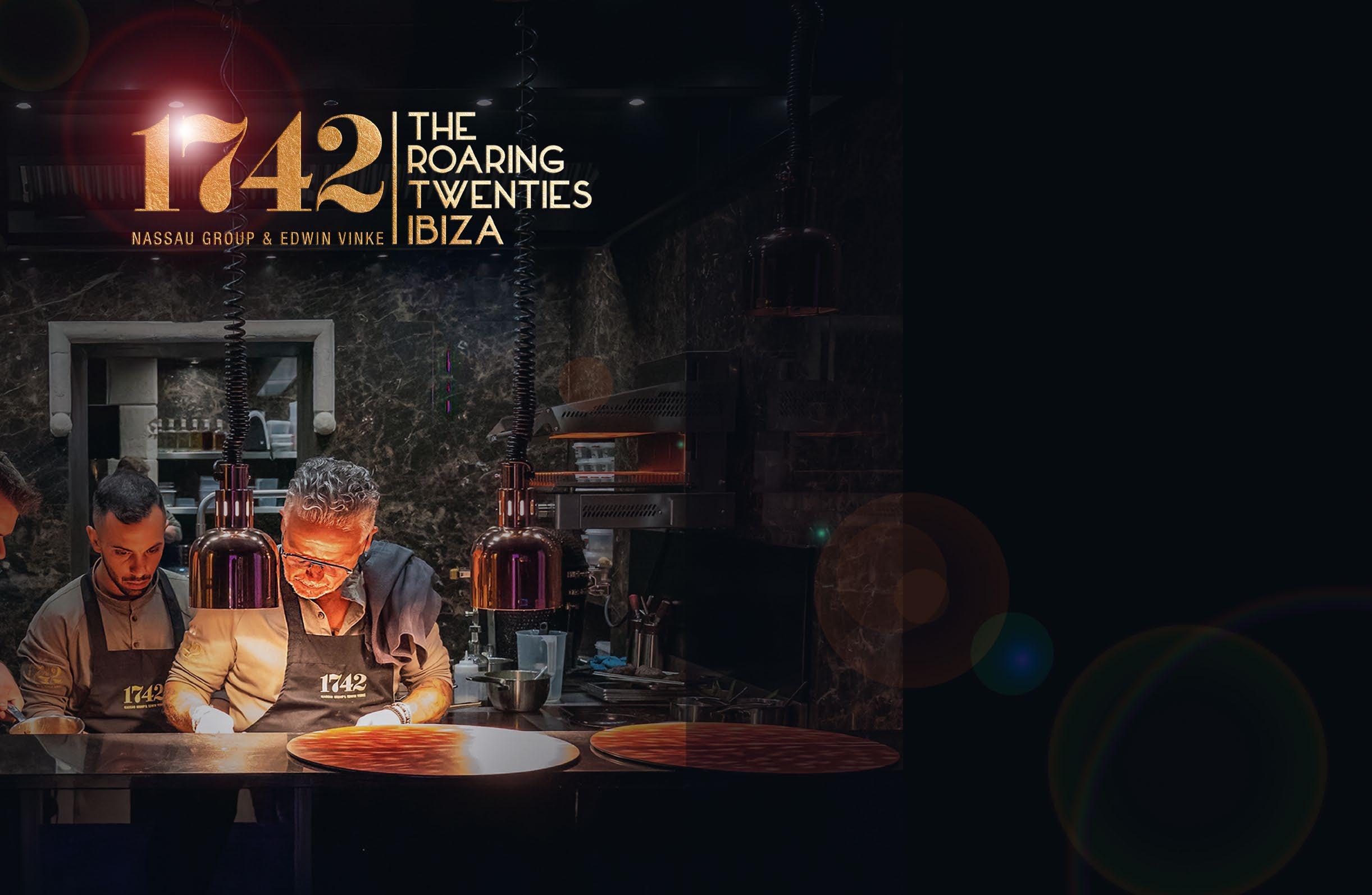

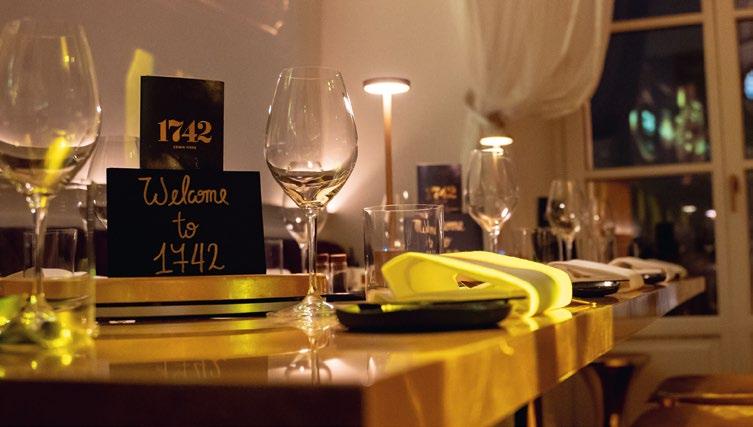




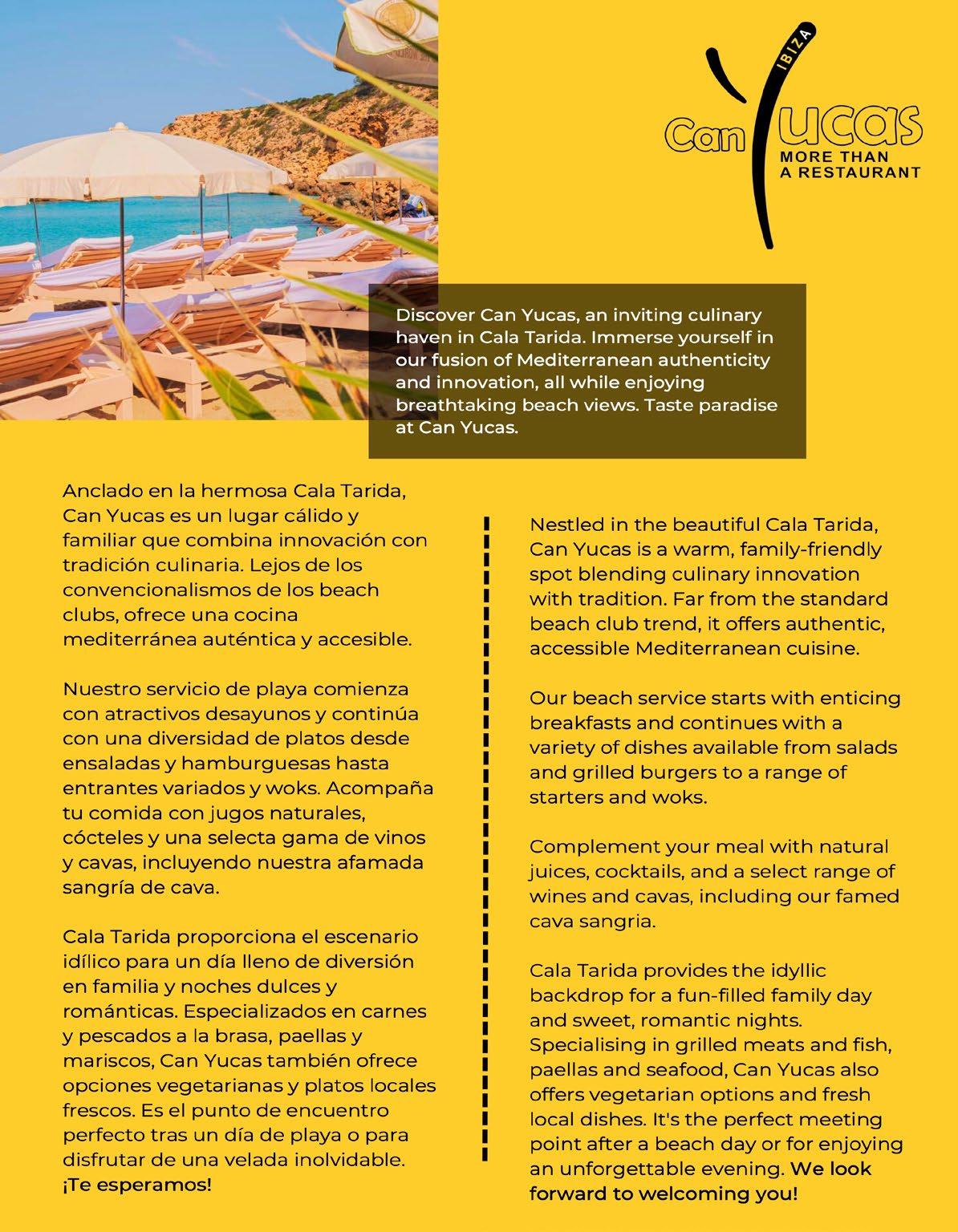
Colaboraciones literarias de Carme Chaparro, Antonio Colinas, Ben Clark, Rodrigo Blanco Calderón, Javier Serapio, Pablo Sierra del Sol y Eva Tur.
VII Premio Internacional de Cuento ‘Las Dalias’
El cortejo animal: entre danzas y mordiscos. Por Cristina Marí. Noviazgos ibicencos: entre susurros y pedradas. Por Cristina Marí. ‘Jo tenc una enamorada’, un himno de amor a la ibicenca. Por Xescu Prats.
Formentera: El encanto de perderse en una isla inimitable. El recetario de amor de las abuelas. Por Antonio Martínez Beneyto. Tortugas y virots: Platos de otros tiempos. Por Felip Cirer.
Las Dalias: La gastronomía multicultural que conquista los sentidos.
PaloSanto: La sorprendente cocina de raíz de Las Dalias. Por Silvia Castillo. Los diez ‘Puntos Gastro’.
Editorial de Moda. AMA.
La historia ilustrada de Las Dalias Por Aura Gold.
Esta es nuestra historia. Por Joan Marí, Juanito de Las Dalias.
Las bodas de antaño. Los banquetes en Las Dalias. Por Pablo Sierra del Sol. Amor a través del tiempo. Parejas icónicas de Las Dalias. Por Pablo Sierra del Sol.
Entrevista a Luisa Reyes. Por Laura Ferrer Arambarri.
Love is in the air… en el Mercadillo. Por Laura Ferrer Arambarri.
Pago a la tierra: “La paz tiene que comenzar en el corazón”. Por L. F. A.
70 años en familia. Los puestos más votados. Por L. F. A.
Una divertida ‘Batalla de Barrios’. Por L. F. A.
Las Dalias on Stage. El placer de escuchar voces sabias y diversas. El Jardín más artístico de Las Dalias. Arte que sale al encuentro.
Premios de Las Dalias. Una historia de cariño y reconocimiento mutuo. El amor también juega en la eternidad. Por Gabriel Molina Marí.
70 años palpitando al ritmo de los tiempos.
Explorando los sonidos de Ibiza Akasha eleva la experiencia electrónica.
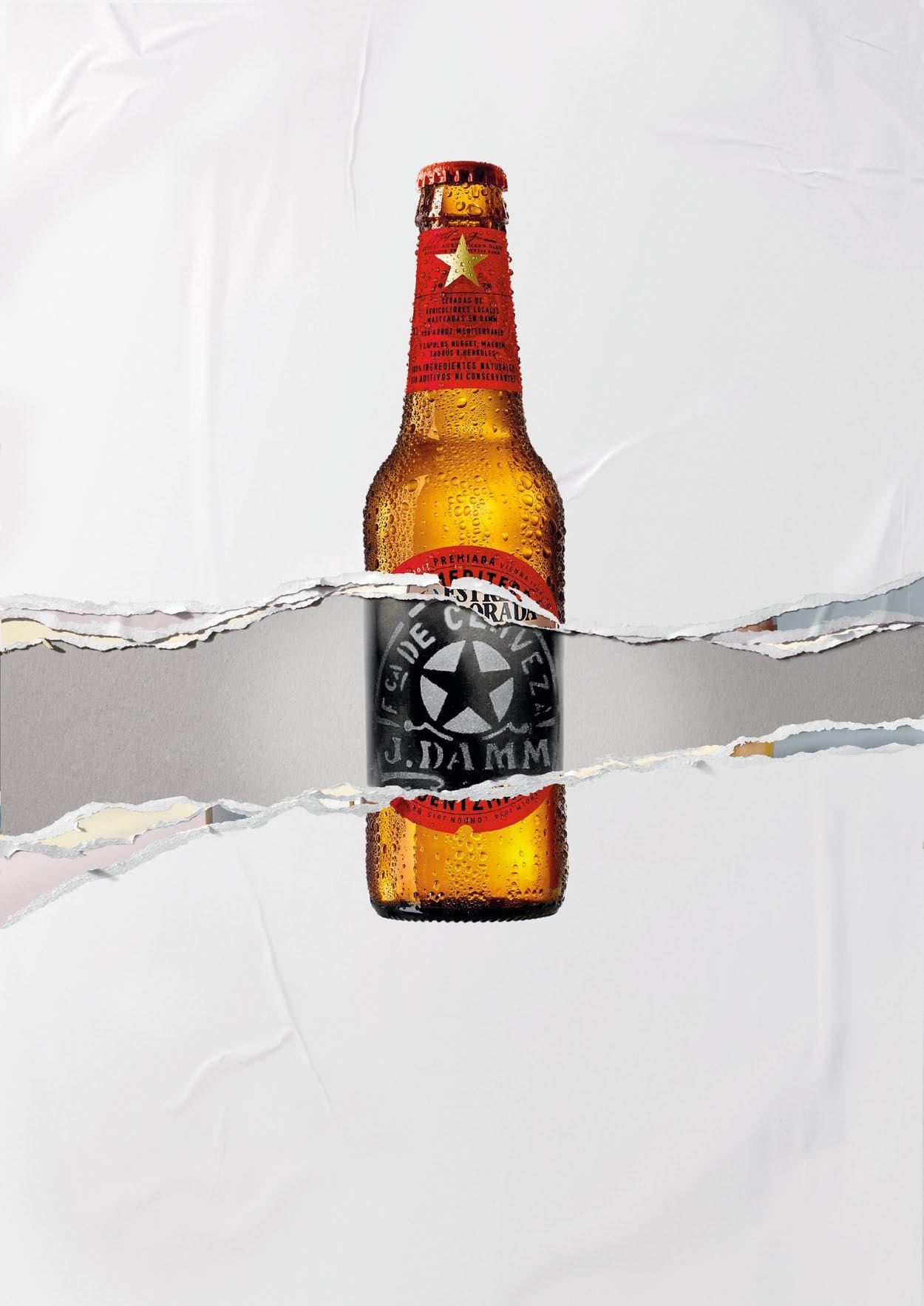
EDITORIAL

Las Dalias llega a su 70 aniversario convertido en un referente nacional e internacional de Ibiza por su mercadillo, único en el mundo, y por su oferta gastronómica y musical.
En 1954, cuando en Ibiza no había ni siquiera un aeropuerto, el agricultor y carpintero Juan Marí Juan tuvo una idea y se puso manos a la obra. Creó Las Dalias pero también fundó, junto a la joven Francisca Juan Juan, una familia que sigue siendo el alma y pilar de la empresa.
LAS DALIAS IBIZA & FORMENTERA MAGAZINE echa la vista atrás para contar esos 70 años de historia de Las Dalias y, a la vez, relata cómo el poder del amor está detrás de cualquier éxito verdadero, auténtico y duradero.
Las Dalias celebrates its 70th anniversary as a national and international landmark in Ibiza, renowned for its market, a unique attraction worldwide, along with its gastronomic and musical offerings.
Back in 1954, when Ibiza lacked even an airport, farmer and carpenter Juan Marí Juan had an idea and set to work. He not only created Las Dalias but also established, with the young Francisca Juan Juan, a family that remains the heart and soul of the company.
LAS DALIAS IBIZA & FORMENTERA MAGAZINE revisits these 70 years of Las Dalias’ history, also reflecting on how the power of love underpins any genuine, enduring success.

70 YEARS OF HISTORY AND A HORIZON FULL OF PROMISE
 Joan Marí, Juanito de Las Dalias Responsable de Las Dalias
Joan Marí, Juanito de Las Dalias Responsable de Las Dalias
Cumplir 70 años de historia me ha llevado a echar la vista atrás para revisar álbumes familiares, repasar las fotografías de la evolución de Las Dalias e investigar cómo fueron aquellos comienzos.
Los relatos de los vecinos de Sant Carles nos transportan a las primeras bodas celebradas en Las Dalias, marcadas por su autenticidad y sencillez, donde el arroz y el sofrit pagès eran los protagonistas, junto a los primeros acordes de los grupos musicales gestados en el calor del bar, que abrió sus puertas un 4 de noviembre de 1954.
Revisitar siete décadas de historia ha sido una experiencia emocionante, desentrañando nuestros orígenes y reconociendo los pilares que nos han llevado hasta aquí. ¿Mi reflexión? Un inmenso trabajo y una gran dosis de amor han sido los motores de esta empresa, y mi padre, un auténtico visionario cuyas ideas aún me asombran.
El pasado nos enseña y nos nutre, pero Las Dalias está arraigada en el presente. Nuestro mercadillo se fortalece con el tiempo, y nuestra oferta gastronómica evoluciona y mejora con cada temporada. Este año, damos la bienvenida a PaloSanto: una propuesta culinaria única en la isla, que reimagina, con una audaz pero respetuosa reforma, el icónico restaurante de Las Dalias. Una innovación que ha sido recibida con los brazos abiertos desde su inauguración, y que vislumbramos con un futuro prometedor.
Porque la palabra “futuro” nos impulsa a no estancarnos, a seguir generando ideas que enriquezcan nuestro legado familiar.
En estas páginas, honramos nuestra historia, valoramos el presente y proyectamos nuestra mirada hacia el futuro. Somos una gran familia, no solo los Marí, sino también los artesanos, los mercadilleros y todo el equipo que da vida a este universo de colores, sabores, aromas, sensaciones y música que es Las Dalias. Y es este espíritu el que nos llena de entusiasmo y optimismo al encarar lo que está por venir.
This 70th anniversary has led me to look back through family albums, to revisit the photos of the history of Las Dalias and to explore those beginnings.
The stories of the local people of Sant Carles take us back to the first weddings that were held at Las Dalias, with their authenticity and simplicity, where rice and sofrit pagès took centre stage. Along with the first chords of the music bands that were conceived in the warmth of the bar, which opened its doors on 4 November 1954.
It was moving to look back over seven decades of history, delving into our origins and identifying the pillars that have brought us to where we are today. My thoughts? An enormous amount of hard work and a great deal of love were the driving forces behind this company, and of course, my father, a true visionary whose ideas continue to amaze me.
The past teaches us and feeds us, but Las Dalias is rooted in the present. Our flea market grows stronger with time, and our culinary range evolves and improves with each season. This year, we’re launching PaloSanto: a unique approach to food on the island, which offers a bold yet respectful recreation of the iconic restaurant of Las Dalias. An innovation that has been welcomed with open arms since its opening, and which we envisage to have a promising future. After all, the word “future” encourages us not to stagnate, but to continue to come up with ideas that enhance our family legacy.
In these pages, we honour our history, we appreciate the present and we look to the future. We are all one big family, not just the Marís, but also the artisans, the vendors and the whole team that breathe life into this world of colours, flavours, aromas, sensations and music that is Las Dalias. And it is this spirit that fills us with passion and optimism as we move forward.


hierbasdeibiza.com
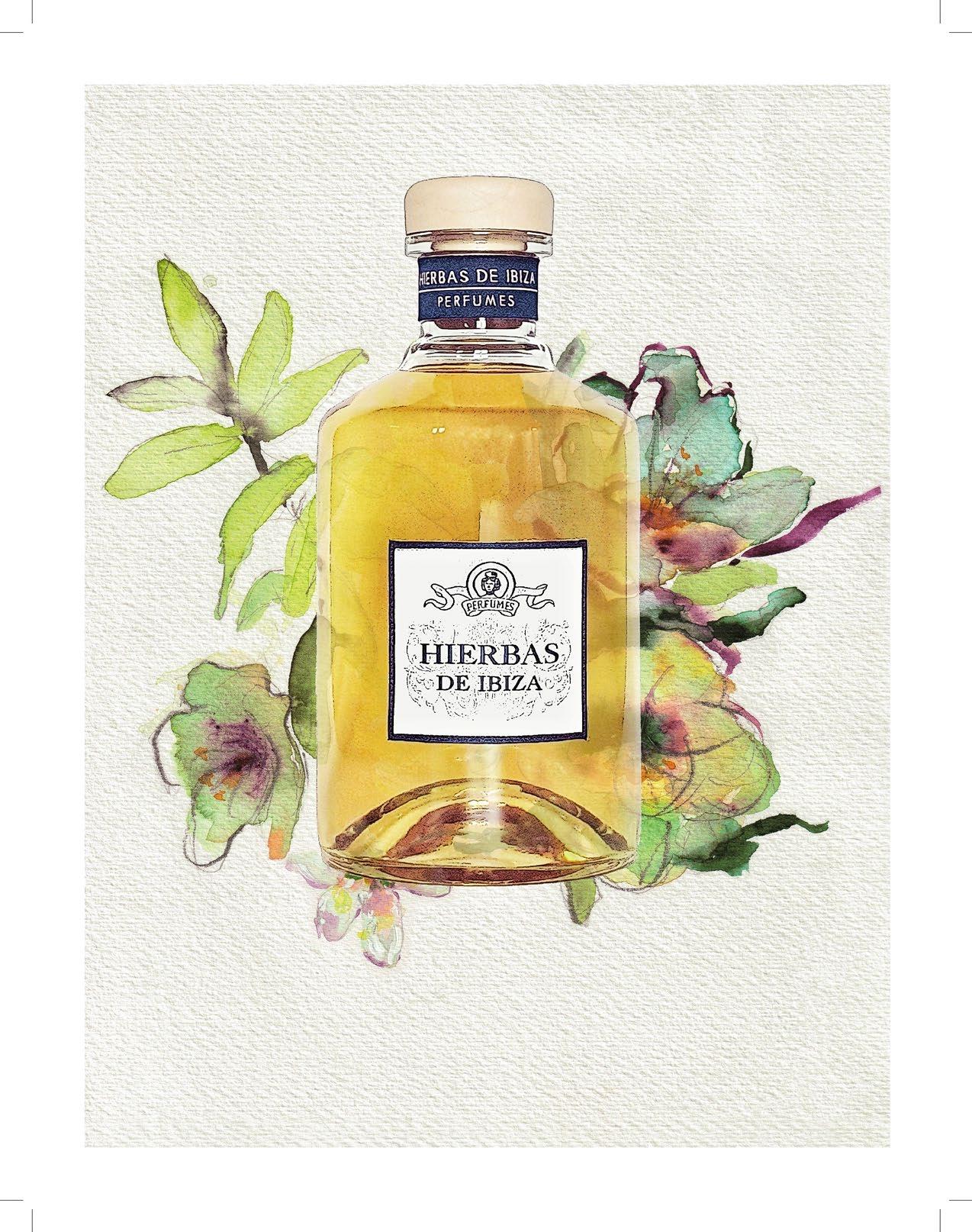


 Vicent Marí Torres
Presidente del Consell Insular d’Eivissa President of Ibiza Island Council
Vicent Marí Torres
Presidente del Consell Insular d’Eivissa President of Ibiza Island Council
La historia de Ibiza la empezaron a escribir aquellas civilizaciones que, buscando un refugio en el Mediterráneo, encontraron un oasis en forma de isla, al que declararon su amor eterno. Un amor que dejó su impronta en forma de patrimonio cultural, como el recinto amurallado de Dalt Vila; de técnicas ancestrales de cuidado y provecho de nuestro campo, que hoy nos dejan un producto local de primera; y de admiración y respeto a nuestro mar, anhelado por su pureza y color cristalino.
Este amor es el mismo que siglos después, a partir de los años 60, permitió a toda una generación de ibicencos prosperar como nunca antes había hecho, creando pequeños negocios que, con mucho esfuerzo, respeto y desde la convivencia, mostraron al mundo los infinitos motivos por los que enamorarse de una isla que los más afortunados hemos conocido, y que los más jóvenes intentan revivir a cada pincelada que dan en nuestro pequeño y frágil paraíso.
Por todo ello, hoy más que nunca debemos poner en valor estos negocios, como el que iniciaron en 1954 Juan y Francisca, que cada día nos evocan a una Ibiza que fue y que soñamos con volver a encontrar.
¡Muchas felicidades, Las Dalias, por estos 70 años, y a seguir transmitiendo el amor por nuestra isla que habéis mostrado desde el primer día!
Ibiza’s history was first written by civilisations that, seeking refuge in the Mediterranean, found an oasis in the form of an island to which they declared their eternal love. A love that left its mark in the form of cultural heritage, such as the walled enclosure of Dalt Vila, and also ancestral techniques to work and look after our land, resulting in today’s first-class local produce, as well as an admiration and respect for our sea, sought after for its purity and crystalline colour.
This love is the same as the love that, centuries later, from the 1960s onwards, enabled a whole generation of Ibizans to prosper as never before, creating small businesses that, with hard work, respect and unity, showed the world the countless reasons to fall in love with an island which the luckiest among us have known and which younger people try to relive with every brushstroke they make in our small and fragile paradise.
For all these reasons, today more than ever we must value these businesses, such as the one started up in 1954 by Juan and Francisca. Businesses which, every day, remind us of the Ibiza that was and which we dream of finding again.
Many congratulations, Las Dalias, for these 70 years, and let’s continue conveying the love for our island that you’ve demonstrated since the very first day!
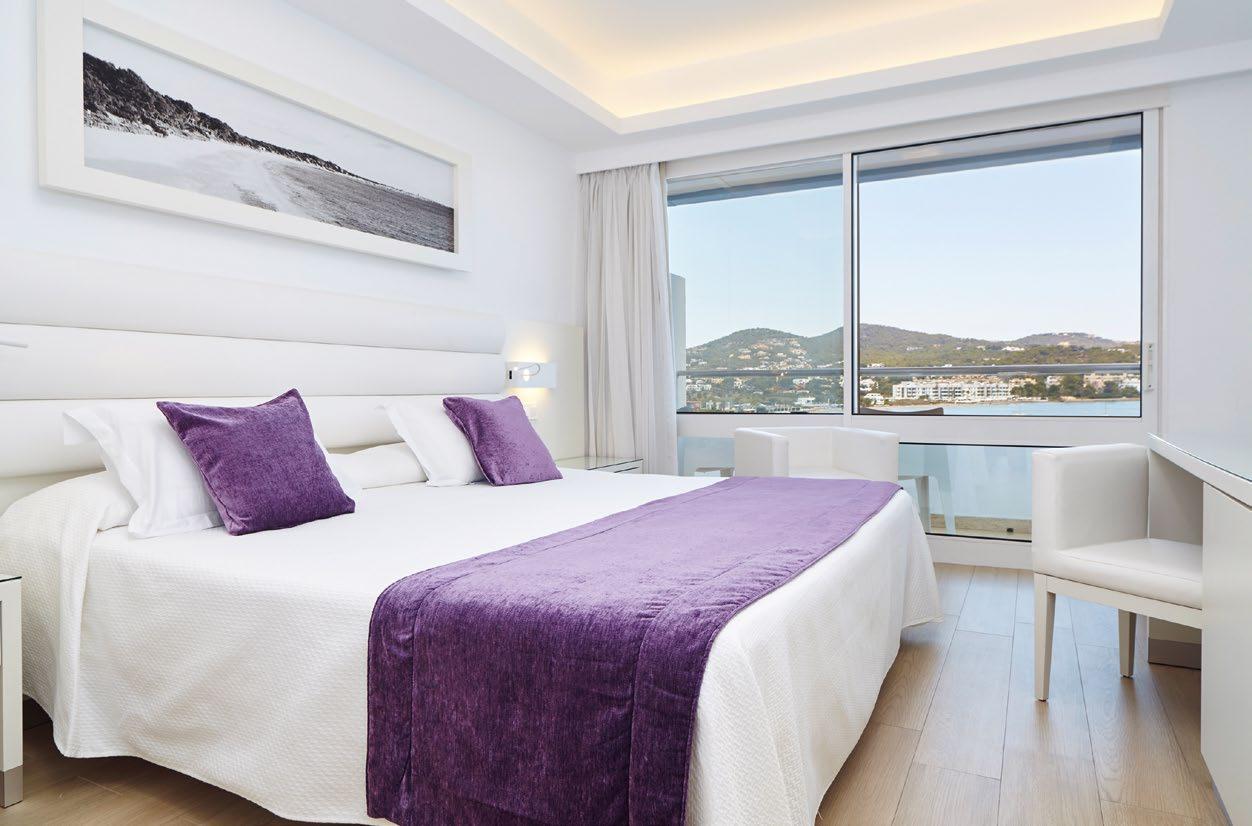

Las Dalias representa mucho más que un referente de artesanía que marca tendencia a nivel mundial, ya que desde hace décadas se ha convertido en un auténtico punto de encuentro de almas libres y corazones curiosos. El arte y la creatividad protagonizan los pasillos convirtiéndolos en galerías de arte al aire libre en un vibrante ambiente de colores, formas, texturas y música en vivo.
Aquí, los artesanos y artistas locales comparten sus creaciones con el mundo a través de objetos que tienen su propia historia, su propia alma y que invitan a sumergirnos en un universo de imaginación.
Este emblemático rincón de Sant Carles de Peralta alberga el auténtico espíritu de libertad y autenticidad, y honra al pueblo de Santa Eulària haciendo de embajador de su belleza y grandeza, y nos recuerda que el arte reside en la forma en que vivimos nuestras vidas.
Durante décadas el mercado de Las Dalias ha reunido personas de todas las edades y rincones del mundo, cautivadas por su filosofía de vida basada en el respeto hacia nuestro entorno, hacia los demás y hacia uno mismo, en un enriquecedor espacio de diversidad que, sin duda, contribuye al crecimiento personal.
Les invito a sumergirse en esta experiencia única, a descubrir cada curiosidad y a dejarse embriagar por este espíritu inspirador. Gracias a todas las personas que formáis parte y que hacéis realidad este mágico mercado, año tras año.
Las Dalias is far more than a worldwide trendsetter in artisan crafts. For decades, it has been a point of encounter for free souls and inquisitive hearts. Art and creativity take centre stage in the walkways here, turning them into open-air art galleries in a vibrant atmosphere of colours, shapes, textures and live music.
Here, the local craftworkers and artists share their creations with the world through objects with a history of their own, a soul of their own; items that invite us to immerse ourselves in a whole world of imagination.
This emblematic little corner of Sant Carles de Peralta embodies the true spirit of freedom and authenticity, honouring the town of Santa Eulària by serving as an ambassador of its beauty and magnificence, and reminding us that in fact, art resides in the way we live our lives.
For decades, the Las Dalias flea market has brought together people of all ages and from every corner of the world, captivated by its ethos of life based on respect for our environment, for others and for ourselves, in a stimulating place of diversity that undeniably fosters personal growth.
I invite you to immerse yourselves in this unique experience, to discover all its hidden gems and to soak up this inspiring spirit. Many thanks to all of you who form part of this magical place and who make it happen, year after year.



Sustainable and e cient gardening for villas and exclusive residences on the island of Ibiza.

Jardinería e ciente y comprometida con el entorno, para villas y residencias exclusivas en la isla de ibiza.

Rafael Triguero
Alcalde d’Eivissa
Mayor of Eivissa
Como alcalde de Eivissa, me siento profundamente honrado de celebrar junto a todos vosotros el 70º aniversario de Las Dalias, un verdadero emblema de nuestra isla. Desde su humilde origen en 1954 como un pequeño bar de pueblo, esa pista de baile de Las Dalias ha crecido hasta convertirse en un referente cultural, artístico y artesanal tanto a nivel nacional como internacional.
Este aniversario no es solo un hito en la historia de Las Dalias, sino también un testimonio del poder del talento y la pasión, valores que han sido la esencia detrás de cada proyecto duradero que hemos visto florecer en nuestra isla. La historia de Juan Marí Juan y Francisca Juan Juan, fundadores de Las Dalias, y la continuación de su legado a través de la siguiente generación, reflejan un compromiso inquebrantable con la familia, los artesanos, los artistas y los vecinos, pilares que sostienen el espíritu de Eivissa.
Como ciudadano de Eivissa, reitero mi felicitación y reconocimiento a Las Dalias, que no solo preserva nuestra cultura única, sino que también promueve la innovación, el arte y la ctreatividad, aspectos cruciales para el futuro sostenible de nuestra querida isla.
Celebremos juntos este maravilloso momento, cuidemos su legado y sigamos fomentando un futuro donde la tradición, el arte y la innovación se entrelacen. Felicidades, Las Dalias, por setenta años de amor, pasión y comunidad.
As the Mayor of Eivissa, it is a great honour for me to celebrate with you all the 70th anniversary of Las Dalias, a truly emblematic landmark on our island. From its humble beginnings in 1954 as a small village bar, that original dance floor of Las Dalias has grown to become a paragon for culture, art and craftwork, both nationally and internationally.
This anniversary is not only a milestone in the history of Las Dalias, but also a testament to the power of talent and passion, values that have formed the essence of every enduring project that we have seen flourish on our island. The story of Juan Marí Juan and Francisca Juan Juan, the founders of Las Dalias, and their ongoing legacy through the following generation of their family, reflect an unwavering commitment to family, artisans, artists and the local residents, all of whom are pillars that uphold the spirit of Eivissa.
As a resident of Eivissa, once again I would like to extend my congratulations and appreciation to Las Dalias, which not only preserves our unique culture, but also promotes innovation, art and creativity, which are vital for the sustainable future of our beloved island.
Let us celebrate this wonderful moment together, let us nurture and look after their legacy and continue to foster a future where tradition, art and innovation coalesce. Congratulations, Las Dalias, on seventy years of love, passion and community!



Estimados amigos,
La cultura ibicenca y sus tradiciones son un bien inmaterial que no debemos dejar perder. La isla que hoy en día acoge a millones de turistas, gracias a un patrimonio que nos hace únicos, no sería la misma sin las raíces que décadas atrás sembraron nuestros antepasados. Por suerte, ya bien inmersos en el siglo XXI, los ibicencos nos sentimos muy orgullosos de poder seguir mostrando a nuestros visitantes quiénes somos y de dónde venimos.
En este sentido, Las Dalias es uno de los mejores ejemplos. Cómo el amor y la perseverancia de una gran familia a lo largo de muchas décadas ha logrado convertir un pequeño negocio en un referente, sin perder un ápice de su esencia. Porque nadie puede dudar que el mercadillo es sinónimo de una artesanía, una gastronomía y, en definitiva, toda una cultura que emana del espíritu de Juan Marí Juan y Francisca Juan Juan, sus fundadores.
Las Dalias, como otros tantos mercadillos artesanales que tenemos la suerte de poseer el resto de municipios de la isla, son una de nuestras mayores riquezas. Un escaparate de nuestro presente y un espejo de nuestro valioso pasado. Por eso, en la celebración de este 70º aniversario quiero aprovechar para desear larga vida a Las Dalias y agradecer, de corazón, a todos los que lo hacéis posible.
Dear Friends,
Ibiza’s culture and traditions are an intangible asset that we must preserve. The island that currently welcomes millions of tourists thanks to a heritage that makes us unique, would not be the same without the roots cultivated by our ancestors decades ago. Fortunately, today, well into the 21st century, as Ibizans we are very proud to continue to show our visitors who we are and where we come from.
In this sense, Las Dalias is a prime example of the way the love and perseverance of a large family over the course of many decades has succeeded in turning a small business into a landmark, while never giving up one iota of its essence. Because no-one can deny that the flea market is synonymous with a craftsmanship, a gastronomy, and in a word, an entire culture that emanates from the spirit of its founders, Juan Marí Juan and Francisca Juan Juan.
Like so many other craft markets that we are lucky enough to have in the other towns on the island, Las Dalias is one of our greatest treasures. A showcase of our present and a mirror of our rich past. For this reason, as we celebrate this 70th anniversary, I want to take this opportunity to wish Las Dalias a long life and to extend my heartfelt thanks to all of you who make it possible.


LAS DALIAS HAS REMAINED THE ICONIC BEACON OF HIPPIE IBIZA
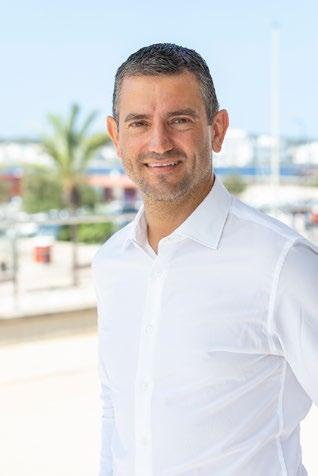
Marcos Serra Colomar
Alcalde de Sant Antoni de Portmany
Queridos lectores,
Es una alegría poder dirigirme a todos vosotros por la celebración del 70 aniversario de la fundación de Las Dalias en 1954.
Bajo el lema ‘The power of love’ se reivindica en este número el amor y la pasión como pilares fundamentales de los proyectos duraderos. Las Dalias ha perdurado como el faro de la Ibiza hippie por el amor y la pasión que han impulsado el proyecto desde sus inicios. Primero, gracias a sus fundadores, Juan Marí y Francisca Juan, y, después, por el trabajo de la familia Las Dalias y su equipo.
De este modo, con los años, el mercadillo y la atmósfera de Las Dalias se han convertido en algo reconocido internacionalmente por su calidad, variedad y originalidad, un referente que atrae visitantes de todas las partes del mundo y que supone un atractivo para la isla.
Os deseo de corazón que esta aventura perdure en el tiempo. Las Dalias es un tesoro y su mensaje es muy valioso; un lugar donde la pasión, la leyenda y la creatividad se dan la mano para ofrecer una experiencia singular y genuina de la Ibiza alternativa.
¡Feliz 70 aniversario y que el poder del amor siga guiando vuestros pasos!
Dear Readers,
I am delighted to write to all of you in celebration of the 70th anniversary of the founding of Las Dalias in 1954.
Under the slogan “The power of love”, this issue champions love and passion as the cornerstones of lasting projects. Las Dalias has continued to be the beacon of hippie Ibiza thanks to the love and passion that have driven this project since its very beginnings. Initially, thanks to its founders, Juan Marí and Francisca Juan, and later, thanks to the work of the Las Dalias family and their team.
As a result, through the years, the Las Dalias flea market and atmosphere have become internationally renowned for their quality, diversity and originality, a point of reference that attracts visitors from all around the world and that has become a major allure for the island.
It is my heartfelt wish to see this adventure last for a long time to come. Las Dalias is a treasure with a very valuable message; a place where passion, legend and creativity come together to offer a unique and genuine experience of the alternative Ibiza.
Happy 70th anniversary, and may the power of love continue to guide your path!
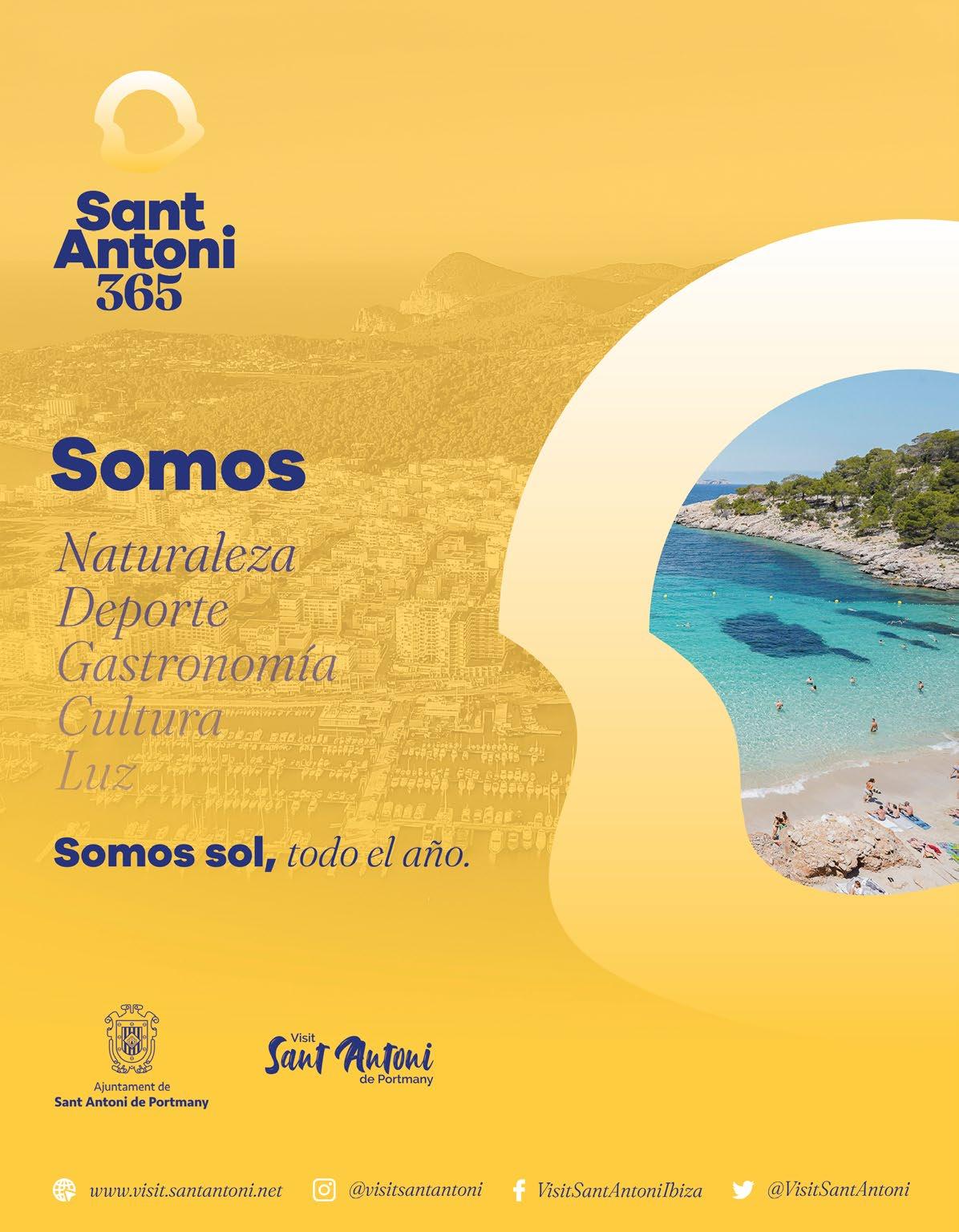





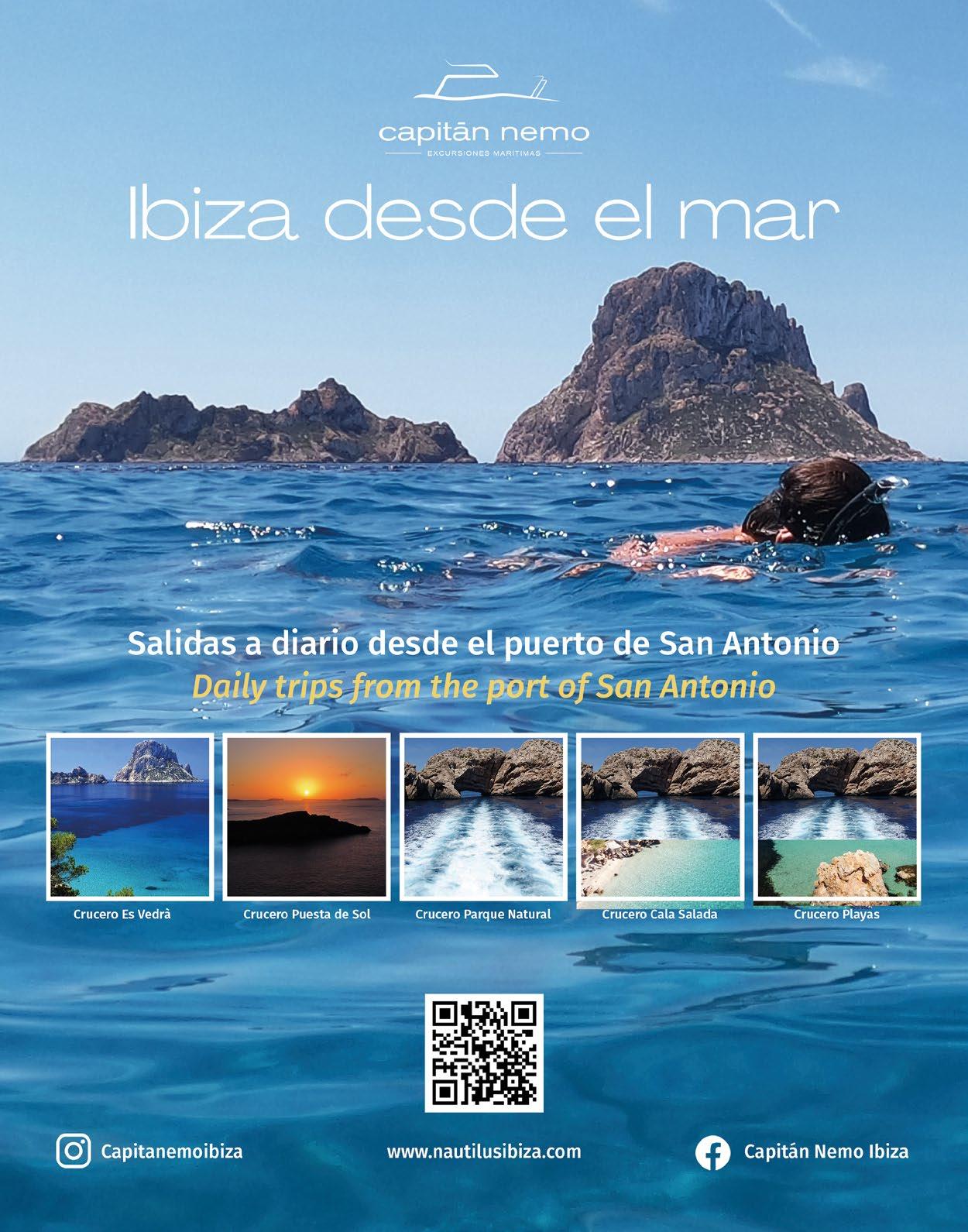
—Mira, ya se va el sol hacia España.
Pero el sol, flotando sobre las aguas del Mediterráneo, todavía saca fuerzas para iluminar unos minutos más la costa del Líbano, haciendo brillar los rascacielos de Foster y Bofill erguidos con insolencia sobre Beirut, un resto de vasija fenicia que la marea ha dejado al descubierto en una playa de Tiro, o la cucharilla con la que remueve el té exageradamente dulce un mercader sentado en el puente que une la ciudad de Sidón con su Castillo Cruzado del Mar.
—Look, the sun’s leaving for Spain.
But floating over the waters of the Mediterranean, the sun still finds the strength to light up the coast of Lebanon for a few minutes more, illuminating the Foster and Bofill skyscrapers that tower insolently over Beirut, casting its reflection on a remnant of a Phoenician vessel exposed by the tide on a beach in Tyre, and gleaming on the teaspoon used by a merchant to stir his overly sweet tea, while sitting on the bridge that connects the city of Sidon with its Sea Castle.

Mira, ya se va el sol hacia España, repite ella, sentada en el balcón de su casa en Beirut, con las piernas sobre la barandilla, fumando un cigarro a caladas lentas y pegajosas que paren pequeñas nubes sobre el agua; o tomando café negro y espeso en cualquier bar de la Corniche, con la silla siempre, siempre, mirando hacia el oeste; o caminando con pasos suaves y descalzos por la playa de Ramlet al-Baida mientras escucha cómo las olas del Mediterráneo se van oscureciendo poco a poco.
Y MIENTRAS LO DICE, ALREDEDOR DE SUS OJOS SE FORMAN UNAS PEQUEÑAS ARRUGAS LLENAS DE SAL EN LAS QUE ACUMULA LOS RECUERDOS DEL AGUA DE UNA PLAYA DE IBIZA
Mira, ya se va el sol hacia España. Y el sol, cada vez más naranja hasta derretirse en un azul cada vez más negro, se sumerge en el Mediterráneo para brotar al otro lado, en la España que ella añora y a la que quisiera llegar aunque fuera a nado, aunque fuera tragando y escupiendo agua salada, aunque fuera agotada hasta no poder hacer otra cosa que besar la primera playa y caer rendida en la arena húmeda, con el cuerpo extasiado y los brazos y las piernas encogidos en posición fetal, latiendo al ritmo del agua que va mojándola con el empuje de cada ola.
Mira, ya se va el sol hacia España. Y mientras lo dice, alrededor de sus ojos se forman unas pequeñas arrugas llenas de sal en las que acumula los recuerdos del agua transparente y baptismal de una playa de Ibiza, del beso robado bajo el arco de Sa Portella, de los sueños soñados —que entonces todavía podían cumplirse— mientras dejaba vagar la vista y el corazón desde el mirador de la plaça de la Catedral.
Look, the sun’s leaving for Spain, she repeats, sitting on the balcony of her home in Beirut, with her legs over the railing, smoking a cigarette with slow, sticky puffs that release little clouds over the water; or drinking thick, black coffee in any of the bars along the Corniche, with her chair always, always, facing west; or walking with gentle, barefoot steps along the beach of Ramlet al-Baida as she listens to the waves of the Mediterranean gradually grow darker and darker.
Look, the sun’s leaving for Spain. And the sun, growing more and more orange until it melts into an increasingly blacker blue, sinks into the Mediterranean to emerge on the other side, in the Spain that she longs for and dreams of reaching, even if it would mean swimming, even if it would mean swallowing and spitting up saltwater, even if it would mean she’d reach such a point of exhaustion that she could do nothing but kiss the first beach and collapse on its wet sand, her body ecstatic, her arms and legs curled into a foetal position, pulsing to the rhythm of the water that washes over her with the surge of each wave.
LOOK, THE SUN’S LEAVING FOR SPAIN. AND THE SUN, GROWING MORE AND MORE ORANGE UNTIL IT MELTS INTO AN INCREASINGLY BLACKER BLUE, SINKS INTO THE MEDITERRANEAN TO EMERGE ON THE OTHER SIDE
Look, the sun’s leaving for Spain. And as she says it, small wrinkles full of salt form around her eyes, where she accumulates the memories of the crystal-clear baptismal water of a beach on Ibiza, of the stolen kiss beneath the arch of Sa Portella, of the dreams she’d dreamt—and that could still come true back then— as she allowed her eyes and her heart to wander from the viewpoint of the Plaça de la Catedral.

Mira, ya se va el sol hacia España. Ella ya no llora, solo a veces. Ya no tiene pesadillas, aunque alguna madrugada sí. Ya no le queda esperanza, pero no termina de perderla.
ELLA YA NO LLORA, SOLO A VECES.
YA NO TIENE PESADILLAS, AUNQUE ALGUNA MADRUGADA SÍ. YA NO
LE QUEDA ESPERANZA, PERO NO TERMINA DE PERDERLA
Ya se va el sol hacia España, suspira este último atardecer de su vida. Ya se va el sol al otro lado de ese mar que lleva tantos años separándola de casa, al otro lado de esas aguas que ama y que odia, al otro lado unas olas que nunca la transportaron de vuelta. Ya se va el sol, pero hoy se va ella también, poco a poco, con dulzura, sonriendo, esta vez sí, mientras saluda por última vez al atardecer, imaginando un último día lo que hay más allá, cerrando los ojos y sintiendo como cada fotón de luz que toca su piel la recoge y la transporta, brillando sobre la superficie del Mediterráneo, exactamente 1752.28 millas náuticas, hasta su playa preferida de Ibiza.

Look, the sun’s leaving for Spain. She doesn’t cry anymore. Only sometimes. She doesn’t have nightmares anymore, although she does every now and then in the middle of the night. She no longer has hope, but she hasn’t completely lost it.
The sun’s leaving for Spain, she sighs on this last sunset of her life. The sun is leaving, it’s going over to the other side of the sea that has separated her from home for so many years, to the other side of those waters that she loves and hates, to the other side of the waves that never brought her back. The sun is leaving, but today she too is leaving, little by little, gently, smiling, this time she’s really leaving, as she bids the sunset farewell one last time, imagining, one last day, what lies beyond, closing her eyes and feeling the way each photon of light that touches her skin scoops her up and carries her, shimmering over the surface of the Mediterranean, exactly 1752.28 nautical miles, to her favourite beach on Ibiza.
THE SUN IS LEAVING, BUT TODAY SHE TOO IS LEAVING, LITTLE BY LITTLE, GENTLY, SMILING, THIS TIME SHE’S REALLY LEAVING, AS SHE BIDS THE SUNSET FAREWELL ONE LAST TIME
Carme Chaparro es una reconocida y premiada periodista, presentadora y editora en informativos y programas de televisión. Recibió el Premio Primavera de Novela 2017 por No soy un monstruo. Chaparro ha publicado novela, ensayo y literatura infantil. Su última novela es Castigo Carme Chaparro is a renowned and award-winning journalist, presenter and editor for news and television programmes. She received the Primavera Prize for Novels in 2017 for her No soy un monstruo and has published novels, essays and children’s literature. Her latest novel is titled Castigo






Verdor inmenso y húmedo del prado que rodea la gruta en la montaña. Músicas en el valle y una extraña turbulencia de fuentes y arbolado.
El muro está grumoso y deshojado, al bosque lo amordaza la maraña y al son pagano, oscuro, de un caña danza beodo el fauno coronado.
Yo aquí arriba ensoñando la hermosura de la casa y sus cedros centenarios. En la tarde sombría, como llama,
ebria de lluvia, música y verdura, la muchacha persigue imaginarios pájaros, mientras Baco se derrama.
(Earth)
Immense and humid green of the meadow that surrounds the mountain’s hollow. Music in the valley and a strange turbulence of fountains and trees.
The wall is unsmooth and leafless, the forest is silenced by the thicket and to the pagan, dark sound of a reed the merry horned faun dances.
And I’m up here dreaming of the beauty of the house and its timeless cedars. In the gloomy afternoon, as it shouts,
drunk with rain, music and green, the girl chases make-believe birds, while Bacchus spouts.

Me llamaste en la noche y yo dormía. Dormía, mas logré sentirte al lado de mi cuerpo y creía que soñaba. Soñase o durmiese me llamaste
dulcemente en la noche en que velaba. Sí, velaba, temblaba, me salía de mí cuando en la noche susurrabas, aunque sólo durmiese y te soñase.
Sólo sé… no sé nada; sólo creo que quizás eras tú quien me soñaba poniendo yo mis labios en los tuyos.
Sólo sé que brotaste de lo oscuro, sólo sé que entreabriste mis tinieblas como una luz que hablase a mis silencios.
II (Dream)
You called me at night and I was sleeping. I slept, but I managed to feel you next to my body, and I thought I was dreaming.
In my dreams or in my sleep, you called me sweetly in the night while I lay awake.
Yes, I lay awake, I trembled, I left myself when you whispered in the night, even if I only slept and dreamed of you.
All I know… I know nothing; I just believe that maybe it was you who dreamed of me placing my lips on yours.
I only know that you arose from the dark, I only know that you opened my darkness like a light that spoke to my silences.

Si reclinases tu cabeza en mi hombro, si mi mano buscase tu cintura, si posase mi frente en tus rodillas, si tu brazo en mi cuello descansara,
si mis dedos rozaran tus dos labios, si sintieses tus pechos en mi espalda, si la carne del uno se durmiese en la carne del otro y tus cabellos
cantasen en mis ojos su caricia, si bajaras a mí como una luna y yo subiese a ti como un ocaso,
si sintiese la eternidad sublime de ver cómo dos cuerpos sólo son un cuerpo, un vientre, un fuego y un abismo.

If you would rest your head on my shoulder, if my hand looked for your waist, if I placed my forehead on your lap, if your arm rested on my neck,
if my fingers caressed both your lips, if you felt your breasts on my back, if the flesh of one fell asleep in the flesh of the other and your hair
sang its gentle touch in my eyes, if you descended on me like a moon and if I rose to you like a sunset,
if I felt the sublime eternity of seeing how two bodies are only a body, a womb, a fire and an abyss.
Translation by Ben ClarkAntonio Colinas es un poeta, narrador, ensayista, traductor y crítico literario leonés que vivió más de 20 años en Ibiza, isla a la que sigue vinculado. Ha recibido el Premio Nacional de Literatura y el Reina Sofía de Poesía Iberoamericana, entre otras muchas distinciones. Es Doctor honoris causa por la Universidad de Salamanca e impulsor de La Casa de la Poesía - Fondo Cultural Antonio Colinas de La Bañeza. Antonio Colinas is a poet, storyteller, essayist, translator and literary critic from León who lived in Ibiza for over 20 years and remains deeply connected to the island. Among many other honours, he has received the Spanish National Prize for Literature and the Reina Sofía Prize for Ibero-American Poetry. He holds an Honorary Doctorate from the University of Salamanca and he is the driving force behind La Casa de la Poesía - Fondo Cultural Antonio Colinas in La Bañeza.

Salidas diarias desde Figueretas y Playa d´en Bossa
Daily trips from Figueretas and Playa d´en Bossa



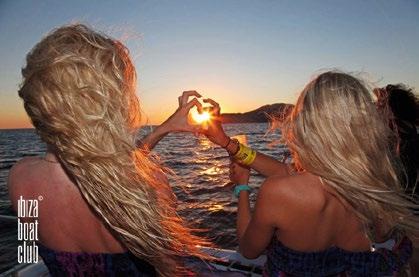


WITHOUT LOVE (WHERE WOULD YOU BE NOW?)
Ben Clark Untaltoni T INací porque alguien puso el dedo sobre un mapa y dijo “Aquí”. Ese dedo aterrizó en el azul, sobre la pequeña, diminuta mancha verde que flotaba en el azul. Ibiza, tan mal pronunciada por mis padres, tan amada, tan desconocida. Nací porque alguien soñó con otra manera de vivir. (Si uno debe su vida a otra manera de vivir, no puede más que preguntarse si ha vivido siempre en la contradicción). Es extraño ser de Ibiza, ser hijo del amor en Ibiza. Yo no sé si queda mucho amor en esta isla (creo que sí, quiero creer que hay hoy más amor que nunca), pero sé que fui hijo del amor de los últimos hippies, de los últimos soñadores, de los últimos habitantes del limbo. Si he de escribir sobre el amor hablaré de mi madre, rubia y hermosa como un recuerdo, rumbo a San Juan sobre su Mobylette (mira, en la cesta de delante va Lotta, inseparable Welsh Collie que va levantando el hocico a medida que el ciclomotor acelera) para dar clases de inglés a los ibicencos. Estoy enamorado
I was born because someone put their finger on a map and said “Here.” That finger landed in the blue, on a small, tiny green speck floating in the blue. Ibiza, mispronounced by my parents, loved and unknown. I was born because someone dreamed of another way of life. (If one owes one’s life to another way of living, one can only ask if this life has been lived as a contradiction). It is strange to be from Ibiza, to be a child of love in Ibiza. I don’t know if there is much love left on this island (I think there is, I want to believe that there is more love today than ever), but I know that I was the love child of the last hippies, the last dreamers, the last inhabitants of the limbo. If I have to write about love, I will talk about my mother, blonde and beautiful as a memory, heading to San Juan on her Mobylette (look, in the front basket sits Lotta, her inseparable Welsh Collie who is raising her snout as the moped accelerates) to teach English to the ibicencos. I’m in love with her image, with the wind that surrounds Lotta’s soft black hair,

de su imagen, del viento que rodea el suave pelo negro de Lotta, estoy enamorado de la mala pronunciación de sus alumnos. Esto es el amor en Ibiza hoy: la pasión por un recuerdo que uno sabe que fue real, pero que no ha vivido, algo así como un sueño persistente que nos persigue durante toda una mañana.
ESTO ES EL AMOR EN IBIZA HOY:
QUE UNO SABE QUE FUE REAL, PERO QUE NO HA VIVIDO, ALGO ASÍ COMO UN SUEÑO PERSISTENTE
QUE NOS PERSIGUE DURANTE TODA UNA MAÑANA
Pero un día el sueño se desvanece, se pierde por los meandros de la oficina, mientras avanzamos por los pasillos haciendo cuentas, repasando horarios, preguntándonos si esos campos existen todavía, de camino a San Juan. Yo he soñado los caminos de Ibiza con un amor que nadie ha sentido jamás en la isla. Por eso no creo en los nacionalismos ni en los pasaportes, porque he sido extranjero en todas partes y enamorado en todas partes. Porque nací cuando alguien dijo “Aquí”, aquí construiremos una vida, una vida en Ibiza, una vida que ha sido maravillosa y privilegiada, para qué negarlo, sobre las arenas doradas de Cala Llenya; persiguiendo la música de un piano, mientras esperaba mi turno bajo el escenario del Centre Parroquial de Sant Carles. Si no hubiera vivido este amor, este sentimiento tan puro de entrega hacia una isla, un paisaje y un pueblo, creo que no sería capaz de vivir, como vivo hoy, tan lejos. En la lejanía, en mis viajes por los pueblos de España con nombres de novela, desde Moguer al sur, hasta Elizondo al norte, he pensado siempre en este amor, que a veces duele, y he lamentado no estar en Santa
I’m in love with the bad pronunciation of her students. This is love in Ibiza today: the passion for a memory that one knows was real, but that has not been experienced, something like a persistent dream that haunts us for an entire morning.
But one day the dream fades, it is lost in the meanderings of the office, while we move through the corridors doing calculations, reviewing schedules, wondering if those fields still exist, on the way to San Juan. I have dreamed of the roads of Ibiza with a love that no one has ever felt on the island. That’s why I don’t believe in nationalism or passports, because I have been a foreigner everywhere and in love everywhere. Because I was born when someone said “Here”, here we will build a life, a life in Ibiza, a life that has been wonderful and privileged –how could I deny it? On the golden sands of Cala Llenya; chasing the music of a piano, while waiting under the stage of the Sant Carles Parish Centre for my turn to play. If I had not experienced this love, this oh-so-very-pure feeling of commitment to an island, a landscape and a town, I think I would not be able to live, as I do today, so far away.
IN THE DISTANCE, DURING MY TRAVELS THROUGH THE TOWNS OF SPAIN, I HAVE ALWAYS THOUGHT ABOUT THIS LOVE, WHICH SOMETIMES ACHES, AND I HAVE REGRETTED NOT BEING IN SANTA GERTRUDIS
In the distance, during my travels through the towns of Spain with names of novels, from Moguer in the south, to Elizondo in the north, I have always thought about this love, which sometimes aches, and I have regretted not being in Santa Gertrudis, my pueblo, sipping some hierbas like one who sips time. The great Mexican poet José Emilio Pacheco, recipient

Gertrudis, mi pueblo, sorbiendo unas hierbas como quien va sorbiendo el tiempo. Decía el gran poeta mexicano José Emilio Pacheco, Premio Cervantes de 2009 a quien tuve el honor de servir de guía y acompañante en una de sus numerosas visitas a Salamanca, ciudad que él amaba, decía José Emilio en su poema “Alta traición”: “No amo mi patria. / Su fulgor abstracto / es inasible. / Pero (aunque suene mal) / daría la vida / por diez lugares suyos, / cierta gente, / puertos, bosques de pinos, / fortalezas, / una ciudad deshecha, / gris, monstruosa, / varias figuras de su historia, / montañas/ —y tres o cuatro ríos”.
Releo este poema y pienso en José Emilio, en su amor, y pienso que yo tampoco amo mi patria, sea esta Gales, Londres o, como sospecho, esta gota de tierra en medio del mar Mediterráneo. Y, sin embargo, no puedo sentir otra cosa que amor cuando regreso, cuando por fin aterrizo, cuando entro en mi bar y escucho este hablar que llega de muy antiguo a los labios de la gente. Nací porque la gente siempre ha amado esta tierra.
of the 2009 Cervantes Prize, for whom I had the honor of serving as a guide and companion on one of his numerous visits to Salamanca, a city that he loved… José Emilio wrote in a poem called “High Treason”: “I don’t love my country. / Its abstract glow is elusive. / But (although it may sound bad) / I would give my life / for ten places within it, / certain people, / ports, pine forests, / fortresses, / a broken city, / grey and monstrous, / various figures from its history, / mountains / — and three or four rivers.”
I reread this poem and think of José Emilio, of his love, and I think that I do not love my homeland either, be it Wales, London or, as I suspect, this drop of land in the middle of the Mediterranean Sea. And yet, I can’t feel anything other than love when I return, when I finally land, when I enter my bar and hear this talk that has travelled from afar to people’s lips. I was born because people have always loved this land.

El poeta y traductor ibicenco Ben Clark es uno de los más reconocidos de su generación y ha obtenido premios tan importantes como el Hiperión, el Ojo Crítico, el Premio Loewe o el Premio de la Crítica de poesía castellana 2023. Es patrono de la Fundación Antonio Gala y director del sello editorial Isla Elefante. The Ibizan poet and translator Ben Clark is one of the most renowned of his generation and has received prominent awards including the Hiperión, the Ojo Crítico, the Loewe Prize and the Critics’ Prize for Spanish Poetry in 2023. He is a trustee of the Fundación Antonio Gala and the director of the Isla Elefante publishing house.

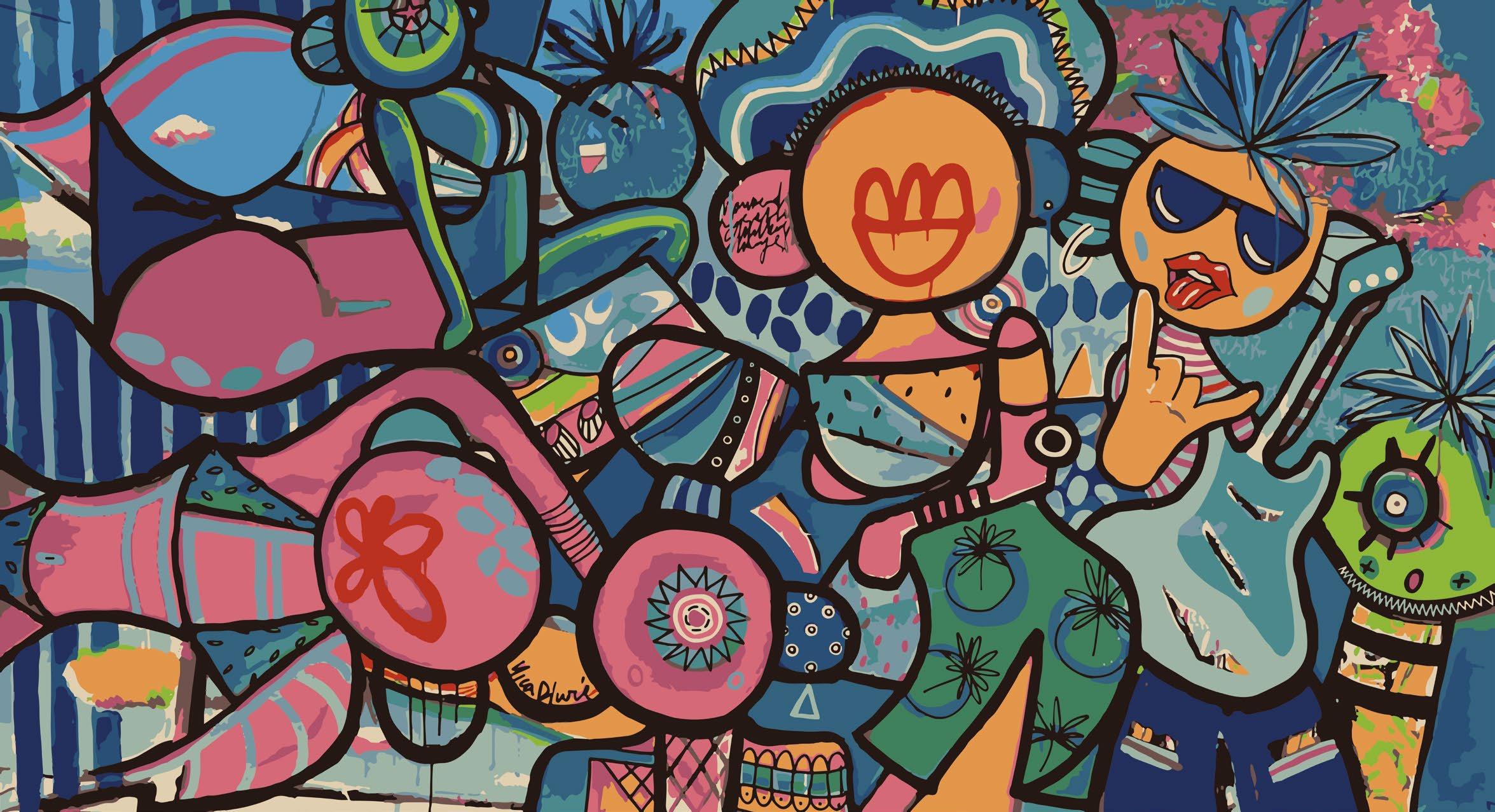
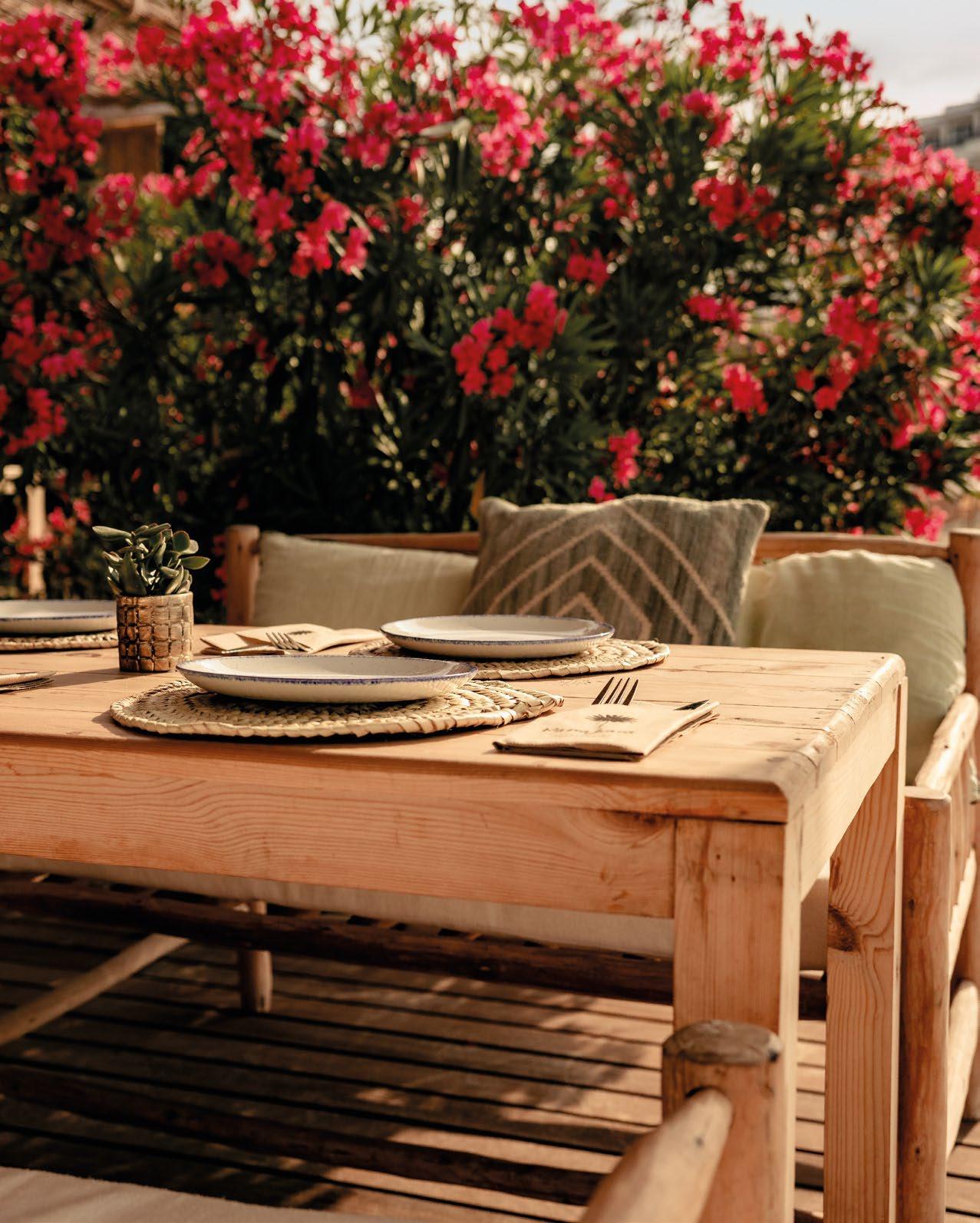
F. era un hombre lento. Lento y callado, pero no por timidez. Se abstraía y reconstruía viejas secuencias, hechos remotos que solo de pronto comprendía. Entonces soltaba alguna frase extraña, del tipo «no hay que ir al cine al mediodía», o «lo que entra al florero ya no puede llamarse flor», que dejaba meditabundo a quien lo escuchara. De allí la fama de tonto, sabio y loco que siempre lo acompañó.
Por supuesto, se trataba de un malentendido provocado por su lenta manera de ser. F. tenía la capacidad de prestar atención a todo, de registrarlo todo, pero solo captaba su verdadero significado a destiempo.
La primera crisis la tuvo poco después de su jubilación, cuando se dio cuenta de que su primera esposa le había montado los cuernos hacía cuarenta y siete años. «Perra… ¡y con el fotógrafo de nuestra boda!», murmuró mirando con odio a C., su mujer. Hubo de inmediato un consejo familiar, entre C. y los hijos, que dictamitnó que F. estaba senil. El médico, sin embargo, no encontró nada en los diversos exámenes a que lo sometieron.
F. was a slow man. A slow and quiet man, but not due to shyness. He would daydream and reconstruct old narratives, summoning remote events that would suddenly dawn on him. Then he would say something strange, like «one must not go to the cinema at noon», or «a flower bouquet is not made up of flowers», that left those who heard wondering. This earned him several reputations: he was known as a fool, a sage and a madman.
Of course, it was all a misunderstanding brought on by his slow way of life. F. was able to pay attention to everything, he could register everything, but the real meaning of things would only become apparent after each moment had passed.
The first crisis occurred shortly after his retirement, when he realised that his first wife had cheated on him forty-seven years earlier. «Damn whore… and with our wedding photographer of all people!», he mumbled glaring hatefully at C., his wife. A family meeting was called for immediately, where C. and their sons agreed that F. was losing his marbles. The doctor, however, concluded after several tests that there was no proof that there was anything wrong.
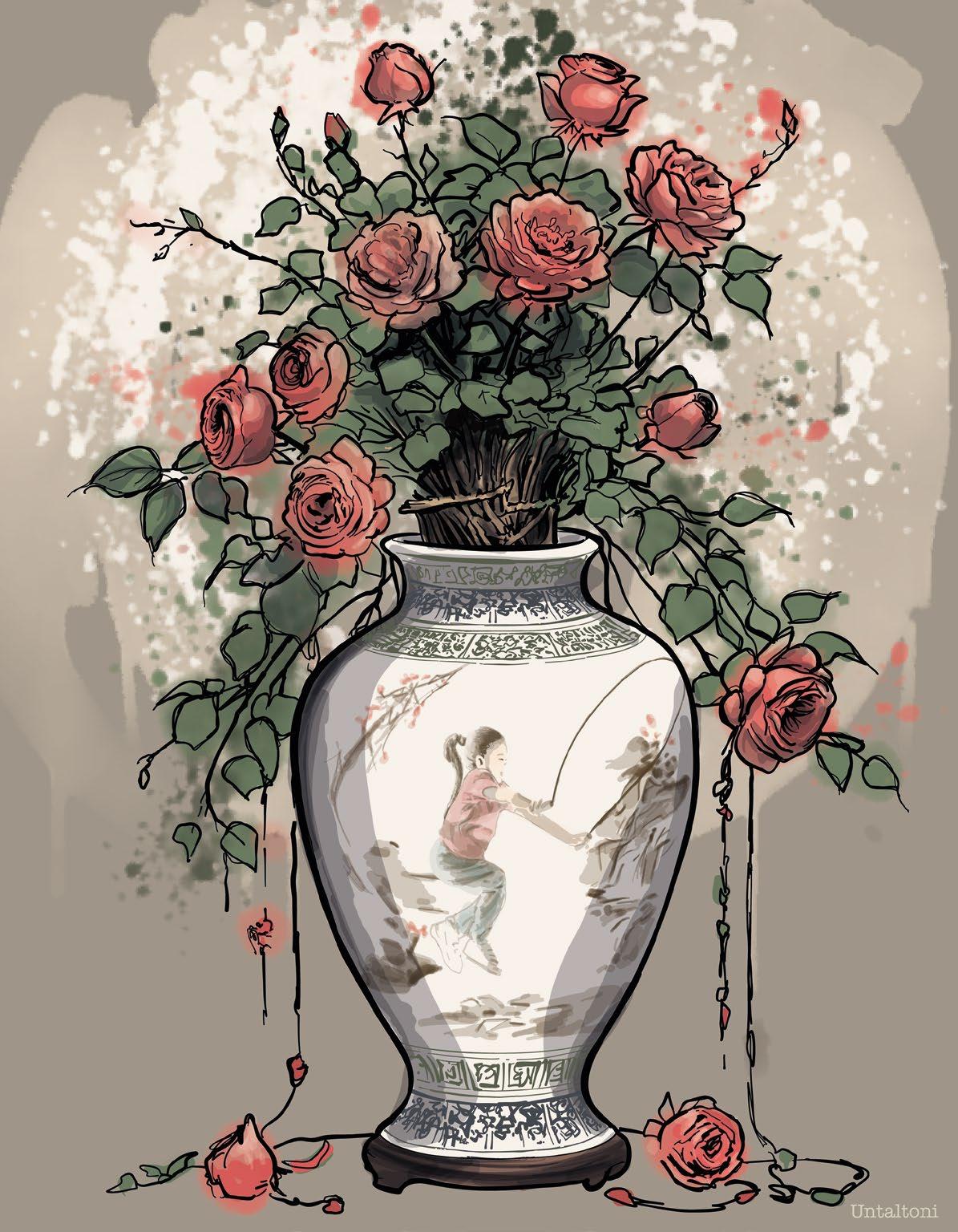
Poco después ocurrió la tragedia: C. murió en un terrible accidente de tránsito. Al parecer, un ACV le hizo perder el control de la camioneta y se estrelló contra un poste de luz. Los hijos estaban seguros de que ahora su padre iba a perder por completo la cabeza. Y teniendo en cuenta lo que sucedió después, más o menos todos coincidieron en que fue así. Pero no fue una locura triste. Fue una locura alegre. Evasión, negación, una forma de escapar al dolor de la pérdida, comentaron. Lo cual no impedía una desagradable sensación ante el grotesco espectáculo de ver a su padre, de pronto, tan feliz.
PERO NO FUE UNA LOCURA TRISTE. FUE UNA LOCURA ALEGRE.
EVASIÓN, NEGACIÓN, UNA FORMA DE ESCAPAR AL DOLOR DE LA PÉRDIDA, COMENTARON
¿Era simple locura o su padre se había convertido en un monstruo? Otro malentendido. Lo que le ocurría a F. no era tampoco ningún misterio, salvo que todos somos un misterio para nosotros mismos y para los otros.
La muerte de C. le hizo recordar otro accidente. Sucedió el domingo de la Semana Santa cuando tenía 18 años. Se encontraba en su primer año de la universidad. Fue el año en que tuvo su primera novia y su primer carro. Ese domingo en la noche acababa de llegar a su casa, después de haber dejado a su novia en la suya. Habían pasado unos días estupendos en la playa. Encontró a su madre hablando por teléfono, con una expresión de horror. Cuando colgó, le informó: una muchachita del colegio y sus padres habían muerto en un espantoso accidente de tránsito. El choque había sido tan brutal que a la niña habían tenido que cortarle las piernas para poder sacarla.
It wasn’t long after that the tragedy took place: C. died in a terrible car crash. She suffered a stroke and lost control of her truck, which crashed into a lamppost. The boys were sure that this would finally push their father’s mind over the edge. And, after what followed, most people agreed that this was the case. But the madness that ensued was not sad. It was full of joy. For many people, it was seen as way of escaping, a form of denial, a way of avoiding the pain of his loss. But these conclusions could not lighten the unpleasant feeling his sons felt when faced with the grotesque spectacle of their father’s sudden state of bliss.
Was it just plain old madness or had their father become a monster? This too was a misunderstanding. What was happening to F. was no mystery, save for the fact that we are all a mystery to ourselves and to others.
WAS IT JUST PLAIN OLD MADNESS OR HAD THEIR FATHER BECOME A MONSTER? THIS TOO WAS A MISUNDERSTANDING
C.’s death had reminded him of another accident. It happened on Easter Sunday, when he was 18 years old. He was a freshman in college. It was the year he had his first girlfriend and his first car. That Sunday night he had just arrived home, after having left his girlfriend at hers. They had spent some great days at the beach. He found his mother talking on the phone, with a horrified expression. She then hung up and told him the news: a little girl from school and her parents had died in a horrible traffic accident. The crash had been so brutal that the girl's legs had to be cut off to be able to get her out.

«¿Quién era?», preguntó. Y al preguntarlo, se descubrió rogando que no fuera ella. «Se llamaba E. No la recuerdo. ¿Tú sí?», le contestó su madre. «Sí, la recuerdo», contestó F. Y toda la alegría marina acumulada se esfumó en ese instante. E. era una muchachita tres años menor que él, con la que solo había tenido dos breves conversaciones. En los días que siguieron, una ristra de recuerdos comenzó a tomar cuerpo: una tarde que él le completó con una moneda para que pagara un helado en la cantina escolar; una mañana que lo habían botado de clases y la observó saltar la cuerda con una amiga; una vez que, después de marcar un gol contra la sección B de tercer año de bachillerato, la vio en la tribuna aplaudiéndolo. Era como si la muerte hubiera sacudido la caja de memorias para que la arena de los días vacíos revelara las pepitas de oro de su emoción.
Comprendió que había estado enamorado de E. desde que ella era una niña y él casi un niño. Retuvo con las pinzas de su mente anciana un pensamiento de esa época, que nunca se confesó a sí mismo: cuando ambos estemos en la universidad, le voy a pedir que sea mi novia. Aquella comprobación lo hundió. Y esa tristeza, fue el anuncio de su propia, cercana, muerte.
Fue entonces cuando decidió internarse en el bosque de sus años de colegio, a rehacer aquellos días con la mirada prístina que le brindaba su hallazgo. Probablemente, él moriría antes de siquiera poder acercarse a E. y declarársele. Lo cual sería una pena, sin duda, aunque no tanto como la de sobrevivir a su viejo y lento amor.

«Who was it?», he asked. And when he asked, he found himself praying it wasn’t her. «Her name was E. I don't remember her. Do you?» his mother replied. «Yes, I remember her», answered F. And all the accumulated marine joy disappeared in that moment. E. was a little girl three years younger than him, with whom he had only had two brief conversations. In the days that followed, a string of memories began to take shape: an afternoon when he gave her a coin to pay for an ice cream in the school canteen; one morning when he had been kicked out of class and he watched her jump rope with a friend; Once, after scoring a goal against the third-year high school B section, he saw her in the stands applauding him. It was as if death had shaken the box of memories so that the sand of empty days revealed the golden nuggets of its emotion.
He realized that he had been in love with E. since she was a girl and he was a boy. He held in the tweezers of his old mind a thought from that time, which he never confessed to himself: when we are both in college, I'm going to ask her to be my girlfriend. This realization made him sink. And that sadness was the announcement of his own, close, death.
It was then that he decided to enter the forest of his school years, to relive those days with the pristine look that his discovery offered him. He would probably die before he could even approach E. and propose to her. Which would be a shame, no doubt, although not as bad as surviving his old, slow love.
Translation by Ben ClarkVenezuelan fiction writer based in Málaga. He has published novels and short stories. He is a columnist and professor of Creative Writing.

Aquella tarde de enero cruzaba, por segunda vez en mi vida, las puertas automáticas del recinto de llegadas del aeropuerto de Ibiza. Después de observar por unos instantes los habituales encuentros, entre abrazos y besos, me invadió una gran desazón y, por qué no reconocerlo, también cierto pánico. Tras mis primeras miradas, tan escudriñadoras como infructuosas, constaté que aquella mujer con la que tantos meses había soñado reencontrarme después de la semana más intensa, pasional y sin duda, más “excesiva” de mis 36 años, no estaba allí… O eso cuchicheaban mis inseguridades.
Ni rastro de aquella silueta esbelta y bronceada, de largos cabellos dorados y ondulados, ni de su rostro maquillado ni de su embriagador perfume. Ninguna señal de la figura de estilizados tacones y largo vestido blanco (como el de bordados ocres que llevaba el día que la conocí en su puesto del mercadillo de Las Dalias).
La recordaba como un gracioso torbellino de movimientos y gestos acelerados llenándome de preguntas, planes inmediatos y frases impulsivas tan repletas de ingenio como de ingenuidad. Una hermosura de ojos verdes que, bajo el efecto de la música y de un par de gin-tonics, se liberaba y desataba aún más, bailando con una intensidad, energía y gracia que nunca había contemplado en nadie.
That January evening, for the second time in my life, I passed through the automatic doors of the arrivals hall at Ibiza airport. Following a few moments of observing the usual encounters amongst hugs and kisses, I was overcome with a great sense of unease and, dare I say it, a certain panic, as well. After my first glances arountd, which were as probing as they were fruitless, I realised that the woman that I had dreamed of seeing again for so many months, after the most intense, passionate and unquestionably the most “excessive” week of my 36 years, was not there... Or so my insecurities whispered.
No trace of that tanned, slender silhouette with long, wavy golden hair, nor of her made-up face or her intoxicating perfume. No sign of that figure in sleek heels and a long white dress (like the ochre-embroidered one she wore the day I met her at her stall at the Las Dalias flea market).
I remembered her as a graceful whirlwind of movements and accelerated gestures, filling me with questions, immediate plans and impulsive remarks that brimmed with both wit and naivety. A green-eyed beauty who, under the effects of the music and a couple of gin and tonics, would break free and let loose even more, dancing with an intensity, an energy and a grace that I had never seen before in anyone.

Esa mujer me había inundado y parecía inundarlo todo. Nos costó horrores descoser nuestros cuerpos en agosto. Sí, me quedé prendado de ella, aunque me advirtió al despedirnos:
—Confío en ti, pero no tengo claro todavía que puedas soportar mis mareas otoñales, mis cambios de humor invernales y mis remolinos primaverales. Vuelve en enero, prométeme que no me mandarás fotos, yo haré lo mismo. Nos vamos escribiendo, ¿vale?
LARGAS O QUE QUIZÁS TENDRÍA MIEDO DE ENAMORARSE. YO, QUE JAMÁS HABÍA CREÍDO EN LOS FLECHAZOS…
Pensé que me estaba dando largas o que quizás tendría miedo de enamorarse. Yo, que jamás había creído en los flechazos…
—¡Ey! ¿Pero es que no me vas a decir nada? Sé que ahora estoy blanquita, pero no creo que sea transparente. Estoy aquí. No soy un fantasma —dijo alguien a mi lado.
El cabello se le había oscurecido y lo llevaba más corto, a la altura de la mitad del cuello. Un pícaro flequillo asomaba sobre su frente blanquecina. Salpicando su rostro, tan cambiado sin maquillaje, se esparcían unas diminutas pecas que en verano habían permanecido ocultas bajo su intenso bronceado. Vestía una sudadera gris, unos pantalones verdes de chándal y unas viejas zapatillas deportivas. Me pareció más bajita, como si hubiera encogido. Su tono de voz resultaba más dulce y suave que en mis recuerdos, con un ritmo más lento que el del verano, lleno ahora de pausas e intrigantes silencios que me incomodaron. Era como si me hubieran dado un cambiazo por una versión sosa, descafeinada y hasta deprimida de aquella mujer que me había hipnotizado solo unos meses antes.
Entendí su advertencia cuando escuché las propuestas para esos días, tan diferentes de las que habíamos disfrutado en las interminables jornadas veraniegas de bullicio, luces, voces, música, playas, terrazas… sin apenas
That woman had engulfed me and seemed to engulf everything. It took an awful lot to detach our bodies in August. Yes, I fell in love with her, although she warned me as we said goodbye:
—I trust you, but I’m not yet sure you can handle my autumn tides, my winter mood swings and my spring whirlwinds. Come back in January, promise me you won’t send me photos, and I’ll do the same. We’ll write to each other, okay?
I thought she was trying to give me the runaround or that maybe she was afraid of falling in love. I, who had never believed in love at first sight...
—Hey! Aren’t you going to say anything to me? I know I’m a bit pale now, but I don’t think I’m transparent. I’m here. I’m not a ghost”—said someone next to me.
Her hair had darkened and was shorter, falling to the middle of her neck. A cheeky fringe peeked over her whitish forehead. Dotting her face, which was so different without any makeup, were tiny freckles that had been hidden beneath her deep summer tan. She was wearing a grey sweatshirt, green sweatpants and old trainers. She seemed shorter, as though she had shrunk. Her voice was sweeter and softer than I had remembered, and its cadence was slower than in the summer. Now it was full of pauses and intriguing silences that made me uncomfortable. It was as if she’d been replaced with a bland, decaffeinated, even depressed version of that woman who had entranced me only a few months earlier.
THAT WOMAN HAD ENGULFED ME AND SEEMED TO ENGULF
I understood her warning when I listened to the lineup of activities for those days, which were so different from the ones we had enjoyed during the endless summer days of commotion, lights, voices, music, beaches, terraces... with barely any time for sleep and rest. I was going to be bored out of my mind: hiking through inhospitable areas in the north; visiting inland villages where almost no-one lived; having a sandwich for dinner in Santa Gertrudis; a freezing night walk

Apuesta gastronómica en auténticas especialidades de la cocina tailandesa, india, italiana, tex-mex y mediterránea, bajo la batuta de chefs nativos.
En una misma mesa, podrás disfrutar de las cocinas del mundo.
Currys indios. Arroces, pastas y curries tailandeses. Sabrosos tacos mejicanos. Pescados deliciosos, sabrosas carnes a la brasa.
Pizzas caseras, pastas italianas. Paellas de carne, pescado o mariscos. Hamburguesas caseras, platos veggie. Nuestros originales combos para compartir.
Deliciosos desayunos, postres caseros y una coctelería sorprendente.
Gastronomic bet on authentic kitchen specialties Thai, Indian, Italian, Tex-Mex and Mediterranean, under the leadership of native chefs. At the same table, you can enjoy the cuisines of the world. Indian curries. Rice, pasta and Thai curries. Tasty Mexican tacos. Delicious fish, tasty grilled meats, homemade pizzas, Italian pastas. Meat, fish or seafood paellas. Homemade burgers, plates veggie. Our original combos to share. Delicious breakfasts, homemade desserts and a surprising cocktails.
Tailandesa, india, italiana, tex-mex y mediterránea
WORLD CUISINES
INDIAN
THAI
TEX-MEX
ITALIAN
MEDITERRANEAN
Passeig de ses Fonts (next to the main taxi rank)






Reservation: +34 971345806
@cantinaportmany
Soul City has been bringing non-stop urban flavours, Ibiza style, to San Antonio’s West End for over 20 years. Our resident DJ’s and special guests deliver the most talented fusion of RnB, hip-hop, dancehall, garage, grime, drum & bass and reggae, resulting in a notoriously lively dance floor every night of the summer.
From the freshest beats to the most loved classics, come to Soul City and experience the best urban music in Ibiza. Mixed with good vibes, non-stop dance floor, fully stocked premium bar and experienced staff, a night out in Ibiza’s West End is incomplete without a visit to Soul City. Open every night of the week.
Soul City lleva más de 20 años acercándonos los mejores ritmos urbanos, al estilo ibicenco en el West End de San Antonio. Nuestros DJ residentes e invitados especiales ofrecen la fusión más talentosa de RnB, hip-hop, dancehall, garage, grime, drum & bass y reggae, lo que da como resultado una pista de baile increíblemente animada todas las noches del verano.
Desde los ritmos más frescos hasta los clásicos más queridos, ven a Soul City y experimenta la mejor música urbana de Ibiza. Mezclado con buen rollo, loca pista de baile, bar premium y personal experimentado, una noche de fiesta en el West End de Ibiza está incompleta sin una visita a Soul City. Abierto todas las noches de la semana.


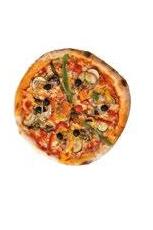








tiempo para el sueño y el descanso. Me iba a aburrir como una ostra: senderismo por zonas inhóspitas del norte; visitas a pueblos del interior, donde apenas vive gente; cenar un bocadillo en Santa Gertrudis; una caminata en plena helada nocturna bajo la luna llena por Santa Agnès, rodeados de almendros en flor; pescar calamares al atardecer en un pequeño bote; pasar largas horas en casa leyendo junto a la chimenea. Nada de discotecas, ni beach clubs, ni bares del puerto de Ibiza, que se había convertido en una ciudad fantasma… Me quería mostrar un bar donde solían tocar grupos locales, me habló de una fiesta con música de los 80 y me agobié: la claustrofobia me invadió y me planteé adelantar el regreso a Madrid. Incluso al amarnos aquellos dos primeros días ella se mostró tan tímida que llegué a sentirme culpable de estar traicionando a mi fogosa amada estival, a la que seguía añorando y buscando.
Todo apuntaba a que nuestro reencuentro no podría germinar, pero el tercer día, mientras dábamos un paseo matinal por Ses Salines, sucedió algo inesperado. Fue en un escenario casi irreal de silencio, quietud y sosiego que el mar y sus mágicos reflejos nos brindaban en el espejo de las calmas de enero. Ella emergió de uno de sus enigmáticos silencios y repliegues para tomarme de la mano con tal delicadeza y relajada suavidad que logró hacerme estremecer. Al día siguiente, junto al calor de la chimenea, tras una mirada sostenida y profunda, sentí el embrujo de la pureza y la sinceridad de sus besos invernales, que cambiarían mi destino.
Poco después vendí mi piso de la calle Ibiza, junto al Parque del Retiro, en Madrid y me vine a vivir con ella a Ibiza, a la calle Madrid. De eso hace ya doce años. Yo, que jamás había creído en las coincidencias…

under the full moon in Santa Agnès, amidst the flowering almond trees; fishing for squid at sunset in a small boat; spending long hours at home reading by the fireplace. No discotheques, no beach clubs, no bars in the port of Ibiza, which had become a ghost town... She wanted to show me a bar where local bands used to play, she told me about a party with 80s music and I began to feel anxious: I was overcome by claustrophobia and I considered an early return to Madrid.
Even when we made love those first two days, she seemed so shy that I actually felt guilty for betraying my passionate summer lover, whom I continued to yearn for and seek out.
Everything seemed to suggest that our re-encounter would never bud, but on the third day, while strolling through Ses Salines in the morning, something completely unexpected happened. It was in an almost unreal setting of silence, stillness and tranquillity that the sea and its magical reflections offered us in January’s mirror of calm. She emerged from one of her enigmatic silences and retreats to take my hand with such a delicate and relaxed gentleness that she managed to make me shiver. The next day, by the warmth of the fireplace, after a long, deep, penetrating gaze, I felt the spell of the purity and sincerity of her winter kisses, which would change my destiny.
Shortly afterwards, I sold my flat in Calle Ibiza, next to Retiro Park, in Madrid, and came to live with her in Ibiza, in Calle Madrid. That was twelve years ago. Me, a man who had never believed in coincidences...
El ibicenco Javier Serapio es psicólogo clínico, docente desde hace 30 años y autor de los libros Llagas de sal y Hechizos de mar. Además, coordina el Club de Lectura Tinta de mar, que organiza el Club Náutico de Ibiza. Sus tres grandes pasiones son la literatura, la navegación y los viajes.
Ibizan Javier Serapio is a clinical psychologist who has been teaching for 30 years and has authored the books Llagas de sal and Hechizos de mar. He also coordinates the Book Club Tinta de Mar, which is hosted by the Club Náutico de Ibiza.. His three great passions are literature, sailing and travelling.
Lo primero que olvidamos del otro es su voz. Nuestras neuronas borran sin piedad la voz ajena cuando dejan de escucharla. Es material frágil, gotas diluidas en el océano de la memoria. Ahora recurrimos al disco duro del móvil si queremos recordar la voz de un ser perdido. Basta un mensaje grabado en una conversación de WhatsApp para transportarnos a un día, un momento, una temperatura, una luz determinada. Hasta la tormenta eléctrica que desató el beso aquel. La voz del otro pinta con precisión los contornos de lo que fue y no sabíamos recordar. Refresca el alma, repara sueños, reabre heridas, revela abismos. El regreso de la voz ajena sana y pellizca. Todo depende de quién esté al otro lado de la línea.
De los personajes que pesaron en nuestras vidas podemos describir muchas cosas. Tenemos negativos y archivos jpg; correos electrónicos y cartas, el poder de la imagen y la palabra escrita. Pero en el caso de la voz vestimos la realidad de ficción porque, a menudo, sólo queda el recuerdo. Recordar nace de recordis, en latín, “volver a pasar por el corazón”, y el corazón es un músculo mentiroso. Sin pulsar el play, es casi imposible alojar una voz en un oído que jamás escuchó su timbre. Porque hubo un tiempo, todavía no demasiado lejano, en que resultaba mucho más
The first thing we forget about another person is their voice. Our neurons mercilessly erase the voice of another when we cease to hear it. This is fragile matter, like droplets that dissolve in the ocean of memory. Today, we can go back to our mobile phone hard drive to retrieve the voice of a lost loved one. A simple message recorded in a WhatsApp chat is enough to take us back to a day, a moment, a temperature, a certain light. Back to the electrical storm that triggered that kiss. The voice of the other captures with precision the contours of what was and what we couldn’t recall. It refreshes the soul, it repairs dreams, it reopens wounds and it uncovers chasms. The return of another’s voice can both heal and pinch us. It all depends on who is on the other end of the line.
There are many ways to describe those who left their mark on our lives. We have negatives and jpg files; emails and letters, the power of the image and the written word. But in the case of the voice, we dress reality in fiction, for very often, all that is left is the memory. The Spanish word for “to remember”, recordar, was born out of the Latin recordis, meaning “to pass through the heart again”. And the heart is a mendacious muscle. Without hitting the play button, it’s almost impossible to embed a voice in an ear that has never heard its timbre. Because there was a time, not that long ago, when it was far

difícil almacenar la voz ajena. Algún VHS, algún casete, y ya. Cuando nos preguntan cómo hablaban los desaparecidos, imaginamos. En vano, tratamos de agarrarnos a alguna característica que figure en la ficha técnica que elaboramos de abuelos, padres, hermanos, amigos, parejas, amantes y flechazos. Era ronca, era aguda, era infantil, era cadenciosa, era fumadora, era aflautada, era calurosa, era convincente, hacía gallos, estaba rota, tenía gracia, intimidaba, seducía.
HABLABAN LOS DESAPARECIDOS, IMAGINAMOS
El acento es de lo poco que se salva del derrumbe. Si es extraño, lo imitamos, y como quien se aficiona a la comida exótica, nos lo apropiamos y sirve de ancla para retrasar lo inevitable. Sabemos que la deriva arrastrará las voces ajenas demasiado lejos demasiado pronto. Hasta que se las trague el futuro. El disco duro del móvil y los mensajes que nos grabaron también caerán en ese agujero negro.
El camino hacia el desguace tiene, paradójicamente, un punto de fuga. La música nos permite creer que es posible esquivar a los dragones que habitan en los bordes del mapa. Las coplas de Camarón, Janis, Elvis o Piaf son documentos indestructibles incluso en la memoria de los enfermos de Alzheimer, que las recuerdan cuando no recuerdan nada más. Y las cantan, versificando una historia, condensándola en un par de minutos, evocando imágenes que cabalgan sobre síncopas y acordes. La mañana en que murió tu bisabuela, la que tocaba el acordeón, en el tocadiscos de su casa sonaba el vinilo de la La vida sigue igual. La canción es un artefacto maravilloso, el perro que olisquea los sentimientos hasta morder la fibra, la hoguera que nos reúne las noches de verano en el patio de Las Dalias, la forma menos embarazosa de decirle te quiero.

more difficult to store the voice of another. You could save it on a VHS or a cassette, and that was all. When we’re asked about how our lost loved ones used to speak, we imagine. And to no avail, we grapple for some sort of trait that might be in the technical data file that we put together on our grandparents, parents, siblings, friends, romantic partners, lovers, and crushes. It was hoarse, it was high-pitched, it was childish, it was lilting, it was a smoker’s voice, it was flutey, it was warm, it was convincing, it was cocky, it was cracked, it was graceful, it was intimidating, it was seductive.
The accent is one of the few things that can be salvaged from the demolition. If it is strange or foreign, we imitate it, and like a fan of exotic food, we appropriate it and it serves as an anchor to delay the inevitable. We know the drift will sweep away the voices of those we loved, dragging them too far away, too soon. Until they’re swallowed up by the future. The hard drive of our mobile phone and the messages that they recorded for us will also eventually fall into that black hole.
PARADOXICALLY THOUGH, THERE IS A POINT OF ESCAPE ON THE ROAD TO OBLIVION
Paradoxically though, there is a point of escape on the road to oblivion. Music allows us to believe we can circumvent the dragons that lurk at the edges of the map. The songs of Camarón, Janis, Elvis and Piaf are imperishable documents, even in the memory of those with Alzheimer’s disease, who remember them when they remember nothing else. And they sing those songs, putting into verse a story, condensing it into just a few minutes, summoning forth images that gallop atop chords and syncopations. The morning your great grandmother passed away, the one who used to play the accordion, the vinyl album La vida sigue igual was playing on the record player in her house. A song is a wonderful device, like a dog that sniffs out your inner feelings until it bites the heartstrings, the bonfire that brings us together on summer nights in the Las Dalias courtyard, the least embarrassing way to say ‘I love you’.
Pablo Sierra del Sol es un periodista ibicenco. Creador y editor de la revista Negratinta (2014-2017), antes aprendió y trabajó en Diario de Ibiza. Ahora escribe en eldiario.es y colabora con el magazín Téntol de IB3 Ràdio.
Pablo Sierra del Sol is an Ibizan journalist. The creator and editor of the magazine Negratinta (2014-2017), he formerly interned and worked at Diario de Ibiza. He now writes for eldiario.es and contributes to the radio show Téntol on IB3 Ràdio, the public radio of the Balearic Islands.

És insòlit que així arribi, en un idioma estrany. Albirar això que s’assembla a l’amor apropant-se.
Vens de lluny, ets lluny i parles una llengua que no entenc i jo he de dir-me en un codi limitat.
Vens amb ciència mentre jo gairebé entenc coses concretes però vull que penetris el meu món i endinsar-me en tot el que et fa moure. Puc notar-te la fermesa, més enllà de la paraula. També en ella. Paraula beneïda. Tens paraules meravella que em comprenen des del teu espai robust gravitatori meu.
Comulgaré paraula jo que he deixat de ser creient i m’hi agenoll, paraula calma que t’eleves i m’eleves
i et pareixes a l’amor.

LOVE POEM IN THE WORKS
Es curioso que así llegue, en un idioma extraño. Vislumbrar esto que se parece al amor acercándose.
Vienes de tierras lejanas, estás lejos y hablas una lengua que no entiendo y yo debo decirme en un código acotado.
Vienes con ciencia mientras yo apenas entiendo cosas concretas pero quiero que penetres en mi mundo y adentrarme en todo aquello que te mueve. Puedo notarte la firmeza, más allá de la palabra. También en ella. Palabra bendecida.
Tienes palabras maravilla que me comprenden desde tu espacio robusto gravitatorio mío.
Comulgaré palabra yo que dejé de ser creyente y me arrodillo, palabra calma que te elevas y me elevas
y te asemejas al amor.

It’s funny that it should arrive this way, in a language I find strange. Funny to see this thing that seems like love getting closer.
You come from far away, you are far and speak a tongue that I don’t understand and which I must now pronounce myself withing the boundaries of a code. You come with science while I can hardly comprehend specific things but I wish you would penetrate my world and enter in all things that move you. I can notice your strength, it is beyond words. It is also inside of them. Inside these blessed words. You have wonderful words that understand me from your strong gravitational space that is also mine.
I will take these words as I would have taken communion, though I once ceased to believe, I now kneel before these soothing words that fly and make me fly and you are not dissimilar from love.
Translationby Ben
ClarkLa escritora ibicenca Eva Tur ha publicado los libros de poemas Planeta Tigre y Kilimanjaro. Además, es autora de los cuentos infantiles Missatge a la deriva y Amistat Còsmica. Coordina los encuentros literarios Vermuts poètics en Can Tixedó y ha comisariado el proyecto Homenatge a la ceràmica d’Anneliese Witt
Ibizan writer Eva Tur has published two books of poetry, Planeta Tigre and Kilimanjaro. She is also the author of the children’s stories Missatge a la deriva and Amistat Còsmica. She coordinates the Vermuts poètics literary gatherings at Can Tixedó and curated the art project Homenatge a la ceràmica d’Anneliese Witt

La MAGIA existe, y una muestra de ello es cada atardecer vivido en el chiringuito Cala escondida
Aunque por muy escondido que esté, por todos los lugareños es conocido; gracias a su enclave único rodeado de plena naturaleza, situado en Racó den Xic, una de las calitas que forman el grupo de playas de aguas cristalinas y turquesas de Cala Comte. Este chiringuito destaca por su autenticidad, su ambiente, y su filosofía.
SOSTENIBLE
100% ecológico, con un eco-toilet que a nadie deja indiferente.
DIVERTIDO
Especialistas en cócteles, su cocina está abierta de 09:00 a 22:00 con una carta que es un viaje gastronómico de pequeños bocados, teniendo guiños de diferentes culturas ( Mexicana, libanesa, americana, española…), en la que te sorprenderá que casi en su totalidad sus platos son veggies.
ÚNICO
Este año han incorporado nuevas actividades muy especiales: los lunes y martes te proponen empezar el día con la mejor energía si te unes a su “Yoga & Breakfast”. De manera esporádica diferentes profesionales utilizan este maravilloso espacio para darse a conocer, e impartir talleres con un rico desayuno.
MÁGICO
Uno de los momentos más bonitos, el atardecer, lo llevan a su máximo esplendor con el “Sunset Experience”, celebrado una vez a la semana, y con el que nos sorprenden ofreciendo algo nuevo y diferente (catas gourmet, cócteles innovadores, espectáculos, música en directo, fiestas temáticas…)
Colabora con con un proyecto de ayuda humanitaria en Nepal, una escuela con 320 niños y cada año su staff viaja allí llevando a cabo esta labor. La venta de sus camisetas y sudaderas van destinadas a la ONG Amavida.
En la isla no hay ningún local que se le asemeje, es un lugar de ensueño, en el que el mejor filtro siempre será el arrebol del atardecer, y la mejor banda sonora las olas de mar.
THE VII “LAS DALIAS” INTERNATIONAL SHORT STORY AWARD


Siete décadas cumple Las Dalias. Siete son los colores del arcoíris. Siete son los pecados capitales y siete los mares. Siete las colinas de Roma y siete las maravillas del mundo antiguo. Y siete han sido ya las ediciones del Premio Internacional de Cuento “Las Dalias”, un certamen de narrativa que ya ocupa un lugar de prestigio entre los concursos de relato en castellano del mundo.
Esta séptima edición ha sido especial, además, porque los y las participantes han tenido que escribir utilizando un tema concreto, el amor, que este año ocupa el centro de las celebraciones del 70 aniversario de Las Dalias.
A pesar de la dificultad de escribir sobre un tema tan universal, el concurso ha vuelto a recibir un número impresionante de originales: 1.350 cuentos que han sido valorados por una comisión lectora, que ha seleccionado las 15 obras finalistas que leyó el jurado, compuesto por la escritora Maribel Andrés Llamero; la directora de la revista Las Dalias Ibiza & Formentera Magazine, Laura Ferrer Arambarri, y yo mismo, Ben Clark, como coordinador del premio.
Las Dalias celebrates its seventh decade. Seven are the colours of the rainbow, the deadly sins and the seas. Rome is known for its seven hills, and history lists seven wonders of the ancient world. And the International Short Story Prize ‘Las Dalias’ has already seen seven editions, solidifying its prestigious standing among Spanish-language narrative competitions worldwide.
This seventh edition was particularly special because participants had to pen their stories on a specific theme: love, which takes centre stage in this year’s celebrations of Las Dalias’ 70th anniversary.
Despite the challenge of tackling such a universal theme, the contest once again attracted an impressive number of submissions: 1,350 stories evaluated by a reading committee. This committee selected the 15 finalist works, which were then reviewed by the jury consisting of writer Maribel Andrés Llamero; Laura Ferrer Arambarri, director of Las Dalias Ibiza & Formentera Magazine; and myself, Ben Clark, as the prize coordinator.

El cuento ganador ha sido ‘El Tsunami’ de la zaragozana
Victoria Trigo Bello, un relato que habla de una promesa de amor fallida en los tiempos de las aplicaciones de citas y de los fríos mensajes de Whatsapp que pueden romper un corazón en una puerta de embarque.
Victoria Trigo Bello estudió Filología Hispánica y su amor por las letras es tan grande como su activismo en grupos ecologistas y defensores de derechos humanos. Ha obtenido, además, premios de relato, microrrelato, poesía y literatura epistolar amorosa como el concurso de microrrelatos Relatos en Cadena, organizado por la Cadena SER y la Escuela de Escritores o el Premio de Narrativa de la Asociación de Periodistas de Ávila.
Quiero expresar mi agradecimiento a los participantes, al jurado, al equipo de preselección y a Las Dalias por su apoyo a la cultura. Y gracias a nuestra flamante ganadora, claro, por haber escrito su espléndido relato ‘El tsunami’.
Con su prosa brindamos hoy por el amor, por siete años más de premios, por siete décadas más de Dalias.

The winning story was ‘El Tsunami’ by Victoria Trigo Bello from Zaragoza, a narrative that delves into a failed promise of love in the era of dating apps and the cold WhatsApp messages capable of breaking a heart at a boarding gate.
Victoria Trigo Bello studied Hispanic Philology, and her passion for literature matches her activism in environmental and human rights groups. She has won awards for short stories, micro-stories, poetry and love epistolary literature, including the micro-story contest ‘Relatos en Cadena’, organised by Cadena SER and the Escuela de Escritores, as well as the Narrative Prize of the Association of Journalists of Ávila.
I’d like to extend my gratitude to the participants, the jury, the pre-selection team and Las Dalias for their support of culture. And, of course, a big thank you to our brilliant winner for her splendid story ‘El Tsunami’.
With her prose, we raise a toast today to love, to seven more years of awards, to seven more decades of Las Dalias.
Ben Clark, coordinador del Premio Internacional de Cuento “Las Dalias” coordinator of the International Short Story Prize ‘Las Dalias’.
La isla ya es historia. Un tsunami se la ha tragado. Este mediodía, al volver a casa, tras despachar con una marea de whisky y pañuelos de papel, he quemado los folletos de la agencia de viajes. Tengo que olvidar urgentemente que existió un lugar donde hubiéramos ido en camello y habríamos subido a un volcán. No quiero recordar que habríamos visitado un parque de loros y delfines, que me habrías hecho fotos probándome sombreros y me habrías jurado amor eterno cada anochecer junto al faro. No quiero recordar que me hiciste soñar con esta semana en que nos alojaríamos en un hotel vip cuya directora te llamaría don Miguel y tú, un maduro jovial siempre oliendo a pasión, le concederías tutearte al tiempo que te girarías hacia mí para guiñarme el ojo.
Todavía tengo el equipaje sin deshacer. Quizás aún pueda devolver el pantalón blanco y las sandalias doradas de tacón. El bikini a juego con el pareo y los conjuntos de lencería también irán al fuego, que no me importa el tufo a chamusquina en el baño. En el trabajo, como están en plena campaña, han dicho que me guardan para más adelante esos días de vacación. A ver con qué cara vuelvo mañana a la oficina. Les he telefoneado y se han tragado mi bola, pero ya sabrán lo del tsunami. Al bajar del taxi con el rímel corrido, me he cruzado con la secretaria de mi departamento, que ya es mala suerte que esa preguntona viva precisamente en mi calle. ¿Pero no te ibas hoy de escapada romántica?
Ayer dijiste que pasarías a recogerme a las seis y media para ir a Barajas y que desayunaríamos allí. Me ibas a hacer una llamada perdida cuando salieras de tu casa. Han dado las siete. Las siete y cuarto. Y veinte. Y media. Tu móvil apagado. ¡Ay Michi, qué dormilón eres! Pero no me quería poner nerviosa ni transgredir tu orden tajante de que jamás llamara a tu teléfono fijo. Te he enviado un WhatsApp: Acudo directamente a la T4, lironcito mío. Si perdemos el vuelo, cogeremos otro. Otro vuelo, Michi. Otro. En clase turista, que me hubiera dado igual.
Ni una sombra de ti en el aeropuerto. Ni una sonrisa tuya aguardándome detrás de alguna columna, en el stand de alquiler de coches o precedida de unas flores o una caja de bombones. Un gemido en mi celular ha traído al fin tu respuesta: Perdóname. No puedo dejarla. Dos frases conformando tu segunda verdad. La primera, la de tu crisis de pareja irreversible y el habitual montón de etcéteras de estos casos, la supe tres meses después de haberte conocido en una red social para singles donde tú, que no lo eras, participabas como intruso. Al saber que no estabas libre quise apartarme de ti, pero tu labia de conquistador disipó mis reticencias hasta convencerme del todo con esto del viaje a la isla. Que sí tontita, que me voy a divorciar, que mi matrimonio está agotado. Pondremos tierra y mar por medio y mi esposa lo entenderá.

Con tu bomba recién estallada en mi móvil me he retirado de la fila de información. Sí, porque yo quería que me informaran de algo, de lo que fuera. Por ejemplo, de si había algún medio para que aparecieras allí inmediatamente, si debía cumplimentar algún formulario o pagar unas tasas para que tramitaran con urgencia mi solicitud. En fin, cosas que se piensan cuando no se piensa porque es imposible pensar. Tras tu mensaje, mi maleta se ha transformado en un ataúd de ruedecillas chirriantes y la isla de destino ha degenerado a una masa de agua turbia. Lo decían los monitores. Lo decían los altavoces alternando el aviso de cancelación de nuestro vuelo con un sinfín de últimas llamadas para pasajeros tardones. También lo decía en silencio el público que me miraba interrogante al verme sollozar.
La isla. Tu isla. Mi isla. Nuestra isla devorada por un tsunami.
Quizás con el tiempo el mar retroceda y la isla vuelva a emerger. Quizás entonces pueda ir allí, pero no seré esta yo que hace un rato se ha ahogado en tierra, envenenada por tus mentiras y ha salido derrotada a coger un taxi para regresar a casa. Seré otra yo, con un vaquero sin marca y una camisa de tienda de barrio, quizás acompañada de una amiga que no se tiña y hable de chacras, empoderamiento y mindfulness, o junto a un hombre formal que se llame Miguel a secas, un hombre puntual y sin secretos, un hombre barrigón y de loción del súper con quien jamás me herirán las dudas ni soñaré vivir una semana eterna.
He zozobrado. Ya no puedo hundirme más. Sólo veo una charca negra y en el fondo un sudario con mi nombre. Ahora me toca deshacer el equipaje, tachar esa isla de mi mapa y vaciar mi reloj de esta arena tan sucia. Ahora me toca el tsunami de la cordura, el de apearme de la fantasía, carenar mi barca y renacer del naufragio. Ahora me toca esperar que surja de nuevo esta isla que, ya ves, por una bravuconada del mar hoy ha desaparecido en un aeropuerto lleno de gente donde, sin embargo, sólo yo me he percatado del siniestro.
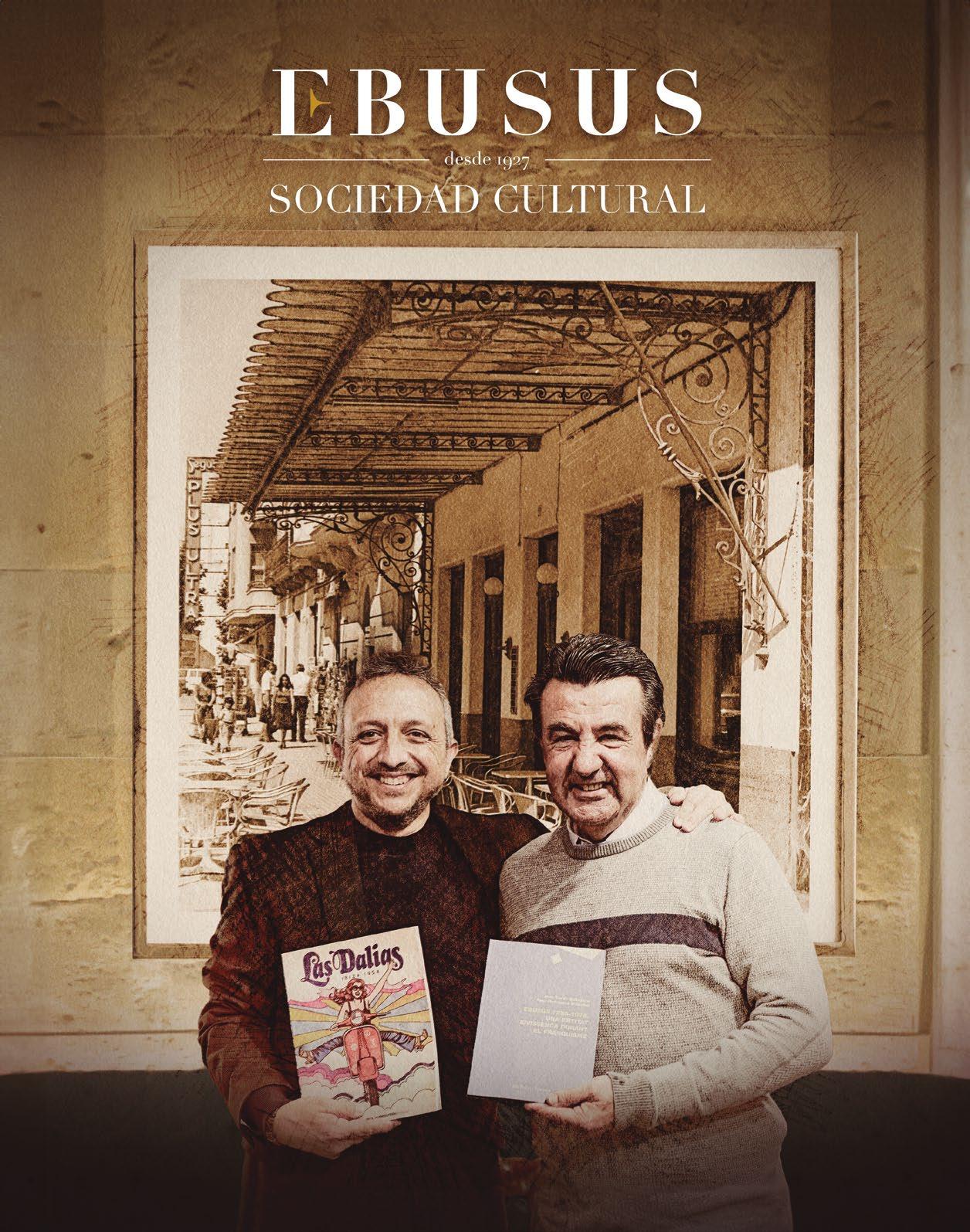

The island is now long gone. A tsunami has swallowed it up. This afternoon, when I returned home, after dealing with a flash flood of whiskey and tissues, I burned the travel agency’s brochures. I’m in dire need of forgetting that there was a place where we would have ridden a camel and climbed a volcano. I don’t want to recall that we would have visited a park with parrots and dolphins, I can’t bear to think that you would have taken photos of me trying on hats and that you would have sworn eternal love to me every evening next to the lighthouse. I don’t want to remember that you made me dream about this week in which we would stay in an expensive hotel whose director would ceremoniously call you Don Miguel and you, a jovial mature man always smelling of passion, would speak to her on a first-name basis while you turned to me and winked.
I still haven’t unpacked my bags. Maybe I can still return the white trousers and the gold highheeled sandals. The bikini matching the sarong and the lingerie sets will also be cast into the flames, I don’t mind the smell of singeing in the bathroom. At work, since they are in the midst of a campaign, they have said that they can save those vacation days for a later date. I can’t imagine my face in the office tomorrow. I called them and they fell for it, but they already know about the tsunami. When I got out of the taxi with my mascara running, I ran into the secretary of my department, running into that inquisitor was certainly bad luck. Oh, but won’t you on a romantic holiday?
Yesterday you said that you would pick me up at half past six to go to Barajas Airport and that we would have breakfast there. You were going to ring once when you left your house. Seven o’clock came and went. Seven fifteen. Then twenty-past. Half past. Your cell phone turned off. Oh Michi, what a sleepyhead you are! But I didn’t want to get nervous or violate your strict order that I should never call your landline. I sent you a WhatsApp: I’m going directly to T4, my little darling. If we miss the flight, we’ll take another one! Another flight, Michi. Another one. In tourist class, I wouldn’t have cared.
There wasn’t a hint of you at the airport. Not a smile from you waiting for me behind a column, at the car rental stand or preceded by some flowers or a box of chocolates. A moan on my cell phone has finally brought your response: Forgive me. I can’t leave her. Two sentences creating your second truth. The first, your account of your doomed relationship, your crisis and the usual pile of yadida of these cases. I found all that out three months after having met you on a social network for singles where you, who did not belong there, participated as an intruder. Knowing that you were not free I wanted to get away from you, but your conqueror’s talk dispelled my reluctance until I was completely convinced of the trip to the island. Yes, silly, I’m getting divorced, my marriage is a sham. We will put land and sea between us and my wife will come to terms with it.









With your bomb having just exploded on my cell phone, I have withdrawn from the information queue. Yes, because I wanted information about something, anything. For example, if there was any way for you to appear there immediately, if I had to fill out a form or pay a fee to urgently process my application. In short, things one thinks when one is not thinking because it is impossible to think. After your message, my suitcase has been transformed into a coffin of squeaky wheels and the island of destination has degenerated into a mass of murky water. The monitors said so. The loudspeakers said so, alternating the cancellation notice of our flight with an endless number of last calls for late passengers. The audience who looked at me questioningly when they saw me sobbing also said so in silence.
The island. Your island. My island. Our island has been washed away by a tsunami.
Perhaps in time the sea will recede and the island will emerge again. Maybe then I can go there, but I won’t be this creature who drowned a while ago on land, poisoned by your lies and took a taxi to return home in defeat. I will be another me, with unbranded jeans and a shirt from a neighbourhood store, perhaps accompanied by a friend who doesn’t dye their hair and talks about chakras, empowerment and mindfulness, or with a formal man called simply Miguel, a punctual mana without secrets, a man with a belly and a off-brand lotion from the supermarket with whom I will never be hurt by doubts nor will I dream of living an eternal week.
I have capsized. I can’t sink any more. I only see a black pond and at the bottom a shroud with my name. Now it’s my turn to unpack, to cross that island off my map and empty my watch of this dirty sand. Now it’s my turn for the tsunami of sanity, to get off the fantasy, to careen my boat and be reborn from the shipwreck. Now I have to wait for this island to emerge again, which, due to the bravery of the sea, today has disappeared in an airport full of people where, however, only I have noticed the accident.







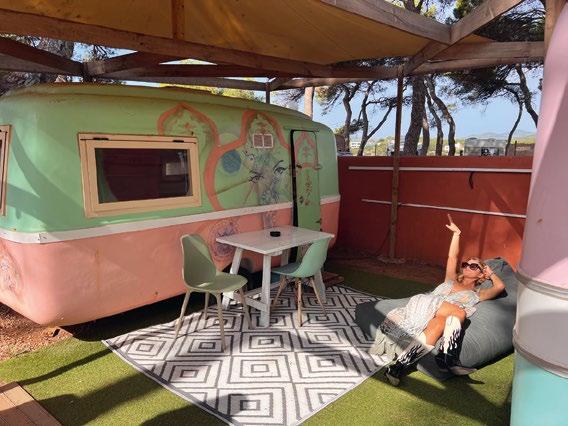



La fauna ibicenca nos muestra sus galanteos, mientras los vecinos de Sant Carles nos recuerdan los férreos protocolos del festeig ibicenco, unas normas de cortejo que hoy nos sorprenden. El amor lo encontramos también en los platos tradicionales que las abuelas preparan a sus familias, dejando un legado de cariño y sabor en cada bocado. También conocemos las recetas más sorprendentes que todavía encontramos en los libros antiguos de cocina de Ibiza y terminamos el paseo gastronómico con la gran novedad de Las Dalias para esta temporada: el vibrante restaurante PaloSanto.
Ibiza’s wildlife puts on mating displays, while Sant Carles’ residents remind us of the strict protocols of Ibiza courtship, rules that surprise us today. Love is also evident in the traditional dishes prepared by grandmothers for their families, leaving a legacy of affection and flavour in every bite. We also uncover the most surprising recipes still found in Ibiza’s old cookbooks and conclude the gastronomic journey with Las Dalias’ exciting new addition for this season: the vibrant PaloSanto restaurant.

ANIMAL MATING: AMID DANCES AND BITES
Cristina Marí
El instinto salvaje por excelencia es el de la supervivencia y he ahí la clave de la reproducción. Movidos por ese impulso, los animales dominan, muerden y sacan pecho, pero también cuidan, bailan y ofrecen su lado más cariñoso.
Los caminos del amor animal en tiempos de lucha feminista pueden parecer, cuanto menos, algo rocosos. Hay, sin embargo, muchas más similitudes que diferencias entre la fauna y la especie humana. Pero, ¿es posible hablar de amor animal? ¿Son consensuadas las relaciones animales? La bióloga ibicenca y gran experta en lagartijas pitiusas, Antònia Cirer, ríe ante la cuestión y apunta que no todo es el amor romántico que nos enseñó Walt Disney. Alerta Cirer de que no podemos humanizar a los animales, pero también matiza que la ‘violación’, comprendida en el lenguaje de los humanos, no existe en el mundo animal, aunque lo parezca. Es precisamente el proceso de cortejo el que permite a hembras y machos identificarse como miembros de la misma especie, asimilar su disponibilidad y ganas de emparejarse y, finalmente, consentir el acto de fecundación o acto sexual –aunque este, al final, sea el quickie más corto jamás visto.
ES, INDUDABLEMENTE, EL PARQUE NATURAL DE SES SALINES
Uno de los hábitats baleares más propicios a generar las condiciones para incitar ese cortejo e incluso la propia nidificación posterior es, indudablemente, el Parque Natural de Ses Salines de Ibiza y Formentera. A través de algunas de sus especies más comunes y las fotografías de Sebastián Candela, conocemos los entresijos del ‘romanticismo’ salvaje.
Chorlitejo: machos cuidadores
Solo tras el confinamiento de 2020, que limitó el acceso humano a las playas de la isla, el saltarín chorlitejo volvió a poner huevos en la playa de Es Cavallet, un acontecimiento histórico que no se había dado en 70 años. Esta especie limícola, que encuentra su hábitat natural en zonas húmedas como las orillas de las playas —en Ibiza completamente

Survival is indisputably the quintessential instinct of the wild, making reproduction key. It is this impulse that drives animals to be domineering, to bite each other and to thrust out their chests. Yet it also moves them to nurture one another, dance and display their most affectionate side.
In an era of feminist struggle, the paths of animal love may seem a bit rocky, to say the least. Nevertheless, there are many more similarities than differences between fauna and the human species. Yet, can we, in fact, really speak of animal love, and are animal relationships consensual? Antònia Cirer, an Ibizan biologist and the leading expert on the lizards of the Pityusic Islands, laughs at the question and points out that not everything is like the romantic love we have learned from Walt Disney. Cirer warns that we cannot humanise animals, though she also points out that the concept of “sexual violation’ as understood in human language, does not exist in the animal world, no matter what it may look like. It is precisely the courting process that enables females and males to identify each other as members of the same species, to assimilate their willingness and desire to mate and, finally, to agree to the act of fertilisation or sexual intercourse – even if it is ultimately the shortest ‘quickie’ ever seen.
THE CONCEPT OF “SEXUAL VIOLATION’ DOES NOT EXIST IN THE ANIMAL WORLD
Without a doubt, one of the most propitious Balearic habitats in creating the conditions conducive to mating and even subsequent nesting is Ses Salines Natural Park of Ibiza and


impactadas por la presión humana—, busca también la privacidad de los montículos de arena para su reproducción. Desafortunadamente, ese terreno ganado que propició la pandemia ha vuelto a reducirse considerablemente, y este ave se encuentra en protección especial.
A pesar del reto a su supervivencia, los chorlitejos tienen una particularidad a la hora de emparejarse y reproducirse. Los machos se esfuerzan sobremanera, llegando a construir hasta cuatro o cinco nidos diferentes para que, después, la hembra escoja el que más le guste para poner sus huevos. Hay reparto de tareas, ya que ambos incuban y cuidan el nido. Pero este esfuerzo no le conlleva exclusividad al chorlitejo macho, ya que las hembras de esta especie pueden tener puestas de huevos con otros machos en el mismo período de tiempo.
Flamenco: caricias a corazonadas
Ese precioso tono rosado que les da la artemia, la gambita de la que se alimentan, será clave en su cortejo, y es que los flamencos buscarán parejas que se asimilen en tono. Buscarán, como otras aves, ese rosado intenso de forma intencionada, maquillando sus plumas. Su cuello alargado y su pico redondeado son dos importantes elementos que enfatizan sus movimientos de cortejo. El naturalista Miquel Ramis, que observa a los flamencos en el Parque de Ses Salines con asiduidad, los ha avistado en ocasiones en actitud flamante, cuando las temperaturas aumentan. “Al principio caminan en grupo, con el cuello erguido y la cabeza alta, girándola primero hacia la izquierda y luego hacia la derecha, como en un baile sincronizado”, explica Ramis. Una vez se identifican individualmente, el macho y la hembra inician un largo juego de verdaderas carantoñas con su pico en torno a la cabeza y el cuello de su contraparte, acariciándose de forma irrefutable, a menudo ofreciendo esa perfecta foto, con sus alargados cuellos, de una forma de corazón. Finalmente, un ‘beso’ al tocarse las puntas de sus picos: el clímax de su cortejo y la señal de que están listos para el acto de apareamiento, cuando sea el momento adecuado.
En los últimos años, debido a la sequía en otras zonas de su ruta migratoria, los flamencos han multiplicado su presencia en Ses Salines de Ibiza y Formentera. De hecho,
Formentera. Here, some of the park’s most common species, along with photos taken by Sebastián Candela, provide insight to the intricacies of this wild ‘romanticism’.
Kentish plover: caretaking males
It was only after the confinement of 2020, which limited human access to the island’s beaches, that this plover went back to laying eggs on the beach of Es Cavallet. This was an historic event that had not occurred in 70 years. This wading bird that naturally inhabits wetland areas such as the shores of Ibiza’s beaches –which have been totally impacted by the pressure of human activity–, also seeks the privacy of the mounds of sand for its reproduction. Unfortunately, that reclaimed terrain brought about by the pandemic has been significantly reduced again, and this bird is now under special protection.
Despite the challenges faced by this bird in terms of survival, the Kentish plover is unique when it comes to mating and breeding. The males overexert themselves, building up to four or five different nests so that the females can then choose the ones they like best for their eggs. The tasks are shared, as both the male and the female incubate the eggs and look after the nest. Yet this massive exertion does not give the male plover exclusive rights over his mate, as the females of this species can also lay eggs with other males during the same period of time.
instinctual
That beautiful pinkish hue that they get from their brine shrimp diet becomes a key factor in their reproduction, as flamingos seek out mates of similar hues to their own. Like other birds, they intentionally colour their feathers to obtain an intense pink colour. Their elongated necks and rounded
por primera vez en años recientes, han llegado a poner huevos en las motas salineras, aunque estas puestas no han sido fructíferas hasta la fecha. Por tanto, se espera con expectación la posibilidad del primer nacimiento de crías pitiusas en el futuro próximo: el fruto más preciado del amor animal.

Tarro blanco: el canto y el jaleo
Desde el mes de febrero, los cantos de pelea y atracción del tarro blanco ya se escuchan en el Parque natural de Ses Salines. Muchos utilizan el canto para hacerse ver y atraer a las hembras, una vez empieza el buen tiempo. En esa convivencia de estas bonitas ánades, los jaleos o peleas también vienen dadas por la lucha por un buen lugar donde plantar el nido. “Imagínate que tienes un piso disponible con vistas al mar y otro con vistas al patio interior —explica el naturalista Miquel Ramis— ¡ellos se pelean también por el piso con vistas al mar!”. Y es que en esas les va también el defender su reproducción, y han de resguardar el lugar donde poner sus huevos.
En el caso del tarro blanco, además, las parejas pueden perdurar. En ocasiones encontrarán parejas que pueden ser simplemente anuales, durar unos años o que, incluso, si el matrimonio marcha, pueden alargarse para toda la vida. En las salinas ibicencas se detectan anualmente unas 80 parejas.
beaks are two important elements that accentuate their courting manoeuvres. Natural scientist Miquel Ramis, who regularly observes the flamingos in Ses Salines Natural Park, has sometimes seen them displaying flamboyance when the weather warms up. “At first they walk in a group, with their necks upright and their heads high, nodding first to the left and then to the right, as though in a synchronised dance,” Ramis explains. Once they identify each other individually, the male and female engage in a long round of genuine stroking, nuzzling their beaks around each other’s head and neck in unquestionable caresses, and often providing the ideal photo, as they form a heart shape with their long necks. Finally, they ‘kiss’, as the tips of their beaks touch: the high point of their courtship and the indication that they are ready for the act of mating, when the time is right.
In recent years, flamingos have grown in numbers in Ses Salines Natural Park, due to drought in other areas along their migratory route. In fact, for the first time in the last few years, they have even come to lay eggs in the salt marshes, although thus far those lays have not been productive. Therefore, with great expectation, the locals await the birth of the first Pityusic flamingo hatchlings in the near future. The most valued result of this animal’s love.
Since the month of February, the Common shelduck’s songs of battle and mating can be heard in Ses Salines Natural Park. Many of the males use the song to make themselves stand out and to attract females, once the warm weather arrives. When among these beautiful female ducks, the squabbles and fights also occur as they compete for a good place to build a nest. “Imagine you have an available flat with a sea view and another with a view of the inner courtyard,” explains natural scientist Miquel Ramis, “they too fight over the flat with the sea view! In fact, this is also part of defending their reproduction, which means they must protect the place where their eggs will be laid.


Avoceta: de par en par
Estas preciosas aves de pico puntiagudo, que les ayuda a rebuscar en la arena de los humedales, eligen, cada vez más, quedarse en Ibiza. Con su plumaje blanco y negro — que nos puede recordar a un pingüino— siempre van en parejas elegidas, con un macho al que le complace ofrecer comida y gustar a la hembra.
El aumento de temperaturas en las Pitiusas ha propiciado que estas aves estén cada vez más presentes todo el año. Hasta épocas recientes solo eran aves de paso que, al terminar el verano, marchaban hacia el sur de la península ibérica. Este pasado febrero se detectaron una decena de ejemplares y la presencia de algunos de estos es ya permanente en las islas. Tanto, que ahora incluso nidifican en las salinas ibicencas.
Ánades: regalitos para gustar
¿Un pececito moribundo? ¿Un trocito de alga? ¿Una conchita? Podrían parecer insignificantes deshechos marinos, pero para un ánade pueden decidir el futuro de la especie. Puede que exageremos un poquito, pero los regalos son un bien preciado para todas las especies de ánades en general. Regalitos para agradar a las hembras.
El ánade real, o cuello verde, es uno de los más comunes que también se encuentra en el parque natural de Ses Salines. Los machos despliegan una cabeza de plumaje verde oscuro aterciopelado, con una lista blanca que delimita el resto del plumaje de su cuerpo, de colores
Moreover, in the case of the Common shelduck, partnerships can be long-term. Some couples can be simply annual, others can last a few years, and still others, if the marriage is successful, can even last a lifetime. In the salt marshes of Ibiza, some 80 couples are identified each year.
These beautiful birds with their pointed beaks, which enable them to rummage through the wet sands of the shore, have been opting to stay on Ibiza increasingly more. With their black and white plumage (which could be reminiscent of a penguin), they always go round in chosen pairs, the male taking pleasure in pleasing the female and offering her food.
The increase in temperatures in the Pityusic Islands has led more and more of these birds to take up residence here all year round. Until recently, they were only migratory birds that would head to the south of the Iberian Peninsula at the end of summer. Last February, around ten individuals were detected here, and some of these birds are already permanent residents of the islands. So much so, that they are now even nesting in Ibiza’s salt marshes.
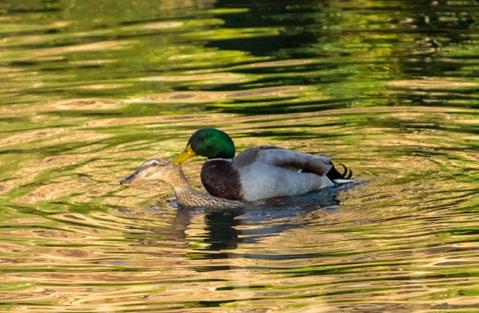
A dying fish? A scrap of seaweed? A small shell? Though they may seem to be mere bits of marine debris, for a Mallard duck they can determine the future of the species. This may be a slight exaggeration, but as a general rule, gifts are valued items for all duck species. These little presents are meant to please the females.

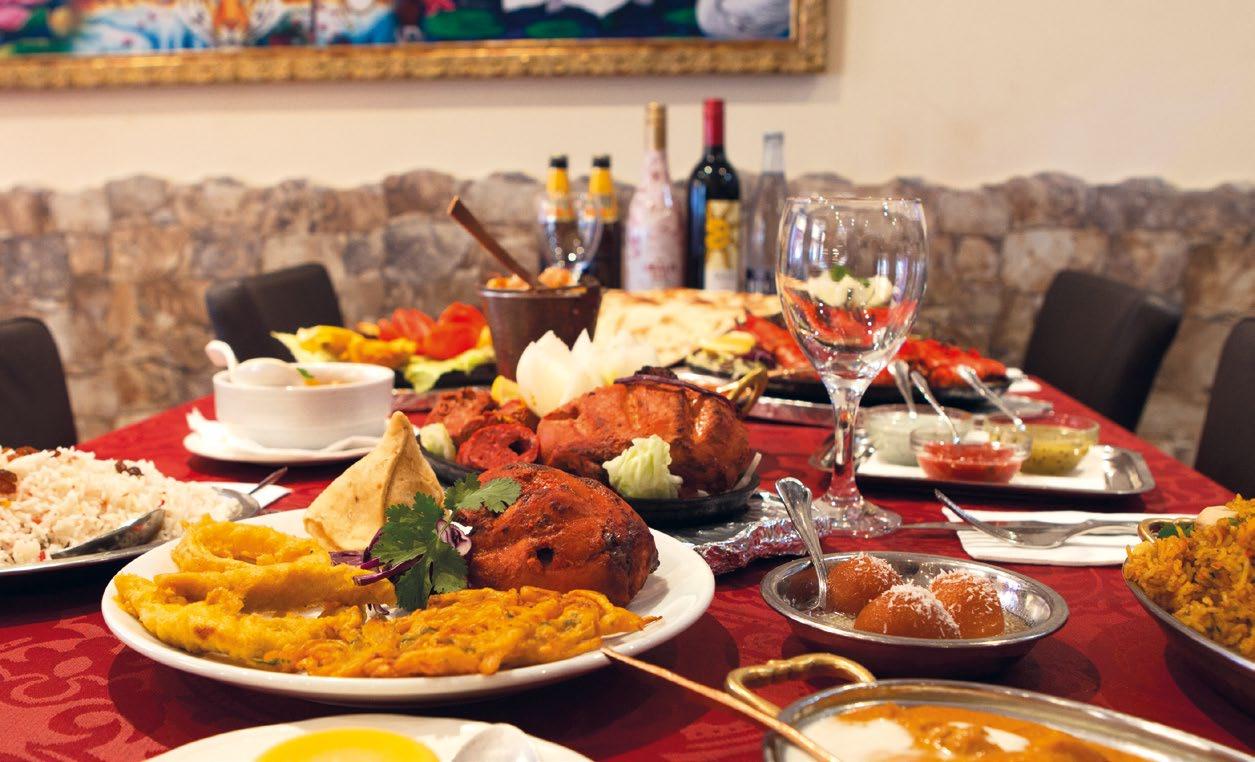
marrones. Las hembras, por su parte, lucen tonos marrones que las hacen pasar más desapercibidas. Sin embargo, en su ala mantienen una franja de plumas azulonas o moradas muy simétrica. Esta misma les permitirá diferenciarse de otras especies ante los machos, facilitando la identificación mutua a la hora de emparejarse.
PASAN POR LAS SALINAS IBICENCAS
ESPECIALMENTE EN PRIMAVERA, CUANDO SE CUENTA LA PRESENCIA DE UNOS 60 EJEMPLARES
Cigüeñuela común: el guapo plumaje
Estas preciosas aves de largas y finas patas rosadas adoptan su mejor look en la época primaveral. Los machos lucen un plumaje negro brillante, elegante, para hacerse ver. Las reverencias, junto con la agitación de las alas, son algunos de los elementos de su danza festiva. Cuando la hembra se siente preparada, eleva su trasero, una señal al macho para que la monte. Con gran esfuerzo físico, el macho, al vuelo, se posará sobre ella, flexionando al máximo sus patas alargadas, de aspecto frágil. Después marchará.
La bióloga Antònia Cirer explica que todas las especies se enfrentan a este tipo de exigencia física, de cortejo y reproducción. Y es que la supervivencia de los individuos lo condiciona todo y son conscientes de los factores de su entorno.
Las cigüeñuelas son aves que pasan por las salinas ibicencas especialmente en primavera, cuando se cuenta la presencia de unos 60 ejemplares. Desde hace algunos años, unos pocos han decidido quedarse en la isla de manera permanente. La disposición de alimento y zonas de nidificación son algunos de los factores que hacen que el Parque natural de Ses Salines sea un remanso, pero la presión humana del verano juega en contra.
The Mallard, or wild duck, is one of the most common ducks found in Ses Salines Natural Park. The heads of the males are covered in velvety dark green feathers with a white strip that demarcates the rest of their plumage, which is brown. The females, on the other hand, wear brownish tones that render them less noticeable. Nevertheless, on their wings they have a very symmetrical strip of bluish or purplish feathers that sets them apart from other species in the eyes of the males, thus facilitating mutual identification for mating.
Black-winged stilt: handsome plumage
These beautiful birds, with their long, slender pink legs, look their best in spring. Males sport an elegant, lustrous black plumage that is designed to get them noticed. Bowing their heads and wing flapping are some of the moves of their festive dance. When the female feels ready, she raises her hindquarters, signalling to the male to mount her. With great physical effort, the male, in flight, will then land on her, flexing his long, fragile-looking legs as far as they go. And afterwards, he will leave.
Biologist Antònia Cirer explains that all species must face this sort of physical challenge of mating and reproduction. In a word, the individuals’ survival determines everything, and they are aware of the environmental factors around them.
THE INDIVIDUALS’ SURVIVAL DETERMINES EVERYTHING, AND THEY ARE AWARE OF THE ENVIRONMENTAL FACTORS AROUND THEM
Stilts are birds that pass through the salt marshes of Ibiza, particularly in spring, when around 60 specimens can be counted. For some years now, a few of these birds have decided to stay on the island permanently. The availability of food and nesting areas are among the factors that make Ses Salines Natural Park a haven, yet the heavy pressure of human activity during summer works against them.
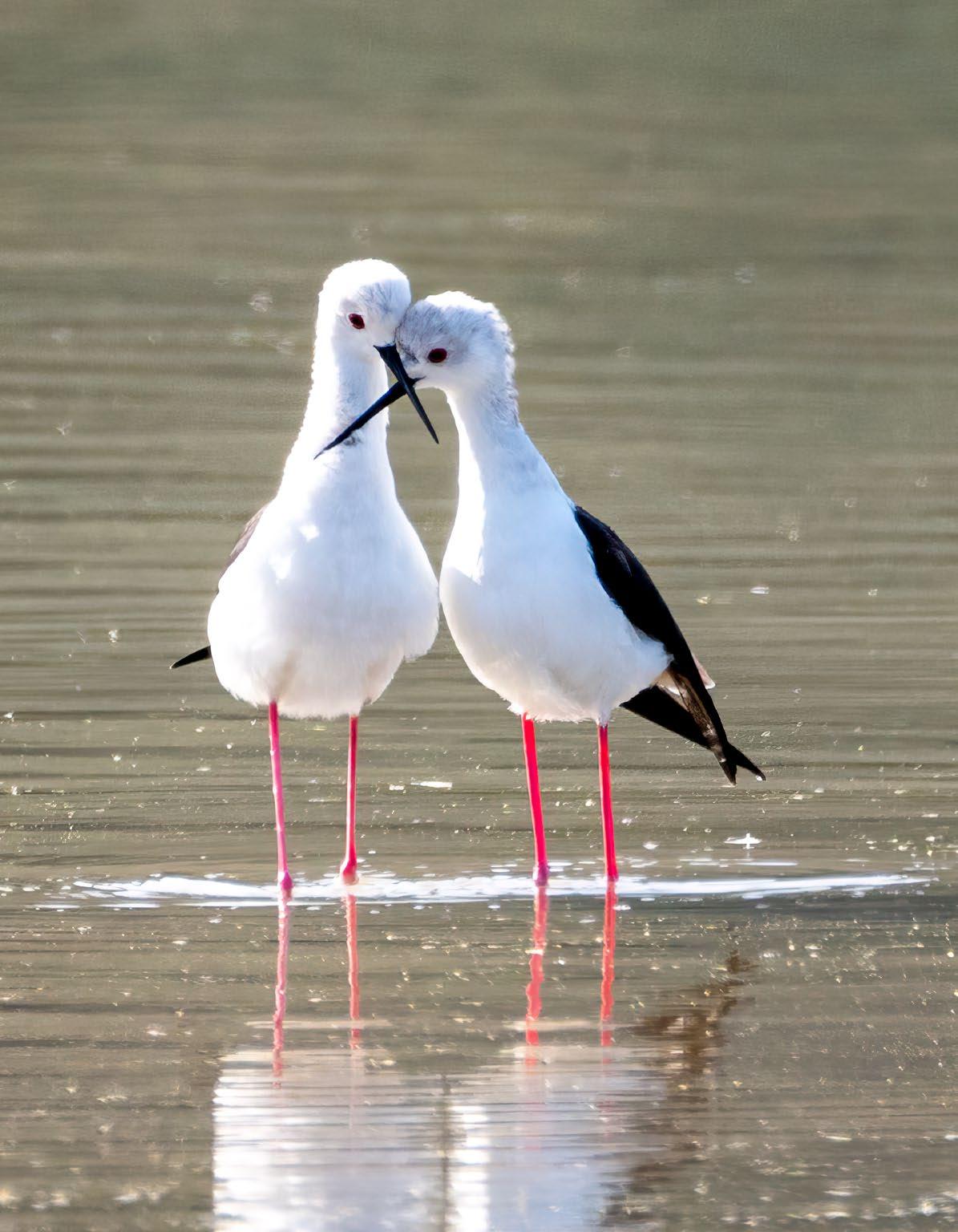 Cigüeñuelas en Ses Salines.
Cigüeñuelas en Ses Salines.

Lagartija: a mordiscos eróticos
Aparente pelea, mordisco y “pim-pam”. Así describe el cortejo de las lagartijas, con matices, la mayor experta pitiusa en ellas, la bióloga Antònia Cirer. “Visto desde el prisma de los tiempos que corren, tan concienciados contra la violencia de género, nos puede sorprender”, dice Cirer en tono irónico, tras recordar sus primeros avistamientos del cortejo de este reptil amenazado.
Un macho afortunado en amores será un macho “con tableta”, siguiendo con las comparativas humanas. En las Pitiusas, los de colores más vivos, con marcadas líneas en su costado y de tamaño contundente, tendrán también la ventaja a la hora de encontrar una hembra que quiera ceder a sus señales y elegirlo, con toda intención, para su reproducción. Las lagartijas macho y hembra se identificarán particularmente por los olores, que ya perciben en la distancia a través de la lengua. Para señalar su interés definitivo, se acercarán y el macho intentará morder la cola de la hembra; un mordisco con clara intención sexual y que así percibe la hembra. Si la hembra consiente y desea, en ese rápido instante de ajetreo el macho la fecundará con su pene bifurcado – ¡sí, en efecto! Sujetará a la hembra con una bifurcación del pene y, con la otra, la fecundará. Tras ese acto, que dura apenas unas décimas de segundo, cada uno marchará por donde vino. Y si te he visto no me acuerdo.
Lizard: erotic love bites
It looks like a fight, a bite, and “wham-bam”, it’s over. This is how biologist Antònia Cirer, the leading lizard expert in Ibiza and Formentera, describes the mating habits of these reptiles, with some nuances. “Seen through the lens of the present day, at a time of heightened awareness of gender violence, this could surprise you “, says Cirer with irony, after recalling her first sightings of this endangered lizard’s mating ritual.
To continue with human comparisons, a male who is lucky in love will be “well-sculpted”. In the Pityusic Islands, the most sizeable and vividly coloured males, with vibrant lines on their flanks, will also have the advantage when it comes to finding a female who is willing to give in to their cues and intentionally choose them for reproduction. Male and female lizards particularly identify each other by their scent, which they can detect from a distance using their tongues. To indicate their interest in one another, they will approach each other and the male will try to nip at the female’s tail, with clear sexual intent, which the female recognises. If the female is consenting and willing, in a quick flurry, the male will impregnate her with his forked penis. Yes, it’s true! He will use one branch of his forked penis to take hold of the female and he will fertilise her with the other. After this act, which lasts just a few tenths of a second, each of them will go back to where they came from. “And if I ever saw you again, I wouldn’t know you.”



Bienvenido a Can Lluc, donde la esencia de Ibiza se despliega en su forma más pura y auténtica. No somos simplemente un destino; somos una promesa, una invitación a experimentar la isla como nunca antes. En Can Lluc, el espíritu de Ibiza late con un ritmo tranquilo y sereno, en un santuario donde la tradición se abraza con la exclusividad bajo el cálido sol del Mediterráneo, y donde tu descanso y disfrute aparcan todo lo demás.
Descansa. Disfruta. Existimos para ofrecerte un refugio donde la naturaleza y el lujo coexisten en armonía perfecta. Nuestros jardines de olivos, limoneros y aromáticos pinos son el escenario de tu escape del mundo exterior. Cada rincón de Can Lluc ha sido cuidadosamente diseñado para asegurar que tu estancia no solo sea placentera, sino reparadora.
Nuestra misión es clara: proporcionarte una experiencia genuina, lejos de los clichés turísticos. Queremos que descubras el verdadero corazón de Ibiza, sumergiéndote en sus raíces, su cultura, su historia y su vibrante vida nocturna; y luego regreses a la paz y calma de tu hogar temporal con nosotros.
Can Lluc es más que agroturismo; es una celebración de la vida, del bienestar y del disfrute sereno. Aquí, cada detalle, desde la comida que servimos hasta la almohada en la que descansas, está pensado para celebrar la belleza y la simplicidad de la vida ibicenca.
Welcome to Can Lluc, where the essence of Ibiza is unveiled in its purest and most authentic form. We are far more than a destination; we represent a commitment: an invitation to experience the island as never before.
Here at Can Lluc, the island’s laid-back atmosphere blends with our exclusive setting under the warm Mediterranean sun, making your relaxation and enjoyment our top priority.
Rest. Enjoy the peace. We offer a retreat where nature and luxury blend seamlessly. Our lush gardens, filled with olive trees, lemon groves, and aromatic pines, help you to escape from the outside world. Every corner of Can Lluc has been thoughtfully crafted to ensure that your stay is not just pleasant but thoroughly rejuvenating.
Our mission is straightforward: to deliver a profoundly authentic experience, well away from the well-trodden tourist paths. We invite you to explore the true spirit of Ibiza, delve into its culture, history, and vibrant nightlife; then return to the serenity of Can Lluc.
Can Lluc goes beyond simple agritourism; it is a celebration of life, wellness, and tranquillity. Every detail, from our expertly prepared cuisine to the comfort of your room, is meticulously curated to honour the beauty and simplicity of Ibizan life.


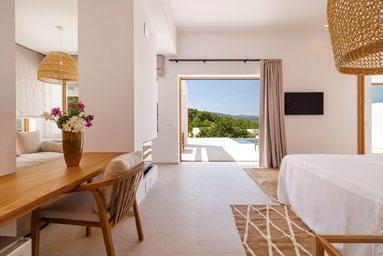




Las costumbres del cortejo entre la payesía ibicenca llegaron a incluir bizarradas como tirarle piedras a un pretendiente afortunado para intentar espantarlo y ganarle el sitio ante una mujer. En Sant Carles aún quedan quienes lo recuerdan.
Eulària Torres no quería enamorarse. A los 14 años ya se presentaban en su casa, en el pueblo de Sant Carles de Peralta, grupos de chavales jóvenes con intención de ganarse su gracia. Recuerda cómo se escondían, ella y su mejor amiga, cuando se les oía llegar a lo lejos, mientras su madre les cubría las espaldas y se inventaba que habían salido de casa para que las dejaran en paz. “Yo no quería sufrir, pero, sobre todo, no quería hacer sufrir a mi madre”, dice Eulària, nacida en 1933, a sus 91 años recién cumplidos. No tenía prisa en enamorarse ni en atarse a nadie porque para la joven de Peralta, en aquel momento, emparejarse suponía sufrir.
The customs of courtship among the Ibizan peasantry even included outlandish things like throwing stones at a lucky suitor in an attempt to scare him off and take away his position with a woman. Some people in Sant Carles still remember this.
Eulària Torres never wanted to fall in love. When she was 14 years old, groups of young boys would already show up at her house, in the village of Sant Carles de Peralta, to win her over. She recalls how she and her best friend would hide when they heard them coming from a distance, and the way her mother would protect them, saying they had left the house, so the boys would leave them alone. “I didn’t want to worry, but, above all, I didn’t want to make my mother worry”, says Eulària, who, born in 1933, has recently turned 91 years old. She was in no hurry to fall in love or to tie herself to anyone, because at that time, for a young woman from Peralta, marriage was synonymous with worrying.
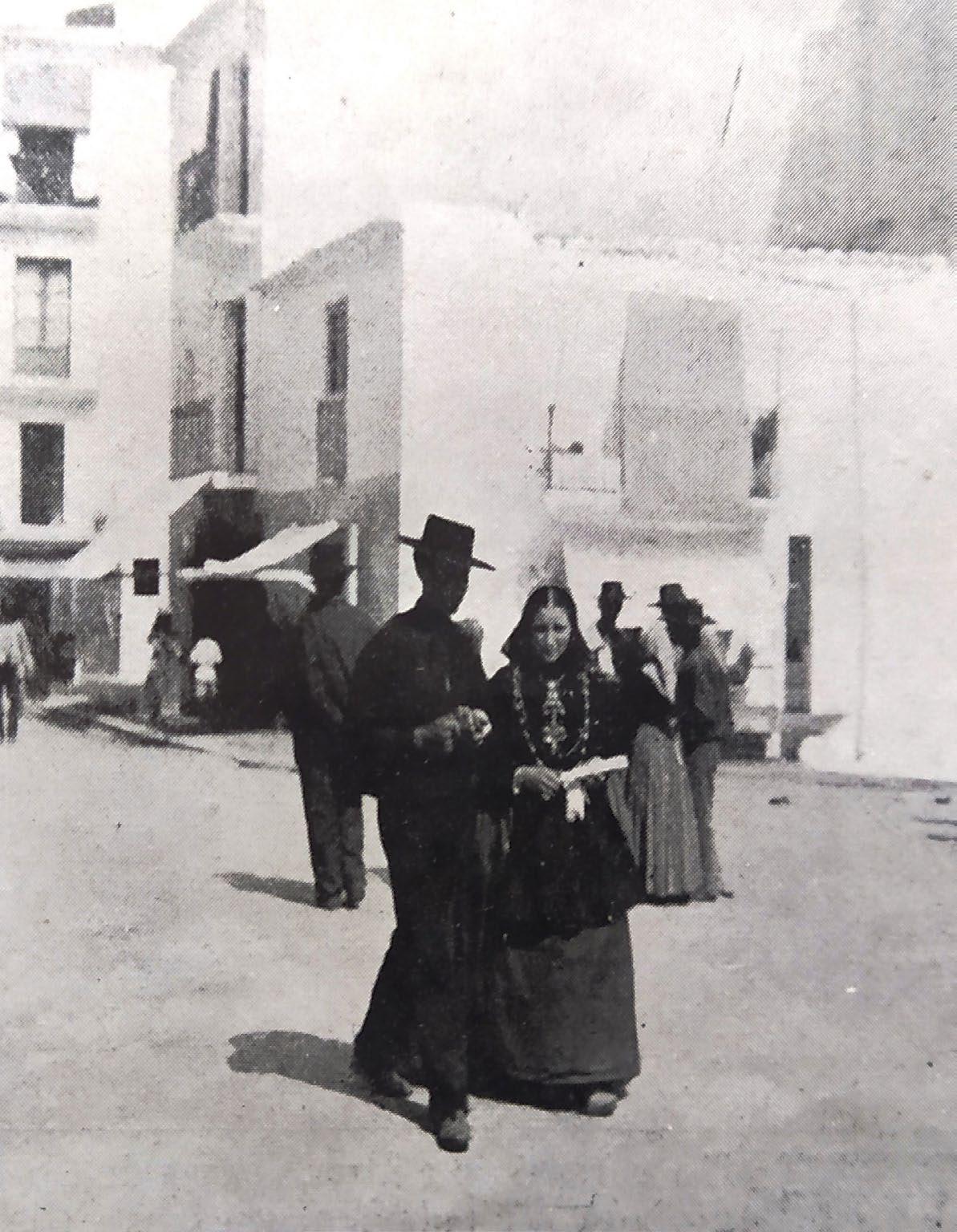 Una pareja ibicenca paseando por la Marina en el año 1913. Ilustración catalana, sin firma. Colección Joan-Albert Ribas.
Una pareja ibicenca paseando por la Marina en el año 1913. Ilustración catalana, sin firma. Colección Joan-Albert Ribas.
Había conocido el amor romántico a través de su hermana Catalina, siete años mayor, hoy ya fallecida. Catalina, ya de cría, andaba diciendo que su mejor amigo de la infancia, Pep, era su novio. A los 16 años, a Pep lo reclutaron para luchar en la guerra y, a escondidas, Eulària leía las cartas que él le enviaba a su estimada hermana desde el frente. “Le decía que, a lo mejor, aquella era su última carta; que, a lo mejor, se moría porque sus compañeros allí caían como moscas,” explica Eulària. “Y yo veía a mi hermana que lloraba… y lloraba mucho.”
Catalina y Pep, que sobrevivió, se casaron y su historia tuvo un final feliz. Pero había otro factor que hacía que Eulària, payesa —como tantas otras de carácter emancipado—, no tuviera ninguna prisa en comprometerse. En aquella Ibiza de los años 40, lo tradicional para muchas mujeres que se casaban con herederos era mudarse a casa del marido. Así, abandonaban su nido y no solo se casaban con un hombre, sino también con toda su familia. “Me daban miedo los suegros, que en aquella época ho duien tot davall sa sabata [lo controlaban todo]”, explica Eulària, y sentencia: “La mujer que entraba en casa era la última en entrar… Y yo no quería ser la última ni ser una mandada”.
POR GANARSE A UNA MUJER
—Y DEMOSTRAR SU VALÍA— ERA
A MENUDO MOTIVO DE BREGAS, PELEAS, NAVAJAZOS E INCLUSO ALGÚN TIRO
El cortejo ibicenco
Eulària y aquellos chavales que se acercaban a su puerta habían heredado la Ibiza de sus padres, de sus madres, de sus abuelos y abuelas. En la Ibiza que conocemos de los siglos XVIII, XIX y hasta entrado el XX, el cortejo, esa laboriosa tarea de camelarse a una futura pareja, tenía sus normas, y la lucha entre hombres por ganarse a una mujer —y demostrar su valía— era a menudo motivo de bregas, peleas, navajazos e incluso algún tiro. Cuanto menos, alguna pedrada.
She had discovered romantic love through her sister Catalina, who was seven years older than her and who is now deceased. As a little girl, Catalina used to say that her best childhood friend, Pep, was her boyfriend. At age 16, Pep was drafted to fight in the war, and Eulària secretly read the letters he sent to her dear sister from the battlefront. “He would write that this might be his last letter; that he might die because his fellow soldiers there were dropping like flies,” Eulària explains. “And I saw my sister crying... and she cried a lot.”
Catalina and Pep, who had survived the war, got married and their love story had a happy ending. But there was another factor that dissuaded Eulària, a peasant woman like so many other emancipated women, from rushing into marriage. In the Ibiza of the 1940s, it was traditional for many women who married heirs to move into their husband’s family home. They would leave their own household behind and marry not only a man, but also his entire family. “I was afraid of the inlaws, who at that time ho duien tot davall sa sabata [they controlled everything],” explains Eulària, adding: “The new wife who came into the house was the last to arrive... And I didn’t want to be the last in line or bossed around”.
Eulària and the young men who came to her door had inherited the Ibiza of their fathers, their mothers, their grandfathers and grandmothers. In the Ibiza of the 18th, 19th and well into the 20th centuries, courtship, that arduous task of wooing a future partner, had its rules. Moreover, the struggle amongst the men to win over a woman —and prove their worth—often led to fights, brawls, knife wounds and even an occasional gunshot. Or at the very least, a small lapidation.
In an article for Diario de Ibiza, Ibizan historian Fanny Tur recovered scholar, archaeologist and amateur journalist

La historiadora ibicenca Fanny Tur recupera en un artículo para Diario de Ibiza la descripción que hizo del cortejo payés el erudito, arqueólogo y periodista aficionado Artur Pérez Cabrero para la primera guía turística de las Pitiusas, editada en 1909. En ella describe las peculiaridades de la costumbre que prevaleció durante décadas en la vida del campo:
«Las mozas, llamadas “atlotas” (sic), se dejan galantear por varios jóvenes (á veces por docenas) y por turno riguroso hablan con ellos cierto tiempo de la velada. Esta costumbre ha producido muchos disgustos por creerse agraviados los jóvenes por cualquier insignificante triquiñuela, ó por no habérseles cedido el puesto cuando les correspondía. Pero esto no sucede más que cuando la “atlota” es completamente libre y de esta manera busca y encuentra el motivo de su amor, que proclama cuando lo tiene, ciñéndose los anillos de oro y plata que, como arras, le entrega el preferido, sin la oposición de los demás y sin el más leve disgusto. La novia no vuelve á mirar ya, ni á ser mirada, por sus antiguos galanteadores...» (sic)
Artur Pérez Cabrero’s description of peasant courtship for the first tourist guide to the Pityusic Islands, published in 1909. In the guide, he described the peculiarities of the custom that prevailed rural life for decades:
«LAS MOZAS, LLAMADAS “ATLOTAS” (SIC), SE DEJAN GALANTEAR POR VARIOS JÓVENES Y POR TURNO RIGUROSO HABLAN CON ELLOS CIERTO TIEMPO DE LA VELADA»
“The young women, who were locally known as ‘al·lotes’, would allow themselves to be courted by several young men (sometimes by the dozen) and would speak to them for a certain amount of time during the evening, in strict rotations. This custom brought about countless fights, as the young men might feel wronged by some petty trick or because they had not been given their rightful turn. But this would only occur when the “al·lota” was completely free and therefore looking
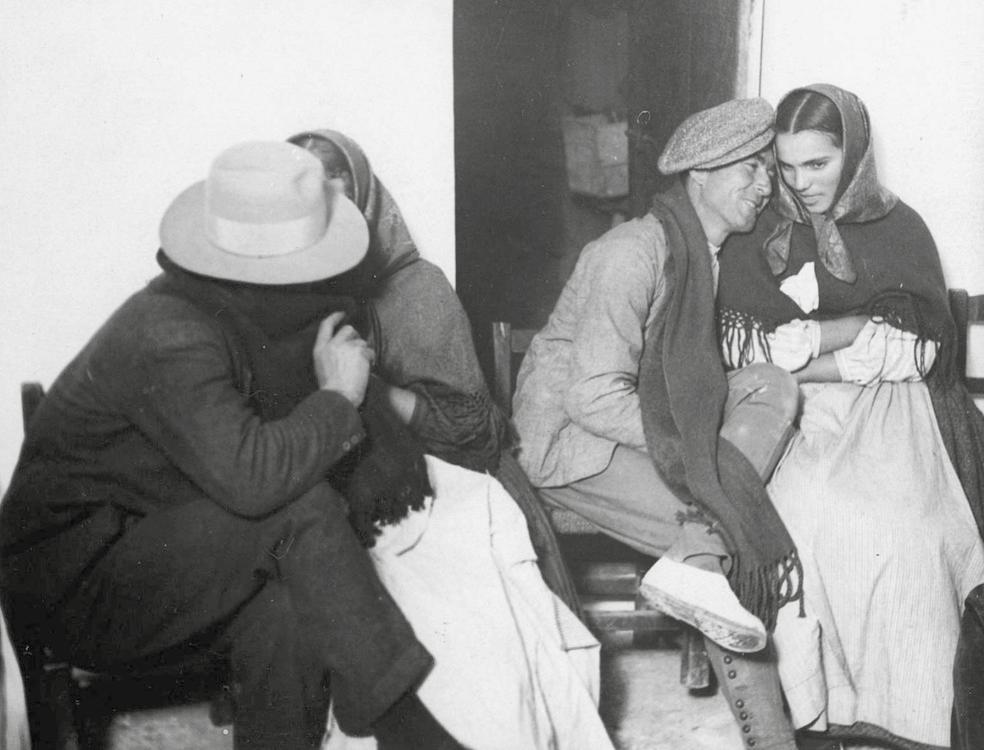
La historiadora recupera otros aspectos que se desprenden de este cortejo en los documentos del Arxiu Històric d’Eivissa, particularmente algunos que se convirtieron en noticia o que llegaron a los juzgados.
Está documentado que, en el año 1833, una noche de festeig, o de cortejo, en Sant Jordi, al sur de la isla, acabó en pelea con un herido y teniendo que intervenir la justicia. Las armas, muy presentes en esta época, a menudo formaban parte de la indumentaria o también de actos de celebración de la payesía. Incluso un artículo explica cómo en 1799, justo al salir de misa en el mismo pueblo, un hombre pega tiros a los pies de una payesa a modo celebratorio y fanfarrón, mientras ella atraviesa la polvareda sin inmutarse por el jolgorio —un signo, en la mujer payesa, que reverbera las maneras de su estoicidad ante los saltos del hombre en el tradicional ball pagès—.
for a reason give her love, which she would proclaim when she found it. At that point, she would accept the gold and silver rings given to her as a pledge of love by her favourite suitor, with no opposition or even the slightest discontentment from the others. The betrothed then no longer looked at or was looked at, by her former suitors...”
The historian retrieved other aspects of this courtship from the documents in the city’s historic archive, the Arxiu Històric d’Eivissa, and particularly some that made the news or reached the courts.
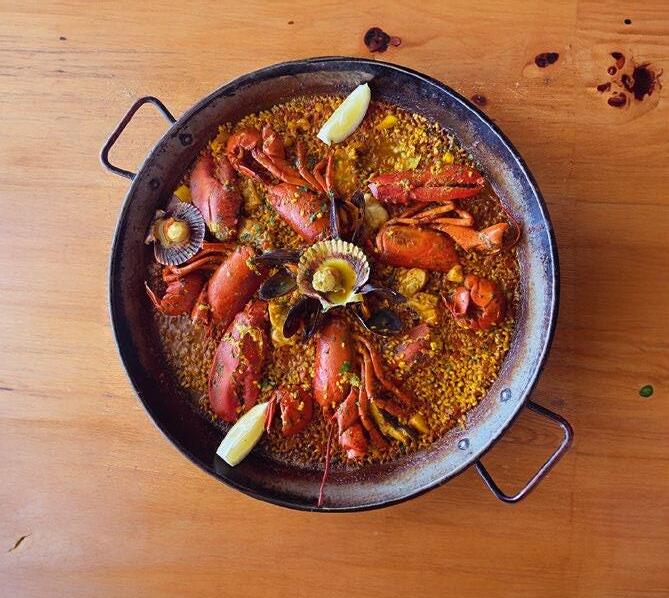

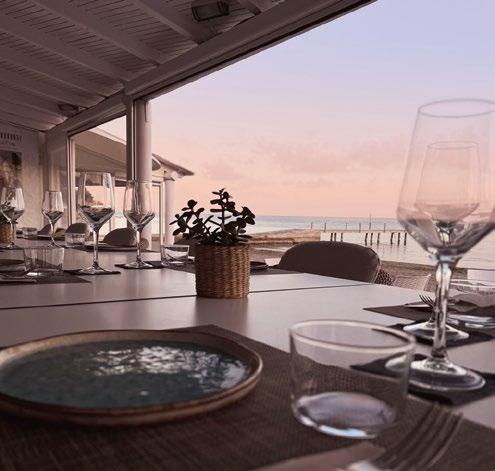

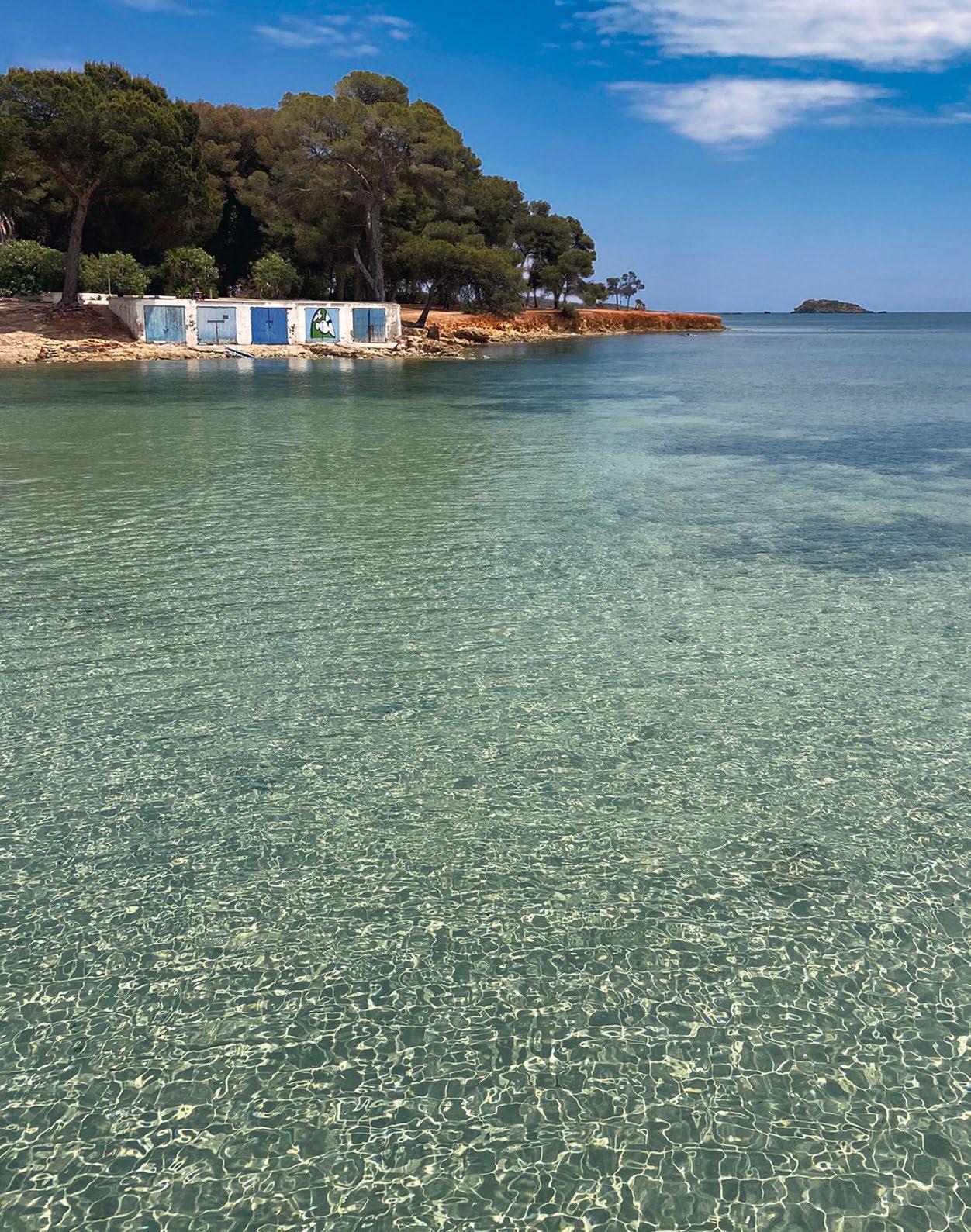
En los años 40 y 50, llevar la cuchilla aún era una costumbre. Eulària lo recuerda así porque su padre tenía un terreno en el que se abrió un campo de fútbol, que se llenaba con gente de los pueblos cercanos cuando había partido. “Cuando yo era pequeña en Sant Carles se llevaban aún muchas cuchillas”, dice Eulària. “Me acuerdo de ver muchas navajas tiradas detrás de una pared en el campo, porque igual las tiraban ahí antes de que les pillara un guardia”, explica. “Había mucha gente buena, pero también mucha juventud salvaje”.
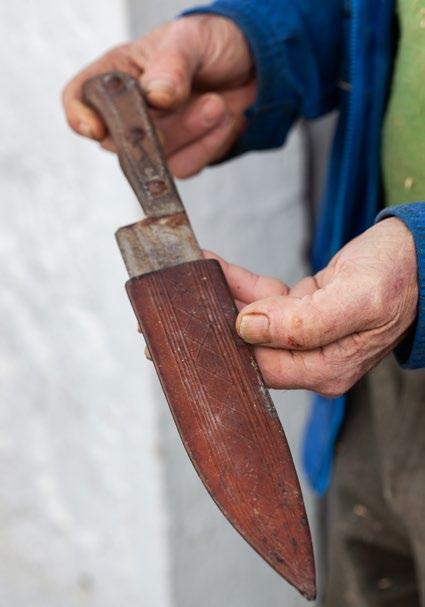
Toni Colomar, o como le llaman cariñosamente, ‘en Colomaret’, de 88 años, tuvo que intervenir entre amigos en más de una ocasión para evitar que el cortejo llegara a las manos. “Sant Carles ha tenido fama de que se llevara la cuchilla —admite Colomaret— pero yo nunca he tenido una y ninguno de mis amigos la ha tenido, aunque había siete u ocho en mis tiempos que eran los más salvajes del pueblo y la llevaban, lo cual no quiere decir que no les cayera igualmente alguna bofetada porque se las daban de machotes [verros]”.
According to historical records, in 1833, one night of festeig, or courtship, in Sant Jordi, in the south of the island, ended in a fight that resulted in one injured person, requiring the intervention of the justice system. Weapons, which were very common in those times, often formed part of the peasants’ everyday attire and their celebrations and festivities. One article even explains how in 1799, just after leaving mass in the same village, one man jubilantly and boastfully fired shots at the feet of a peasant woman as she walked through the dust, unmoved by the revelry –a glaring sign of the peasant woman’s stoicism in the face of the man’s hopping and leaping in the traditional peasant dance known as the ball pagès.
88 AÑOS, TUVO QUE
In the 40s and 50s, it was still customary to carry a knife. Eulària remembers it because her father had a piece of land where a football pitch was opened, often filling up with people from nearby villages when there was a match. “When I was little in Sant Carles, they still carried around lots of blades,” says Eulària. “I remember seeing lots of knives on the ground behind a wall, because people probably threw them there before they got caught by a state policeman,” she explains. “There were plenty of good people, but also plenty of wild youths”.
Toni Colomar, or ‘Colomaret’, as he is affectionately known, who is now 88 years old, had to step in between friends on more than one occasion to prevent the flirtation from going to blows. Sant Carles was known as a place where people carried around knives,” admits Colomaret, “but I have never owned one and none of my friends ever did, either. But back in the day there were seven or eight really wild guys in the village who carried them, which doesn’t mean they didn’t get slapped around a bit because they acted like tough guys”.
Yet before they came to blows, certain things had to happen. In any case, violence would erupt like a cockfight. And there was so much more to courtship than that.



Pero antes de llegar a las manos debían ocurrir ciertas cosas. La violencia, en todo caso, llegaba como una pelea de gallos. Y el cortejo era mucho, muchísimo más que eso.
Por el camino de misa
Aún en la Ibiza de hasta mediados del siglo XX, el momento tradicional de cortejo solía darse especialmente los domingos, cuando la mujer se arreglaba e iba con su familia a misa. “Las chicas festejaban en la puerta de la iglesia,” explica en Colomaret. “Aún no había terminado la misa, que ya habían salido todos los chicos porque, si esperaban, igual se quedaban sin hablar con ninguna. Por el camino de misa iban todas las chicas y luego, de vuelta, los chicos las acompañaban a casa, pero, por supuesto, con los padres de ella, que iban detrás o delante.”
Pero no era un juego unilateral. “Faltaba también que el chico fuese del agrado de ella”.
Y en el juego de esas tardes de domingo, en el que ellas tenían aparentemente la última palabra, era común que las jóvenes recibieran a pretendientes en sus casas. A menudo llegaban y hacían cola mientras, uno a uno, iban teniendo un ratito de charla con la mujer que les daba, o no, coba. Así podían estar años, y siempre, siempre, bajo la mirada vigilante de una madre, un padre, o una abuela. Jamás se quedaban a solas con un hombre con quien no se hubieran casado.
Otro vecino de Peralta, Pep Xumeu, recuerda el relato de cómo lo vivieron generaciones anteriores. “Iban tres o cuatro pretendientes para ganarse el sitio, y se quedaban esperando mientras uno charlaba con la chica. El que estaba fuera tiraba una piedrita al lado del que estaba con la chica. Si a la tercera piedrita él no salía, ya había brega”, explica. Si uno conseguía ganarse la predilección de la chica, era bastante común que los otros intentaran espantarlo a pedradas cuando salía, como venganza o para espantarlo y que no volviera.
Up until the mid-20th century in Ibiza, the traditional moment of courtship tended to take place on Sundays, when the women would get dressed up and go to mass with their families. “The girls would flirt at the door of the church,” explains Colomaret. “Mass wasn’t even over yet, and all the boys were already outside, because if they waited, they might not get to talk to any of them. On the way to mass, you’d see all the girls, and on the way back, you’d see the boys walking them home, but, of course, the girls’ parents were also there, walking either just behind or in front of them”.
Yet this was no one-sided game. “The girl also had to like the boy”.
And as part of those Sunday afternoons of interplay, where the girls apparently had the final say, the young women commonly received suitors in their homes. The young men would often arrive and queue up. One by one, they would then have a little chat with the woman who might or might not flirt back with them. They could continue to do this for years, absolutely always under the watchful eye of a mother, a father or a grandmother. They were never left alone with a man who was not married to them.
IF ONE MANAGED TO WIN OVER THE GIRL, IT WAS QUITE COMMON FOR THE OTHERS TO TRY TO CHASE HIM AWAY BY THROWING STONES AT HIM AS HE CAME OUT
Another resident of Peralta, Pep Xumeu, recalls the story of how previous generations had courted. “Three or four suitors would go to claim their spot, and they’d wait there while one of them chatted with the girl. The guy who was next in line outside would throw a pebble next to the one who was with the girl. If he didn’t come out by the third pebble, there’d be a fight,” he explains. If one managed to win over the girl, it was quite common for the others to try to chase him away by throwing stones at him as he came out, as a form of revenge or to scare him off so that he wouldn’t come back.

EVERY THURSDAY // FROM 7PM
@ROOFTOPNINE – IBIZA INNSIDE IBIZA BEACH
Xumeu ya no experimentó la piedrita en sus tiempos, pero sí un cortejo agotador con la mujer de quien estaba enamorado, hasta el punto de pasarse cuatro años viéndose bajo la atenta mirada de la madre de su esposa Maria. Cuatro años de planificadas y vigiladas visitas, hablándose entre susurros.
“La madre de Maria, Eulari, siempre estaba por allí y no nos dejaba ni un momento”, explica Xumeu. De hecho, la anécdota chocó a sus compañeros peninsulares de la mili, que alucinaron con esa falta de intimidad entre las noveles parejas ibicencas ya bien entrados los años 60. Era una costumbre propia de los pueblos, que ya se había abandonado en gran medida en la ciudad y que sonaba extraña a forasters
LA PIEDRITA EN SUS TIEMPOS, PERO SÍ UN CORTEJO AGOTADOR
Intimidad y honor, incompatibles
Pero en esa falta de intimidad obligada por las costumbres de la época también había resquicios. Eulària aún recuerda las anécdotas que le contaba su madre, de enamorados que mantenían conversaciones a través de las rejas de una ventana a horas intempestivas, cuál Pepe y Adela en la lorquiana Casa de Bernarda Alba.
El propio Colomaret tuvo alguna de estas, como él describe, entre risas, “¡con un hierro en medio!”. Pero, además, su profesión como músico en las salas de fiestas del municipio le permitió ser testigo de muchísimas escapadas durante los bailes festivos en los que actuaba con su banda. “En esa época las mujeres no podían salir solas, tenían que venir a la sala de fiestas, a Las Dalias o a Ses Parres, acompañadas de sus madres, o de sus abuelas”. Desde el escenario y entre pases, el músico vio a muchas parejas aprovechar un despiste de sus acompañantes para irse, en sus palabras, “debajo de un algarrobo”. Secretos que se llevará a la tumba.
In his day, Xumeu never got to experience the little pebble game, but he did endure an exhausting courtship with the woman he was in love with, so much so that they spent four years seeing each other under the watchful eye of his wife Maria’s mother. Four years of planned and closely supervised visits, talking to each other in hushed whispers.
FROM THE STAGE AND IN BETWEEN DANCES, THE MUSICIAN SAW LOTS OF COUPLES TAKE ADVANTAGE OF THEIR CHAPERONS’ DISTRACTION TO GO OUT
“Maria’s mother, Eulari, was always around and wouldn’t leave us for even a second,” says Xumeu. In fact, the story shocked his military service buddies, who were from the mainland and who were amazed by the lack of privacy of the young Ibizan couples well into the 1960s. This custom, which was typical of the villages and had largely been abandoned in the city, sounded strange to forasters, or mainlanders.
Intimacy and honour, incompatible
But there were also loopholes in this lack of intimacy forced by the customs of the time. Eulària still remembers the stories her mother used to tell her, of lovers chatting through the bars of a window at ungodly hours of the night, like Pepe and Adela in Lorca’s novel La Casa de Bernarda Alba (The House of Bernarda Alba).
Colomaret himself had a few of those chats, as he laughingly describes them, “with an iron bar in the middle! Yet, what’s more, his profession as a musician in the town’s nightclubs allowed him to witness many an escapade during the festive dances where he performed with his band. “In those days, women couldn’t go out alone; they had to come to the dance hall, to Las Dalias or Ses Parres, with their mothers or grandmothers”. From the stage and in between dances, the musician saw lots of couples take advantage of their chaperons’ distraction to go out, as he put it, “under a carob tree”. Secrets that he will take with him to the grave.
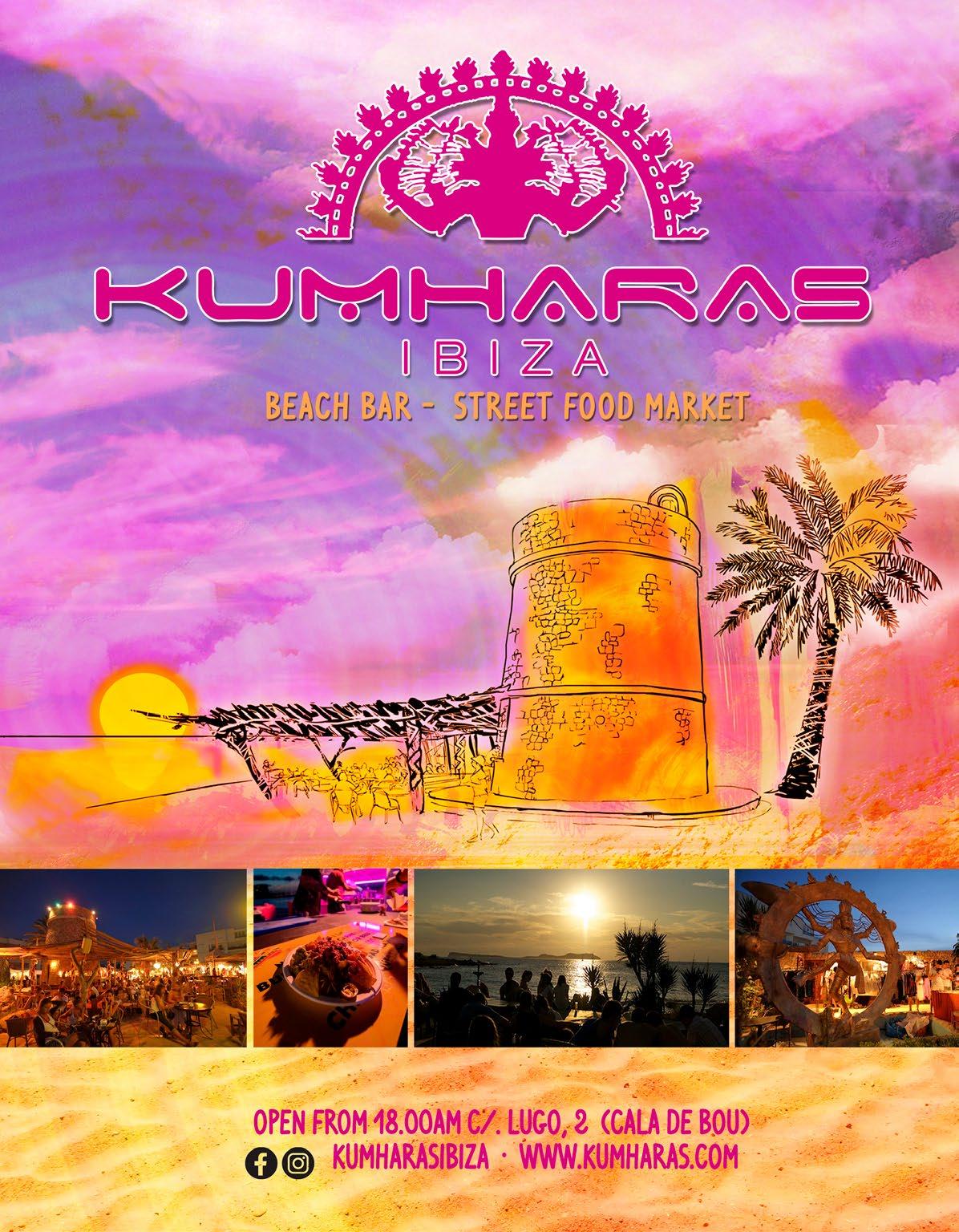
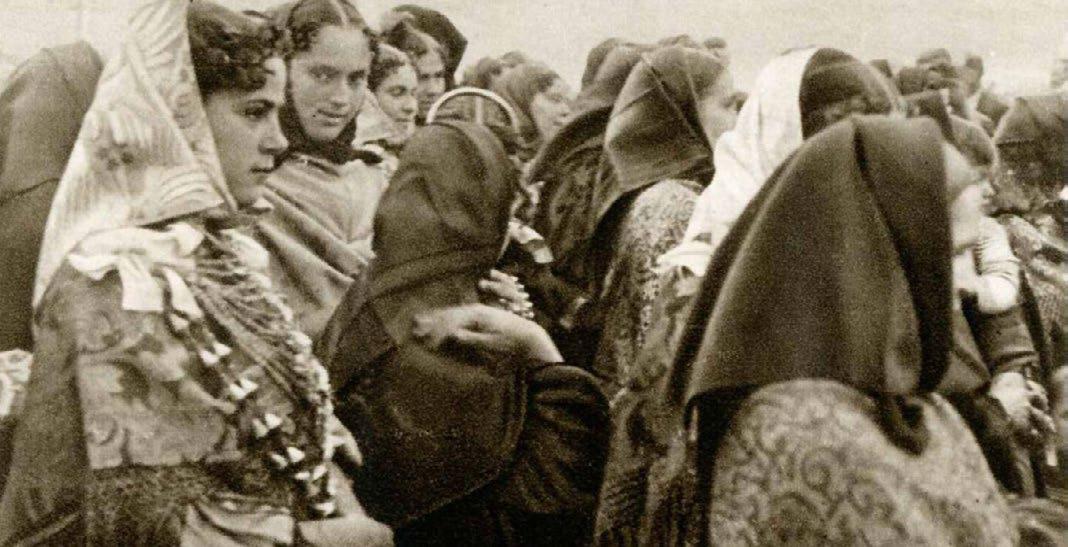
Así y todo, el cortejo no era sino una cuestión también de supervivencia especialmente para las mujeres. “En esa época, si una mujer soltera se iba con más de uno sin que la acompañaran, ya se decía que era una puta”, lamenta Eulària. Ese cortejo, con sus normas masculinas, sus vigilantes silenciosas, y sus turnos de palabra, eran una oportunidad para mantener una reputación de decencia y honor según la norma social, y en cierta manera, permitía una amplia capacidad de elección.
“Yo siempre fui libre de elegir”, asevera Eulària, ante la duda. Xumeu y Colomaret también aseguran que siempre respetaron a las mujeres con las que estuvieron o acabaron casándose, porque sabían que un paso en falso —un acercamiento físico en público antes del matrimonio—, podía ser una cruz, especialmente para ellas.
Xumeu logró dar un paso para casarse con Maria, tras cuatro años de noviazgo. Los padres de Maria, payeses, le advirtieron con humildad de que no tuvieran prisa en casarse, porque ellos eran pobres y tenían poco que dar. Eulària, tras siete años de noviazgo, se casó con su marido
Toni, con quien pactó que vivirían solos los dos y así lo hicieron durante una larga época. Cuando él cayó enfermo, ella cogió las riendas del negocio conjunto que tenían en el pueblo, Es Mirador, como cocinera célebre. El músico, Colomar, a pesar de la mala fama de los artistas en una España aún dictatorial, consiguió también convencer de su amor a la familia de su esposa, donde eran “muy beatos”. Con ella este año ha cumplido el 64 aniversario de bodas. Con nostalgia, Xumeu, Eulària y en Colomaret, celebran sus decisiones.
Even so, courtship was also a matter of survival, especially for the women. “In those days, if a single woman walked off with more than one man unaccompanied, she was said to be a whore”, Eulària says with regret. That courtship, with its maledominated rules, its silent overseers, and its conversation rotations, was an opportunity to uphold a reputation of decency and honour according to the social norms, and in a sense, it allowed for a wide degree of choice.
“I was always free to choose”, asserts Eulària, in response to the doubt. Xumeu and Colomaret also say that they always respected the women they were with or ended up marrying, because they knew that the smallest misstep --a physical encounter in public before marriage-- could lead to doom, especially for the women.
After four years of courtship, Xumeu managed to marry Maria. Maria’s parents, peasant farmers, humbly warned her not to rush into marriage, as they were poor and had little to give. For her part, after seven years of courtship, Eulària married her husband Toni, making an agreement with him that they would live alone, which they did for a long period of time. When he fell ill, she took over the reins of their shared business in the village, Es Mirador, as a famous cook. Despite the bad reputation of artists in a Spain that was still ruled by a dictator, the musician Colomar also managed to convince his wife’s “very pious” family of his love. This year, they celebrated their 64th wedding anniversary. Xumeu, Eulària and Colomaret nostalgically celebrate their decisions.
 Toni Colomar, Eulària Torres y Pep Xumeu posan en la iglesia de Sant Carles. Foto: Arsen Voronyy
Toni Colomar, Eulària Torres y Pep Xumeu posan en la iglesia de Sant Carles. Foto: Arsen Voronyy
‘JO TENC UNA ENAMORADA’:
T F
Xescu Prats Vicent Marí / Alejandro Iborra Ventura Archivo Joan-Albert RibasA cualquier pitiuso con sangre en las venas le resulta imposible evitar que se le empañe la mirada de emoción si de pronto suena Jo tenc una enamorada. En la cultura popular isleña probablemente no exista otro himno más emotivo y que inspire mayor conexión con la tierra. Rescatada de las entrañas de la payesía, popularizada por el grupo UC en los años 70, y reinventada por Ressonadors en el siglo XXI, constituye un auténtico icono musical del amor, pasado por el tamiz ibicenco.
Nadie sabe a ciencia cierta quién creó la letra de Jo tenc una enamorada. Tampoco si tiene 100, 200 ó 300 años. Sus estrofas, en todo caso, remiten a los tiempos en que los lugareños aún portaban un arma en el cinto y están sujetas a múltiples interpretaciones, que oscilan entre el romanticismo que impregna algunos versos y la retranca que desprenden otros.
Jo tenc una enamorada fue grabada por primera vez por UC, grupo de folk pionero en la historia de la música ibicenca, que crearon Joan Marí Murenu, Isidor Marí y Victorí Planells. En 1974 la incluyeron en su primer álbum, Cançons d’Eivissa, que reunía un total de catorce temas rescatados del olvido.
For any Ibizans with blood in their veins, it’s impossible to stop their eyes from filling with emotion when they suddenly hear ‘Jo tenc una enamorada’ (I have a love). In the island’s popular culture, there’s probably no other anthem as emotional and inspiring nor with a deeper connection to the region. Rescued from the depths of rural life, popularised by the group UC in the 1970s, and reinvented by Ressonadors in the 21st century, it stands as a true musical icon of love, filtered through the Ibiza sieve.
No one knows for certain who penned the lyrics of ‘Jo tenc una enamorada,’ nor its age—whether it’s 100, 200 or 300 years old. Its verses, in any case, harken back to a time when locals still carried a weapon on their belt, and they are subject to multiple interpretations, ranging from the romanticism that pervades some verses to the humour that others exude.
‘Jo tenc una enamorada’ was first recorded by UC, a pioneering folk group in the history of Ibiza’s music, formed by Joan Marí Murenu, Isidor Marí and Victorí Planells. In 1974, they included it in their debut album, Cançons d’Eivissa, which compiled a total of fourteen songs rescued from oblivion.
 Obra de Eugenie Loutchinsky: La del Rosario. Colección Joan-Albert Ribas.
Obra de Eugenie Loutchinsky: La del Rosario. Colección Joan-Albert Ribas.
“En aquella época salíamos a los pueblos y al campo en busca de canciones. Nos llevábamos una grabadora y hablábamos con los payeses. El folklorista Toni Planes, de Sant Miquel, nos pasó algunas letras y otras las hallamos en la ‘Historia de Ibiza’, de Isidor Macabich. También encontré varias en Sant Vicent de sa Cala. Los jueves, mientras el médico pasaba consulta en el bar próximo a la iglesia, me acercaba a los vecinos que esperaban turno y les preguntaba por canciones antiguas que recordaran”, explica Murenu.
‘JO TENC UNA ENAMORADA’ FUE
UC, GRUPO DE FOLK PIONERO EN LA HISTORIA DE LA MÚSICA IBICENCA, QUE CREARON JOAN MARÍ MURENU, ISIDOR MARÍ Y VICTORÍ PLANELLS
Las estrofas de Jo tenc una enamorada, sin embargo, las hallaron en casa del poeta Marià Villangómez (Ibiza, 19132002), según relata Isidor Marí: “Me acuerdo como si fuera ayer. Él ya nos había ayudado con otras canciones y un día que fuimos a visitarlo nos pasó esta letra. Él había ejercido como maestro en Sant Miquel y en una casa salinera de Sant Francesc, y probablemente la descubrió durante alguno de estos periodos. Enseguida nos gustó por la ironía que transmitía. El propio Villangómez nos sugirió que modificáramos ligeramente la letra original. Había un verso que decía “quan es pins faran mançanes” (cuando los pinos darán manzanas) y, al ser un barbarismo léxico, nos sugirió cambiar “mançanes” por “magranes” (granadas), conservando la rima. Por supuesto, le hicimos caso”.
UC grabó la canción a tres voces, añadiéndole una tonada ligera y clásica, muy habitual en la canción glosada de la isla, y aportándole su propia armonía. El grupo la cantaba del tirón, sin apenas pausas, con un sonsonete repetitivo y primitivo, a base de cuerdas, que se complementaba con una melodía de flauta. Recordaba la manera de cantar de los viejos payeses mucho más que otras composiciones del álbum, más ricas en armonías contemporáneas. Jo tenc una enamorada fue uno de los temas vertebrales del disco, pero ni mucho menos se convirtió en el más popular de UC en aquellos primeros años.
‘In those days, we’d venture into villages and the countryside to unearth songs. Armed with a recorder, we’d converse with the locals. Folklorist Toni Planes, from Sant Miquel, shared some lyrics, while others we discovered in ‘Historia de Ibiza’ by Isidor Macabich. I also stumbled upon several in Sant Vicent de sa Cala. On Thursdays, as the doctor attended to patients in the bar near the church, I’d approach neighbours waiting their turn and ask about old songs they recalled,’ Murenu explains.
However, the verses of ‘Jo tenc una enamorada’ were found at the home of poet Marià Villangómez (Ibiza, 1913-2002), as Isidor Marí recounts: ‘I remember it vividly. He had previously helped us with other songs, and during one of our visits, he shared these lyrics. Having worked as a teacher in Sant Miquel and in a salt house in Sant Francesc, he likely discovered it during one of these periods. We were immediately drawn to its ironic tone. Villangómez himself suggested a slight modification to the original lyrics. One verse read ‘quan es pins faran mançanes’ (when the pine trees will bear apples), and as it was a lexical error, he recommended changing ‘mançanes’ to ‘magranes’ (pomegranates), maintaining the rhyme. Naturally, we took his advice.’
UC recorded the song with three voices, adding a light, classic tune, common in the island’s traditional songs, and their own harmonies. The group performed it in one continuous flow, with minimal pauses, featuring a repetitive and primitive drone of strings, complemented by a flute melody. It evoked the singing style of old peasants more than other songs on the album, which were richer in contemporary harmonies. ‘Jo tenc una enamorada’ became a cornerstone track on the album, though it didn’t become UC’s most popular song in those early years.
UC RECORDED THE SONG WITH THREE VOICES, ADDING A LIGHT, CLASSIC TUNE, COMMON IN THE ISLAND’S TRADITIONAL SONGS,
AND THEIR OWN HARMONIES
For instance, ‘Anarem a Sant Miquel’ enjoyed outstanding success due to its festive rhythm and lyrics infused with spice and double entendres, which even drew criticism from the clergy. ‘We once sang it in a church, I recall it was in Sant

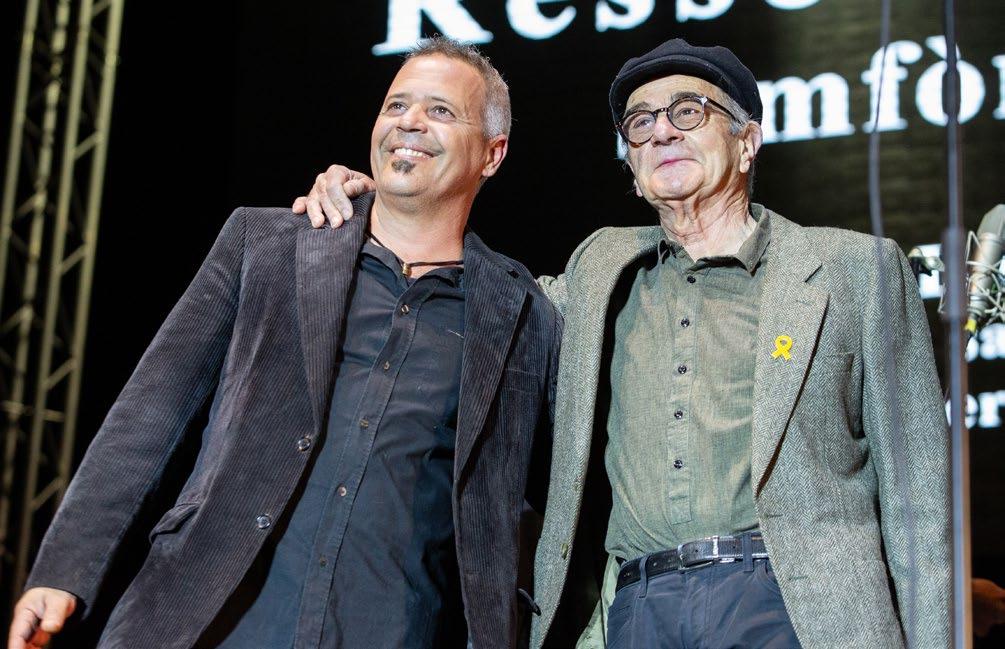 UC, en una actuación en Ibiza en 1991.
David Serra, cantante de Ressonadors, con Joan Marí ‘Murenu’, de UC.
Foto: Alejandro Iborra
UC, en una actuación en Ibiza en 1991.
David Serra, cantante de Ressonadors, con Joan Marí ‘Murenu’, de UC.
Foto: Alejandro Iborra
Anarem a Sant Miquel, por ejemplo, adquirió un éxito sobresaliente, por su ritmo festivo y una letra aderezada de picante y dobles sentidos, que incluso fue repudiada por el clero. “La cantamos en una iglesia, creo recordar que la de Sant Antoni, y el obispo se enfadó tanto que hasta apartaba la mirada cuando nos cruzábamos por la calle. En otra ocasión, el párroco nos pidió que no la interpretáramos. Luego fuimos a actuar a Mallorca y, para evitar polémicas, le anunciamos al cura que estuviera tranquilo, que no la cantaríamos. Él, sin embargo, nos autorizó a interpretarla, pues, según dijo, Dios la escucha igual en una plaza que en una iglesia”, explica Murenu.
Pocos años después del disco, en los ochenta, un jovencísimo Omar Gisbert aprendía sus primeros acordes en la escuela de la Asociación Pro Música, en el número 17 de la Avenida de España de la capital. Dicha institución impartía clases gratuitas a los niños y ocupaba un local de la primera planta, cedido por la Alianza Francesa, al que se accedía por un portal que albergaba un famoso puesto de palomitas. Entonces Omar aún no era consciente, pero hoy reconoce que, sin las enseñanzas recibidas, Jo tenc una enamorada no se habría convertido en el fenómeno que representa hoy en día.
“Teníamos de profesor a Gilberto Tur Riera, que nos enseñaba Yellow submarine y otros temas de los Beatles, y el cancionero popular ibicenco, con Bona nit, blanca roseta y otras. Hacía una labor extraordinaria al transmitírnoslas y las teníamos completamente interiorizadas”, añade Gisbert.
Muchos años después, Omar se convirtió en un prestigioso músico y productor de rock, y le propuso a su compañero Joan Barbé, figura ya emergente en la isla, crear un proyecto para revitalizar el cancionero tradicional que había aprendido del maestro Gilberto. Tras meditarlo unos años, por fin lo pusieron en marcha. Lo llamaron Ressonadors y acabó convirtiéndose en el fenómeno musical más extraordinario de Ibiza a lo largo del siglo XXI. “Las canciones populares de la isla tienen una calidad excepcional, pero sin las enseñanzas de Gilberto Tur probablemente nunca habríamos desarrollado esta idea”, apunta Gisbert.
Antoni, and the bishop was so displeased that he averted his gaze when we crossed paths on the street. Another time, the parish priest requested we refrain from performing it. When we later performed in Mallorca, to avoid controversy, we reassured the priest that we wouldn’t sing it. However, he permitted us to, saying, “God hears it just the same in a square as in a church”,’ Murenu explains.

A few years after the album, in the 1980s, a young Omar Gisbert was learning his first chords at the Pro Música Association school, located at number 17 Avenida de España in the capital. This institution offered free classes to children and occupied a first-floor premises, provided by the French Alliance, accessed through a doorway that housed a famous popcorn stand. At that time, Omar was not yet aware, but he now recognises that without the teachings he received, ‘Jo tenc una enamorada’ would not have become the phenomenon it is today.
‘Our teacher was Gilberto Tur Riera, who taught us ‘Yellow Submarine’ and other Beatles songs, as well as the popular Ibiza songbook, including ‘Bona nit, blanca roseta’, among others. He did an extraordinary job in transmitting them to us, and we completely internalised them,’ adds Gisbert.
Many years later, Omar became a renowned rock musician and producer. He proposed to his colleague Joan Barbé, who was already an emerging figure on the island, to create a project to revitalise the traditional songbook he had learned from his teacher Gilberto. After pondering it for a few years, they finally set it in motion. They called it Ressonadors, and it ended up becoming the most extraordinary musical phenomenon in Ibiza throughout the 21st century. ‘The popular songs of the island have exceptional quality, but without Gilberto Tur’s teachings, we probably would never have come up this idea,’ says Gisbert.
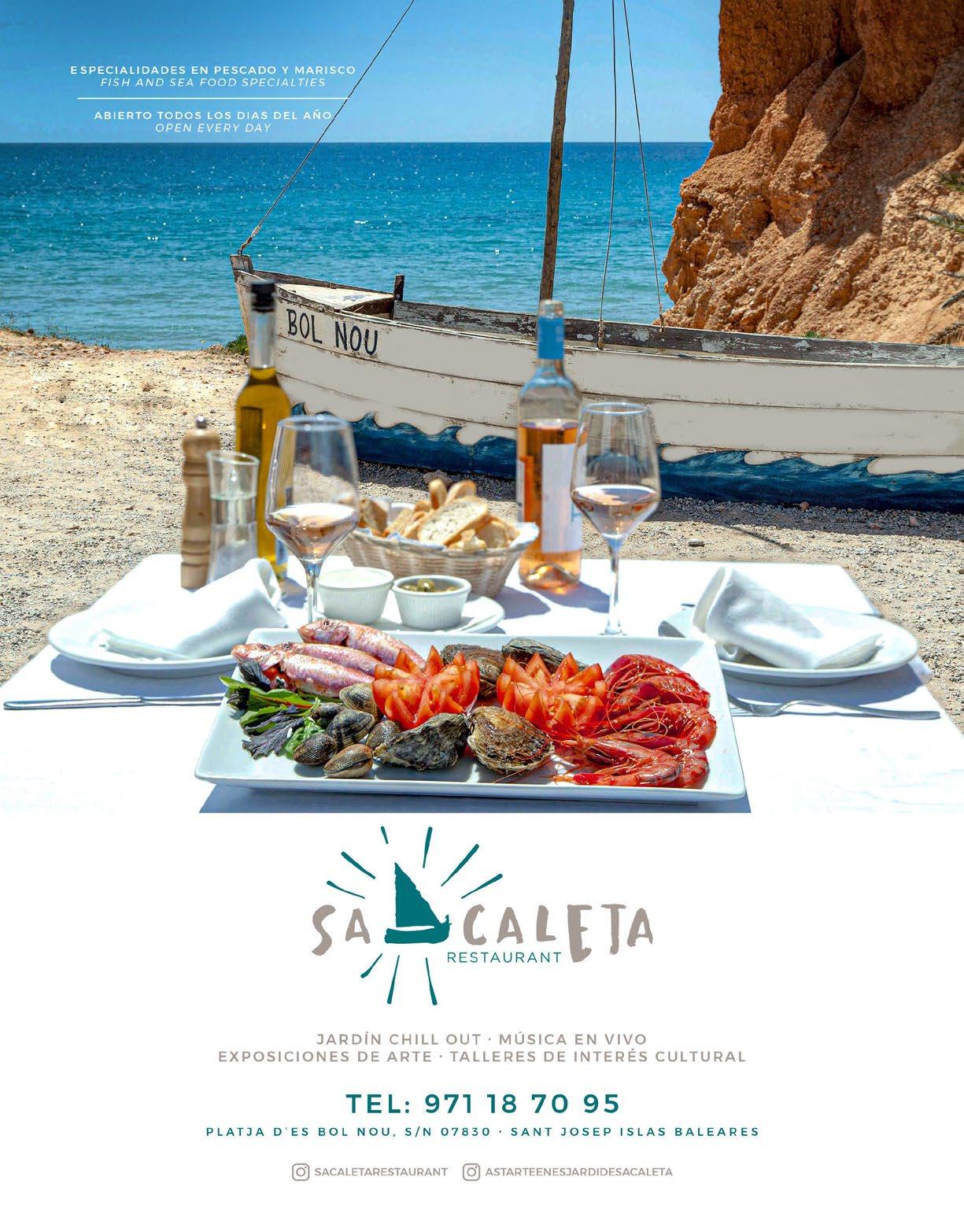
“Estábamos en la fase de buscar cantantes que interpretaran los temas del primer álbum de Ressonadors y había que ir a picar puertas. Decidimos grabar unos singles para que la gente entendiera lo que queríamos hacer. Escogimos Anarem a Sant Miquel, Bona nit, Blanca Roseta y Jo tenc una enamorada. Joan Barbé hizo los arreglos, ya pensando que esta última la cantaría David Serra, que era compañero nuestro en el grupo de rock Statuas D Sal, y la clavó”, apostilla Omar. Fue, sin duda, una elección acertada, pues el vocalista, al interpretarla, le confiere un tono épico que, si la escucha alguien ajeno al idioma, fácilmente puede deducir que se trata de una epopeya.
Ressonadors lanzó aquel primer álbum durante las fiestas navideñas de 2008 y lo interpretó en vivo en el Parque Reina Sofía de la ciudad, ante 3.000 personas, el 11 de abril de 2009. Tras aquel llegarían más discos y conciertos, hasta con banda sinfónica, y Jo tenc una enamorada acabaría erigiéndose en la gran canción ibicenca, emblema de toda una generación que sigue vibrando al oírla.
JO TENC UNA ENAMORADAJo tenc una enamorada
A sa banda de Migjorn
I en ser que la vaig a veure
Sempre em diu que quan hi torn
Jo li dic que serà prompte
Si no mo’ n’anam del món
Quan es pins faran magranes
‘We were in the phase of finding singers to perform the songs from Ressonadors’ first album, and we had to knock on doors. We decided to record some singles so that people could understand what we wanted to do. We chose ‘Anarem a Sant Miquel’, ‘Bona nit, Blanca Roseta’ and ‘Jo tenc una enamorada’. Joan Barbé did the arrangements, already thinking that David Serra, who was our colleague in the rock group Statuas D Sal, would sing the latter, and he nailed it,’ Omar adds. It was undoubtedly a wise choice, as the vocalist, when interpreting it, gives it an epic tone that, if heard by someone unfamiliar with the language, could easily be mistaken for an epic.
I ses figueres, melons
La mar estarà eixuta
I hi correran carretons
Per dins es terços de botges
Hi pescaran es caçons
Jo tenc una enamorada
A sa banda de Migjorn
I en ser que la vaig a veure
Sempre em diu que quan hi torn
Joan Barbé explica que arreglarla representó todo un reto, ya que era la menos comercial, desde un punto de vista musical, de todas las canciones de UC que barajaban para el disco. “Al final lo que hice fue aislar la melodía y rehacerla con acordes de folk rock. También cambié la métrica para añadirle pausas y que al público le resultara más fácil corearla. La letra tiene la ventaja de que es muy potente y posee varias lecturas. Si la escuchas con mentalidad ibicenca, deduces que es una canción burlesca. Viene a decir: tú y yo no nos juntaremos nunca. Pero luego existe otra interpretación: dos enamorados que no van a poder estar juntos. Él miente, pero no para burlarse, sino con la nostalgia de un amor imposible. Es lo más bonito del mundo”, detalla Barbé.
I llavors jo tornaré
I em casaré amb tu, si vols
Ja et pots començar a fer roba
Que hi hem de sortir bufons
Que a sa cinta portaré
Una arma de dos canons
I cada tron que faré
Serà de dos trons bessons
Jo tenc una enamorada
A sa banda de Migjorn
I en ser que la vaig a veure
Sempre em diu que quan hi torn
Ressonadors released that first album during the Christmas holidays of 2008 and performed it live in the Parque Reina Sofía in the city, in front of 3,000 people, on 11 April 2009. After that, more albums and concerts would follow, even with a symphonic band, and ‘Jo tenc una enamorada’ would end up becoming the great Ibiza song, the emblem of an entire generation that continues to rouse when hearing it.
Joan Barbé explains that arranging it was quite a challenge, as it was the least commercial, from a musical point of view, of all the UC songs they were considering for the album. ‘In the end, what I did was isolate the melody and remake it with folk rock chords. I also changed the meter to add pauses and make it easier for the audience to sing along. The lyrics have the advantage of being very powerful and having several interpretations. If you listen to it with an Ibiza mentality, you deduce that it is a mocking song. It basically says: you and I will never get together. But then there’s another interpretation: two lovers who won’t be able to be together. He lies, but not to mock, but with the nostalgia of an impossible love. It’s the most beautiful thing in the world,’ Barbé explains.

David Serra también desgrana sus ramificaciones: “Es una composición muy ibicenca, con esa picaresca que dice que me casaré cuando los pinos den granadas. En la primera parte pasa de ella, no se quiere casar, pero luego accede y hasta planea una boda que va a ser sonada, en la que portará un arma de dos cañones en el cinto”.
En términos similares se expresa Isidor Marí, que añade que “la letra es una broma, una ironía del amor”. Poco después de que UC la popularizara, le preguntaron en una entrevista a un famoso folklorista de la Mola, Pep Simón, si él era su autor, cosa que se apresuró a negar. Probablemente el periodista, al igual que otros muchos pitiusos, dedujo que su origen radicaba en Formentera, al situar a la enamorada en el lado de Migjorn. Así se denomina a un extenso tramo de costa de esta isla, pero también a la ribera de la playa de ses Salines hacia es Freus, que Marí considera que es a la que alude la primera estrofa.
David Serra also explains its ramifications: ‘It’s a very Ibiza composition, with that roguishness that says I will marry when the pine trees bear pomegranates. In the first part, he dismisses her, he doesn’t want to get married, but then he agrees and even plans a wedding that will be memorable, where he will carry a double-barrelled gun on his belt.’
I have a lover Way down in the south
And each time that I go to see her She asks me when I will be back
I tell her it will be soon If the world doesn’t take me away: When the pine trees bear pomegranates And the fig trees, melons
When the sea has dried up completely And carts travel through its roads And snapper sharks Hunt inside silkworms’ cocoons
I have a lover Way down in the south
And each time that I go to see her She asks me when I will be back
David Serra y Joan Barbé acabaron incluyéndola también en Poèsica, primer álbum de su grupo de folk ibicenco Projecte Mut, que se publicó en 2010 y constituyó otro gran éxito. Desde entonces, la han cantado docenas de veces, tanto con Ressonadors como con Projecte Mut. David Serra aún se acuerda con emoción de cuando la interpretaron ante más de 80.000 personas, en el estadio Camp Nou de Barcelona, con motivo del denominado Concert de la Llibertat (29 de junio de 2013), en el que actuaron los mejores músicos y bandas de la lengua catalana. “Es lo más grande que hemos hecho. Nos presentó Gerard Quintana, el líder de Sopa de Cabra, y Joan y yo salimos con nuestras guitarras. Aunque es una canción ibicenca, el público se la sabía y la coreaba”. Unos años antes, la habían interpretado también en Nueva York, en una galería del Soho, junto al propio Joan Murenu y el violinista Frank J. Cogollos, por encargo del Institut Ramon Llull.
Then, I shall return
And marry you if you wish You can start sewing our clothes So that we look great at our wedding
For on my belt I shall carry A double-barrelled gun And every shot I fire Will make twice the noise
I have a lover Way down in the south
And each time that I go to see her She asks me when I will be back
Isidor Marí expresses a similar sentiment, adding that ‘the lyrics are a joke, an irony of love.’ Shortly after UC popularised it, a famous folklorist from La Mola, Pep Simón, was asked in an interview if he was the author, which he hastened to deny. Probably the journalist, like many other islanders, deduced that its origin lay in Formentera, by placing the lover on the southern side. This is the name of an extensive stretch of coast on this island, but also the shore of the beach of Ses Salines towards Es Freus, which Marí considers is referred to in the first stanza.
David Serra and Joan Barbé ended up including it in Poèsica, the first album of their Ibiza folk group Projecte Mut, which was published in 2010 and was another great success. Since then, they have sung it dozens of times, both with Ressonadors and with Projecte Mut. David Serra still remembers with emotion when they performed it in front of more than 80,000 people at the Camp Nou stadium in Barcelona, during the Concert de la Llibertat (29 June 2013), where the best musicians and bands in the Catalan language performed. ‘It’s the greatest thing we’ve ever done. Gerard Quintana, the leader of Sopa de Cabra, introduced us, and Joan and I came out with our guitars. Even though it’s an Ibiza song, the audience knew it and sang along.’ A few years earlier, they had also performed it in New York, in a gallery in Soho, with Joan Murenu and the violinist Frank J. Cogollos, commissioned by the Institut Ramon Llull.


“Hay canciones que, cuando ya las has cantado tantas veces, acabas un poco harto de ellas, pero a Jo tenc una enamorada siempre la defiendo con uñas y dientes. Me ha proporcionado muchas alegrías”, añade Serra.
“El gancho de la canción es la letra, que habla del amor y con la que todos nos podemos sentir identificados, y la melodía, que también es buenísima. Si la hubiesen publicado los Beatles en inglés lo habrían reventado”, zanja Gisbert.
“Para mí, Jo tenc una enamorada es como un torrente que me aferra a mi tierra, la canción que ha llenado de orgullo a mi abuela y que me ha abierto las puertas de la gente ibicenca. Una de las cosas más importantes que he hecho en mi carrera”, apostilla Barbé.
‘There are songs that, when you’ve sung them so many times, you get a bit tired of them, but I always defend ‘Jo tenc una enamorada’ tooth and nail. It has brought me many joys,’ adds Serra.
‘The hook of the song is the lyrics, which talk about love and with which we can all identify, and the melody, which is also great. If the Beatles had released it in English, it would have been a hit,’ concludes Gisbert.
‘For me, ‘Jo tenc una enamorada’ is like a torrent that holds me to my land, the song that has filled my grandmother with pride and has opened the doors to the people of Ibiza for me. One of the most important things I have done in my career,’ Barbé adds.

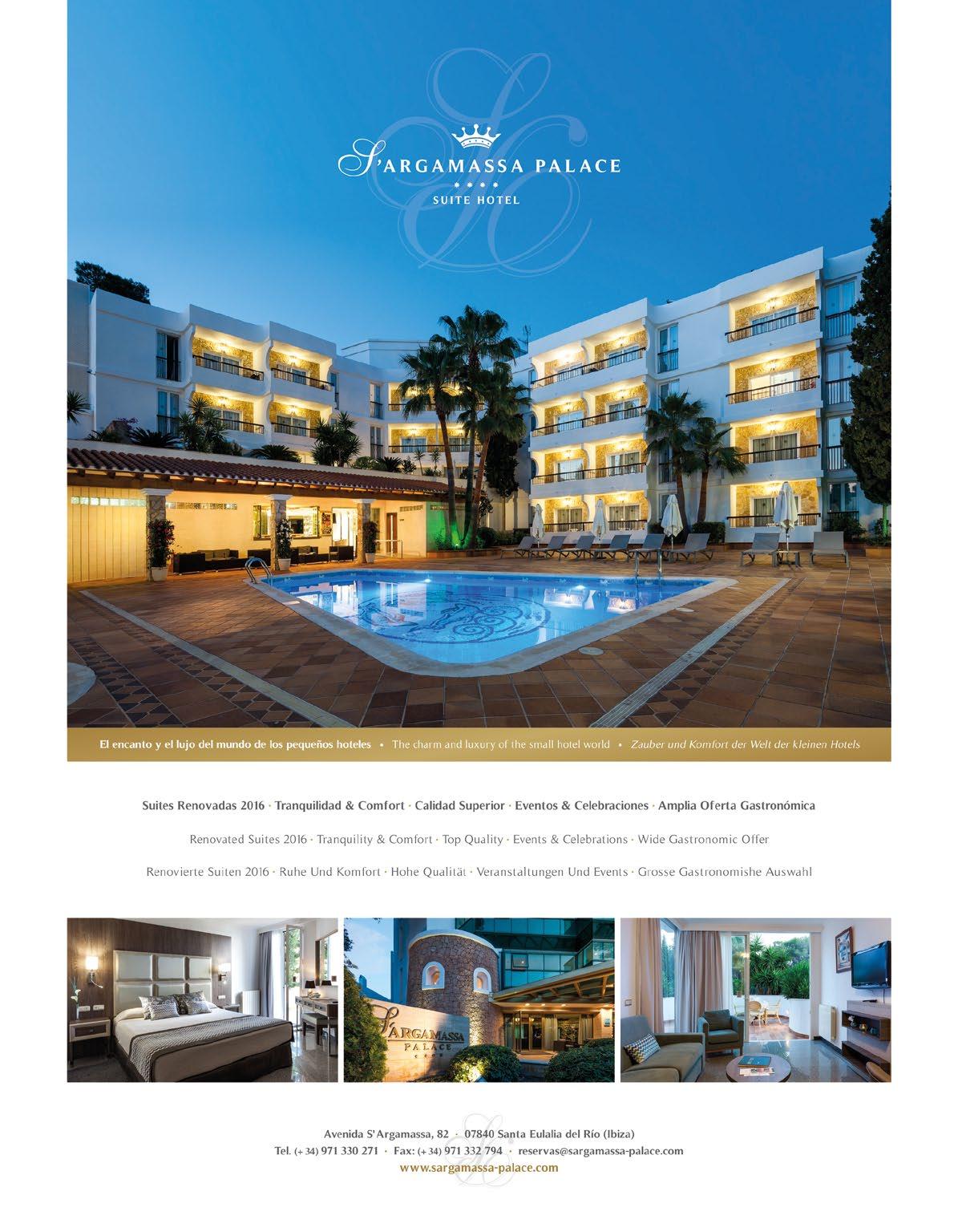

Levitando sobre el Mediterráneo y rodeada de playas de cristalinas aguas, Formentera es el lugar perfecto para seguir avivando la llama del amor y perderse junto al ser querido, dedicándole todo el tiempo deseado, pero que la vida cotidiana nos resta a diario.
Hovering over the Mediterranean Sea, amid beaches with crystal-clear waters, Formentera is the ideal place to continue to fan the flames of love and immerse yourself in the company of your loved one, giving them all the time you want. Time that is so often limited by everyday life.
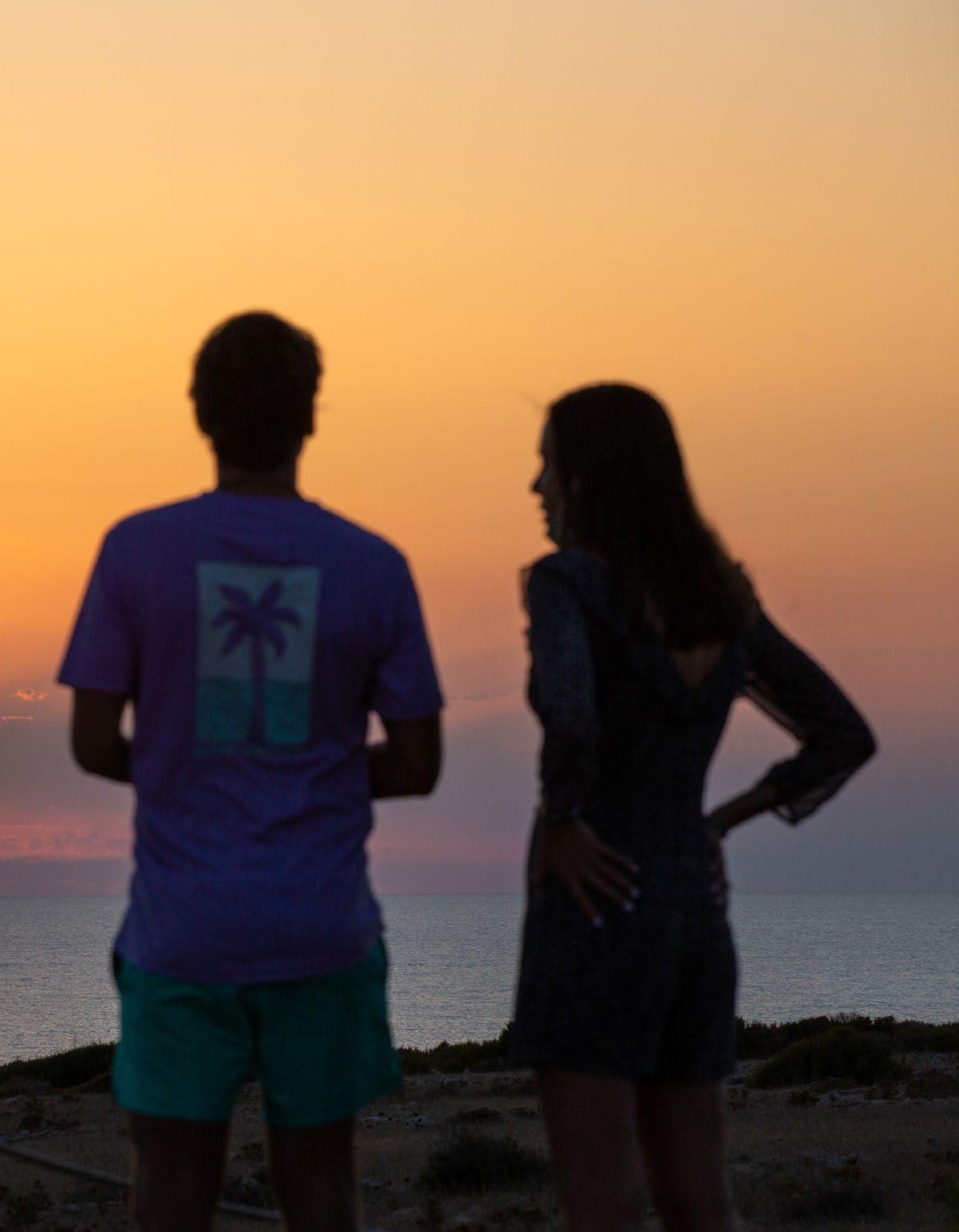
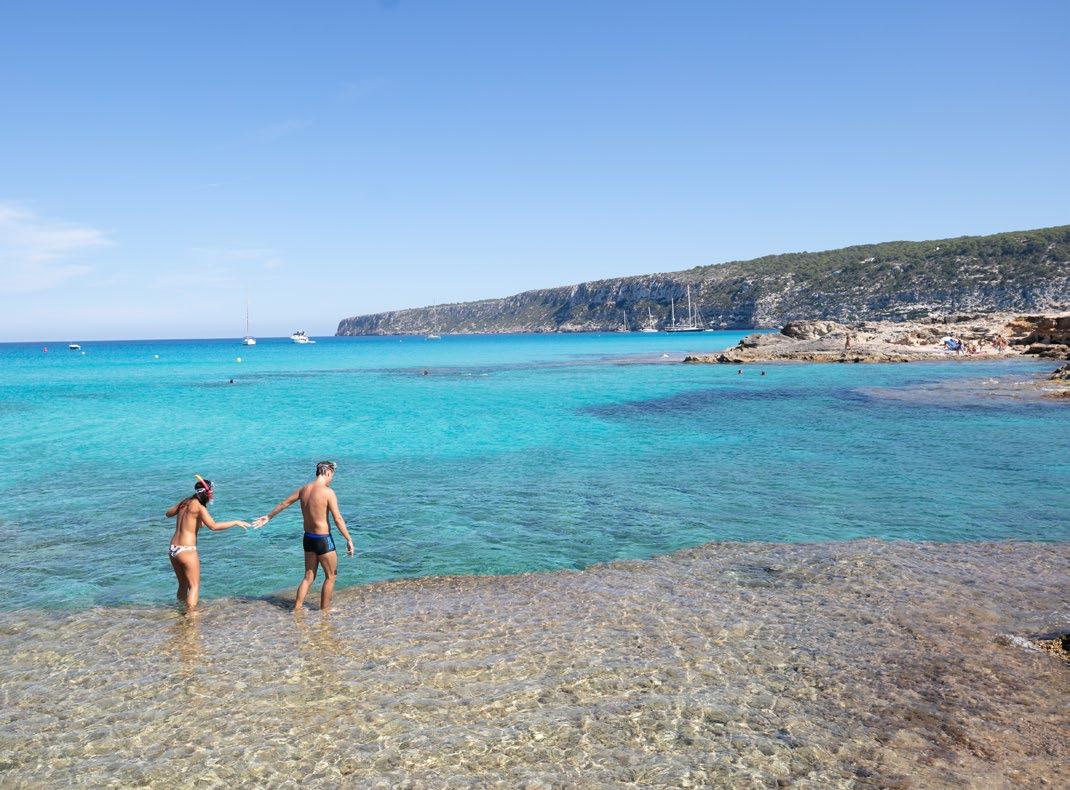
Es coger la bici y brujulear por un laberinto de Rutas Verdes de salvaje belleza. Es compartir con tranquilidad una deliciosa comida o cena con productos de proximidad. Es sentarse juntos para ver cómo el sol se pierde lentamente en el horizonte, dejando el cielo teñido de su mágica estela rojiza en las románticas puestas de sol de Cala Saona o Cap de Barbaria. Es mirarse a los ojos y susurrarle un “te quiero” a la pareja.
No hay relojes. Los horarios dejan de tener sentido en una isla donde se vive a otro ritmo. Desde una copa de vino en la plaza de Sant Francesc, viendo pasar a la gente sin nada más que decir, hasta una romántica cena donde prime siempre el producto de la tierra, su pescado, su huerta, sus postres... Todo en Formentera irradia amor.
It means grabbing your bike and wandering through a labyrinth of untamed beauty, along the Rutas Verdes (Green Routes). It means leisurely sharing a delicious lunch or dinner prepared with fresh, local products. It means sitting together and watching the sun as it slowly sinks into the horizon, leaving the sky bathed in the magical glow of reddish hues, at those romantic sunsets at Cala Saona and Cap de Barbaria. It means looking into their eyes and whispering “I love you”.
Clocks don’t exist. Schedules no longer make sense on an island where life moves at a different pace. From a glass of wine in Sant Francesc square, simply watching the people go by, to a romantic dinner where the products of the land, its fish, its gardens of locally grown vegetables, its desserts... always take centre stage. Everything in Formentera exudes love.
The island is full of picturesque little spots: a vantage point on the way to La Mola that anyone who visits will always return to; beaches with that entrancing ‘Formentera blue’, a real feast for the eyes that dazzles locals and visitors alike; visits to its
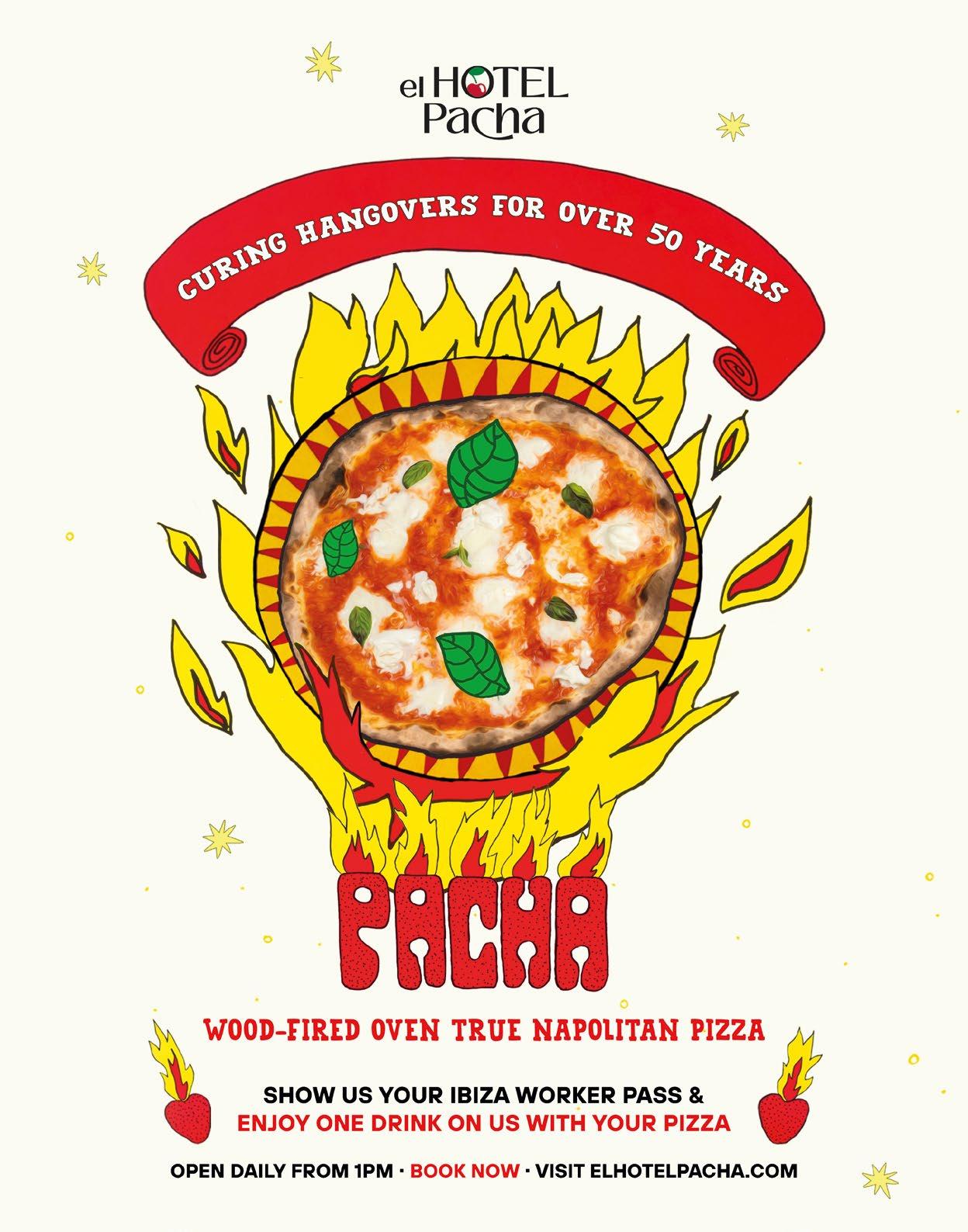
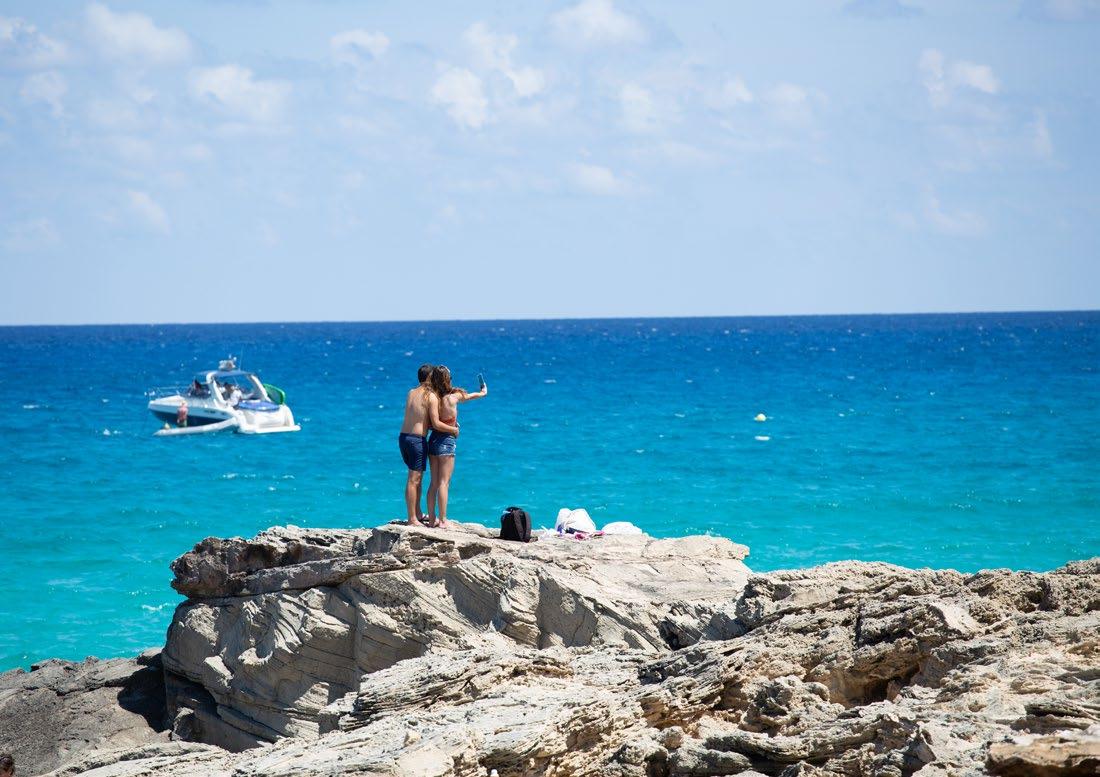
EN FORMENTERA, LAS PAREJAS SE ABANDONAN A LA PASIÓN Y AL ENCANTO DE PERDERSE EN LA ISLA
Y es que la isla está llena de rincones de postal: Un mirador de camino a La Mola, que aquel que lo visita repite siempre; playas con ese fascinante ‘azul Formentera’, un verdadero regalo para la vista que encandila a propios y extraños; visitas a sus pueblos, recorriendo sus calles en calma, dejándose envolver por el ambiente y el ritmo de vida sosegado de sus gentes.
Es ese poder, ese magnetismo de una isla que atrapa al viajero desde el momento en que posa sus pies en el puerto de La Savina. Es ahí cuando arranca todo un carrusel de emociones y la isla despliega su encanto para que esas parejas se abandonen por completo a la pasión y al encanto de perderse en una isla inimitable...
quaint villages, strolling through the streets in peace, allowing yourselves to be enveloped by the atmosphere and the relaxed pace of life of the islanders.
It’s that power, that magnetism of an island that captivates the traveller from the moment they set foot in the port of La Savina. And it is right there and then that a whole procession of emotions unfolds and the island unveils its allure for those couples who surrender themselves completely to the passion and delight of wandering off on an incomparable island...
IT’S THAT POWER, THAT MAGNETISM OF AN ISLAND THAT CAPTIVATES THE TRAVELLER FROM THE MOMENT THEY SET FOOT IN THE PORT OF LA SAVINA
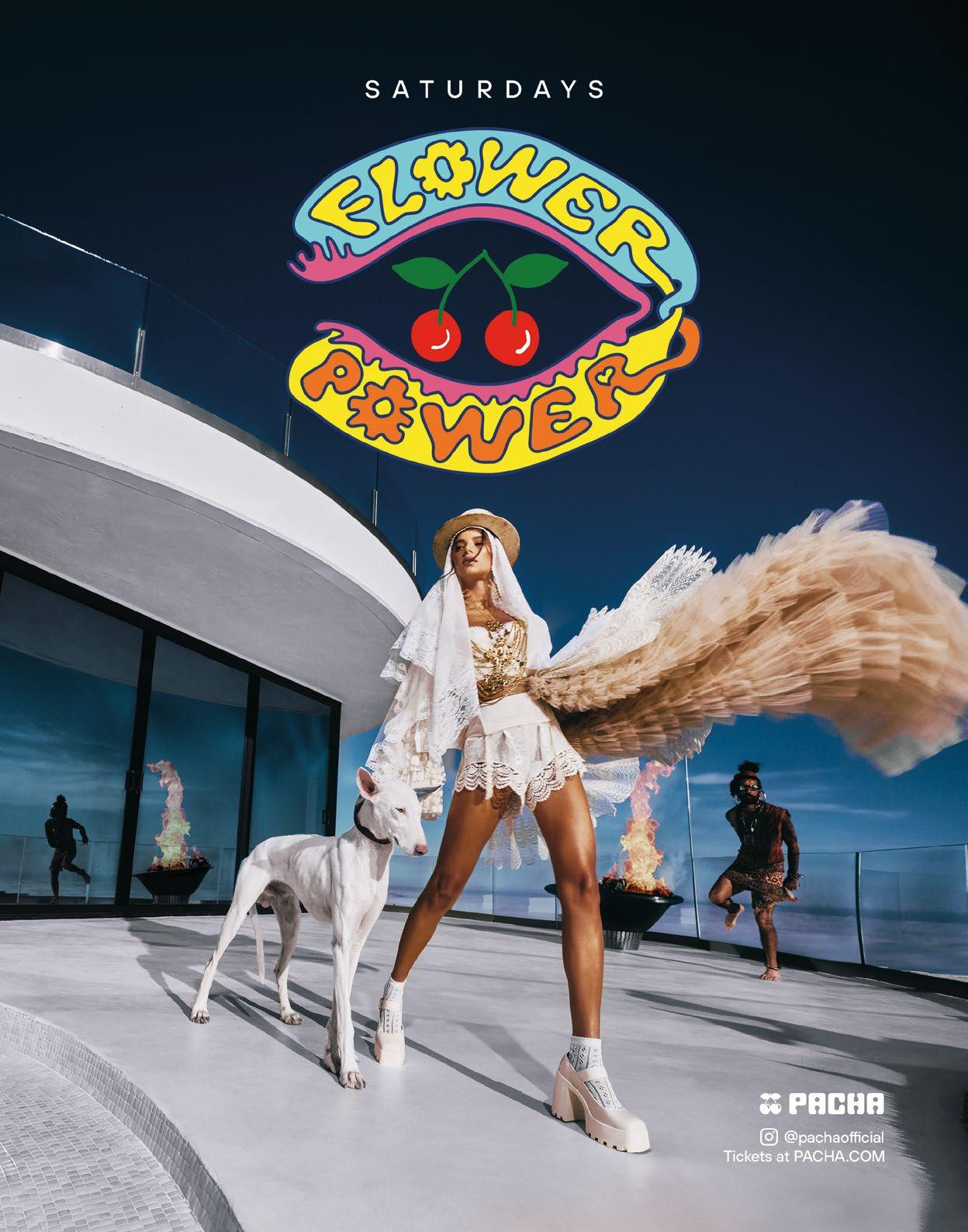
OUR GRANDMOTHERS’ RECIPES OF LOVE
Antonio Martínez Beneyto Vicent Marí T FEste escrito huele a puchero, a arroz con pollo, a coca de acelgas, a anís, a azúcar y a albaricoques. Huele a amor, a cariño, a familia. A recetas transmitidas de madres a hijas; de nietos y nietas que refuerzan su unión con los mayores a través de la comida, del patrimonio gastronómico familiar elaborado a base de sentimientos, achuchones y besos.
Esos platos, alejados de las elaboraciones de la alta cocina y asentados en los productos de la tierra, son de ese kilómetro cero que es real, con ese producto de proximidad que las abuelas aprendieron a respetar y a cocinar desde niñas.
This article is redolent of stew, chicken rice, Swiss chard tart, aniseed, sugar and apricots. It’s redolent of love, affection and family. It’s redolent of recipes handed down from mothers to daughters, of grandsons and granddaughters whose bonds with their elders are reinforced through food, of families’ gastronomic heritage that’s concocted out of feelings, hugs and kisses.
Far removed from the food produced by haute cuisine, these dishes use regional produce and are truly local, made up of ingredients that our grandmothers first learned to respect and prepare when they were little girls.

“En casa éramos muchos y había que ayudar, empecé a cocinar a los diez años”. “Siendo una niña acompañaba a mi madre, a mis hermanas mayores o al pastor desde Sant Josep hasta una païssa que teníamos en Cala Carbó donde llevábamos a los animales. El tiempo se me hacía eterno”. “He cocinado profesionalmente muchos años de mi vida pero me hubiera encantado haber podido ir a clases con algún cocinero”.
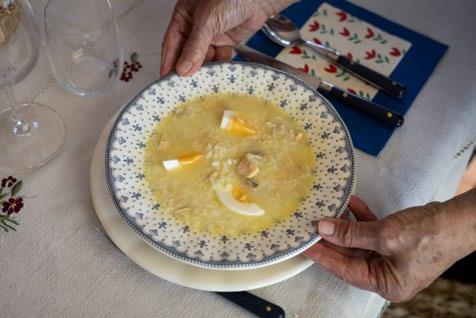
Estas son algunas de las reflexiones de las cinco protagonistas de este texto. Mujeres que son madres y abuelas. Que nacieron y vivieron en una isla que poco tiene que ver con la actual y a las que les tocó sufrir épocas de escasez. Luchadoras que colaboraron con el funcionamiento de sus casas cuando sólo eran unas niñas y que trabajaron para sacar adelante sus propias familias. Ahora, en la actualidad, abuelas que “aliñan” con recuerdos, anécdotas y mucho amor a esos nietos y nietas que ven en ellas el lugar seguro en el que resguardarse.
ABUELAS QUE “ALIÑAN” CON RECUERDOS, ANÉCDOTAS Y MUCHO
AMOR A ESOS NIETOS Y NIETAS QUE VEN EN ELLAS EL LUGAR SEGURO EN EL QUE RESGUARDARSE
Año tras año se abre más la brecha entre el consumo de alimentos frescos y los procesados. En 2023 y según datos del Ministerio de Agricultura y Alimentación, solo un 37,3% de los alimentos que consumimos eran frescos.
“There were a lot of us at home and we all had to help out. I started cooking when I was 10 years old”. “As a little girl I used to accompany my mother, my older sisters or the shepherd from Sant Josep to a païssa (hayloft) we had at Cala Carbó where we’d take the animals. The time it took seemed eternal”.
“I’ve cooked professionally for many years of my life but I would’ve loved to have been able to take classes with a chef”.
THEY WERE BORN AND LIVED ON AN ISLAND THAT BEARS LITTLE RESEMBLANCE TO THE IBIZA OF TODAY AND THEY WENT THROUGH SOME TOUGH TIMES
These are just some of the reflections noted by the five women in this article. Women who are mothers and grandmothers. They were born and lived on an island that bears little resemblance to the Ibiza of today and they went through some tough times. They’re fighters who helped to run their homes when they were still children and who worked hard to raise their own families. Now they’re grandmothers who “season” their grandchildren with their memories, anecdotes and a lot of love, as well as acting as a safe haven for those young children.

Year after year, the gap widens between the amount of fresh produce and processed foods we consume. According to data from the Ministry of Agriculture and Food, only 37.3% of the food we consumed in 2023 was fresh. But the situation was
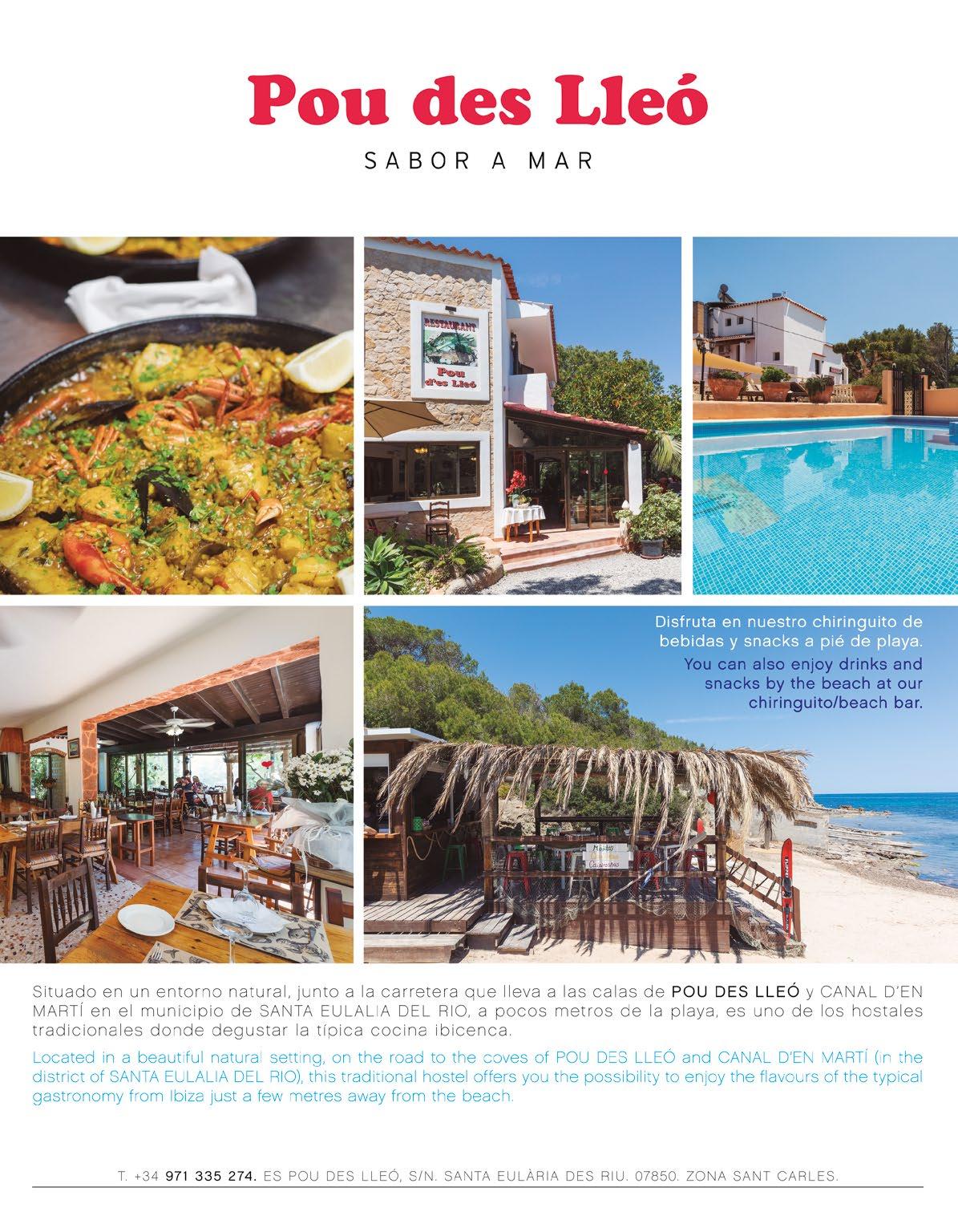
Todo lo contrario de lo que sucedía hasta hace solo unas pocas décadas en Ibiza. Una economía de subsistencia y trueque, en la que cada uno producía algo que intercambiaba. Una Ibiza en blanco y negro en la que las mujeres vestían de pageses, cubrían su cabeza con pañuelos negros, y los hombres eran los dueños de su futuro.

La generación de mujeres de las que hablamos fue, además, pionera. Algunas salieron a trabajar fuera de casa y compartían su jornada laboral con las tareas que había que hacer en el hogar. Jóvenes que se esforzaron por comerse la vida y no porque esta las devorara a ellas. Mujeres que alimentaron, y lo siguen haciendo, física y emocionalmente, a sus sucesores. Personas que han evolucionado a un ritmo vertiginoso como lo ha hecho la sociedad, pero para las que el cuidado y el amor por la familia siguen siendo los hilos atávicos con los que tejer su malla protectora.
DE LAS VECES SE ENCUENTRAN EN LAS CASAS Y POCAS VECES EN LOS RESTAURANTES
Esa red que se genera entre generaciones, cocinando y compartiendo un guisat d’ous, un arroz blanco con pollo o una tarta de albaricoques. Recetas que la mayoría de las veces se encuentran en las casas y pocas veces en los restaurantes, y cuyos ingredientes no se pesan en gramos, sino en ‘puñados’, a ‘buen ojo’, o con ‘un poco más’. Platos que surgieron de la necesidad humana de alimentarse y que ahora son nexo de unión del amor entre generaciones.
quite the opposite in Ibiza up to just a few decades ago. The island’s economy was based on subsistence and bartering, with everyone producing something they could trade. A blackand-white Ibiza in which women dressed as rural pageses, covering their heads with black scarves, and men were the masters of their future.
INGREDIENTES QUE NO SE PESAN EN GRAMOS, SINO EN ‘PUÑADOS’, A ‘BUEN OJO’, O CON ‘UN POCO MÁS’
What’s more, the generation of women we’re talking about were pioneers. Some of them had jobs outside the home and combined their working day with the household chores. Young women who made an effort to savour life before it could eat them up. Women who nourished, and continue to nourish, both physically and emotionally, those who’ve come after them. Women who, like society, have evolved at a dizzying pace but for whom care and love for the family are still the atavistic threads used to weave their protective web.

The network that’s created between generations by cooking and sharing a guisat d’ous (stew with hard-boiled eggs), some white rice with chicken or an apricot cake. Recipes that are mostly found in homes and rarely in restaurants, and whose ingredients aren’t weighed out in grams but in ‘handfuls’ or “by eye” or with ‘a pinch more’. Dishes that arose from humans’ need for nourishment but that now represent a bond of love between generations.





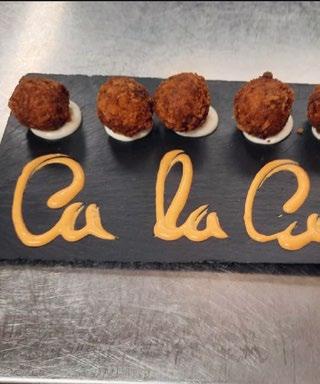

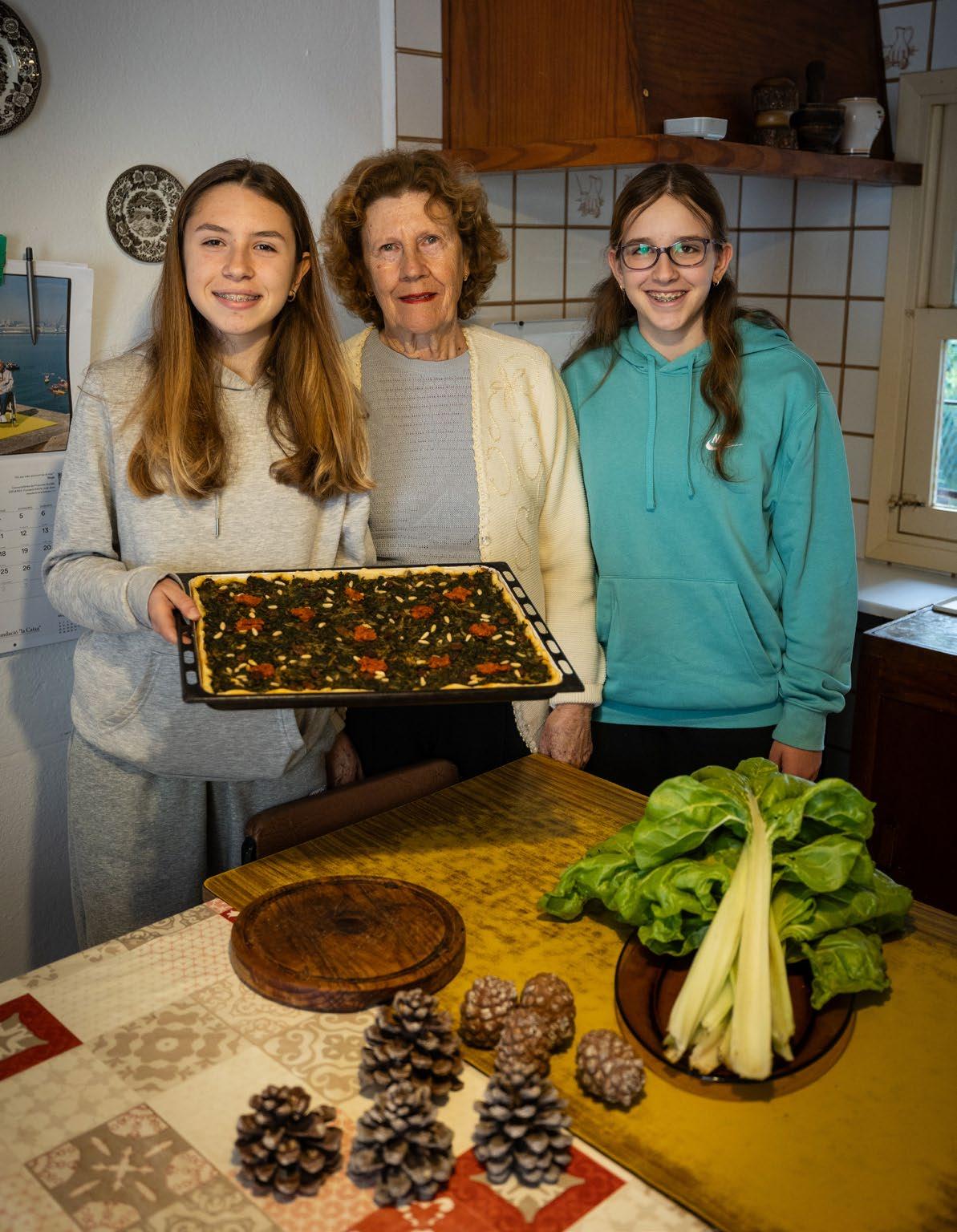
MARIA ROSELLÓ TUR, ‘COCA DE BLEDES’
Maria es alegre y divertida. Madre de seis hijos —una hija y cinco chicos— y abuela de nueve, da la impresión de que la casa debe de estar siempre concurrida. Se nota que la matriarca es el centro de la familia y su vivienda, el lugar de encuentro. El plato que ha elaborado es una coca de bledes (acelgas) con piñones y uvas pasas, a la que le ha puesto trozos de sobrasada.
“He hecho la coca de acelgas porque me gusta mucho. Bueno, a mis hijos también, y a alguna de mis nietas. Planto las verduras, las recojo y son mucho mejores que las compradas, tienen más sabor”.
Tiene un huerto del que saca, según la temporada, patatas, cebollas, acelgas, pimientos de asar y de freír o calabacines, entre otras verduras. En broma se queja de que la familia disfruta este hobby pero que nadie la ayuda en las tareas del campo. Además, tiene 24 gallinas que alimenta y cuida. “Es una lástima que no pueda tener un gallo; los vecinos se quejan. Con el último que tuve, un vecino vino a decirme que por qué no le daba una pastilla al animal para que durmiera toda la noche”.
Ella ha trabajado siempre en casa. Sacar adelante seis hijos da para una jornada completa sin días libres ni descanso. “Es mucho trabajo”, recalca. Los secretos de la cocina los aprendió junto a su madre. Uno de sus hijos nos cuenta que cuando era pequeño en la casa se comía todos los días de “olla” y que “era más barato y más sano”.
Ahora, cuando se juntan, le piden que haga arroces, sofrit pagès, frita. “Me encantan las frites pero ya no hago muchas. “Hay que cuidarse”, dice, y entre risas añade: “Ahora que tengo más tiempo para comer, no puedo hacerlo”. Maria reconoce que antes también hacía postres y que ahora son su hija y las nueras las que han cogido el relevo en la repostería.
Las nuevas generaciones aprenden el recetario tradicional pero, como en la mayoría de los casos, el problema está en traducir lo que pesa un grapadet o algo hecho a a bon ull
Maria is cheerful and fun. A mother of six children - a daughter and five boys - and a grandmother nine times over, she gives the impression that the house must always be teeming with people. You can tell the matriarch is the centre of the family and her home is where everyone gets together. The dish she’s prepared is a coca de bledes (Swiss chard tart) with pine nuts and sultanas, to which she’s added some pieces of sobrassada (cured pork sausage with paprika).
SHE’S ALWAYS WORKED AT HOME. RAISING SIX CHILDREN REQUIRES A FULL DAY’S WORK AND THERE’S NO TIME OFF OR REST
“I’ve made coca de bledes because I like it a lot. Actually, my children do too, and some of my granddaughters. I grow the vegetables myself; I pick them and they’re much better than the ones you can buy; they have more flavour”.
She has a plot where, depending on the season, she grows potatoes, onions, Swiss chard, roasting and frying peppers and courgettes, among other vegetables. She jokingly complains that the family enjoys her hobby but that no-one helps out with the gardening. She also has 24 chickens to feed and look after. “It’s a pity I can’t have a cockerel but the neighbours complain. With the last one I had, a neighbour came and suggested I give him a pill to make him sleep through the night”.
She’s always worked at home. Raising six children requires a full day’s work and there’s no time off or rest. “It’s a lot of work”, she points out. María learned the secrets of cooking from her mother. One of her sons tells us that, when he was little, his family used to eat “de olla” (one-pot meals) every day and that “it was cheaper and healthier”.
Now, when they get together, they ask her to make rice dishes, sofrit pagès (traditional stew) and frites (fried dishes). “I love frites but I don’t make them a lot now. “You have to take care of yourself”, she says, adding with a laugh: “Now that I have more time to eat, I can’t do it”. Maria also notes that she used to make desserts but now it’s her daughter and daughters-in-law who’ve taken over the baking.
The new generations have learned the traditional recipes but, as in most cases, the problem lies in translating the weight of a grapadet (handful) or something made a bon ull or by eye.
Los viernes son especiales en casa de María del Carmen. Desde hace años reúne a sus hijas y nietos para comer. Una tradición que se sigue manteniendo, aunque su único hijo viva en Japón y los nietos que viven en Ibiza empiecen a irse a estudiar fuera. Es su manera de sentir la red familiar tensada y a tono. El día que nos atendió estaba preparando un guisat d’ous. Una receta que se elabora con patata ibicenca, huevos duros y verduras de temporada. Suelen ser alcachofas, habitas tiernas o espárragos, con una picada de almendras, azafrán y pimentón dulce. El resto de los condimentos depende del gusto de la familia.
SUS MANOS, CAPACES DE INTERPRETAR A LOS MEJORES COMPOSITORES DE MÚSICA
CLÁSICA, SIGUIERON PREPARANDO SUCULENTOS PLATOS
Maria del Carmen, la mayor de cuatro hermanos (ella y tres chicos), empezó a entrar en la cocina a ayudar y a ver cómo se cocinaba con solo 10 años. “Era lo lógico, estabas en casa y tenías que ayudar a tu madre. Allí aprendías de una manera natural a cocinar”.
Con 14 años ya era capaz de preparar muchos de los platos del recetario familiar y, a los 18, sus padres enfermaron y ella se hizo cargo de la cocina. Tenía que alimentar a sus progenitores y a sus hermanos. Responsabilidades que había que ir aceptando según te las iba imponiendo la vida. Aunque vivían en Vila tenían una finca, es Corralassus, de donde sacaban muchos de los alimentos que necesitaban para el día a día.
Maria del Carmen estudió la carrera de piano y dio clases de este instrumento hasta que su hija mayor cumplió cinco años y la familia se amplió. Pero esas manos, capaces de interpretar a los mejores compositores de música clásica, siguieron preparando suculentos platos que reúnen a la familia en torno a la mesa.
El nieto japonés le pide milanesas que, aunque no es un plato muy ibicenco, ella se las hace con pollo pagès. “A los mayores les gusta todo lo que les hago. Los canelones los preparo utilizando la receta que usaban mi abuela y, de mi madre, la sopa de pollo pagès con galets y albóndigas, las croquetas hechas con la carne del puchero, el arroz negro y la fideuá”. Platos que se disfrutan en una mesa en la que se sientan familiares y amigos. Recetas, repetidas año tras año, con el ingrediente del cariño como condimento necesario y especial.
Fridays are special at María del Carmen’s house. For years she’s been gathering her daughters and grandchildren together for lunch. A tradition that’s kept up today, even though her only son lives in Japan and even the grandchildren who live in Ibiza are starting to leave the island to continue their studies. It’s her way of keeping the family network tight and everyone in unison. On the day we saw her, she was preparing a guisat d’ous, a dish made with Ibizan potatoes, hard-boiled eggs and seasonal vegetables, usually artichokes, baby broad beans or asparagus, with chopped almonds, saffron and sweet paprika. The rest of the seasoning depends on what the family likes.
The eldest of four siblings (herself and three boys), María del Carmen started going into the kitchen to help out and to see how to cook when she was just 10 years old. “It was the logical thing to do; you were at home and you had to help your mother. It was a natural way to learn cooking”.
By 14 she could already prepare many of the family’s habitual dishes and, at 18, when her parents fell ill, she took over the cooking. She had to make the meals for her parents and siblings, duties that had to be accepted as and when life imposed them on you. Although the family lived in Vila, they also had a farm, es Corralassus, which provided much of their daily food.
María del Carmen studied piano and used to give piano lessons until her eldest daughter turned five and the family grew. But those hands, capable of playing the best classical composers, continued to prepare succulent dishes that bring the family together around the table.
RECIPES, REPEATED YEAR AFTER YEAR, WITH THE INGREDIENT OF AFFECTION AS A NECESSARY AND SPECIAL SEASONING
Her Japanese grandson asks her for milanesas (breaded cutlets) which, although not a particularly Ibizan dish, she makes with free range chicken. “The adults like everything I make for them. I make cannelloni following my grandmother’s recipe and, from my mother, I learned how to make chicken soup with galets (pasta) and meatballs, croquettes made with stewed meat, black rice and fideuá (a kind of paella but with noodles)”. Dishes that are enjoyed at a table where family and friends are all seated. Recipes, repeated year after year, with the ingredient of affection as a necessary and special seasoning.


La vida de María ha girado en torno a la cocina. “Empecé a cocinar siendo bastante pequeña, con diez u once años ya hacía la comida. Mis padres trabajaban y me encargaba de preparar el puchero para mis padres y mis hermanos pequeños”. Un par de décadas después, Maria y su marido Vicent se hicieron cargo del conocido bar Can Rafal de la Marina donde ella perfeccionó sus dotes culinarias. “Me hubiera gustado haber aprendido a cocinar al lado de alguien que supiera”, confiesa, aunque nunca recibió ninguna crítica de los miles de clientes que por allí pasaron a lo largo de los años. A muchos de ellos los cuidó como si fueran de la familia.
El “plato de cariño” que ha escogido es un arroz blanco con pollo que hace las delicias de una de sus nietas. Tiene tres, dos chicas y un chico. “Ella está estudiando en Barcelona y siempre que vuelve a Ibiza me pide que se lo haga. Además, se lo come haciéndose montaditos con trozos de pan. La nieta pequeña, hace lo mismo. Las dos primas comen el arroz con pollo de la misma manera”.
La familia de Maria era de pescadores. Recuerda que en su casa, de pequeña, “había pescado para desayunar, comer y cenar”. “Cuando llegaba el pescado, mis hermanos pequeños y yo nos íbamos andando desde Santa Eulària hasta la zona de Morna con una cesta llena y volvíamos con ella repleta de comida que habíamos cambiado por los serrans, gerrets y otros pescados que llevamos. El trueque lo hacíamos por productos que nosotros no teníamos, como las legumbres”.
Recuerda el guiso de tortuga que hacía su madre. “Era muy laborioso, pero estaba muy rico. Primero había que hervirlo y lo hacíamos afuera, debajo de un algarrobo, porque olía muy mal. Se le quitaba una grasa amarillenta que tiene y que costaba mucho de soltar. Después la carne se desmigaba y se guisaba. Era un plato con un sabor muy fuerte a marisco”.
Pero Maria hizo el máster en cocina cuando se quedaron con el bar Can Rafal. Treinta comensales de lunes a viernes y duplicaban el sábado. Empezó con tapas y fritas y acabaron haciendo un menú del día que era un éxito. “Al principio tiré de las recetas que había aprendido en casa y amplié el recetario preguntando a las vecinas. Eso sí, todos los días a las cinco y media de la mañana me iba al mercado a comprar y, dependiendo de lo que encontraba, así planificaba el menú”. Como dice, nunca sobró nada de un día para otro y tenía clientela fija que comía más de dos platos de cuchara y, al terminar, le pedía que le guardara para el día siguiente.
“Ahora ya no me sale tan bueno lo que cocino. Creo que es porque ya no lo hago para tanta gente, no sale tan sabroso”, afirma.
Maria’s life has revolved around cooking. “I started cooking when I was quite young; I was already making the lunch when I was 10 or 11 years old. My parents worked and I was in charge of making the stew for my parents and my younger siblings”. A couple of decades later, Maria and her husband Vicent took over a well-known bar called Can Rafal in La Marina, where she perfected her culinary skills. “I would’ve liked to have learned how to cook together with a real expert”, she confesses, although she’s never had any complaints from the thousands of customers who came to the bar over the years. Many of them she looked after as if they were family.
The “dish of affection” she’s chosen is white rice with chicken, a dish that delights one of her granddaughters. She has three; two girls and a boy. “She’s studying in Barcelona and, whenever she comes back to Ibiza, she always asks me to make it for her. What’s more, she eats it by piling it up on pieces of bread. My smallest granddaughter does the same. And the two cousins eat chicken rice the same way”.
Maria’s family were fishermen and she remembers that, at home, when she was a child, “there was fish for breakfast, lunch and dinner”. “When the fish arrived, my younger brothers and I would walk from Santa Eulària to the Morna area carrying a basket full of fish, and we’d return with it full of the food we’d exchanged for the serrans (combers), gerrets (picarels) and other fish we’d taken with us. We’d barter for products we didn’t have, such as legumes”.
She remembers the turtle stew her mother used to make. “It was very laborious but incredibly tasty. First it had to be boiled and we did that outside, under a carob tree, because it stank the place out. A yellowish fat had to be removed from the turtle, which was very hard to get out. Then the meat was crumbled and stewed. It was a dish with a very strong seafood flavour”.
But Maria got her “master’s degree” in cooking when they took over the Can Rafal bar. Thirty diners from Monday to Friday and double that number on Saturdays. She started off with tapas and fried food but ended up creating a daily set menu that was very popular. “At the beginning I made use of the recipes I’d learned at home and then expanded the dishes by asking the neighbours. Of course, every day at half past five in the morning I’d go to the market to buy food and, depending on what I found, I’d plan the menu”. As she says, there was never anything left over from one day to the next and she had a steady clientele who’d eat more than two “spoon” dishes and, when they’d finished, would ask her to save them some for the next day.
“Now what I cook doesn’t come out as good. I think it’s because I don’t cook for so many people anymore; it doesn’t come out as tasty” she says.
Catalina nació en Sant Josep y tuvo la suerte de hacerlo en una casa donde había huerto, animales y un llaüt. “Mi padre salía a pescar. En aquellos años, había veces que se hacía con dinamita, y en casa nunca faltó el pescado que también secábamos. Mi madre era una gran cocinera y, con poco, hacía platos deliciosos. Tengo el recuerdo de un arroz con cangrejo, lapas y caracolas pequeñas y de otro guiso que hacía con patatas, cebolleta tierna y peix sec que estaban deliciosos”.
Ella tiene una hija, dos hijos y cinco nietos —dos chicas y tres chicos— que viven en Ibiza y en Madrid. Para los primos, la tarta de albaricoques que hace la abuela es uno de sus platos preferidos. Ha estado en celebraciones de cumpleaños, comidas familiares o vueltas a casa desde Francia, donde estudia uno de los nietos mayores. La mezcla del dulce del bizcocho y el ácido del albaricoque es muy sabrosa.
Catalina creció en una isla donde “una semana ibas al colegio y, a la siguiente, te tocaba ir a la païssa de Cala Carbó acompañada por alguno de los mayores de casa a cuidar de las ovejas y las cabras”. Un Sant Josep en el que los niños y las niñas disfrutaban de una onza de chocolate y una galleta forta los domingos a la salida de misa. En el que, para celebrar el cumpleaños, se comía un huevo frito con patatas, porque “el resto que ponían las gallinas se vendían para comprar fideos, arroz y otros alimentos necesarios para la casa”. Ella pudo hacer los estudios de Artes y Oficios y, con el paso de los años, desarrollarse como ceramista, que es una de sus pasiones.
Ella, según su familia, es una gran cocinera aunque siempre encuentra algún “pero” al punto de cocción o le saca algún defecto al plato que haya preparado. Joan, su marido, y sus hijos y nietos, esperan el comentario casi diario, y le jalean el “hoy no me ha quedado bien”. Catalina sabe preparar muy bien platos del recetario tradicional ibicenco como son el bullit de peix, el sofrit pagés, la greixonera o el flaó
“Empecé a cocinar cuando me casé, pero ayudaba en la cocina desde pequeña y tuve una gran maestra que fue mi madre. Me acuerdo que el primer plato que preparé para la familia, cuando vivía en casa de mis padres, con mis seis hermanos y mis dos tías, fue un plato de legumbre. Lo que no recuerdo es si les gustó o hubo alguna queja”.
Catalina was born in Sant Josep and was lucky enough to be born in a house where there was a vegetable garden, animals and a traditional boat called a llaüt. “My father used to go fishing. They’d sometimes fish with dynamite in those days and at home there was never a lack of fish, which we also dried. My mother was a great cook and could make delicious dishes out of very little. I remember a rice dish with crab, limpets and small sea snails, and another dish of stew that she made with potatoes, spring onions and peix sec (dried fish) that was delicious”.
Catalina has a daughter, two sons and five grandchildren - two girls and three boys - who live in Ibiza and Madrid. For the cousins, grandma’s apricot cake is one of their favourites and it has been present at birthday celebrations, family meals and homecomings from France, where one of the eldest grandchildren is studying. The combination of the sweetness of the sponge and the tartness of the apricot is delicious.
She grew up on an island where “one week you went to school and the next you had to go to the païssa (hayloft) at Cala Carbó accompanied by one of the adults from home to look after the sheep and goats”. An island where, on the feast day of Saint Joseph, the children would be given an ounce of chocolate, and a galleta forta (crispbread) on Sundays after mass. Where, to celebrate a birthday, they’d eat a fried egg with potatoes because “the rest of the eggs laid by the hens were sold to buy noodles, rice and other foodstuffs needed for home”. She was able to study Arts and Crafts and, over the years, to develop into a ceramist, which is one of her passions.
According to Catalina’s family, she’s a great cook although she believes she never cooks anything “à point” and always manages to find a flaw in a dish she’s made. Almost every day, her husband Joan and her children and grandchildren wait for such comments and reassure her when she says, “it hasn’t turn out well today”. Catalina is very good at preparing traditional Ibizan dishes such as bullit de peix (fish casserole), sofrit pagès (traditional stew), greixonera (a kind of egg pudding) and flaó (cheesecake pastries).
“I started cooking when I got married but I’d been helping in the kitchen since I was little and my mother was a great teacher. I remember that the first dish I prepared for the family, when I lived at my parents’ house together with my six siblings and two aunts, was made from legumes. What I don’t remember is whether they liked it or there were any complaints”.
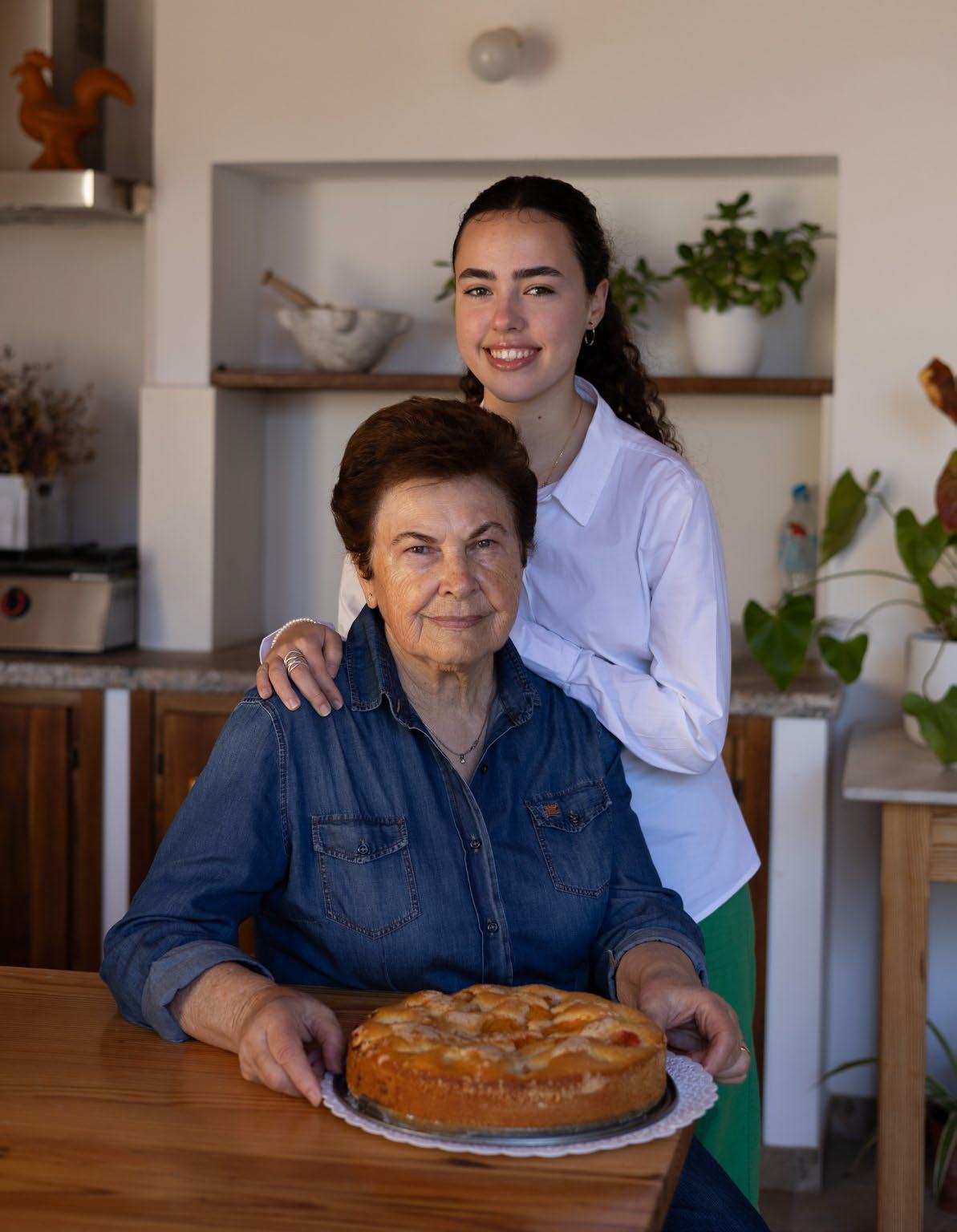

Maria ha criado a tres hijos —un chico y dos chicas— y tiene tres nietos —también un chico y dos chicas—. Una mujer que ha trabajado fuera de su casa, que ha hecho pelucas y que ha cocinado en un bar que llevaba en Es Viver. “Me gustaba mucho cocinar pero ahora ya no”. Lo dice y se ríe.
Por cómo hablan sus hijas de ella, no debe parar de hacer cosas. Como, por ejemplo, el taller de hierbas por San Juan para recoger todas las plantas necesarias, más de veinte, para elaborar en familia el licor de hierbas ibicencas. “Aunque haga tres o cuatro botellas de hierbas todos los años, en verano se me escapan todas. Bien fresquitas y con hielo las disfrutamos la familia y los amigos”.
ESPONJOSAS,
A petición de las nietas, el plato que ha preparado son las orelletes Ella las hace grandes, esponjosas, fritas en un aceite suave y espolvoreadas en azúcar. “Las hago a menudo, las pequeñas disfrutan comiéndolas. Bueno, ellas y nosotros los mayores”
Aprendió a cocinar cocinando. Nos cuenta que la primera paella que hizo fue un éxito y que todo el mundo hablaba de ese arroz. “Compraba los mejores productos y así era fácil. Ahora hay que mirar más qué es lo que se compra, todo está muy caro”. Pone cara de niña traviesa cuando le preguntamos a las hijas que si han aprendido a cocinar con su madre y ellas contestan que “poco, muy poco”. Maria sigue mandando en los fogones y la familia se deja querer con los platos que ella les prepara.
“Hago de todo: panellets, salsa de Nadal, sofrit pagès, canelones, frita de pulpo”. Las nietas y las hijas corean los bollitos preñados que hace de sobrasada. Y a ella se le nota un instante de nostalgia cuando habla de su hijo y del nieto que viven en Barcelona. Como buena madre gallina, le hubiera gustado tenerlos en casa.
Transmite pasión por la vida, por la comida, por una charla. Aunque cuando se le pregunta cuál es su plato preferido dice: “ahora sólo como judías verdes, son cosas del azúcar”. Y vuelve a reírse.
Maria has raised three children - a boy and two girls - and has three grandchildren - also a boy and two girls. A woman who’s worked outside the home, who’s made wigs and has cooked in a bar she ran in Es Viver. “I used to love cooking but not anymore” she says, and laughs.
From the way her daughters talk about her, she must be constantly on the go. For example, the herb workshop for the feast day of Saint John to collect all the necessary plants, more than twenty, needed for the family to make the traditional Ibizan herb liqueur. “Although I make three or four bottles of herbs every year, in summer they all disappear. We enjoy them chilled and with ice, together with family and friends”.
At the request of her granddaughters, the dish she’s prepared is orelletes (aniseed biscuits). She makes them big and very light, fried in a mild oil and sprinkled with sugar. “I often make them; the little ones enjoy eating them. Well, them and us grown-ups, too”.
She learned to cook by cooking. She tells us that the first paella she made was a success and that everyone was talking about her rice. “I used to buy the best produce so it was easy. Now you have to look more closely at what you buy; everything is very expensive”. She puts on a mischievous face when we ask her daughters what they’ve learned to cook with their mother and they answer “very, very little”. Maria’s still in charge of the kitchen and the family loves the food she prepares for them.
SHE LEARNED TO COOK BY COOKING, AND TELLS US THAT THE FIRST PAELLA SHE MADE WAS A SUCCESS
“I make everything: panellets (almond petits fours), Christmas sauce, sofrit pagès (traditional stew), cannelloni, fried octopus”. The granddaughters and daughters sing praises of the bollitos preñados (stuffed bread rolls) she makes with sobrassada (cured pork sausage with paprika). And we note a moment of nostalgia when she talks about her son and grandson who live in Barcelona; as a good “mother hen”, she would’ve liked to have them at home.
She conveys a passion for life, for food and for good conversation. However, when asked what her favourite dish is, she says “I only eat green beans now; it’s a blood sugar thing”. And she laughs again.
La ancestral costumbre de alimentarse con los productos que daba la naturaleza y la deficiente agricultura de Ibiza y Formentera, que no era suficiente para alimentar a toda la población de las Pitiusas, hizo que sus habitantes tuvieran que agudizar el ingenio y buscaran su sustento en productos y animales que hoy consideramos totalmente imposibles de incluir en nuestra dieta. Sin embargo, conviene tenerlos presentes como memoria de épocas no tan prósperas como las actuales.
La pesca, generosa y abundante, fue la gran despensa de los pitiusos. En tiempos pasados una especie copiosa era la langosta, que los pescadores capturaban en gran cantidad entre sus redes, pero que no era muy apreciada y se consideraba un plato de baja categoría. Además, los pescadores no le tenían mucha estima, pues su duro caparazón causaba grandes desperfectos en sus artes de pesca.
Sin embargo, fueron precisamente los pescadores quienes inventaron múltiples maneras de cocinarla como la Llagosta a la eivissenca, que es parecida a la caldereta de langosta que conocemos hoy, pero con una picada abundante de ajo, almendra, piñones, perejil, pimienta, pimentón y azafrán; todo aderezado con unas briznas de tomillo (frígola). También era frecuente la langosta a la marinera o con alioli. Con el tiempo, han llegado nuevas formas de preparación de la langosta, ahora con unos precios prohibitivos, especialmente las de las costas pitiusas.
The ancestral custom of consuming the products offered by nature and the deficient agriculture of Ibiza and Formentera, which could not produce enough to feed the entire population of the Pityusic Islands, forced the local inhabitants to exploit their ingenuity and find sustenance in products and animals that today are considered absolutely impossible to include in our diet. Nevertheless, it is good to remember them as an evocative reminder of an era that was far less prosperous than today.
The products of the sea, which were generous and abundant, formed the main staple of the islanders’ diet. In the past, one particularly plentiful species was the lobster. Though fishermen caught large numbers of them in their nets, lobster was not highly valued, as it was considered a low-quality dish. Moreover, the fishermen themselves had little regard for these animals, as their hard shell caused major damage to their gear.
All the same, it was precisely the fishermen who came up with countless different ways to cook lobster, like Llagosta a la eivissenca, which is similar to the lobster stew of today, but with a hearty mince of garlic, almonds, pine nuts, parsley, pepper, paprika and saffron, all seasoned with a few sprigs of frígola (thyme). It was also common to serve lobster a la marinera or with aioli sauce. Over time, new ways of preparing lobster have emerged, today of course, with prohibitively high prices, particularly along the coasts of Ibiza and Formentera.

Otros platos de origen humilde y marinero que se han ido adaptando a los nuevos gustos son el guisat y el bullit de peix, que antiguamente los pescadores elaboraban con el pescado de menor tamaño que no podían vender. Los comensales de hoy los quieren con pescados grandes y con pocas espinas como el mero, el gallo de San Pedro o la roja (escorpena).
Entre los platos marineros que hoy ya no se cocinan, están los que contenían la pagellida (lapa). Este sabroso molusco se halla protegido y catalogado como especie amenazada. Algo semejante ocurre con el corn marí (caracol de mar) o el bogamarí o garota (erizo de mar), que con la presión de pesca son cada vez menos frecuentes.


Other specialties of humble seaside origin that have gradually been adapted to today’s newer palates are the Guisat de peix and Bullit de peix, which the fishermen of the past prepared with the smaller fish that they could not sell. Today’s food lovers prefer these dishes with large fish and few bones, such as grouper, John Dory and red scorpionfish.
ENTRE LOS PLATOS MARINEROS QUE HOY
Los campesinos alababan la carne de los eriçons (erizos) por su parecido con la carne de lechón. Con una cánula insertada por una pata, soplaban para separar la piel de las púas y así despellejarlos. Ponían la carne en adobo para atenuar su fuerte sabor y hacían con ella un guiso. También solían cocinarlos con arroz.
Algo semejante ocurría con la carne de los estornells (estorninos) y de los teulats (gorriones), que se cazaban con una red sujeta con dos largas varas que el cazador sostenía en un paso de montaña. Como estas pequeñas aves acostumbran a cobijarse en las paredes de pozos y norias, por la noche los cazadores colocaban una red
Some fishermen’s dishes are no longer prepared today, as they contain the pagellida (limpet). This tasty mollusc is now protected as an endangered species. The same applies to the sea snail known as the corn marí, as well as the bogamarí or garota (sea urchin), which are becoming less and less common, due to the ecological pressures caused by fishing.
The Islands’ rural communities often lauded the meat of eriçons (hedgehog) for its similarity to suckling pig. To skin them, they would insert a cannula through the porcupine’s leg and blow through it to separate the skin from the quills. The meat was marinated to tone down its strong flavour and then used for stew. It was also frequently cooked with rice.

sobre su brocal y hacían ruido y encendían antorchas para asustarlas; al intentar escapar quedaban atrapadas en la red. Desplumadas y evisceradas, las aves se partían en mitades y se cocinaban con arroz o estofadas.
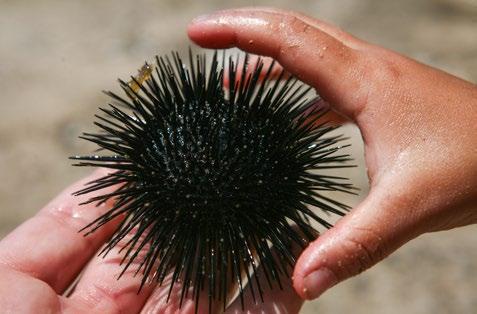
“Bogamarí”, el erizo de mar.
LA ‘VIROTADA’ ES EL NOMBRE CON EL QUE SE CONOCE A LA OPERACIÓN DE CAZAR Y PREPARAR PARA SU CONSUMO A ESTA AVE, CONOCIDA COMO PARDELA BALEAR O VIROT EN LAS PITIUSAS
THE ESTORNELLS (STARLINGS) WERE HUNTED USING A NET THAT WAS ANCHORED TO TWO LONG RODS, WHICH THE HUNTER WOULD HOLD IN PLACE AT A MOUNTAIN PASS
The flesh of estornells (starlings) and teulats (sparrows) was similarly treated. These birds were hunted using a net that was anchored to two long rods, which the hunter would hold in place at a mountain pass. Because these small birds tend to seek shelter in the walls of wells and waterwheel houses, the hunters would place a net over their opening at night, making noise and lighting torches to frighten them. As the birds attempted to escape, they were caught in the net. Plucked and gutted, the birds were then cut in halves and either cooked with rice or stewed.

La ‘virotada’
La ‘virotada’ es el nombre con el que se conoce a la operación de cazar y preparar para su consumo a esta ave, conocida como pardela balear o virot en las Pitiusas. Jóvenes y experimentados cazadores se descolgaban de noche con cuerdas por los acantilados de la Mola y del Cap de Barbaria, en Formentera, y en el islote de Es Vedrá para cazarlos.
The virotada
Virotada is the term used to describe the process of hunting and preparing the bird known in the Pityusic Islands as the virot (the Balearic shearwater) for consumption. Young and experienced hunters used ropes to hang from the cliffs of La Mola and Cap de Barbaria in Formentera, and the islet of Es Vedrá, where they would hunt them at night.


Su caza era más un desafío a la naturaleza que una necesidad alimentaria. Los virots son pájaros fuertes y agresivos, que propinan contundentes picotazos a quien se acerca a sus nidos, en lugares casi inaccesibles. Para llegar hasta ellos era necesario descender con cuerdas por los despeñaderos y más de un cazador murió en el intento.
Para hacerse con ellos, los jóvenes llevaban teas empapadas con azufre, vinagre y ajo picado, que, una vez encendidas, desprendían un humo fétido que aturdía a los virots, que intentaban salir de la cueva. En ese momento, el cazador aprovechaba para atraparlos, torcerles el pescuezo y meterlos en el zurrón.
ERA NECESARIO DESCENDER POR LOS DESPEÑADEROS Y MÁS DE UN CAZADOR MURIÓ EN EL INTENTO
Para cocinarlos se desplumaban, se escaldaban un par de veces para poder quitarles la piel y se ponían a hervir en agua con un manojo de hierbas aromáticas para reblandecer su carne y suavizar el fuerte sabor a marisco. Después se sofreían con guisantes, alcachofas, zanahorias y habas tiernas; verduras abundantes en la primavera, que era cuando se solía hacer la cacería y cuando los virots eran jóvenes y tiernos. También había quien los cocinaba al estilo del sofrit pagès
Their hunting was more about defying nature than a need for food. Virots are strong, aggressive birds that will forcefully use their strong beaks to strike anyone who approaches their nests, which sit in virtually inaccessible places. To reach these birds, the hunters had to descend the precipices on ropes, and more than a few hunters met their fate in the attempt.
To capture virots, the young men would carry torches soaked in sulphur, vinegar and chopped garlic. Once lit, the torches gave off a foul-smelling smoke that stunned the birds, which would try to leave the cave. At that moment, the hunters would trap them, break their necks and put them in their bags.
ONE OF THE LAST KNOWN VIROTADES, OR BALEARIC SHEARWATER HUNTS, WAS IN THE 1990S, ON THE ISLET OF S’ESPARDELL. ORNITHOLOGISTS LATER AFFIRMED THAT THE COLONY THAT ONCE INHABITED THIS SMALL ISLAND HAD BEEN WIPED OUT

These birds were then plucked, scalded a couple of times to remove their skin and boiled in water with a bunch of aromatic herbs to tenderise their meat and lessen their strong seafood flavour. They were then sautéed with springtime vegetables including peas, artichokes, carrots and baby broad beans, as the hunt was usually carried out in the spring, when the virots were young and tender. Some people also cooked them in a sort of sofrit pagès or farmer’s sauté.
One of the last known virotades, or Balearic shearwater hunts, was in the 1990s, on the islet of S’Espardell. Ornithologists later affirmed that the colony that once inhabited this small island off the coast of Ibiza had been wiped out.
It is important to bear in mind that the virot is now a protected species in danger of extinction and that its hunting is strictly prohibited.


Les sugiere algo diferente en sus vacaciones. Un ciecuito de más de 300 metrows, Baby-karts infantiles a partir de 4 años, Karts infantiles a partir de 7 años, Karts de gran potencia para adultos, nueva pista de Mini-Quad a partir de 6 años y juegos recreativos para niños.
LA EMOCIÓN ESTA ASEGURADA !!
Suggest something new for your holidays. More than 300 metres long circuit, Ho-Karts for babies over 4 years, Go-Karts for children over 7 years, powerful karts for adults, new Mini-Quad track for children over 6 years ans amusement arcade for children.
EXCITEMENT IS GUARANTEED !!
Etwas Neuartiges für ihren Urlaub. 300-Meter-Bahn, Baby-Karts ab 4 Jahren, Kinder-Karts ab 7 Jahren, PS-starke Karts für Erwachsene, neue Mini-Quad-Bahn ab 6 Jahren un Spielplatz für Kinder.
SPAB GARANTIERT !!
Ctra.
Una de las últimas virotades de las que se tiene conocimiento fue en los años noventa del siglo pasado, en s’Espardell. Los ornitólogos afirmaron que exterminaron la colonia que habitaba aquel islote de la costa de Ibiza.
Hay que recordar que actualmente el virot es una especie protegida, en peligro de extinción, y que su caza está totalmente prohibida.
En tiempos pasados era frecuente la captura para el consumo humano de la tortuga de mar, que podía llegar a pesar 200 kilos. Los mayores recuerdan haber visto algún ejemplar de tortuga atada a un noray del puerto de Ibiza, a la espera de encontrar comprador.
La tortuga se solía pescar en las llamadas minves de gener (las calmas de enero) con el agua muy fría, pero con la temperatura ambiental más cálida. Las tortugas emergían del agua para recibir los rayos de sol y aumentar así la temperatura corporal. Ese era el momento que los pescadores aprovechaban para capturar a estos quelonios.
Para prepararlas para el consumo había que limpiar cuidadosamente la carne de la tortuga, quitando toda la grasa, pues es amarga y estropeaba el guiso. Se restregaba con sal y se sofreía en una cazuela con alguna verdura y patatas. Se dejaba en ebullición y, al final, se añadía un buen majado de ajos, pan frito, almendra, ñora y las yemas de unos huevos duros.
LOS MAYORES RECUERDAN HABER VISTO ALGÚN EJEMPLAR DE TORTUGA
ATADA A UN NORAY DEL PUERTO DE IBIZA, A LA ESPERA DE ENCONTRAR COMPRADOR
Hay que recordar que la tortuga de mar es una especie protegida y a día de hoy está totalmente prohibida su captura. En los últimos tiempos ha habido diversos episodios en nuestras playas de desoves de tortuga, cosa rara durante muchos años y que ha merecido la atención de los medios de comunicación y de la sociedad.
In the past, sea turtles, which could weigh up to 200 kilos, were often captured for human consumption. Some of the older locals in the community remember occasionally seeing a sea turtle tied to a bollard in the harbour of Ibiza, awaiting purchase.
The sea turtle used to be fished during the so-called minves de gener (calm waters of January), when the water was very cold but the air temperature was relatively warm. The sea turtles would emerge from the sea to soak up the warm rays of the sun and increase their body temperature. The fishermen took advantage of those moments to catch these chelonians.
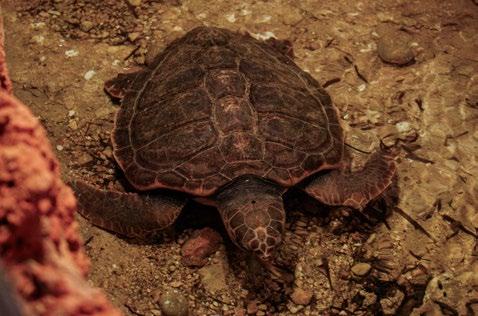
To prepare them for consumption, the sea turtle meat had to be carefully cleaned, trimming away all the fat, as its bitter flavour could ruin the stew. The meat was rubbed with salt and sautéed in a casserole dish with vegetables and potatoes. It was then left to boil, and finally combined with a generous mixture of crushed garlic, fried bread, almonds, ñora peppers and hard-boiled egg yolks.
It is important to remember that the sea turtle is now a protected species and that its capture is strictly prohibited by law. In recent years, there have been several sightings of sea turtles spawning on our beaches. This was a rare phenomenon for many years and caught the attention of both the mass media and the general public.

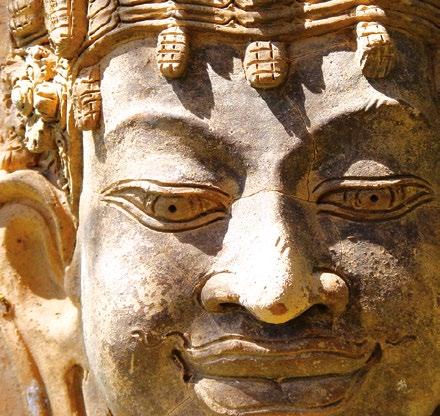



LAS DALIAS: MULTICULTURAL GASTRONOMY THAT CONQUERS THE SENSES

PALOSANTO: SURPRISING TRADITIONAL CUISINE AT LAS DALIAS
T F
Silvia CastilloArsen Voronyy / PaloSanto
¿Te atreves a comer un plato que no has visto nunca en otro lugar? Si crees que no es posible que un restaurante te pueda sorprender, abre la puerta a lo inesperado: PaloSanto logra una cocina de raíz con personalidad propia, donde se mezclan sabores picantes, ácidos y dulces, en un carrusel brillante de emociones y en un lugar cautivador, repleto de historia.
Remolacha, helado de aguacate y queso ahumado es uno de los platos que desafía la imaginación y enamora; junto con las costillas de maíz, salsa santa y polvo de chiles o la obra maestra que representa el tuétano asado, sopes y salsa verde. Los comensales no salen de su asombro a lo largo de un viaje repleto de autenticidad, que culmina con un postre fascinante como el chile ancho, mousse y sopa de chocolate blanco.
Are you daring enough to try a dish you’ve never seen anywhere else? If you think it’s impossible for a restaurant to surprise you, just open the door to the unexpected: PaloSanto serves up a traditional cuisine with its own personality, where spicy, tangy and sweet flavours come together to create a dazzling procession of emotions in a captivating setting, steeped in history.
Beetroot, avocado ice cream and smoked cheese is one of the dishes that defies the imagination and wins the heart; along with the corn ribs, salsa santa and chilli powder, or the roasted marrow, sopes and salsa verde--a masterpiece! Guests remain in a state of wonder all along this journey of authenticity, which culminates in a tantalising dessert like the ancho chili, mousse and white chocolate soup.
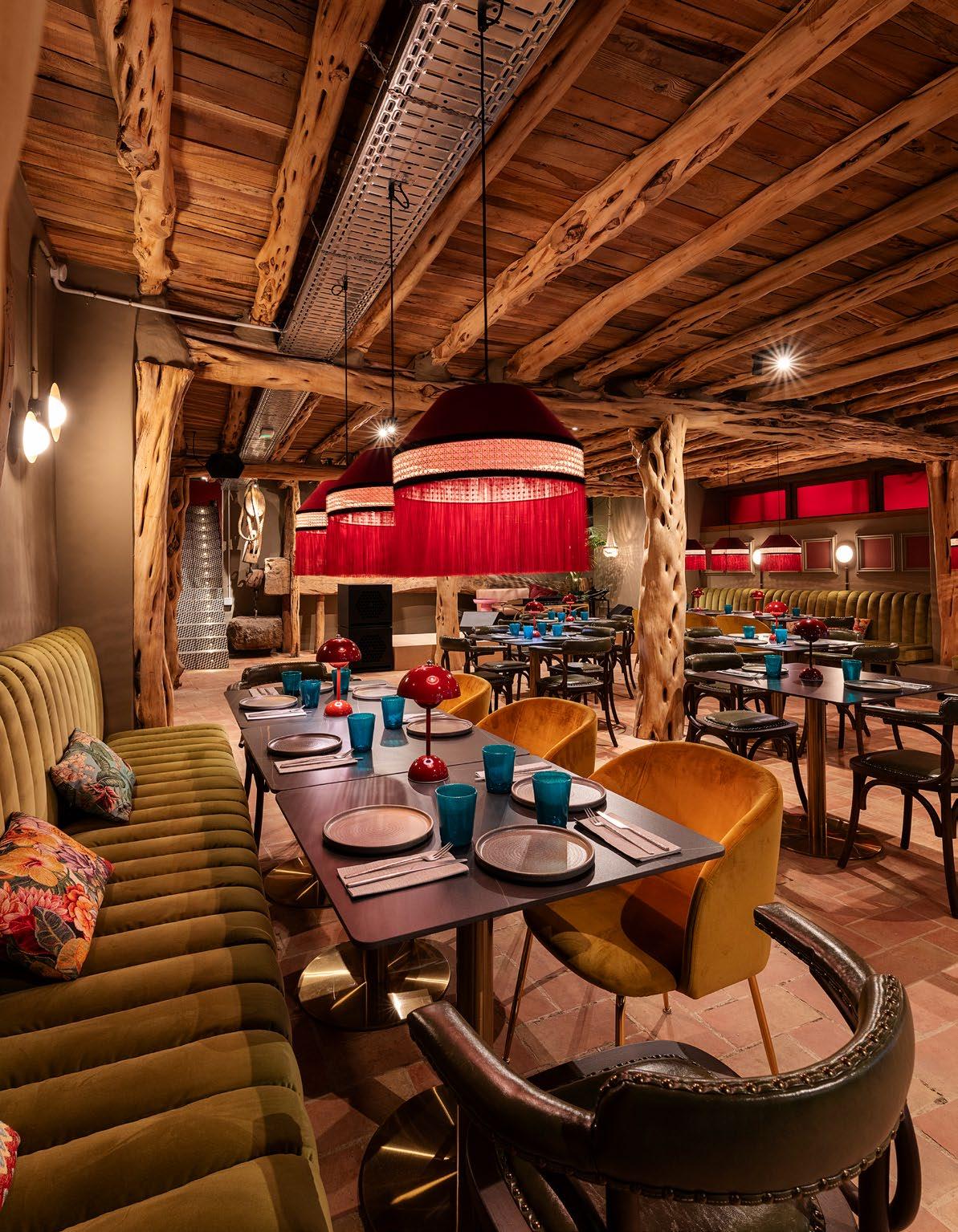
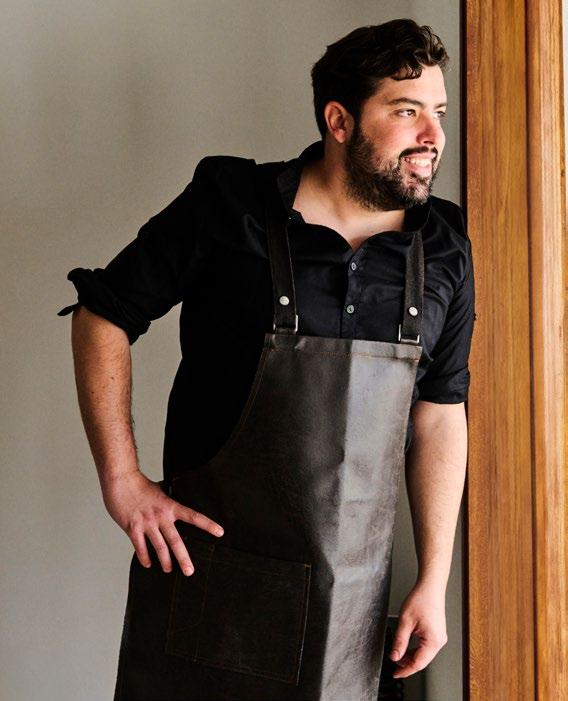
Te invadirá la extraña sensación de que descubres una cocina completamente nueva, en la que incluso elaboraciones mexicanas tan familiares como el guacamole, el cebiche o los tacos, adquieren una nueva magnitud. Es el resultado insólito de una combinación de elementos: La extraordinaria calidad de los productos, junto a la sabrosa mezcla de ingredientes y texturas, con un denominador común que es la personalidad y la experiencia de un chef, con un mundo propio.
Nacido el 4 de diciembre de 1988, Iker Llona Orozco, creció en México. “El sabor de mi infancia es el ahumado. Antes de comer, mi madre siempre preparaba la salsa y tostaba los chiles. Hoy en día, el aroma del chile sobre la brasa de Las Dalias, me recuerda a casa”.
Ha cultivado una vocación de hierro, que busca la perfección. “Trabajé cuatro años en el País Vasco e hice un máster en el Basque Culinary Center. Después estuve una temporada en Chipre, antes de pasar por Londres, donde empecé en restaurantes franceses y me formé en Le Gavroche (dos estrellas Michelin) o el Grupo Ceviche, una cadena de restaurantes peruanos donde me encargaba de las aperturas y fue una experiencia muy bonita”.
You’ll get that funny feeling of discovering a completely new cuisine, where even the most familiar Mexican dishes like guacamole, ceviche and tacos take on a whole new dimension. This is the remarkable result of a combination of elements: the extraordinary quality of the products and the flavourful mix of ingredients and textures, combined with the unique personality and experience of a chef who creates a world of his own.
“EN PALOSANTO HEMOS CONCEBIDO UNA CARTA CON LA QUE ESTAMOS CÓMODOS, ABIERTOS SIEMPRE
A ESCUCHAR LOS COMENTARIOS Y SUGERENCIAS DE NUESTRA
Born on 4 December 1988, Iker Llona Orozco grew up in Mexico. “The flavour of my childhood is smoked. Before meals, my mother would always prepare salsa and roast the chilli peppers. Today, the aroma of the chillies over the embers at Las Dalias reminds me of home”.
This chef has cultivated an unwavering calling that strives for perfection. “I worked for four years in the Basque Country and did a Master’s Degree at the Basque Culinary Center. Then I spent some time in Cyprus, before moving to London. There, I began working in French restaurants and received training at Le Gavroche (two Michelin stars) and Grupo Ceviche, a chain of Peruvian restaurants where I was in charge of the openings, a really lovely experience”.
He landed in Ibiza in 2011, where he worked in some of the finest kitchens of the island’s luxury hotels, until he was “captured” by Sena Pallero, the head of gastronomy at Las Dalias.
Iker Llona is defined by his ancestral roots and simplicity, and he has no doubts about his conceptual approach: “As chefs, we tend to make the mistake of focusing on what we think people will like, when the key to success resides in knowing what you want to convey. Nowadays, this is a very common mistake that leads to a loss of identity on our menus. We have conceived a menu that we are comfortable with, and we are always open to hearing the comments and suggestions of our guests”.

Aterrizó en Ibiza en 2011, donde ha trabajado en algunas de las mejores cocinas de hoteles de lujo de la isla, hasta que le “capturó” Sena Pallero, responsable de la oferta gastronómica de Las Dalias.
A Iker Llona le define su raíz ancestral y la sencillez y no alberga dudas sobre su apuesta conceptual: “Como cocineros solemos cometer el error de enfocarnos a lo que creemos que va a gustar a la gente, cuando la clave del éxito radica en saber qué quieres transmitir tú. Perdemos la identidad de las cartas por ese error, muy frecuente hoy en día. Nosotros hemos concebido una carta con la que estamos cómodos, abiertos siempre a escuchar los comentarios y sugerencias de nuestra clientela”.
El resultado no puede ser más armónico ni favorable. “Es verdad que todo existe y todo está inventado, pero también es cierto que yo no he visto nunca nuestra remolacha sobre una base de chamoy”, explica, elevando a la categoría de esencia un condimento mexicano a base de flor de hibiscus; mango, chiles secos y lima, en una combinación de ácidos, dulces y salados, que finalmente llega al plato acompañada de kale crujiente secado a la brasa, que sabe a gloria con helado de aguacate.
The result couldn’t be more balanced or positive. “It’s true that everything exists and everything has been invented, but it’s also true that I’ve never before seen our beetroot on a chamoy base,” he states, elevating a Mexican hibiscus flower-based condiment made with mango, dried chillies and lime to the category of an essential food, in a fusion of tangy, sweet and savoury flavours that ultimately reaches the dish alongside crispy, chargrill-dried kale, which tastes like pure bliss with avocado ice cream.
“WE HAVE A LONG-TERM PROJECT, WITH PRODUCTS THAT ARE NOT SO WELL KNOWN. I’D LIKE OUR VEGETABLES TO BE ROOTED HERE”
“People never expect a knockout vegan dish and that’s something I attach great importance to. It’s easy to get a good ceviche, because if you’ve got good shrimp and good produce, it always turns out nice. But with a vegetarian or vegan dish, it’s harder to surprise people. And that is what defines my approach, as well as the mixture of ice cream and savoury flavours, together with the crunchy kale. The combination is very complete”.
“La gente nunca espera un plato vegano impactante y a eso le doy gran importancia. Es fácil conseguir un buen cebiche, porque con buena gamba y buen producto, siempre está rico. Pero un plato vegetariano o vegano, es complicado que te sorprenda. Eso define mi propuesta y también la mezcla de helado con salado, junto al crujiente de kale. El conjunto es muy completo”.
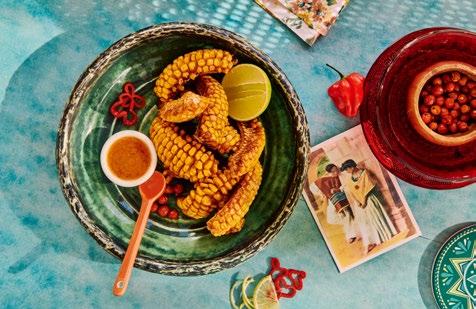
Otra elaboración tan arriesgada como poco frecuente es el tuétano: “A la gente que más quieres, siempre le das el tuétano. A menudo se ha considerado un producto de lujo, pero nosotros lo ofrecemos como un sabor auténtico y muy rico”.
Sin duda, otro de sus éxitos es el pollo perrón brasa, achiote, xnipec: “El marinado tiene un sabor característico, que gusta mucho al público. Nace de un proyecto que trabajé en Suiza, en un restaurante latino, sobre la base de un plato peruano con chucuta, que es algo parecido a un perejil con un toque más intenso. El origen de aquel marinado ha ido evolucionado, pero tiene mucho éxito, con aromas fuertes de ahumado y picantes bien controlados”.
Huye de etiquetas como alta cocina o restaurante gastronómico, pero no oculta el orgullo por el resultado de su trabajo: “PaloSanto es un espacio para comer súper bien, con sabores intensos y productos bien tratados. Me cuestiono quién decide o no qué es alta gastronomía. Yo solamente sé que en PaloSanto se come de maravilla. Me siento muy orgulloso porque considero que lo estamos haciendo muy bien. No busco ninguna estrella, pero sí me gustaría exportar nuestro proyecto de Las Dalias fuera de la isla y que la gente llegue a la conclusión de que aportamos algo diferente y se vaya feliz”.
Another dish every bit as daring as it is uncommon is marrow: “ You always give marrow to the people you love the most. It has often been considered a luxury product, but we offer it as a very tasty and authentic flavour”.
Another of his big hits is definitely the grilled chicken dish known as pollo perrón brasa, achiote, xnipec. Here, the marinade has a distinctive flavour that people really like a lot. It was born out of a project I worked on in Switzerland, at a Latin American restaurant. The base was a Peruvian dish made with chucuta, an herb similar to parsley but a bit more intense. The origin of that marinade has gradually evolved, but it’s very popular, with powerful yet well-controlled smoky and spicy aromas”.
While he shies away from labels like ‘haute cuisine’ and ‘gastronomic restaurant’, he doesn’t hide that he is proud of the results of his work: “PaloSanto is a place where you really eat well, with intense flavours and well-handled products. I do wonder about who it is that decides what is haute cuisine and what is not. All I know is that at PaloSanto the food is wonderful. I am very proud because I think we’re doing a great job. I’m not aiming for a star, but I would like to export our Las Dalias project beyond the island and see people walk away happy, having reached the conclusion that what we offer is different”.

His aim is to grow and evolve naturally, with his sights set on an open, sunny horizon: “We have a long-term project, with products that are not so well known on the island. I’d like our chilli peppers to be from Ibiza and our vegetables to be rooted in the island. We want to grow our own vegetable garden and open all year round. We feel aligned with everything that Las Dalias stands for and we are proud of it”.
Su objetivo es crecer y evolucionar, de forma natural, con la vista puesta en un horizonte abierto, donde brilla el sol: “Tenemos un proyecto a largo plazo, con productos que no se conocen tanto en la isla. Me gustaría lograr que nuestros chiles sean de Ibiza y que nuestra verdura tenga raíces en esta tierra. Queremos tener nuestro propio huerto y abrir todo el año. Estamos en sintonía con todo lo que transmite Dalias y nos sentimos orgullosos de ello”.
Confiesa sentir verdadera emoción por los retos que afronta en este momento de su vida: “Queremos hacer una cocina diferente y el equipo que estamos formando tiene mucha pasión, con Laura Marqués Ibán como jefe de cocina. Aquí estamos trabajando en un proyecto hecho con amor real y de verdad. No hay falsedad, aquí van a encontrar una cocina con identidad”.

Se siente un privilegiado porque es consciente de que trabaja en un lugar con alma, rodeado de antigüedades e incluso restos arqueológicos, como la gran viga de madera de un antiguo trull, que data de época romana, donde se puede ver la inscripción de 1600, lo que convertiría este vestigio en una pieza de museo que certifica que en Ibiza se produjo aceite desde tiempos remotos.
La existencia de un monumento tan valioso dentro de PaloSanto, también convierte al restaurante en un espacio excepcional y único en la isla. Joan Marí, el dueño de Las Dalias, más conocido como Juanito, lo recuerda así: “yo nací en 1961 y mi padre trajo el trull al restaurante en 1964 o 1965. Tuvo que cortar la viga, porque no cabía entera”.

He admits to feeling really excited about the challenges he is facing at this point in his life: “We want to create a different kind of cuisine and we’re putting together a very passionate team, with Laura Marqués Ibán as head chef. Here we are working on a genuine project made with great love. Nothing false, here you’ll find a cuisine with an identity of its own”.
He considers himself privileged, knowing that he works in a place with soul, surrounded by antiques and even archaeological remains. One example is the large wooden beam of an old wooden trull (olive press) dating from Roman times, with the inscription ‘1600’. This vestige could easily have ended up in a museum, providing proof that olive oil has been produced on the island since time immemorial.
The existence of such a valuable monument inside PaloSanto also makes the restaurant a very special and unique place on the island. Joan Marí, the owner of Las Dalias, better known as Juanito, remembers it like this: “I was born in 1961 and my father brought the trull to the restaurant in 1964 or 1965. He had to cut the beam, because it was too big to fit inside in one piece”.
After 60 years in business, the old cave that still has all the seductive charm of a museum, was reinvented in 2024 with a new life: “I have very fond memories of it, which is why I really love the restaurant. In the beginning it was only frequented by local islanders; later, the first tourists came for dinner every night, and it’s been busy up to today. It used to have a woodburning cooker and through the years, the junipers and the roof timbers turned black. Today it looks like a completely new place, yet it hasn’t lost a single bit of its essence”.
Después de 60 años en funcionamiento, la antigua cueva que conserva la seducción de un museo, se ha reinventado en 2024 con una nueva vida: “Tengo muy bonitos recuerdos y por eso le tengo tanto cariño al restaurante. Fue al principio solo de gente ibicenca, luego llegaron los primeros turistas a cenar cada día y hasta hoy. Antes era una cocina de leña y, con el paso de los años, las sabinas y las maderas del techo ennegrecieron. Hoy luce como un espacio completamente nuevo, sin haber perdido un ápice de su esencia”.
“QUEREMOS
POR SU GASTRONOMÍA”
El chef Iker Llona quiere incorporar la historia y el alma del lugar, como un ingrediente más de la experiencia: “Sería muy bonito que la gente de Eivissa viniera todo el año y disfrutara. El lugar es muy hermoso con la chimenea y con cada una de las piezas antiguas, desde el suelo hasta el techo. Si quisieras crear un restaurante así ahora, sería imposible. Creo que en invierno lo vamos a disfrutar”.
Joan Marí confirma que sería imposible crear un lugar similar, con las barricas antiguas, los restos de la almazara o las antiguas maderas que cubren el techo: “Mi principal sueño es convertir este restaurante en una de las principales referencias gastronómicas para cualquier persona que visite la isla. Queremos que sea un lugar emblemático por su gastronomía y que atraiga a personas de todo el mundo y todo el año”.
La fascinante revolución en el corazón del icónico mercadillo de Las Dalias ya ha comenzado y todos estamos invitados a compartirla. Iker Llona siente satisfacción cada día, cuando observa las muestras de admiración de sus clientes: “Muchos no saben ni qué esperar y por eso salen tan sorprendidos y contentos”. El chef de PaloSanto abre cada día la puerta a la aventura, con una sonrisa generosa: “Para mí la vida es la búsqueda continua de la felicidad y de sabores nuevos que te hacen disfrutar: un picante, un ácido, un dulce… la sorpresa”. En una cena en el jardín bajo las estrellas o en el mágico salón interior, solo queda dejarse llevar, desde el principio hasta el final. Ya notas que algo muy diferente y tentador empieza a ocurrir, cuando te muestran la sugerente carta de cócteles.
Chef Iker Llona wants to combine the history and the soul of the place, as another ingredient of the experience: “It would be nice if the people of Eivissa came to enjoy it all year round. The place is really beautiful, with the fireplace and with all the old original pieces, from the floor to the ceiling. If you wanted to create a restaurant like this now, it would be impossible. I think we’re going to enjoy it in winter.
Joan Marí agrees that it would be impossible to create a similar place, with the old barrels, the remains of the olive-oil mill and the old wood pieces that cover the ceiling: “ It is my dream to turn this restaurant into one of the top culinary landmarks for anyone who visits the island. We want it to be an emblematic spot for its gastronomy and an attraction for people from all over the world, all year round”.
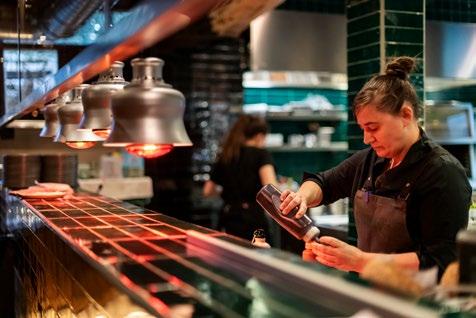
The fascinating revolution at the heart of the iconic Las Dalias flea market has already begun and we are all invited to share in it. Iker Llona is pleased every day when he sees his customers’ expressions of admiration: “Many don’t quite know what to expect, which is why they leave so surprised and delighted”. The PaloSanto chef opens the door to adventure every day, with a generous smile: “For me, life is the ongoing search for happiness and new flavours that bring you joy: a spicy flavour, a tangy flavour, a sweet flavour... the surprise”. Whether you’re dining in the garden beneath the stars or in the magical indoor lounge, you need only surrender yourself to it, from start to finish. As soon as you are shown the mouth-watering cocktail menu, you can already sense that something very different and enticing is beginning to happen.




































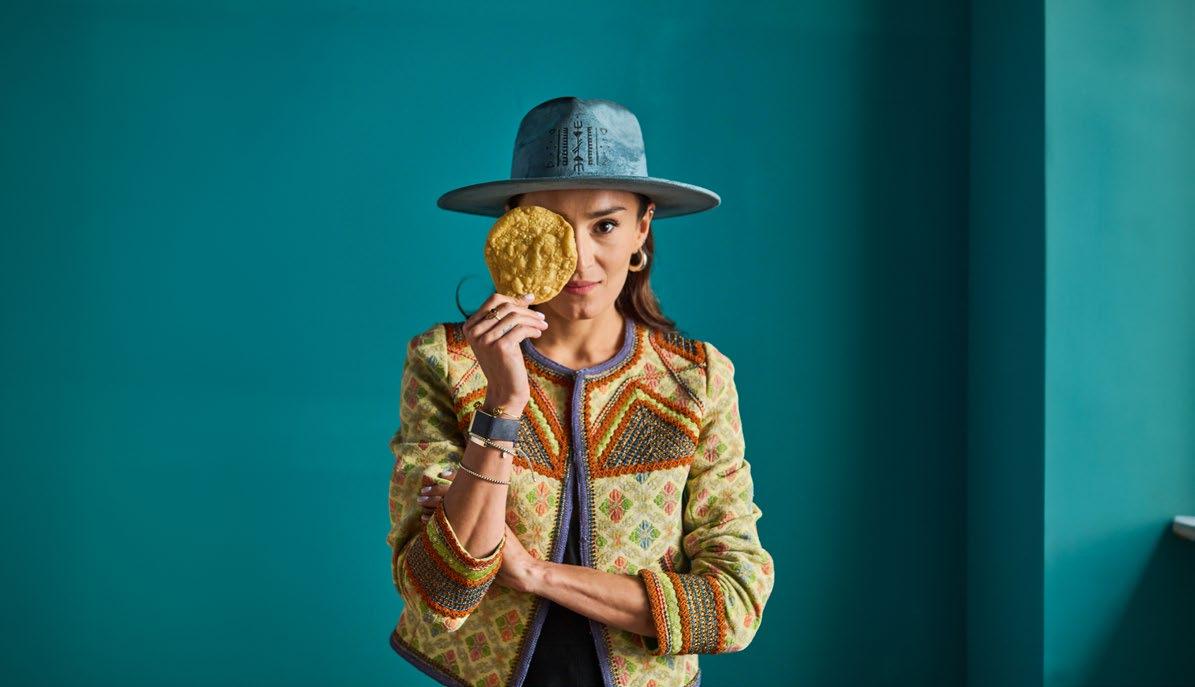
Pocos lugares de Ibiza pueden presumir de una oferta gastronómica tan variada y con tantos espacios como la que propone Las Dalias.
Guiados por la filosofía de una cocina honesta, en Las Dalias ponemos mucho entusiasmo en ofrecer una experiencia culinaria que celebra la frescura y lo simple de cada plato, con sabores arraigados en la tierra y con un alma mediterránea llena de influencias internacionales.
Few places in Ibiza can pride themselves on having such wide-ranging cuisines in as many different food spots as Las Dalias.
Guided by the philosophy of honest cuisine, at Las Dalias we are passionate about offering a culinary experience that celebrates the freshness and simplicity of each dish, with flavours deeply rooted in the land and a Mediterranean soul full of international influences.
El Café
La carta ofrece platos creados con productos locales, de temporada y muy frescos.
Este verano, además, regresamos a los sabores de una cocina internacional con matices asiáticos, mexicanos y una fuerte presencia de influencias mediterráneas. También encontramos variedad en opciones vegetarianas y veganas.

The Café
The menu features dishes made with the freshest local seasonal produce.
What’s more, this summer, we’re returning to the flavours of an international cuisine, with Asian and Mexican flairs and a marked Mediterranean influence. We also offer a variety of vegetarian and vegan options.
PaloSanto
Con una arriesgada propuesta que rescata la cocina tradicional y de raíz, Las Dalias ha inaugurado este año un nuevo restaurante que se posiciona como un faro de la cocina mexicana moderna, llevando a los comensales a un emocionante viaje sensorial de sabores ácidos, ahumados y picantes.
PaloSanto
With a daring proposal that has reclaimed traditional dishes, this year Las Dalias has opened a new restaurant designed to serve as a beacon of modern Mexican cuisine, taking its guests on an exciting sensory journey through tangy, smoky and spicy flavours.
Pizza & Salad
En este rincón gastronómico hay diez variedades de pizza para escoger, todas elaboradas con harina artesanal de molino de piedra y masa de larga fermentación. Las ensaladas son el otro punto fuerte de esta propuesta, con una combinación de productos muy frescos y nutritivos.
Pizza & Salad
This culinary corner offers ten different types of pizza to choose from, all made with traditional stone flour and longfermentation dough. The other focus of this eatery are its delicious salads, which combine fresh and nutritious produce.

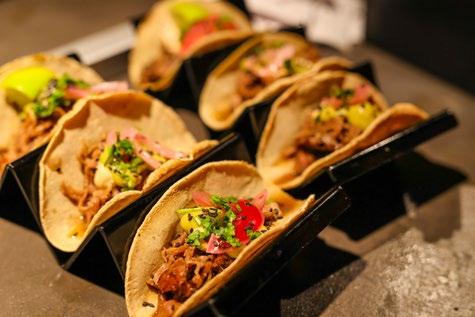
México aterriza en Las Dalias con esta propuesta informal y perfecta para compartir y disfrutar en buena compañía: Tacos elaborados de manera artesanal con harina de trigo, con diferentes rellenos y acompañados de variedad de tequilas.
Paella & Cocktails
¿Marisco o vegetales? En nuestra sección de Paellas, puedes disfrutar de una gran variedad en arroces tradicionales, capturando la esencia del Mediterráneo en cada bocado.
Paella & Cocktails
Seafood or veggie? Our Paella section offers a wide assortment of traditional rice dishes, capturing the essence of the Mediterranean in every bite.
Tacos
Mexico has landed at Las Dalias with this casual spot. The perfect place to share and enjoy in good company traditional hand-made tacos with wheat flour and assorted fillings, along with a range of different tequilas.
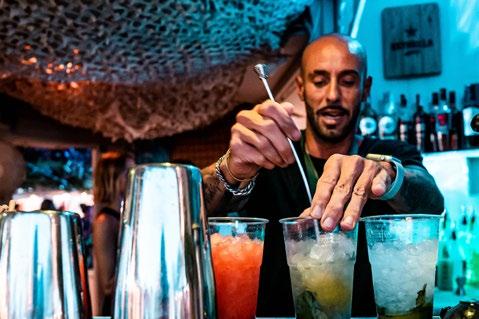
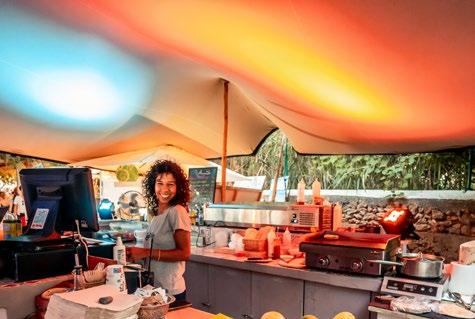
La Jaima
Un rincón clásico de Las Dalias para viajar al Medio Oriente con platos tradicionales como kebab de pollo y falafel, que se cocinan al momento y se sirven con salsa de yogur; variedad de tartas, como la de zanahoria; zumos y refrescante té de menta.
La Jaima
A classic little corner of Las Dalias that will whisk you off to the Middle East, with traditional dishes like chicken and falafel kebabs, which are prepared on the spot and served up with yoghurt sauce; assorted pastries, including carrot cake; juices and refreshing mint tea.
El Food Truck trae recetas de cocina de plancha como hamburguesas smash de wagyu servidas con pan de patata, al más puro estilo USA. Además, este punto de comida callejera no olvida las clásicas patatas fritas con salsas, los postres caseros y otras sugerencias semanales de comida para llevar (con opciones vegetarianas), cervezas y refrescos.
The Food Truck offers grilled specialties like smashed wagyu burgers served with potato buns in the purest all-American style. What’s more, this street food eatery also dishes up classic French fries with sauces and homemade desserts, and offers weekly take-away specials (with vegetarian options), along with assorted beers and soft drinks.

Juices & Cocktails
El rincón más refrescante de Las Dalias ofrece zumos de frutas frescas y de estación y cócteles clásicos (con y sin alcohol), que añaden a su carta nuevas opciones sin azúcares añadidos, con agave y pulpas naturales.
The most refreshing nook at Las Dalias offers fresh, seasonal fruit juices, as well as classic cocktails (with and without alcohol), while further enhancing their menu with new options made with no added sugars, using agave syrup and natural fruit pulp.
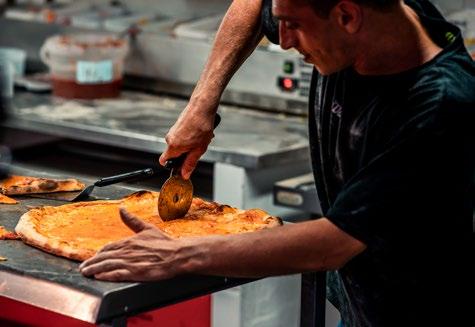
La auténtica pizza napolitana al corte, con masa elaborada con harina artesanal y estirada a mano. La combinación perfecta la logran con una amplia variedad de cervezas, clásicas y artesanales.
Authentic Neapolitan pizza by the slice, with a hand-stretched crust made of artisan flour. Add in a wide range of classic and craft beers, for the ideal combination.
Cócteles (con y sin alcohol), sangrías, refrescos, vinos y variedad en cervezas para disfrutar en buena compañía y con la mejor música de uno de los rincones preferidos del mercadillo. Garden Bar
Cocktails (with and without alcohol), sangrias, soft drinks, wines and a wide range of beers, to enjoy in good company, along with the finest music, all in one of the most loved spots in the flea market.

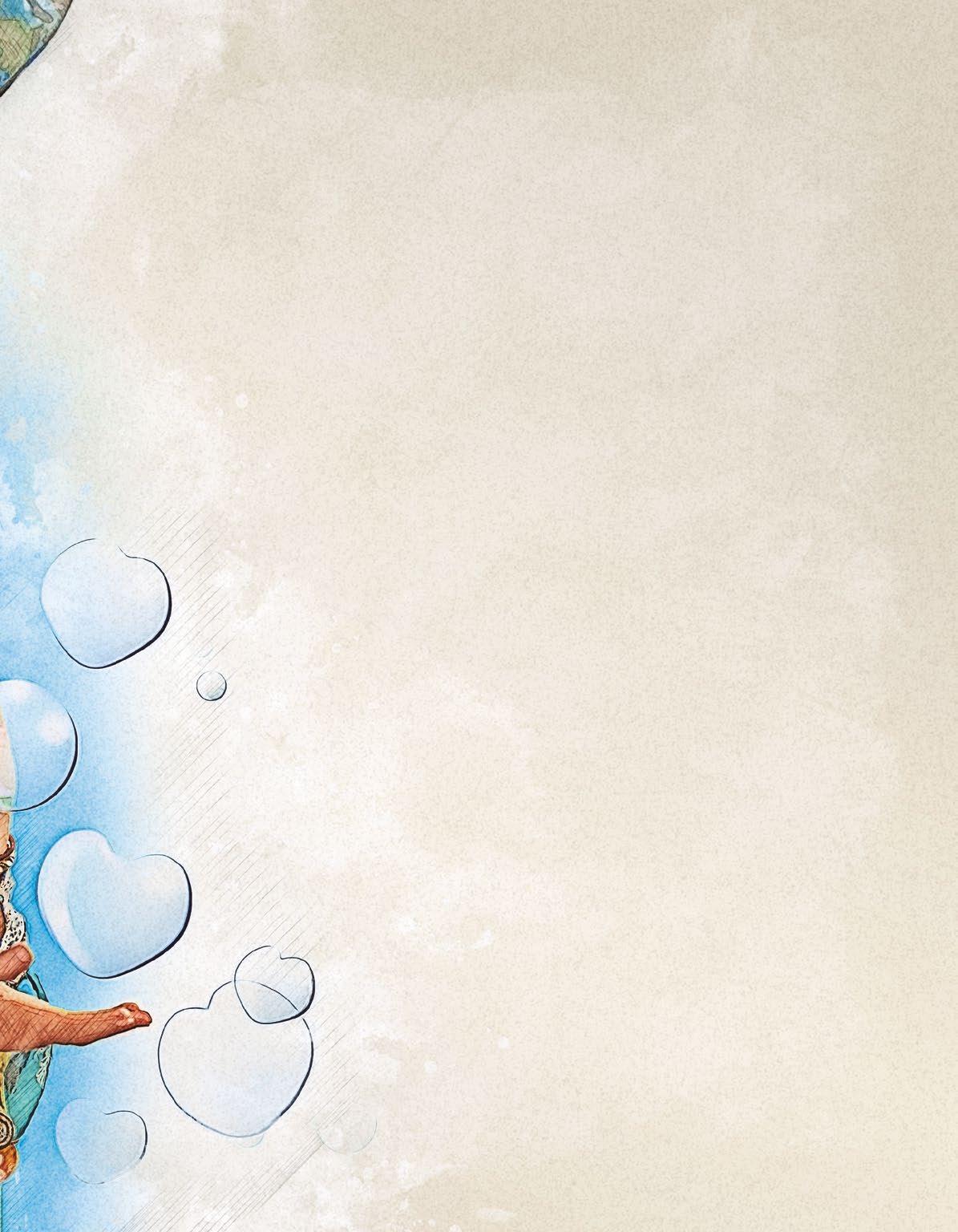
El poder del amor nos ha llevado hasta aquí y por eso hemos querido reivindicarlo en un editorial de moda impactante y lleno de sensibilidad, que recorre todas las facetas del amor en nuestras vidas. Además, repasamos la historia de Las Dalias de la manera más original: a través de un cómic y a través también del relato en primera persona de Juanito Marí, Juanito de Las Dalias, que nos cuenta la trayectoria de este singular negocio. Las primeras bodas y celebraciones se convierten en un documento casi antropológico de la historia de Ibiza. Y las conectamos con las intrahistorias de amor que se han fraguado en Las Dalias.
The power of love has brought us here, which is why we wanted to celebrate it in a striking and sensitive fashion editorial, exploring all facets of love in our lives. Additionally, we revisit the history of Las Dalias uniquely: through a comic strip and the first-person account of Juanito Marí, Juanito de Las Dalias, who narrates the trajectory of this unique business. The first weddings and celebrations almost become an anthropological record of Ibiza’s history. We also connect them with the love stories that have blossomed at Las Dalias.
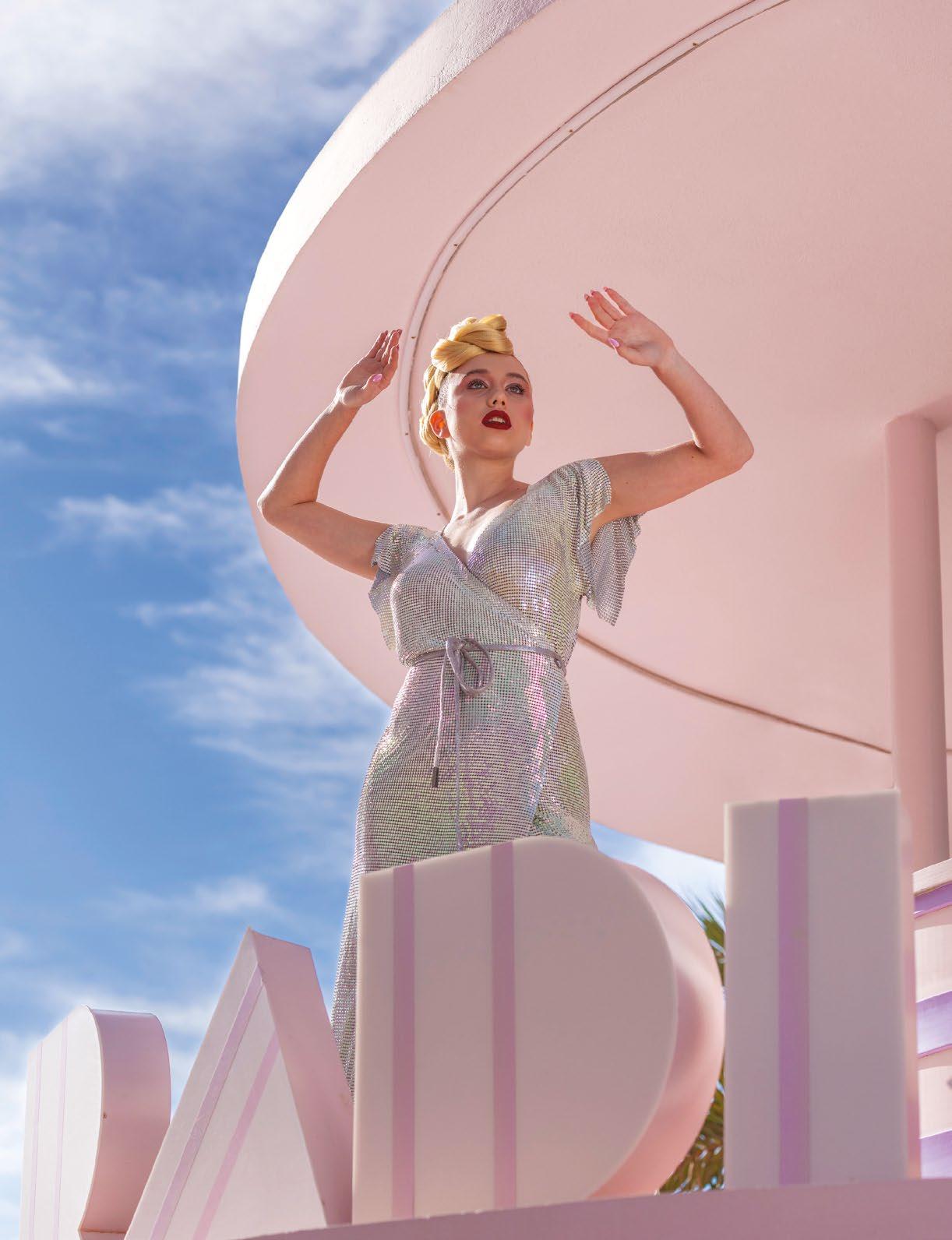
 KIRA: Vestido de ISABEL MOORE,
KIRA: Vestido de ISABEL MOORE,
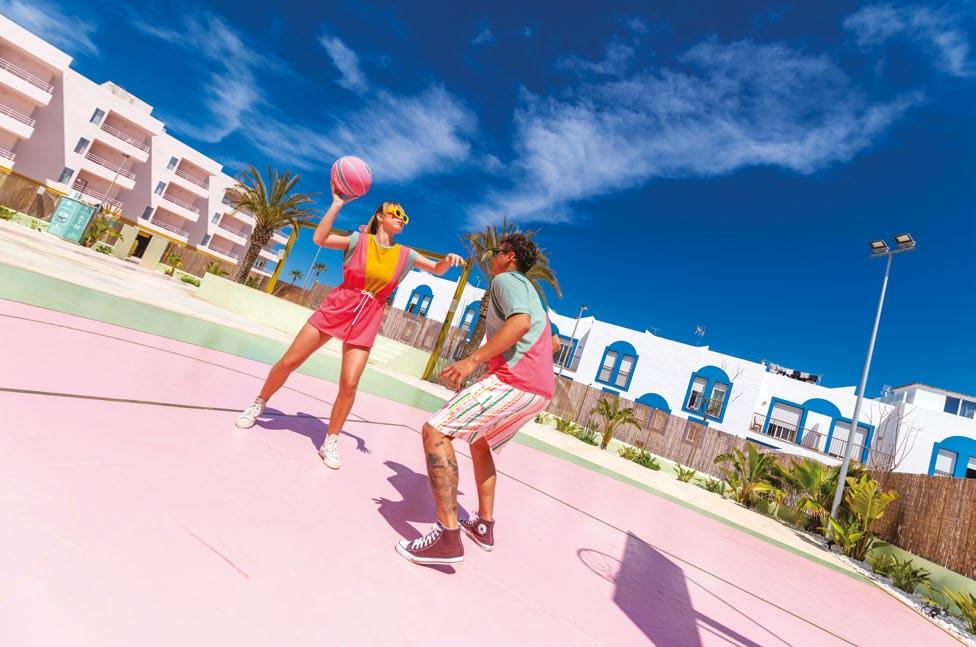


“El juego es la esencia de la alegría, y la alegría es la esencia de la vida”
Debasish Mridha

“Todavía creo en el gran Amor, oímos a menudo; pero en lo que hay que creer es en las personas vulnerables e imperfectas”
Pascal Brukner
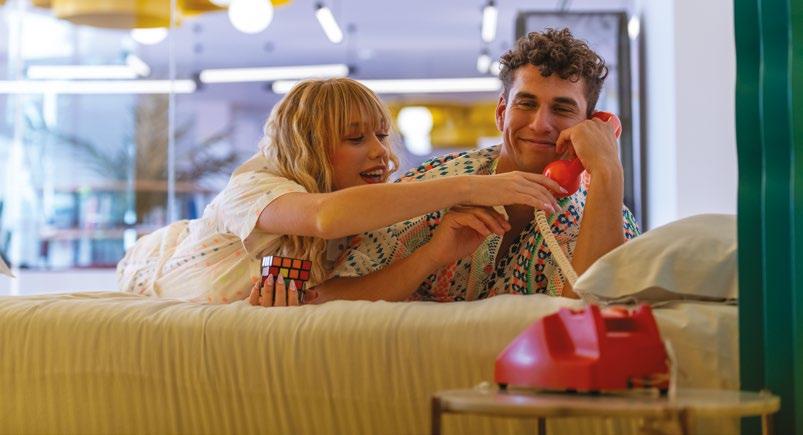


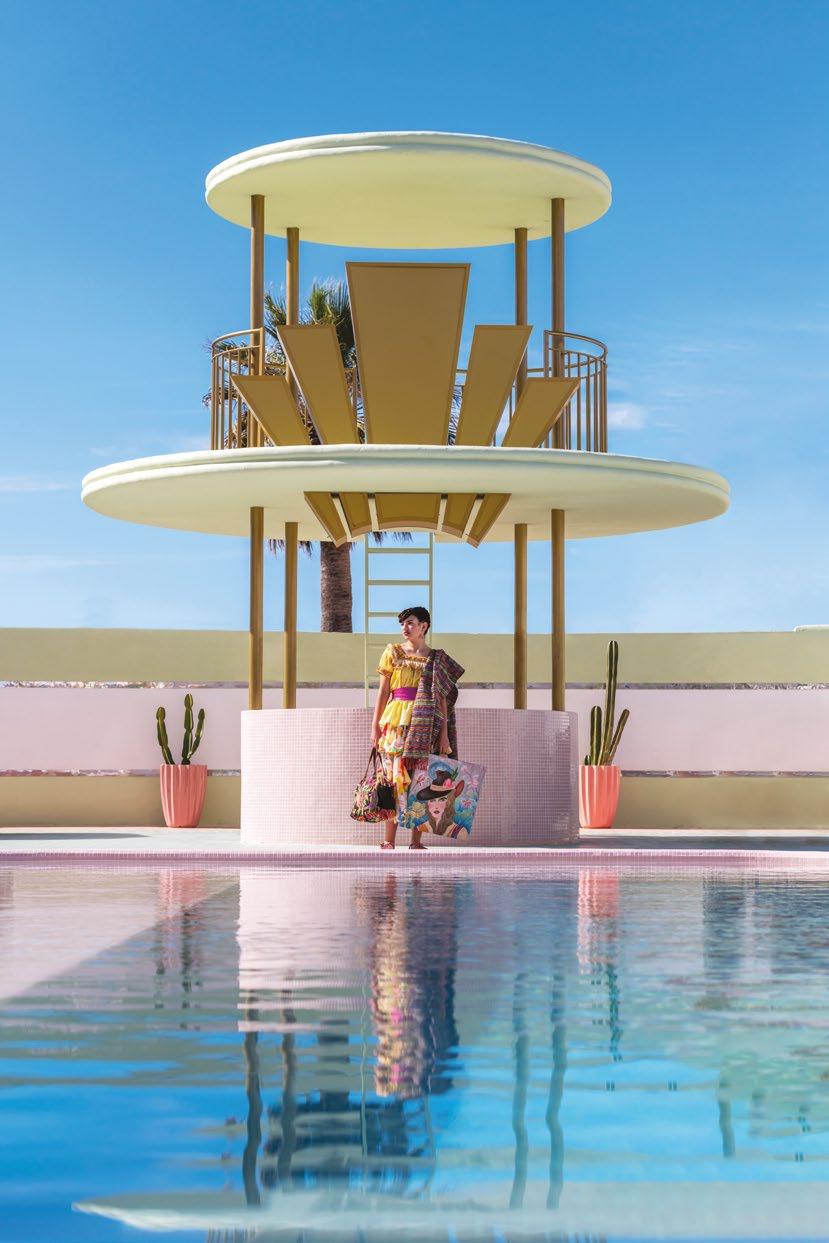


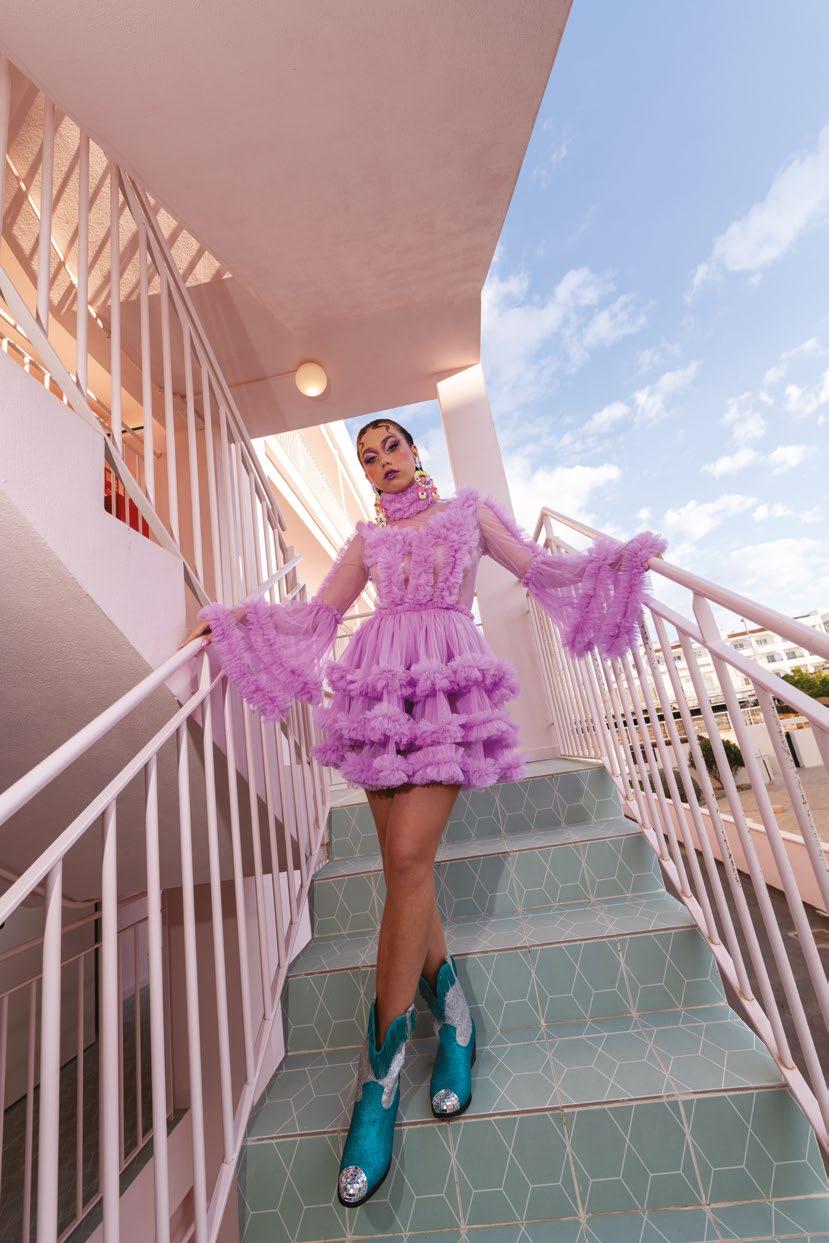


“No es amor, no se le parece, es algo tal vez más precioso y raro, una dulce amistad” Clara Obligado






“La risa es la distancia más corta entre dos corazones enamorados”
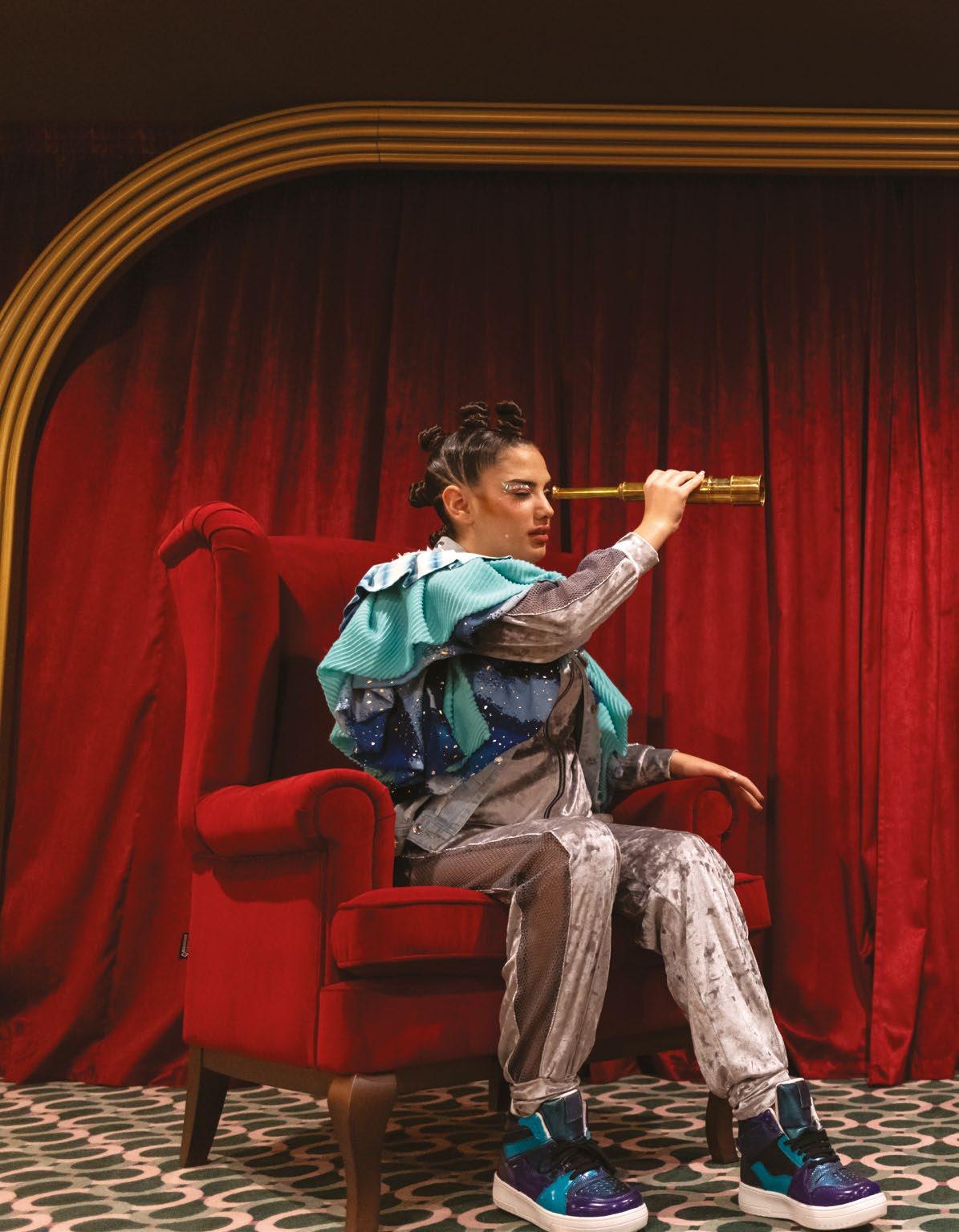

“Ama la totalidad de tu vida, no sólo las partes que te resultan agradables. Todo forma parte del gran orden del universo”
Marco Aurelio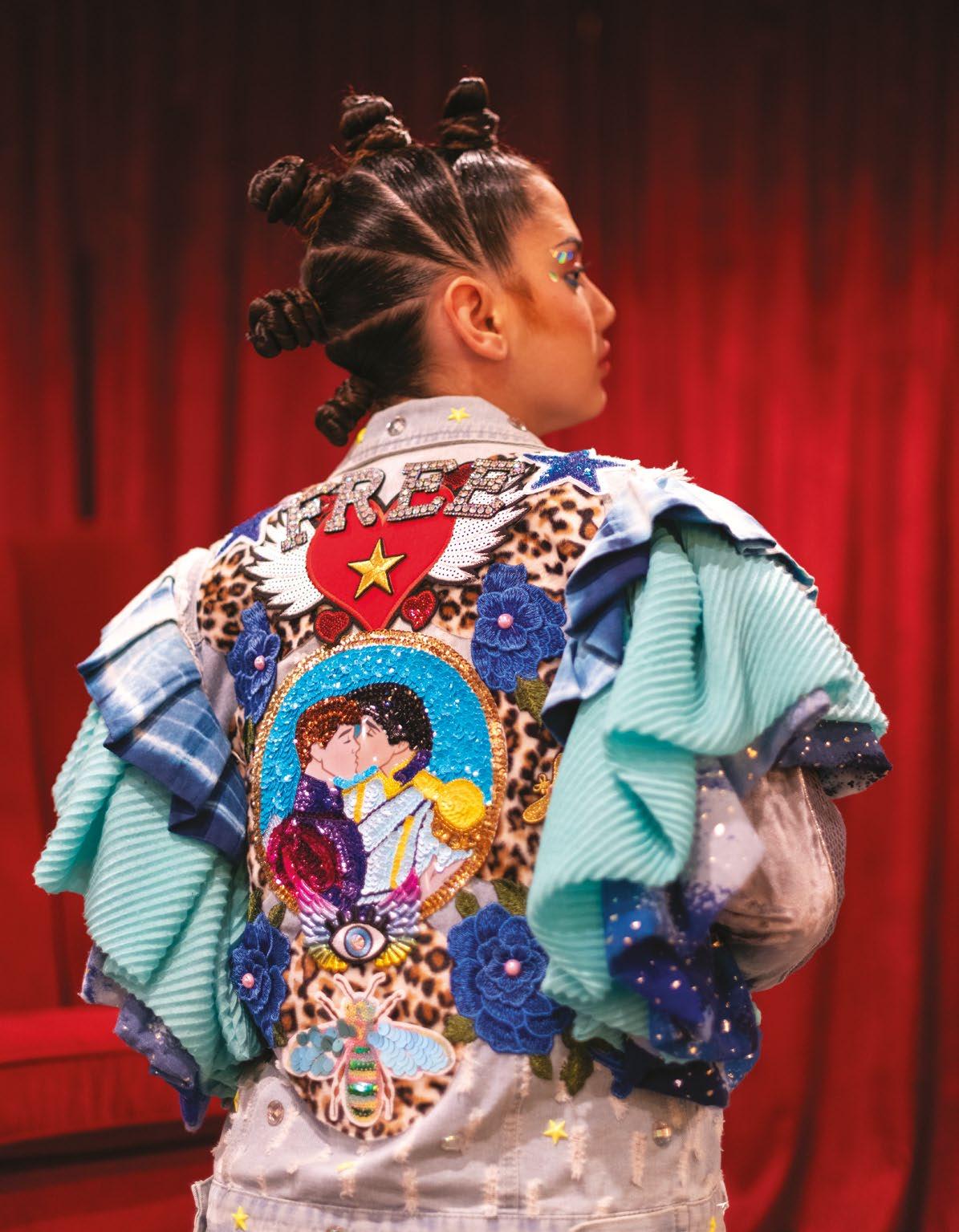 MALENA: Chaqueta de QUEEN MOROCCO IBIZA.
MALENA: Chaqueta de QUEEN MOROCCO IBIZA.

Dirección y producción: Isabel Lambour. Dirección artística y estilismo: Nica Seleva. Ayudante de producción: Natalia Braojos. Maquillaje: Raquel Gonzaga. Peluquería: Laia Llordés y Melina García.
Fotografía: Arsen Voronyy en Paradiso Ibiza Art Hotel. Dara Nemethova en Can Castelló, Es Currals Alpacas Ibiza y espacio María Valdivia.
Modelos: Kira Olivera, Joaquín Fernández, Malena Díaz, Puchi Lhaba Tsering, Kenam Rial, Eva Rodríguez, Alba Pascual, Dayuma Luna, Annie Windelschmidt, Fátima Iris Ávalos, Itzíar
Díaz Natural-Mente, María Valdivia, Kusiy Millaray Volt, Selva Suyai Fortuna, Anna Forgas, Leo Bianchi, Martina Anzel, Luis Delignat y Percy Palomino.
Agradecimientos: A los responsables de los espacios donde hemos realizado este editorial de moda.
A las y los modelos participantes que han brindado su tiempo, cariño y entusiasmo. En especial a Kira Olivera por su implicación y entrega.
Todo el equipo de producción de este editorial forma parte de la familia de Las Dalias.



“Disfrutar cada momento es una forma de amar la vida”
David Steindl-Rast

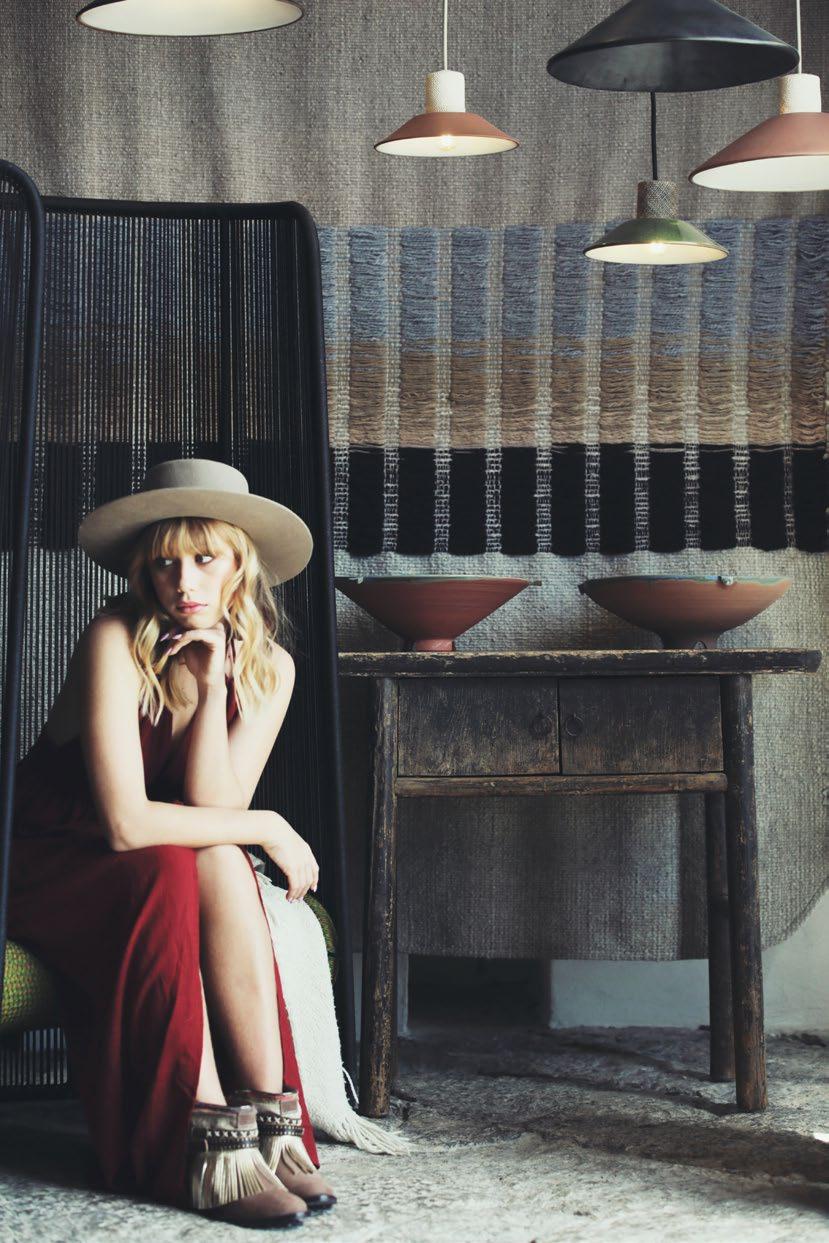

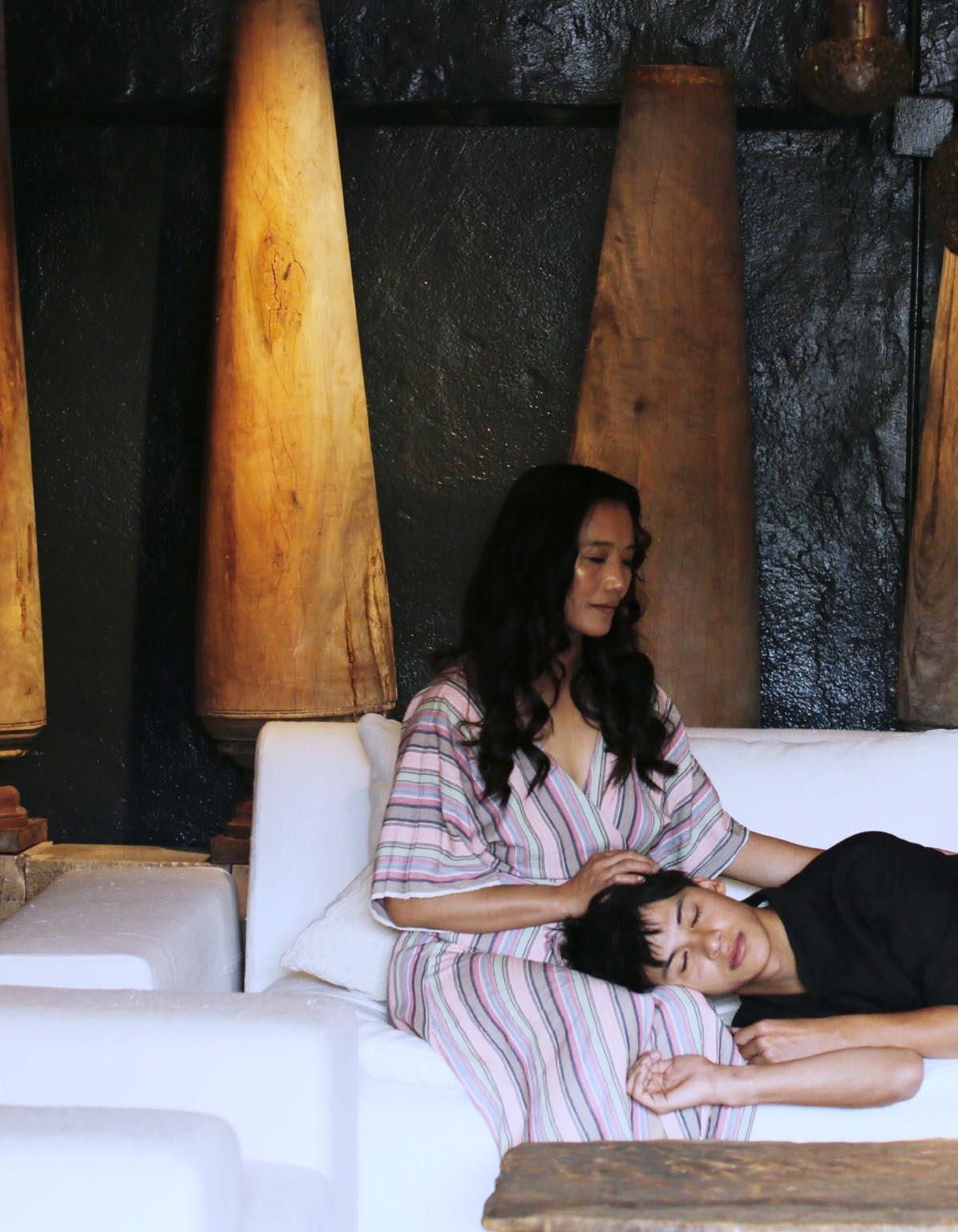 PUCHI: Kimono de LIVE LOVE IBIZA KENAM: Camisa y pantalón de SON FINESTRA
PUCHI: Kimono de LIVE LOVE IBIZA KENAM: Camisa y pantalón de SON FINESTRA

“Amar a alguien no es solo un sentimiento poderoso. Es una decisión, una promesa, un compromiso”Bell Heoks
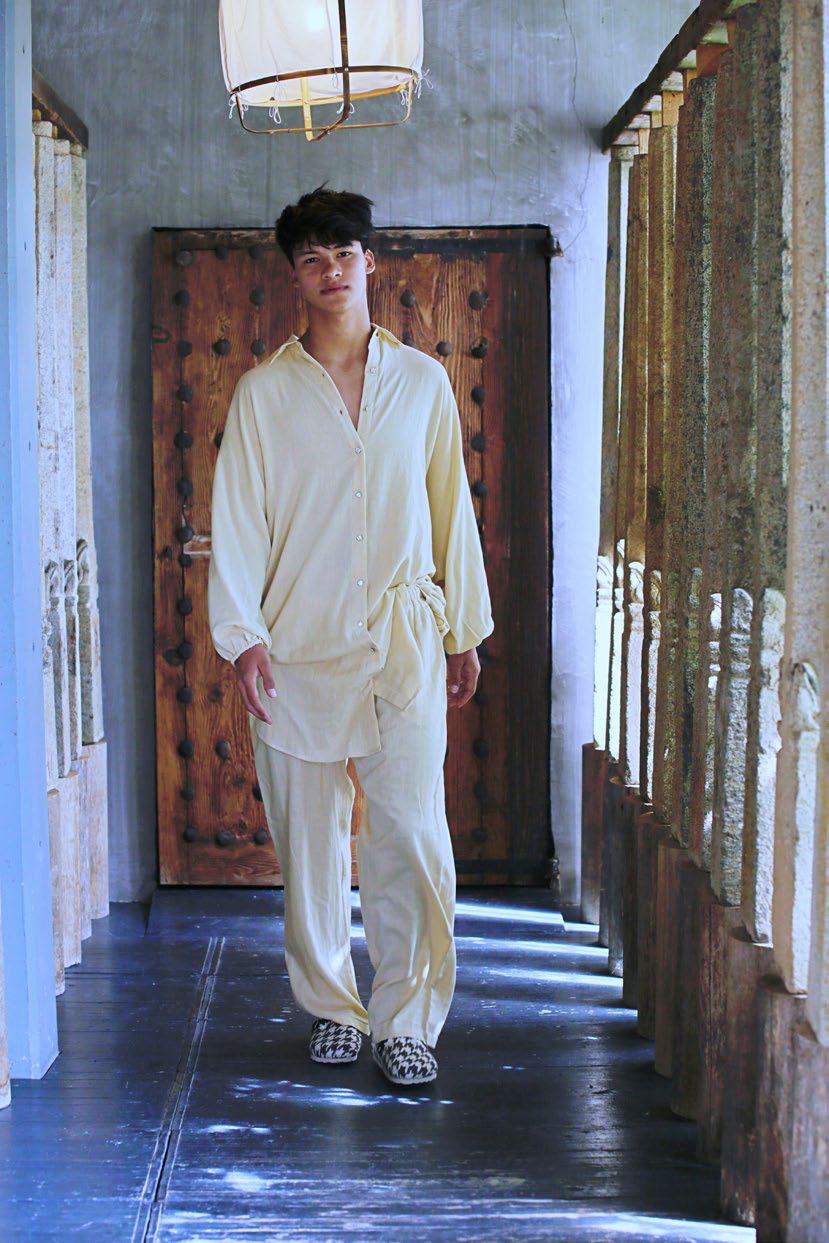

“La música es el latido del corazón del universo” Lao Tzu
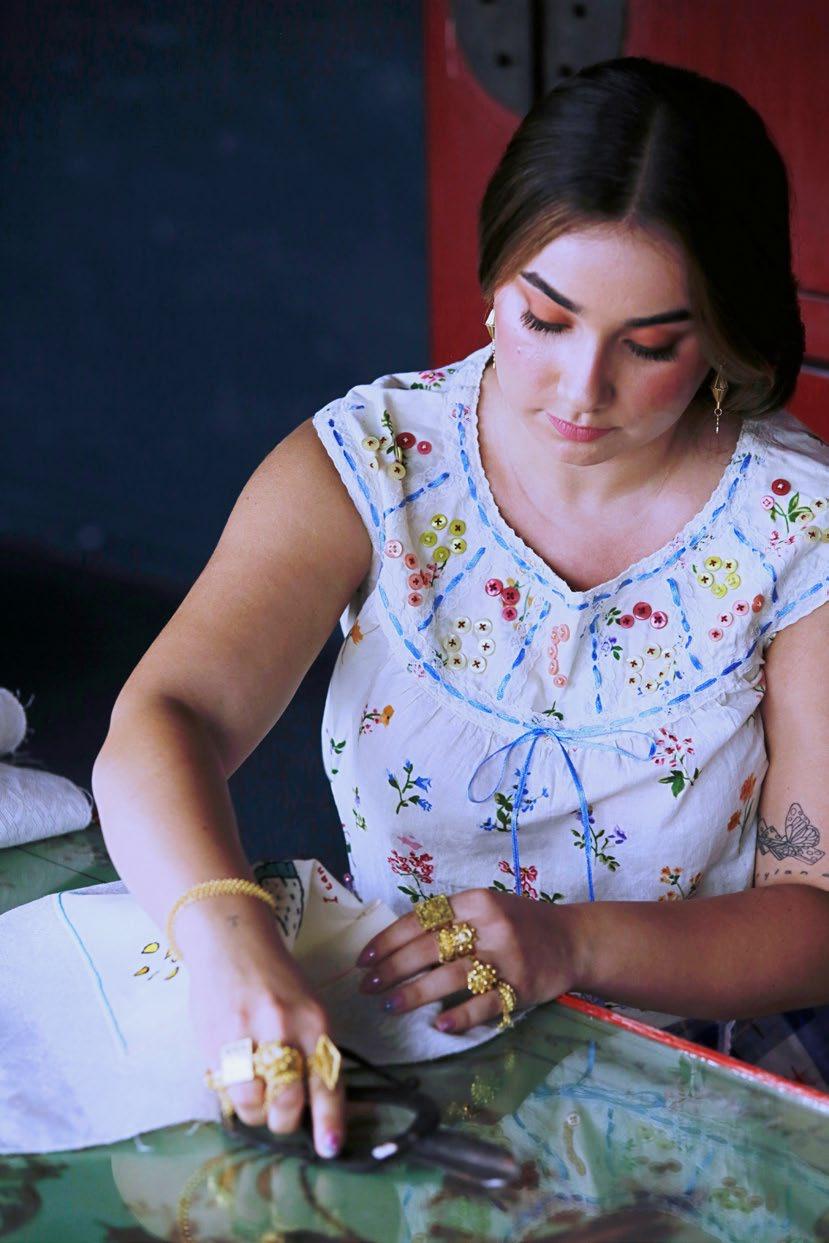
“El amor por la costura reside en la atención a los detalles más pequeños”
Gabriel García Márquez

 KIRA: Gorro y vestido de BELINDA
KIRA: Gorro y vestido de BELINDA

“El amor por todos los seres vivos es el más noble atributo”Charles Darwin

“Descubrir, sorprenderse gratamente, llena nuestras almas de alegría” Anónima
“No existe el amor. Existen pruebas de amor” Pierre Reverdy

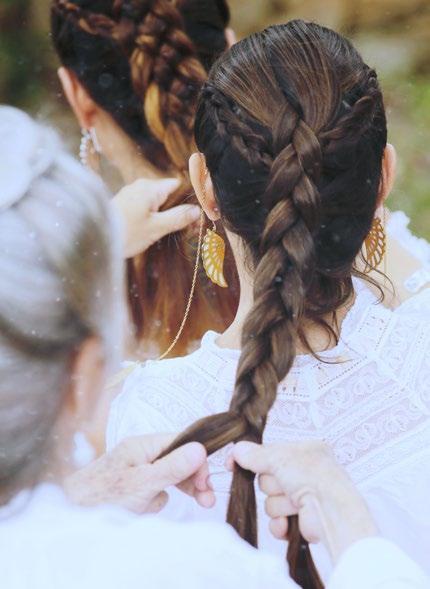
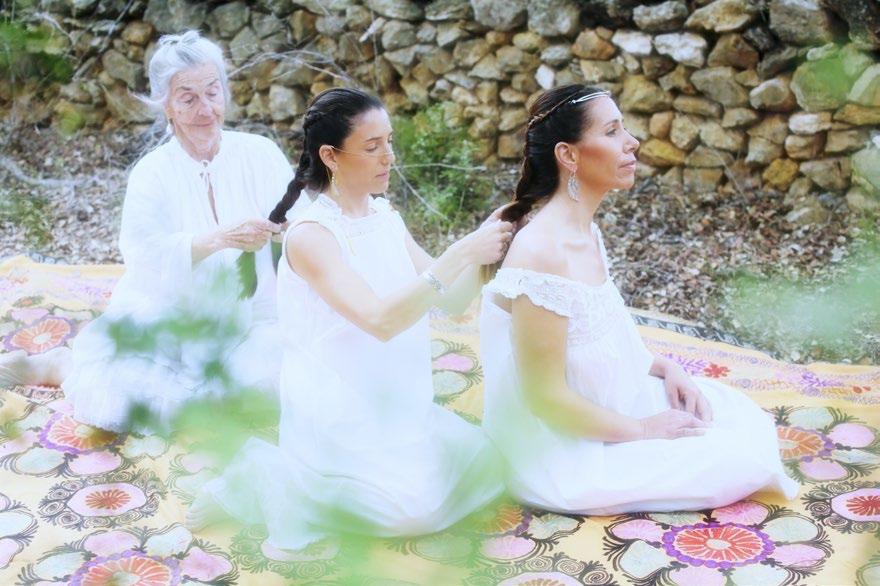
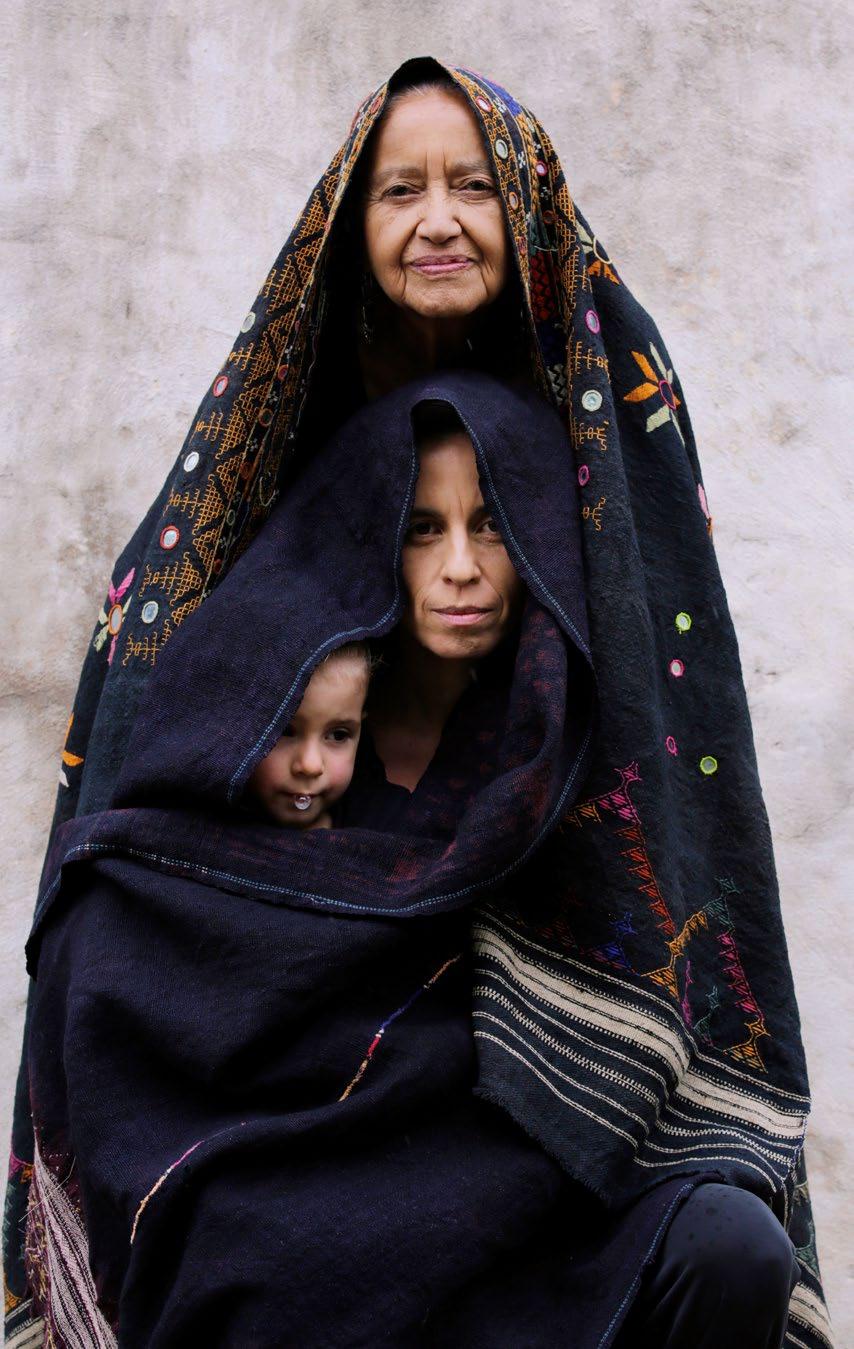
“El amor no es repetición. Cada acto de amor es un ciclo en sí mismo, una órbita cerrada en su propio ritual. Es, cómo podría explicarte, un puño de vida”
Mario Benedetti“La curación es un acto comunitario”

y
MARTU: Vestido de SACRED IBIZA y pulsera de ONIRIK JEWELRY LUIS: Conjunto de INUI WORLD TRIBE y sahumo de SAHUMO IBIZA. PERCY: Poncho y pantalón NAYWAJ, vestido INUI WORLD TRIBE y collar de PERCY PALOMINO

AURA GOLD: “I WAS FASCINATED TO LEARN ABOUT HOW LAS DALIAS STARTED. JUAN MARÍ JUAN WAS A VISIONARY”.
Fundadora, ilustradora y directora de Arte de Make Me A Comic, Aura Gold ha estado trabajando durante años en un gran proyecto junto a Rodrigo Cardama: contar la historia ilustrada de la isla en una trilogía con el título We Love Ibiza. El primer volumen lleva el título The Golden Oldie Years (Los Años Dorados) y abarca hasta 1986 con más de 150 páginas. Para este trabajo ha investigado extensamente la historia de la isla, centrándose especialmente en Las Dalias. Fascinada por su legado, ha creado un cómic especial para su 70 aniversario. A través de entrevistas, testimonios directos y muchas fotografías, ha recreado la historia del bar, el restaurante y el mercado más famoso de la isla.
Founder, illustrator and art director of Make Me A Comic, Aura Gold has been working for years on a big project together with Rodrigo Cardama: to tell the illustrated history of the island in a trilogy entitled We Love Ibiza. The first volume is called The Golden Oldie Years and it goes up to 1986 in more than 150 pages. Aura extensively researched the history of the island for this work, focusing especially on Las Dalias. Fascinated by its legacy, she’s also created a special comic for its 70th anniversary. By means of interviews, eye-witness accounts and a large number of photographs, she’s recreated the history of the island’s most famous bar, restaurant and market.


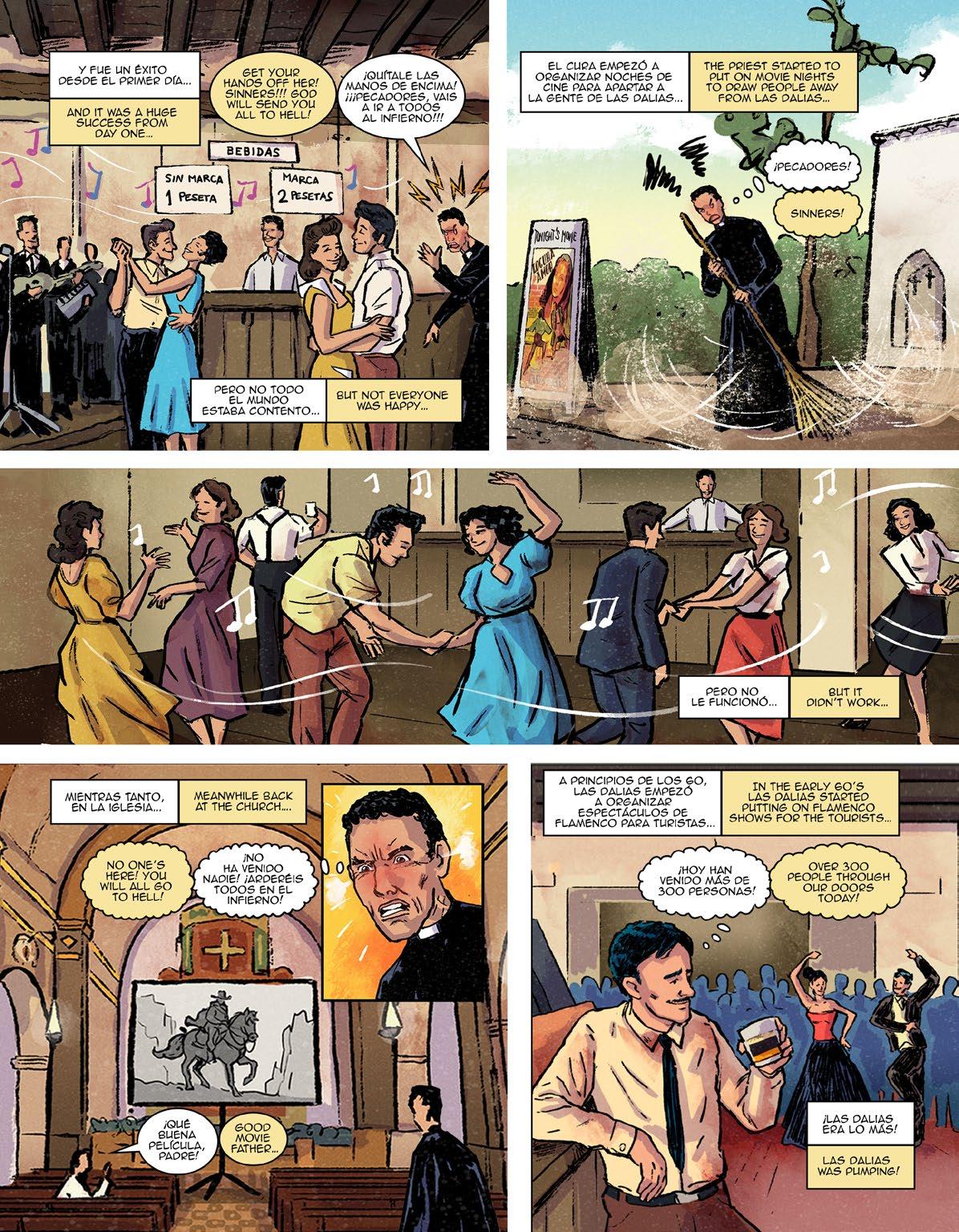
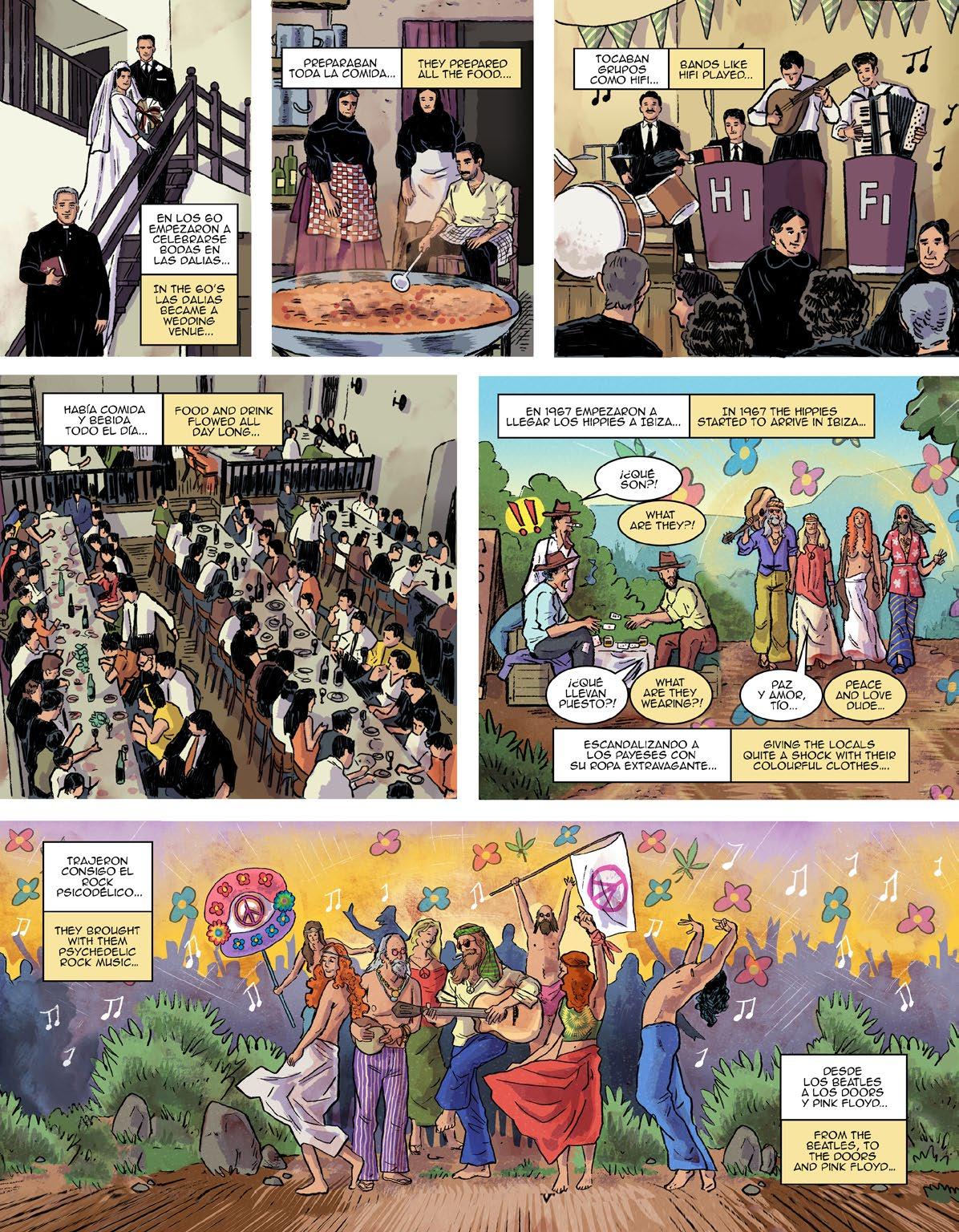
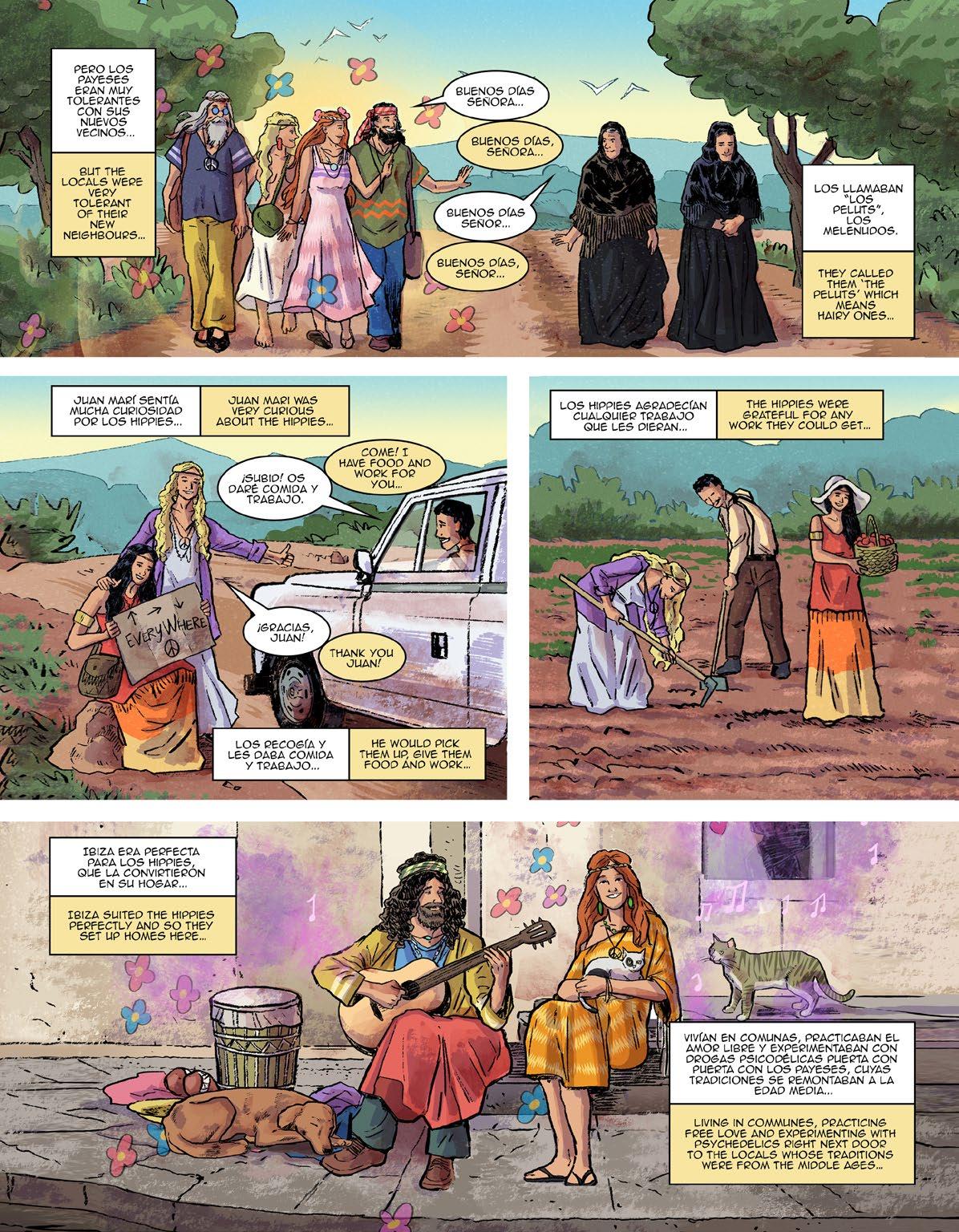







—¿Cuándo comenzó el proyecto de crear un cómic con la historia de Ibiza?
—Me mudé a Ibiza hace aproximadamente cuatro años e inmediatamente comencé a escuchar historias increíbles de la isla que me provocaron muchísima curiosidad. En este tiempo he hablado, sin exagerar, con 200 personas para documentarme para crear el cómic de Ibiza. Gente interesante, comprometida, con ganas de explicar su historia y la de Ibiza.
—Además ha creado un cómic especial por el 70º aniversario de Las Dalias. ¿Ha sido un reto transformar esas siete décadas en una historia gráfica?
—El verdadero reto estaba en ilustrar las antiguas historias de las que no hay fotografías o muy pocas. Las fotos actuales son realmente buenas pero lo cierto es que hay pocas imágenes de los comienzos, incluso hasta principios de los años 2000 escasean las fotos. De modo que hay que usar la imaginación, buscar en Internet, documentarse, encontrar testimonios directos…
—Los testimonios personales, ¿han sido muy importantes en el proceso?
—Juanito fue una de las primeras personas con las que hablé cuando comencé a crear el cómic We Love Ibiza y realmente sabe muchísimas historias de la isla. Me dio todas las revistas de Las Dalias y las leí de principio a fin, tomando notas... He hablado también con Helga Watson-Todd, Dutch Anna, Manu Díaz, Yaron Marko, Jean Michel Fueter, la familia Blakstad, Dennis Hermann, que era el ingeniero de sonido de Estudios Mediterráneo… no se pueden citar a todos porque son muchísimos.
—¿Y qué historias le han sorprendido más?
—Muchas. He encontrado historias maravillosas en este trabajo de investigación como el hecho de que la cantante y actriz danesa Nina Van Pallandt —muy famosa en su época y ex pareja del polémico Clifford Irving— se implicó en la creación de los musicales que se representaron en Las Dalias. Todo un personaje. O que hubo un circo en Ibiza en el que estuvieron involucrados Terry Thomas, Nigel Davenport o Rolph Blakstad… ¡pero esa es otra historia! O que Terry Thomas tenía un Mercedes descapotable muy chic y que lo pintó de colores usando mitades de patatas. Historias divertidísimas. Estoy notando que cuando te vas ganando la confianza de la gentey se dan cuenta de que este proyecto va en serio, se abren más y te cuentan más cosas.
—Y ¿qué es lo que más le ha sorprendido de la historia de Las Dalias?
—Los inicios, sin duda. El padre de Juanito, Juan Marí Juan, un campesino de Sant Carles, tenía un sueño y lo logró. Era un visionario; un hombre que supo crear, en el medio de la nada, donde no había ni carretera sino un camino de tierra, un bar que lo cambió todo. No había un montón de dinero detrás sino trabajo e ideas. Pidió un préstamo a un amigo y lo levantó todo con sus propias manos… Eso me ha encantado saberlo e ilustrarlo.
- When did the project to create a comic book with the history of Ibiza begin?
- I moved to Ibiza about four years ago and immediately started hearing incredible stories about the island that made me very curious. During this time I’ve spoken to 200 people, and that’s no exaggeration, to get material for the Ibiza comic. Interesting, committed people who are keen to tell their story and that of Ibiza.
- You’ve also created a special comic for the 70th anniversary of Las Dalias. Has it been a challenge to transform those seven decades into a graphic history?
- The real challenge was to illustrate the old stories for which there are few or no photographs. The modern photos are great but there are actually very few images from the early days, and even up to the early 2000s there aren’t many. So you have to use your imagination, search the internet, do some investigating, find people who were actually there...
- So have personal accounts been very important in the process?
- Juanito was one of the first people I spoke to when I started creating the We Love Ibiza comic and he really knows a lot of stories about the island. He gave me all the Las Dalias magazines and I read them cover to cover, taking notes.... I’ve also spoken to Helga WatsonTodd, Dutch Anna, Manu Díaz, Yaron Marko, Jean Michel Fueter, the Blakstad family, Dennis Hermann, who was the sound engineer at Estudios Mediterráneo... I can’t mention them all by name because there are so many of them.
- And which stories surprised you the most?
- A lot. I’ve come across some wonderful stories during my research, such as the fact that the Danish singer and actress Nina Van Palland, who was very famous at the time and the former partner of the controversial Clifford Irving, was involved in creating the musicals that were performed at Las Dalias. Quite a character. And the fact that there was a circus in Ibiza in which Terry Thomas, Nigel Davenport and Rolph Blakstad were involved... but that’s another story! And that Terry Thomas had a very chic Mercedes convertible which he covered in different colours using potato halves. Hilarious stories. I’ve noticed that, as you gain people’s trust and they realise you’re serious about this project, they open up and tell you more.
- And what surprised you most about the history of Las Dalias?
- The beginnings, without a doubt. Juanito’s father, Juan Marí Juan, a farmer from Sant Carles, had a dream and he achieved it. He was a visionary; a man who knew how to create, in the middle of nowhere, where there wasn’t even a road but just a dirt track, a bar that changed everything. There wasn’t a lot of money behind it - just hard work and ideas. He borrowed money from a friend and built it all with his own hands... It was fantastic to find all that out and illustrate it.



—Y ahora que conoce tan bien la historia de Las Dalias, ¿cuál cree que es la razón de su éxito?
—Que conecta a la gente desde sus inicios. En 1954 la gente local prácticamente solo socializaba cuando iba a la iglesia. Cuando abre Las Dalias lo cambia todo en esta zona de la isla, donde no había nada parecido. Se convierte en un punto de encuentro donde suena música moderna, pasan cosas… La gente del pueblo tiene un lugar para divertirse fuera de lo convencional para la época, en pleno Franquismo y en una isla que era bastante pobre.
Y eso se mantiene, porque hoy en día te encuentras a gente de todas partes del mundo y sigue siendo un punto de conexión para toda clase de gente.
—¿Cuándo se publicará el cómic completo?
—La previsión es que salga en septiembre de este año 2024. Estoy muy agradecida con Juanito por contar con nosotros para ilustrar la historia de Las Dalias para la revista, que nos ayudará a darnos a conocer más.
—¿Y qué espera de la acogida entre las lectoras y los lectores?
—Eso me pone un poco nerviosa [ríe] ¡Ojalá les guste! Me gustaría matizar que el cómic no es un documento histórico y verídico al cien por cien porque me he tomado algunas licencias artísticas, he querido poner humor y me he centrado en todo lo positivo, excluyendo la parte más oscura o temas políticos… He querido hacer algo ameno, despreocupado, positivo… quiero que la gente lea, ría, sonría, lo disfrute.


- And now that you know the history of Las Dalias so well, what do you think is the reason for its success?
- The fact that it’s connected people right from the start. In 1954, essentially the locals only socialised when they went to church. When Las Dalias opened it changed everything in this part of the island, where there was nothing like it. It became a meeting place where modern music was played, where things happened... The people of the village had a place where they could have fun and that was unconventional for the time, in the middle of Franco’s regime and on an island that was quite poor. And that’s still the case now, because you meet people from all over the world and it’s still a place for all kinds of people to connect.
- When will the full comic be published?
- It’s expected to be released in September 2024. I’m very grateful to Juanito for asking us to create the illustrated history of Las Dalias for the magazine, which will help us to become better known.
- And how do you expect readers to react?
- I’m a bit nervous about that [she laughs] I hope they like it! I’d like to remind people that the comic isn’t a 100% historical and truthful document because I’ve taken some artistic licence, I’ve tried to add some humour and I’ve focused on everything that’s positive, excluding the darker side or political issues... My aim was to create something pleasant, carefree, positive... I want people to read, laugh, smile and enjoy it.

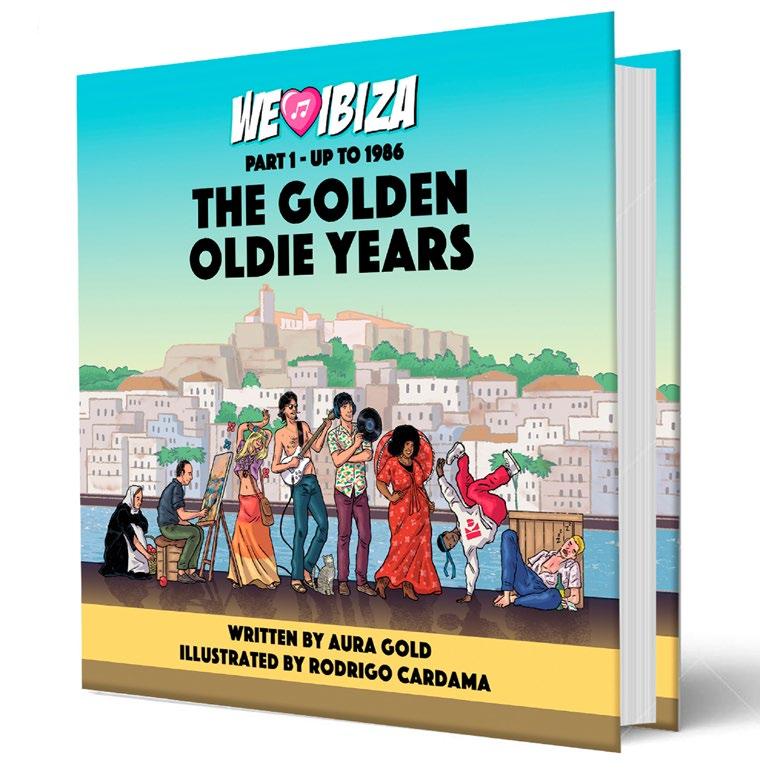

Cumplir el 70º aniversario de Las Dalias tiene algo de milagro. Que una empresa llegue a las siete décadas implica mucho trabajo, amor, un poco de suerte, algunos fracasos y no pocos éxitos. Pero el motor que puso en marcha esa maquinaria fue un sueño. Porque Las Dalias y todo lo que representa hoy en día se remonta a un pequeño sueño que tuvo nuestro padre, Juan Marí Juan, en 1954.
Era un agricultor, pagès y carpintero que tenía un deseo: abrir un pequeño bar para animar la vida social de Sant Carles. Así que Juan Marí Juan compró un solar de 2.000 metros cuadrados por el que pagó 10.000 pesetas (60 euros), un dinero que le prestó Joan d’en Morna y que entonces era una cantidad muy grande. En ese pequeño solar no había nada más que un gran algarrobo y una pared, pero allí, con mucho trabajo y las piedras del Puig Ferrer y de s’Argentera —arrancadas con dinamita y acarreadas con carros—, levantó Las Dalias con sus propias manos.
There is something miraculous about celebrating the 70th anniversary of Las Dalias. It takes a lot of hard work, loads of love, a bit of luck, a few failures and more than a few wins for a company to make it to seven decades. But the driving force that set this machinery in motion was a dream. Because Las Dalias and everything it stands for today can be traced back to a little dream of our father, Juan Marí Juan, in 1954.
He was a farmer, a peasant and a carpenter who aspired to open a small bar to brighten up the social life of Sant Carles. So, that year, Juan Marí Juan bought a 2,000-square-metre plot of land for the price of 10,000 pesetas (60 euros). To pay for it, he borrowed the money from Joan d’en Morna. Back then, it was a lot of money. That small piece of land had nothing but a large carob tree and a wall. Yet, with loads of hard work and stones from Puig Ferrer and S’Argentera that were blasted out with dynamite and hauled over in carts, he built Las Dalias with his own two hands. THIS IS OUR STORY
 Joan Marí, Francisca Juan y Lucía Marí.
Joan Marí, Francisca Juan y Lucía Marí.
El día de la inauguración no faltó nadie: el bar se llenó e hizo una caja de 4.400 pesetas. Una fortuna para la época. Las primeras fiestas las amenizaron Los Basurons, Los tres de la isla y el Dúo San Carlos. Desde entonces hasta hoy no ha parado de sonar la música.

¿Cómo imaginar ahora la Ibiza de 1954, cuando los bailes agarrados estaban prohibidos y no había luz eléctrica?
¿Una Ibiza en la que el cura se enfadaba con mi padre por permitir esas ‘obscenidades’ y la luz se ‘fabricaba’ con un motor a gasolina que apenas duraba el ratito del baile? En 1954 Ibiza estaba todavía muy lejos de la isla turística que ahora conocemos. Hay que pensar que faltaban cuatro años para que se inaugurase el aeropuerto.
Sin embargo, ya comenzaban a respirarse en Sant Carles aires de modernidad y la sala de fiestas se hizo muy popular. Los chicos esperaban con expectación los bailes de los domingos para cortejar a las chicas, que acudían castamente acompañadas por sus madres. La pasión desatada del festeig —el galanteo, a menudo muy violento y salvaje cuando implicaba disputas con otros pretendientes de la misma joven— y ‘escándalo’ de los bailes agarrados en plena posguerra eran muy mal vistos por el cura del pueblo, que contraprogramaba a Las Dalias con sesiones de cine. Pero los bailes ganaban por goleada a las películas, lo que irritaba mucho más al párroco. Ese mismo cura ofició muchas bodas que se celebraban posteriormente con un convite en Las Dalias.
On the day of its opening, everyone was there: the bar was full and grossed a total of 4,400 pesetas. Quite a fortune in those days! The first events at the bar featured the entertainment of Los Basurons, Los tres de la Isla and Dúo San Carlos. And the music has continued to play ever since.
Can you imagine the Ibiza of 1954, when slow dancing was forbidden and there was no electricity? An Ibiza where the priest would get angry with my father for allowing such ‘obscenities’ and where electricity was ‘manufactured’ by a petrol-run engine that barely lasted the duration of the dance? In 1954, Ibiza was still a long way from the tourist island that we know today. After all, the island would still have to wait four years for the airport to be inaugurated.
“EL DÍA DE LA INAUGURACIÓN NO FALTÓ NADIE: EL BAR SE LLENÓ
E HIZO UNA CAJA DE 4.400 PESETAS”
But the winds of a modern age were already beginning to blow through Sant Carles, and the nightclub became very popular. The young men looked forward to the Sunday dances, where they could woo the girls, who would come chastely escorted by their mothers. The unleashed passion of the festeig, or courtship, which could often get really violent and wild when it involved disputes among suitors over the same girl, and the ‘outrageousness’ of slow dancing in post-war Spain, were frowned upon by the village priest, who would counter the Las Dalias events by offering cinema sessions. But the attendance at the dances outnumbered that of the film sessions by landslides, irritating the parish priest even more. That same priest would end up officiating many weddings that were later celebrated with receptions at Las Dalias.
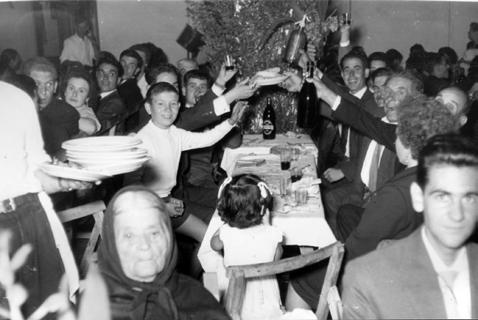
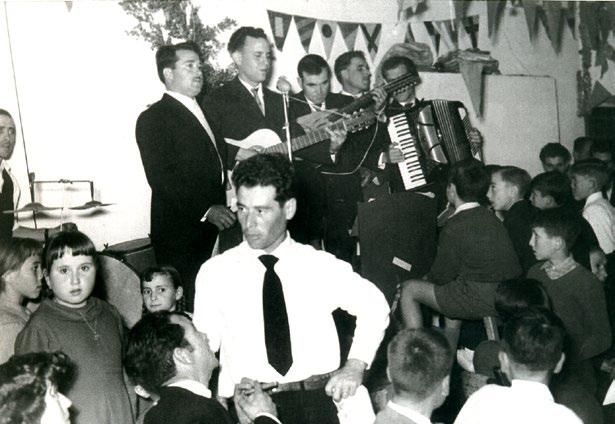





El menú de las nupcias era sobrio pero abundante: paella de primero y bullit de carn de segundo —este último era el típico plato de las celebraciones festivas en Ibiza, aunque más tarde se popularizó el sofrit pagès—. Se preparaba con los corderos y los gallos que las familias de los novios llevaban ese día y sacrificaban allí mismo.
Años más tarde abrió el restaurante, ubicado en lo que antiguamente era el almacén donde mi padre guardaba el caballo, las patatas y el vino.
“MI PADRE
QUE LOS ‘PELUTS’ SE BUSCABAN LA VIDA
The wedding menu was subdued but plentiful: paella as the first course and bullit de carn as the main course (this boiled meat and vegetable dish was typically served at celebrations in Ibiza, though a sauté-based sofrit pagès would later become popular). It was made from the lambs and roosters that the families of the bride and groom brought on the day of the wedding and which they slaughtered right there, on the spot.
Era un ambiente de pueblo y muy familiar pero pronto sucedió algo que lo cambió todo: En los años 60 llegaron a Ibiza los primeros hippies, muchos de ellos pacifistas que escapaban de ser reclutados en la Guerra de Vietnam. Arribaban a la isla en barco y buscando un mundo alejado de problemas, guerras y conflictos. Mi padre siempre contaba que los peluts [que aludía a los cabellos largos de los hippies, es decir, ‘peludos’] se buscaban la vida como podían y no pocas veces él mismo les dio trabajo.
Mientras en Woodstock se celebraba el famoso festival, en Ibiza se rodaba More, de Barbet Schroeder, una película de culto que mostraba Ibiza como un lugar de hedonismo y libertad y que tuvo un gran poder de atracción entre la juventud europea más alternativa del momento.


Years later, the restaurant was opened in what used to be the storehouse where my father kept the horse, the potatoes and the wine.
The atmosphere was small-town and very familiar, but soon something occurred that would change everything. In the 1960s, Ibiza received its first hippies, many of them pacifists who were avoiding the draft to fight in the Vietnam War. They came to the island by boat, in search of a world far removed from troubles, war and conflict. My father always said that the peluts [literally “long hairs”, alluding to the hippies’ long hair] made ends meet as best they could, and that he himself often gave them work.


Hippy all year long from 10 h

Los hippies llegaron también a Las Dalias, donde payeses, peluts y turistas comenzaron a convivir en aquellos años. Sin embargo, los hippies no fueron siempre bienvenidos y eso no se puede obviar. Se reunían en el porche de la iglesia de Sant Carles y el cura colgó allí un cartel que permaneció décadas: ”Prohibido cantar, comer y dormir bajo estos porches”. Pero habían llegado para quedarse. Su lugar favorito era Ca n’Anneta, muy cerca de la iglesia y de Las Dalias. Este peculiar bar era y es actualmente también oficina de Correos, de modo que allí recibían las cartas y el dinero que les enviaban sus padres.
While the epic Woodstock music festival was happening in New York state, More by Barbet Schroeder was being filmed in Ibiza. This cult classic portrayed Ibiza as a place of hedonism and freedom, arousing immense interest amongst the most alternative European youths of the time.
“THE HIPPIES ALSO FOUND THEIR WAY TO LAS DALIAS, WHERE PEASANT FARMERS, PELUTS AND TOURISTS BEGAN TO COEXIST IN THOSE YEARS”
The hippies also found their way to Las Dalias, where peasant farmers, peluts and tourists began to coexist in those years. Yet it can’t be ignored that the hippies weren’t always welcome. They used to gather beneath the porch of the church of Sant Carles, and the priest hung a sign there that would last for decades: “ No singing, eating or sleeping under this porch”. But they had come to stay. Their favourite place was Ca n’Anneta, which is very close to both the church and Las Dalias. This unusual bar was, and still is, a post office, where the hippies would receive the letters and money sent to them by their parents.
“EN LOS AÑOS 70 LA ISLA VIVIÓ UN BOOM TURÍSTICO. COMENZARON A LLEGAR ALEMANES, BRITÁNICOS, FRANCESES, ESCANDINAVOS…
MI PADRE TUVO ENTONCES LA IDEA BRILLANTE DE ORGANIZAR UNAS BARBECUES EN EL JARDÍN”
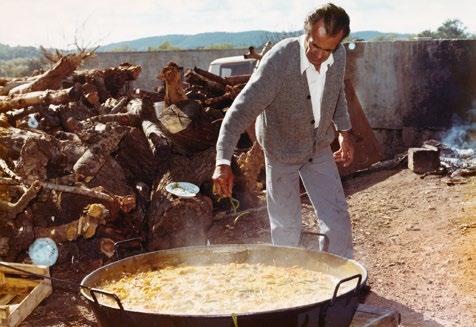
En los años 70 la isla vivió un boom turístico. Comenzaron a llegar alemanes, británicos, franceses, escandinavos… Mi padre tuvo entonces la idea brillante de organizar unas barbecues en el jardín, con un menú cerrado de 150 pesetas por persona. Venían autobuses llenos de británicos encantados con la oferta típicamente española de paella, sangría y flamenco.
The island underwent a tourism boom in the 1970s, with the arrival of Germans, British, French, Scandinavians and others. At that time, my father came up with the idea of holding barbecues in the garden, a set menu costing 150 pesetas per person. Busloads of British tourists would show up, delighted with the typical Spanish combination of paella, sangria and flamenco music.



Aceites corporales besables Kissable Body Oils
• CHOCOLATE Chocolate

ml

• MARACUYÁ Passion Fruit
Aceite corporal antiedad Anti-aging Body Oil


• FRUTOS ROJOS Red Fruits
Aceite Corporal (Extracto
Body Oil with CBD (Cannabis Extract)



Crema Hidratante Nutritiva Nourishing Moisturizing Cream
Exfoliante Facial Facial Exfoliant

Serum Facial Reparador Repairing Facial Serum
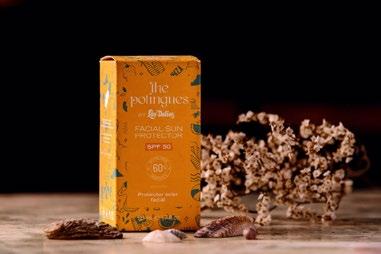

Protector Solar Facial Facial Sun Protector
Bálsamo Hidratante Post Afeitado Post Shave Moisturizing Balm

Las Dalias tuvo que reinventarse en los años 80. Hicimos algunos experimentos, que no salieron del todo bien, pero también hubo grandes aciertos. Uno fue poner en marcha la galería de arte junto a Helga Watson-Todd, que ya tenía un espacio de exposiciones, El Mensajero, en Santa Eulària. Aunque no fue un éxito económico y duró poco tiempo, creó una relación entre Las Dalias y el arte que ya nunca más se ha roto y que hemos potenciado posteriormente con actividades como LiberArte o el Jardín Artístico.

“LAS DALIAS TUVO QUE REINVENTARSE EN LOS AÑOS 80. HICIMOS ALGUNOS EXPERIMENTOS, QUE NO SALIERON BIEN, PERO TAMBIÉN HUBO GRANDES ACIERTOS”
El otro acierto fue establecer una relación muy cercana con los ya desaparecidos Estudios Mediterráneo. Era un local de grabación por el que pasaron algunos de los grupos nacionales e internacionales más famosos del momento: Judas Priest, Los Abuelos de la Nada, Obús, Sangre Azul, Medina Azahara, Barricada, La Frontera, Los Elegantes, Ángeles del Infierno, Panzer, Ñu, Santa, Banzai, Los Twist, Gato Pérez, La Torre, Frankie Goes to Hollywood, Moris… La lista es interminable porque nadie se quería perder la oportunidad de grabar en Ibiza. Tras muchos días de intenso trabajo en el estudio venían a Las Dalias a tocar ante el público, a disfrutar y a desfogarse. Fueron unos años maravillosos donde la alianza entre Las Dalias y la música que ya había establecido mi padre terminó por consolidarse hasta nuestros días. ¡Hasta organizamos musicales junto a la inolvidable Nina van Pallandt!
Las Dalias was forced to reinvent itself In the 80s. We tried out a few things that didn’t quite work, but we also made some wise decisions. One was to launch the art gallery with Helga Watson-Todd, who already had an exhibition space, El Mensajero, in Santa Eulària. Though it wasn’t economically successful and lasted only a short time, it established a relationship between Las Dalias and art that has remained intact and that we later strengthened and extended, with activities like LiberArte and the Art Garden.
“A MAJOR WIN WAS THE CLOSE RELATIONSHIP THAT WE BUILT WITH THE NOW-DEFUNCT ESTUDIOS MEDITERRÁNEO, A RECORDING STUDIO FREQUENTED
BY SOME OF THE BIGGEST SPANISH AND INTERNATIONAL BANDS OF THE TIME”
The other major win was the close relationship that we built with the now-defunct Estudios Mediterráneo, a recording studio frequented by some of the biggest Spanish and international bands of the time: Judas Priest, Los Abuelos de la Nada, Obús, Sangre Azul, Medina Azahara, Barricada, La Frontera, Los Elegantes, Ángeles del Infierno, Panzer, Ñu, Santa Banzai, Los Twist, Gato Pérez, La Torre, Frankie Goes to Hollywood, Moris…. The list is endless, as no-one wanted to miss out on the opportunity to make a record in Ibiza. After many days of intense work in the studio, they’d come over to Las Dalias to play their music for the audience, have fun and let off some steam. Those were wonderful years, where the connection between Las Dalias and music, which my father had established, really took root, right up to the present day. We even put on musicals with the unforgettable Nina van Pallandt!
And the third and most crucial success (yet nobody imagined it at the time) was the opening of a hippy flea market. It was Helga Watson-Todd’s idea. The family were not entirely sure about it, because it would mean filling Las Dalias with peluts, but Helga and I managed to convince them that it was a good idea. We started with five stalls on February 14, 1985, Valentine’s Day... so you might say that the power of love has always been behind this idea.
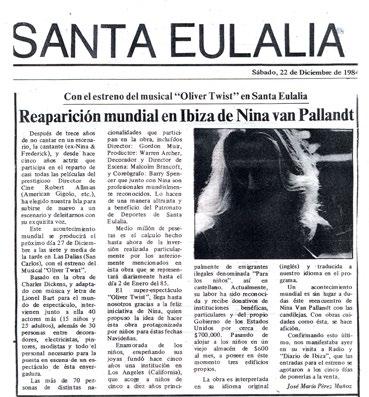
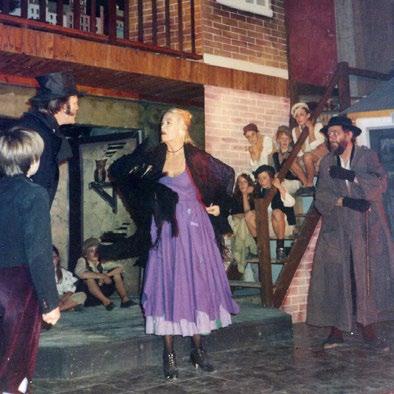


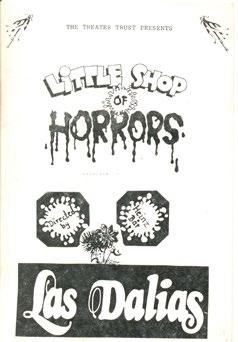






 Las Dalias ha acogido musicales, arte y actuaciones en directo desde sus orígenes. Obús, Mariskal Romero y Joan Marí.
Leonor Marchesi
Barricada
Juanito Marí y Helga Watson Todd en la galería de arte de Las Dalias en los años 80.
Las Dalias ha acogido musicales, arte y actuaciones en directo desde sus orígenes. Obús, Mariskal Romero y Joan Marí.
Leonor Marchesi
Barricada
Juanito Marí y Helga Watson Todd en la galería de arte de Las Dalias en los años 80.
Y el tercer acierto y el más importante (aunque entonces nadie lo imaginaba) fue abrir un mercadillo hippy. La idea fue de Helga Watson-Todd. La familia no lo tenía del todo claro, porque eso supondría llenar Las Dalias de peluts, pero Helga y yo conseguimos convencerles de que era una buena idea y comenzamos con cinco puestos. Fue un 14 de febrero de 1985, día de San Valentín… así que podemos decir que el poder del amor ha estado siempre detrás de esta idea.

Los primeros años fueron muy tranquilos, pero enseguida llegó el primer boom del mercadillo y tuvimos que ampliarlo, colocando puestos donde antes estaba el huerto y los corrales de los cerdos y las gallinas de mi padre.
Nadie esperaba entonces que el mercadillo se fuese a convertir en el eje central de la empresa, pero así ha sido. No es fácil encontrar las razones exactas de ese éxito pero, echando la vista atrás, veo mucho trabajo, un espíritu inimitable y el amor que hemos puesto en el proyecto mi familia y la gran familia de Las Dalias, que la conforman artesanos, mercadilleros y todo el personal del backstage, desde las oficinas de administración al equipo restauración y de comunicación.
Las Dalias ha conseguido ofrecer al visitante una combinación única de sensaciones a través de la música, los colores, los sabores y los aromas. Una fusión inigualable que han aportado las personas de más de 80 nacionalidades que ha reunido el mercadillo a través de su historia.
The early years were very quiet, but then the flea market experienced its first boom and we had to expand it, setting up stalls where my father’s vegetable garden, pig pen and chicken coop used to be.
Back then, no-one expected the flea market to become the company’s core activity, but it has. It isn’t easy to pinpoint the precise reasons behind that success, but, looking back, I see a lot of hard work, an incomparable spirit and the love poured into the project by my family and the great family of Las Dalias, which is made up of artisans, vendors and all the “backstage” staff, ranging from the administrative offices to the restaurant and communication teams.
“LAS DALIAS HA CONSEGUIDO OFRECER AL VISITANTE UNA COMBINACIÓN ÚNICA DE SENSACIONES A TRAVÉS DE LA MÚSICA, LOS COLORES, LOS SABORES Y LOS AROMAS”
Las Dalias has managed to offer visitors a unique combination of sensations through music, colour, flavours and aromas. A singular fusion that has come about thanks to the people of more than 80 different nationalities who have brought the flea market together throughout its history.
The cosmopolitan spirit brought over by the hippies, the energy of the music, the colour and originality of the artisans’ creations... everything was essential to the success of Las Dalias, which is undoubtedly one of the most famous places on the island, a must for tourists and the topic of countless articles in the Spanish and international media.
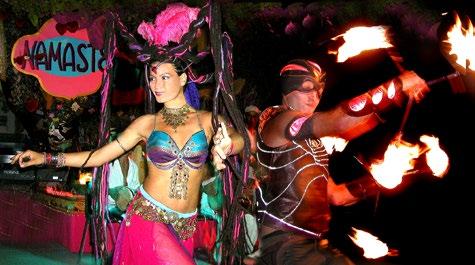
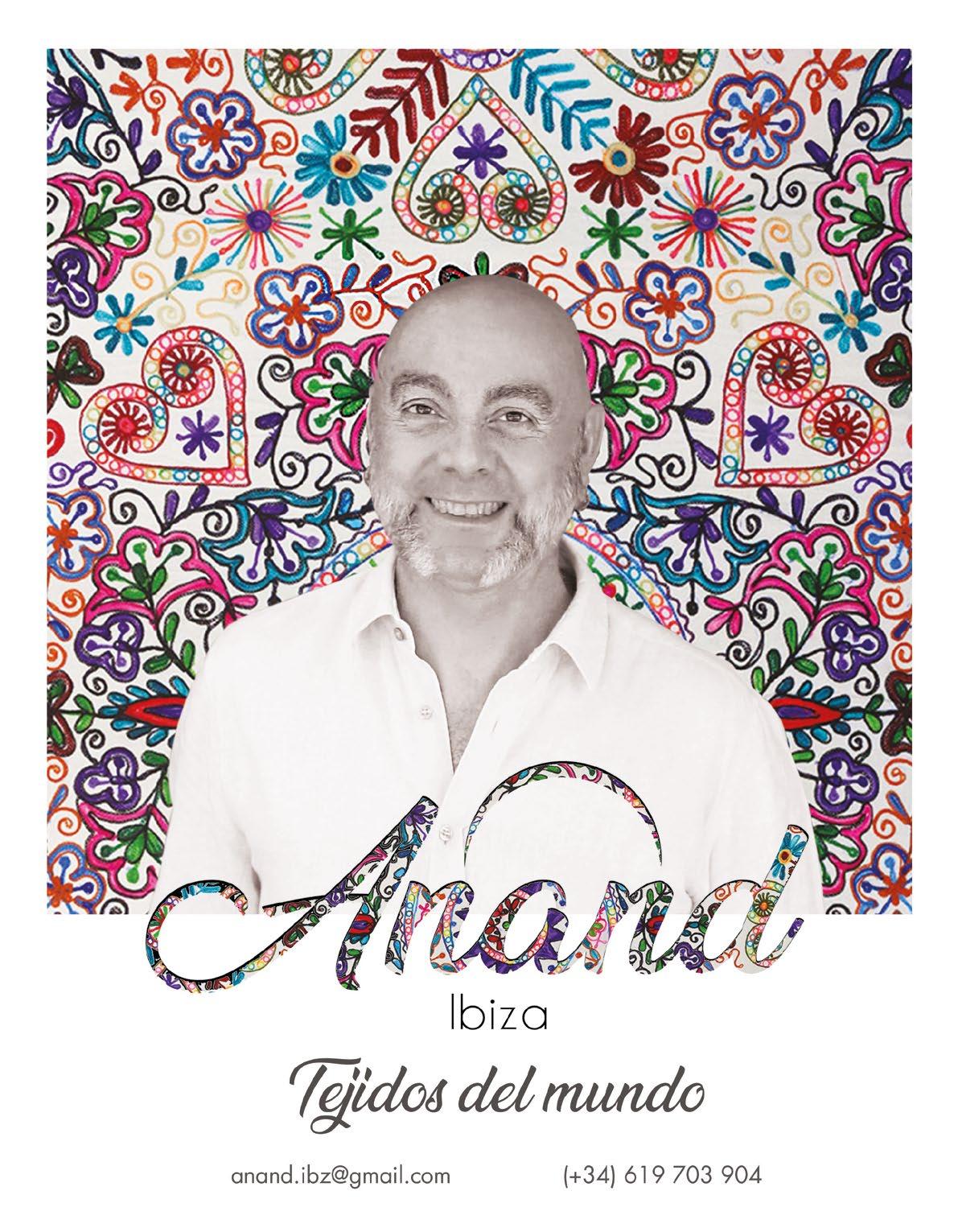
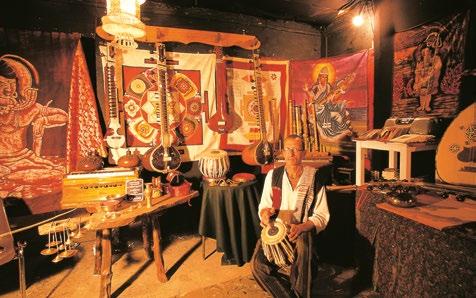
El cosmopolitismo que le aportaron los hippies, la energía de la música, el colorido y la originalidad de las creaciones de los artesanos… todo ha sido fundamental para el éxito de Las Dalias que es, sin duda, uno de los lugares más famosos de la isla, visita obligada para los turistas y objeto de reportajes en medios nacionales e internacionales.
El día a día en Las Dalias es dinámico y no nos hemos conformado con una fórmula estática. Hemos querido ir siempre creciendo y aportando novedades, como abrir el mercadillo por las noches (los exitosos Night Markets); trasladarnos a Madrid y a Amsterdam en la increíble experiencia Las Dalias on the Road o poner en marcha esta revista Las Dalias Ibiza y Formentera Magazine, que cumple 14 ediciones contado la historia pasada, presente y futura de este lugar.
“EL DÍA A DÍA EN LAS DALIAS ES DINÁMICO Y NO NOS HEMOS CONFORMADO CON UNA FÓRMULA ESTÁTICA. HEMOS QUERIDO IR
SIEMPRE CRECIENDO
Y
APORTANDO NOVEDADES”
Las Dalias ha crecido pero sigue siendo un negocio familiar en el que la familia Marí está presente en el día a día. Un mercadillo que llega a recibir a más de 35.000 personas a la semana, con una plantilla de casi un centenar de trabajadores contratados, además de las más de 350 familias de artesanos y vendedores que dan vida al Mercadillo.
Daily life at Las Dalias is dynamic and it’s safe to say that we have never settled for a set, stagnant formula. Instead, we’ve always strived to grow and bring new things to the table, like the opening of our popular Night Markets; travelling to Madrid and Amsterdam with the incredible Las Dalias on the Road experience; and launching this Las Dalias Ibiza y Formentera Magazine, which is now celebrating its 14th edition, as it chronicles the past, present and future of this magical place.
“A FLEA MARKET THAT CAN RECEIVE OVER 35,000 PEOPLE A WEEK, WITH A STAFF OF ALMOST ONE HUNDRED HIRED WORKERS, IN ADDITION TO THE MORE THAN 350 FAMILIES OF ARTISANS AND VENDORS”

Though Las Dalias has grown, it is still a family business personally run by members of the Marí family. A flea market that can receive over 35,000 people a week, with a staff of almost one hundred hired workers, in addition to the more than 350 families of artisans and vendors who fill it with life each day.



En los últimos años trabajamos hacia la modernización, pero sin perder nuestra identidad y respetando nuestras raíces. Lo hemos hecho con el nacimiento de la sala Akasha, las diferentes reformas, la apertura del nuevo restaurante de Las Dalias PaloSanto o con la mejora de la comunicación y presencia en la esfera digital para romper las fronteras de la isla y mostrar al mundo la esencia de Las Dalias.
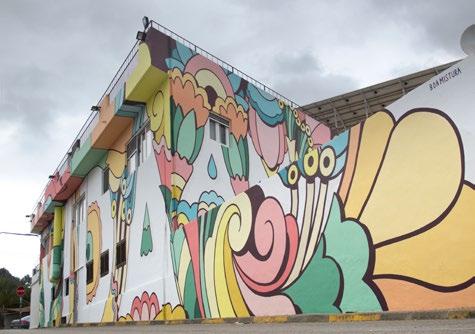
A menudo me preguntan si soy consciente de lo que Las Dalias representa para Ibiza a día de hoy. Os aseguro que soy incapaz de verlo así, de ser consciente de su magnitud. Hubo fracasos y pasamos tiempos difíciles, sí, pero las buenas ideas fueron cuajando y Las Dalias ha llegado a ser famosa internacionalmente por esa mezcla de mercadillo cosmopolita, música y cultura que es única en Ibiza.
Fuimos capaces de cumplir el sueño de mi padre y Las Dalias no solo tiene una historia de 70 años sino un futuro prometedor.
In the last few years, we have been working in the direction of modernisation, yet without losing sight of who we are and remaining faithful to our roots. This we have done with the creation of the Akasha room, several renovations, the opening of Las Dalias’ new restaurant PaloSanto and our improved communication and our presence in the digital realm, to transcend the borders of the island and share the essence of Las Dalias with the world.
“A MENUDO ME PREGUNTAN SI SOY CONSCIENTE DE LO QUE LAS DALIAS
REPRESENTA PARA IBIZA A DÍA DE HOY. OS ASEGURO QUE SOY INCAPAZ DE VERLO ASÍ, DE SER CONSCIENTE DE SU MAGNITUD”
I am often asked if I am aware of what Las Dalias represents for Ibiza today. Well, I must say that I’m incapable of viewing it that way, of considering its magnitude. We had our failures and tough times, of course, but the good ideas gradually came to fruition and Las Dalias has become internationally famous for its fusion, blending a cosmopolitan street market with music and culture, which is unique in Ibiza.
We managed to make my father’s dream come true, and Las Dalias now not only has a 70-year history, but also a promising future.




José Juan Guasch se uniformó aquella mañana de sábado aunque estuviera de permiso. Era 12 de octubre, Virgen del Pilar, la patrona de la Guardia Civil, el cuerpo donde servía destinado en el cuartel de Llucmajor. El guardia Guasch volvió desde Mallorca a Sant Carles de Peralta y se uniformó por una razón muy diferente a la que pueda parecer a simple vista. No les esperaba un desfile. Tampoco una jura de bandera. A misa sí fue, pero no para honrar simplemente a la virgen. Enfiló hacia la iglesia de su pueblo porque un tío de su padre subió expresamente desde Santa Gertrudis, donde era párroco, a casarlo con Maria Torres Colomar En el retrato que les hicieron después de la ceremonia religiosa la novia lleva un traje blanco que confeccionó una modista de Vila. El novio reposa su mano derecha en la espalda. Quizás con ella esté sujetando el tricornio.
José Juan Guasch donned his uniform that Saturday morning even though he was on leave. It was 12 October, the day of the Virgin of El Pilar, the patron saint of the Civil Guard, the corps where he served stationed at the barracks in Llucmajor. Guard Guasch returned from Mallorca to Sant Carles de Peralta and put on his uniform for a very different reason than might seem at first glance. There was no parade awaiting them. Nor a flag swearing-in ceremony. He did go to mass, but not simply to honour the virgin. He headed towards the church of his village because an uncle of his father had come up expressly from Santa Gertrudis, where he was the parish priest, to marry him to Maria Torres Colomar. In the portrait taken of them after the religious ceremony, the bride is wearing a white dress made by a dressmaker from Vila. The groom rests his right hand on his back. Perhaps with it he is holding the tricorn hat.

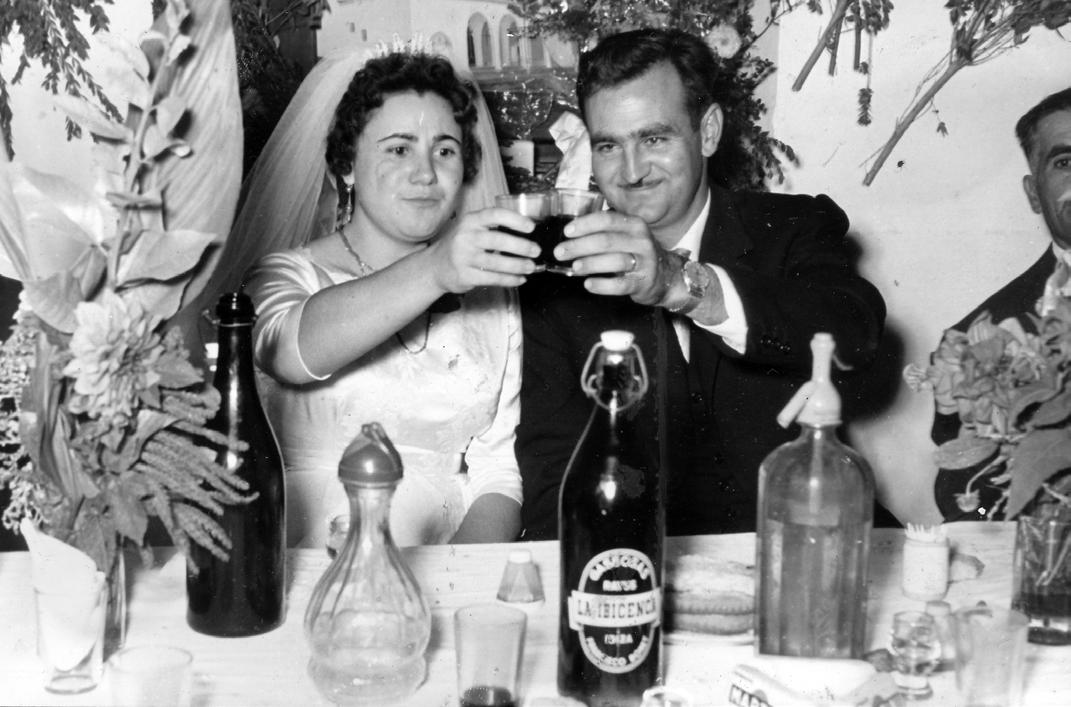
La boda de Maria y José Juan, celebrada en 1957, no la olvidaron jamás en Las Dalias: fue el primer convite que se organizó en un negocio que había abierto sus puertas poco antes, en 1954.
Toni Colomar, a sus ochenta y ocho años, conserva una memoria prodigiosa. Si se le pregunta, relata anécdotas que entrelaza sin descanso hasta convertirlas en historias trepidantes. Divierte y se divierte cuando las cuenta. Le gusta recrearse en los detalles, rescatar rostros, sensaciones, palabras ya desaparecidas. Cuando Toni habla se repiten los escenarios (la parroquia de Sant Carles; la terraza, el bar y la sala de Las Dalias) y los personajes secundarios (Pep Negre, el cura; Joan Marí y Francisca Juan, los dueños del negocio, maestros de ceremonias; el panadero Pep de sa Vilda; Miquel d’en Pep Xumeu, Toni Mariano Xico, Toni Sort, y dos eulalias, de Can Sala y de Can Toni Andreu, los cocineros y cocineras más habituales), pero la pareja protagonista cambia siempre. Casarse, entonces, era algo que sólo se podía hacer una vez en la vida, y Colomar apenas se perdió alguna de las bodas que celebraron los vecinos de su pueblo durante los años sesenta y setenta.
Maria and José Juan’s wedding, held in 1957, is unforgettable in Las Dalias: it was the first reception organised at a business that had opened its doors shortly before, in 1954.
At eighty-eight years old, Toni Colomar has a remarkable memory. If you ask him, he shares anecdotes that he weaves together tirelessly until they become captivating stories. He enjoys both telling and hearing them. He likes to linger over details, bringing back faces, sensations and long-forgotten words. When Toni speaks, the scenes come alive again (the parish of Sant Carles; the terrace, the bar and the hall of Las Dalias) along with the supporting characters (Pep Negre, the priest; Joan Marí and Francisca Juan, the business owners and masters of ceremonies; the baker Pep de sa Vilda; Miquel d’en Pep Xumeu, Toni Mariano Xico, Toni Sort and two Eulalias, from Can Sala and Can Toni Andreu, the most common cooks), but the main couple always changes. Back then, getting married was a once-in-a-lifetime event, and Colomar hardly missed any of the weddings celebrated by the neighbours of his town during the sixties and seventies. A passionate music lover since childhood, he quickly discovered his talent for memorising and performing songs. When Las Dalias was still a concept lurking
Melómano empedernido desde que era un chaval, pronto descubrió que tenía facilidad para memorizar canciones e interpretarlas. Cuando Las Dalias era aún un proyecto que daba vueltas en la cabeza de Juan Marí, el joven Toni fue una de las pocas personas que sabía qué iba a suceder en el bar que aquel hombre estaba construyendo junto al camino que conducía a Santa Eulària. “Y tú vas a cantar allí, ve formando un grupo”, le dijo el fundador, que le tenía mucho cariño.
Fue así como nacieron los HiFi, la primera banda residente que hubo en Las Dalias. No tocaron en la inauguración porque eran jóvenes y no se sentían suficientemente preparados. Sí lo harían luego, decenas de veces, ahora una rápida, ahora una lenta, en los bailes que venían después de los banquetes nupciales.
SE DEPOSITABAN BANDEJAS Y BANDEJAS DE ‘ORELLETES’
A LA HORA DEL POSTRE
El sofrit pagès era el rey de unas mesas sobre las que se depositaban bandejas y bandejas de orelletes a la hora del postre. Ese fue el menú de los trescientos invitados que acudieron a la boda del propio Toni Colomar con Eulalia Ferrer Ferrer, de Can Vicent de ca na Ribas. Las familias se encargaron de sacrificar y trocear al cerdo, los pollos y los corderos con los que se preparó una de las recetas más antiguas de la gastronomía ibicenca. La abuela de Can Toni Andreu des Coll, la casa de la que procedía la novia, dirigió las operaciones junto a los calderos donde también hirvió el saco de arroz que Pep Roques, dueño del hostal Es Alocs, le trajo a los novios desde Vila dentro de su camión. En aquellos años, con el aeropuerto recién inaugurado y el turismo todavía aterrizando, la vida en el norte de la isla todavía se basaba en la economía de subsistencia. Había que recurrir a los colmados, comercios y tiendas de la capital para conseguir los imprescindibles de cualquier enlace. El vestido de novia también lo confeccionó una modista vilera. Mientras los invitados tomaban el aperitivo en Las Dalias, un coche bajó a la pareja hasta la Marina para
at the back of Juan Marí’s mind, young Toni was one of the few who knew what would happen in the bar being built along the road to Santa Eulària. ‘You’re going to sing there, start forming a group,’ said the founder, who had great affection for him.

That’s how HiFi, the first resident band at Las Dalias, came to be. They didn’t perform at the opening because they were young and didn’t feel ready. But later on, they played dozens of times, sometimes fast, sometimes slow, at the dances following the wedding banquets.
Sofrit pagès reigned over tables laden with trays of orelletes at dessert time. This was the menu for the three hundred guests at the wedding of Toni Colomar himself to Eulalia Ferrer Ferrer, from Can Vicent de ca na Ribas. The families took charge of slaughtering and butchering the pig, chickens and lambs for one of Ibiza’s oldest gastronomic recipes. The grandmother of Can Toni Andreu des Coll, the bride’s family home, oversaw the preparations alongside the cauldrons where the sack of rice, brought to the couple from Vila by Pep Roques, owner of the Es Alocs hostel, also simmered. In those years, with the airport newly opened and tourism still taking off, life in the north of the island was still based on a subsistence economy. People had to rely on the grocers, shops and stores in the capital to get the essentials for any wedding. The wedding dress was also made by a dressmaker from Vila. Toni, a soulful artist, matched his wife and also dressed in white. While the guests enjoyed appetisers at Las Dalias, a car took them down to the Marina so that the camera of a photography studio next to the Can Pou bar could
que la cámara de un estudio fotográfico situado junto al bar Can Pou los inmortalizara de largo. Al acabar aquel 7 de mayo de 1960, les habían entregado algunos regalos y 1.200 duros, un pequeño patrimonio para empezar una vida juntos que dura a día de hoy, casi setenta años después de haberse conocido, en el 56, en la boda de una hermana de Toni.

La boda de Josefa Juan Ferrer y Miguel Juan Marí, de Can Cardona y Can Miquel Xumeu, fue alrededor de 1960. La de Antonio Ferrer Ferrer, de Can Toni Marines, y Josefa Colomar Guasch, el 21 de septiembre de 1963. La de Mariano Torres Colomar, de Can Toni Mariano Puig, y Maria Juan Marí, de Can Gat, el 16 de octubre de 1965. Y la de Toni Juan Marí, de Can Xumeu des Gat, y Maria Juan Marí, de Can Pep de sa Plana, el 30 de agosto de 1969. Los carretes fotográficos de estos cuatro enlaces que se revelaron tienen un valor innegable. Con ellos puede hacerse antropología al vuelo. Se ven bancos para hombres y bancos para mujeres dentro de la iglesia de Sant Carles. Se ve a majores cubiertas con pañuelo y a majors cubiertos con sombrero de ala ancha, ambos de luto, en la parte delantera del templo y en las cabeceras de las mesas. Se ve a grupos de jóvenes tomando un vermú con sifón en las
capture them at length. By the end of that 7 May 1960, they had received some gifts and 1,200 duros, a small fortune to start a life together that continues to this day, almost seventy years after they first met, in ‘56, at Toni’s sister’s wedding.
SE HACÍA UNA MATANZA
The wedding of Josefa Juan Ferrer and Miguel Juan Marí, from Can Cardona and Can Miquel Xumeu, took place around 1960. Antonio Ferrer Ferrer, from Can Toni Marines, and Josefa Colomar Guasch were married on 21 September 1963. Mariano Torres Colomar, from Can Toni Mariano Puig, and Maria Juan Marí, from Can Gat, were married on 16 October 1965. And Toni Juan Marí, from Can Xumeu des Gat, and Maria Juan Marí, from Can Pep de sa Plana, were married on 30 August 1969. The developed photographic reels of these four weddings have undeniable value. They can be used for anthropology on the fly. You can see benches for men and benches for women inside the church of Sant Carles. You can see older women covered with a headscarf and older

men wearing wide-brimmed hats, both in mourning, at the front of the temple and at the heads of the tables. You can see groups of young people sipping on vermouth with seltzer at

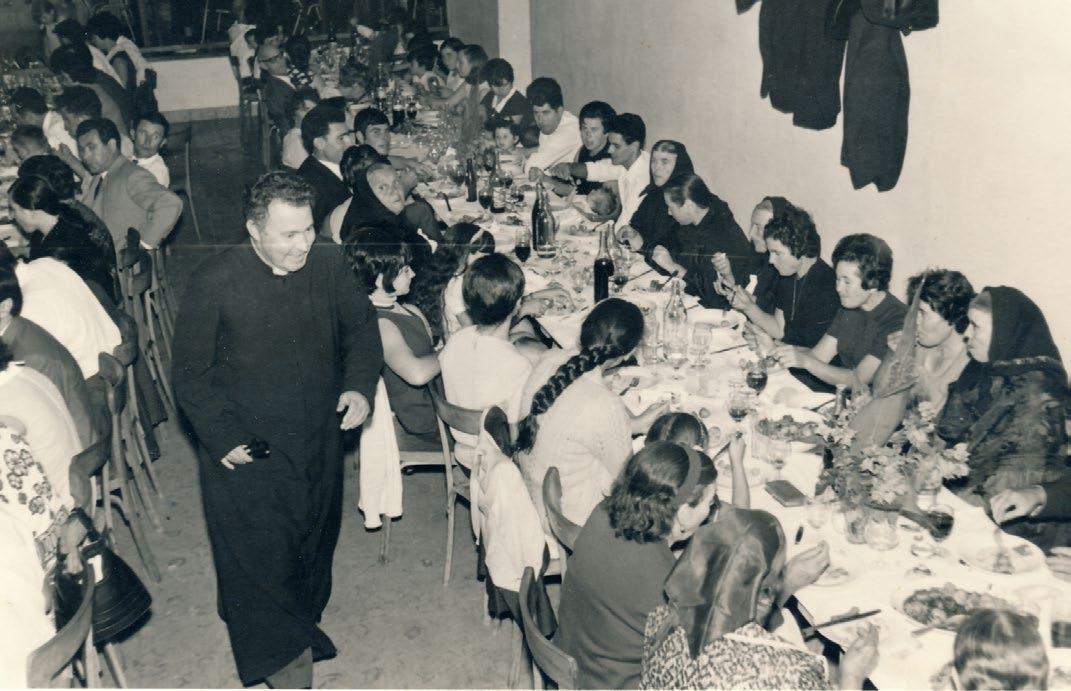
mesas bajas del bar de Las Dalias. Se ve a los HiFi tocando unas partituras que les enviaban directamente desde la Sociedad General de Autores y Editores, que les obligaba a superar un examen para concederles la licencia de músicos profesionales. Se ve a renacuajos correteando en pantalón corto con una sonrisa de trastos pintada en la boca. Se ve a un adulto con cara de niño grande, Josep Planells Bonet, Pep Negre, el cura poeta, oficiando la misa y saludando aquí y allá en el convite. Se ve la mesa nupcial, y otras junto a ella donde se sientan los familiares más cercanos, en el escenario que se elevaba unos metros sobre el resto de la antigua sala de Las Dalias. Se ven botellas rellenadas con vi pagès junto a otras con la etiqueta de Gaseosas La Ibicenca. Se ven sobrasadas y butifarras colgando de las paredes, ya curadas o en pleno proceso de secado, dependiendo del mes y, sobre las mesas, se ven platos de sofrit pagès, de bullit de carn, de frit de freixura, de arroz y rebanadas de pan, algunos horneados directamente en las casas donde se hacía esa matanza extraordinaria y, al mediodía siguiente, los allegados de ambas partes compartían ses sopris, los restos del banquete.
Las imágenes parecen intercambiables porque en apariencia nada cambia. Hay truco, sin embargo.
the low tables of the Las Dalias bar. You can see HiFi playing sheet music that was sent to them directly from the Sociedad General de Autores y Editores, which required them to pass an exam to grant them a licence as professional musicians. You can see kids running around in shorts with mischievous smiles painted on their faces. You can see an adult with the face of a big child, Josep Planells Bonet, aka Pep Negre, the poet priest, officiating the mass and greeting people here and there at the reception. You can see the bridal table, and others next to it where the closest family members sit, on the stage that rose a few metres above the rest of the old Las Dalias hall. You can see bottles filled with vi pagès next to others with the label of Gaseosas La Ibicenca. You can see sobrasadas and butifarras hanging from the walls, already cured or in the process of drying, depending on the month, and on the tables, you can see dishes of sofrit pagès, bullit de carn, frit de freixura, rice and slices of bread, some baked directly in the houses where that extraordinary slaughter was done, and, the next day at noon, the relatives from both sides shared ses sopris, the remains of the banquet.
The images appear interchangeable because, at first glance, nothing changes. However, there’s a trick.
Porque si el álbum se revisa cronológicamente las diferencias afloran. Sutiles, al principio; más claras, después.

El retablo de la iglesia varía y el sacerdote ya no da la espalda a los feligreses. En las fiestas empieza a haber invitados que llegan a Sant Carles desde Vila, y de otros lugares de la isla donde, invierno tras invierno, verano tras verano, se muda gente que vivía en el campo para estar más cerca de los hoteles, restaurantes o souvenirs donde ha empezado a trabajar o ha invertido su herencia. Mariano, de Can Toni Mariano Puig, que había sido telegrafista en la ciudad ya convida a su boda a varios excompañeros de la oficina, que se arreglan como si se hubieran vestido para pasear por s’Alamera. Los peinados se ondulan, las patillas crecen, los tonos de la ropa se aclaran y los cortes de las camisas, las chaquetas, los pantalones son cada vez más estilosos. La Ibiza atávica se está convirtiendo en la Ibiza yeyé, y algún personaje estrafalario y bailongo, que los protagonistas de aquellas bodas recuerdan como un extranjero que se había establecido en Sant Carles, lo confirma. A los vestidos de las novias les crece cola y ya no es necesario ir a las boutiques de Vila para comprarlos: muchas jóvenes empezaron a confiar en las manos y el gusto de una vecina de Sant Carles, Catalina Torres, Sa Rota, que aparece en algunos álbumes vistiendo a las futuras esposas. Aunque el ajuar para la casa y algo de dinero siguen siendo los presentes más comunes, los recién casados se embarcan de luna de miel. Palma, próximo y económico, es el destino más habitual y pasar la noche de bodas en un hotel de Vila, en vez de que la esposa permanezca una semana rezando con el cura en la casa parroquial, un signo de que los tiempos cambian a velocidad de vértigo.
If the album is reviewed chronologically, the differences become apparent. Subtle at first, clearer later on. The church altarpiece varies, and the priest no longer turns his back on the parishioners. At the parties, guests begin to arrive in Sant Carles from Vila, and from other places on the island where, year after year, people who lived in the countryside move closer to the hotels, restaurants or souvenir shops where they have started to work or have invested their inheritance. Mariano, from Can Toni Mariano Puig, who had been a telegraph operator in the city, now invites several former colleagues from the office to his wedding, and they dress up as if they were going for a stroll in s’Alamera. Hairstyles become wavier, sideburns grow, clothing tones lighten and the cuts of shirts, jackets and trousers become increasingly stylish. Atavistic Ibiza is becoming yé-yé Ibiza, and some eccentric and dance-loving character, whom the protagonists of those weddings remember as a foreigner who had settled in Sant
EL AJUAR PARA LA CASA Y ALGO DE DINERO ERAN ENTONCES LOS PRESENTES MÁS COMUNES, PERO ALGUNAS PAREJAS
YA
SE EMBARCAN DE LUNA DE MIEL

Carles, confirms it. The brides’ dresses grow longer trains, and it is no longer necessary to go to Vila’s boutiques to buy them: many young women began to trust the hands and taste of a neighbour from Sant Carles, Catalina Torres, Sa Rota, who appears in some albums dressing the future wives. Although household trousseaus and some money remain the most common gifts, newlyweds embark on a honeymoon. Palma,

Así avanzamos hasta el 15 de febrero de 1975. Todavía quedan unos meses para que muera Franco y empiece la Transición, pero España, y mucho menos una isla ya conocida en todo el planeta, se parece poco a lo que había sido veinte años atrás. Vuelve a ser sábado a mediodía, vuelve a haber una boda en Sant Carles. Decenas de personas van saliendo de la iglesia y forman un pasillo sobre el que cae un chaparrón de arroz cuando lo atraviesan Margarita
VECINOS
Guasch Colomar, de Can Pep d’en Jordi, y Vicente Torres Colomar, de Can Vicent des Puig de ses Mines. Pep Negre, a quien ya le ha salido alguna cana y apenas le quedan un par de años para dejar trasladarse a Sant Rafel, les acaba de pedir que pronuncien los votos matrimoniales en presencia de Toni, el hermano de Margarita, y Maria, una sobrina de Vicente; el padrino y la madrina. En la puerta, un Seat 127 espera a los novios para llevarlos a Las Dalias. El pan lo seguirá brindando el obrador de Pep de sa Vilda, pero los recién casados, que seguramente habían jugado de niños en alguno de los convites que acabamos de
close and economical, is the most common destination, and spending the wedding night in a Vila hotel, instead of the wife staying a week praying with the priest in the parish house, is a sign that times are changing at a dizzying pace.
And so, we advance to 15 February 1975. There are still a few months before Franco dies and the Transition begins, but Spain, and much less an island already known throughout the world, resembles little of what it had been twenty years earlier. It is Saturday at noon again, there is another wedding in Sant Carles. Dozens of people are leaving the church and forming a corridor over which a shower of rice falls when Margarita Guasch Colomar, from Can Pep d’en Jordi, and Vicente Torres Colomar, from Can Vicent des Puig de ses Mines, walk through it. Pep Negre, who has already sprouted some grey hairs and has only a couple of years left before moving to Sant Rafel, has just asked them to pronounce their marriage vows in the presence of Toni, Margarita’s brother, and Maria, a niece of Vicente, the best man and the maid of honour. At the door, a Seat 127 awaits the newlyweds to take them to Las Dalias. The bread will still come from Pep de sa Vilda’s bakery, but
IF THE ALBUM IS REVIEWED CHRONOLOGICALLY, THE DIFFERENCES BECOME


describir, y sus doscientos acompañantes van a disfrutar de ciertas cosas que eran inimaginables poco tiempo atrás. En el menú, además del sempiterno sofrit, que cocina el propio Juan Marí en la feixa que ocupa ahora el mercado, habrá paella. Y un pastel de nata de varios pisos de altura que se cuela al fondo de una fotografía ya a color. Apenas hay trenzas payesas, cabezas cubiertas, luto. Predominan el rojo, el azul, el verde, ocres y amarillos. El paso de las décadas le ha dado a las imágenes de este banquete, uno de los primeros que se organizaron en el restaurante de Las Dalias, unos tonos preciosos. Nostalgia mate. En la mayoría de las casas ha entrado la electricidad, el agua corriente, el teléfono y la televisión, el castellano fluido e, incluso, nociones de inglés, francés y alemán gracias al contacto con los extranjeros, los vehículos a motor, los guateques, el rock and roll, las nóminas, los negocios por cuenta propia, los viajes en familia, una (cierta) liberación sexual y sentimental. La boda, sin dejar de ser un rito de paso, la memoria de un tiempo ancestral, es ya el anuncio del futuro que está por venir.
the newlyweds, who likely played as children at one of the receptions we described earlier, and their two hundred guests will enjoy things that were unimaginable not long ago. The menu will include paella alongside the everlasting sofrit, which Juan Marí cooks himself on the plot of land now occupied by the market. There will also be a multi-tiered cream cake, subtly captured in the background of a now-colour photograph. Gone are the peasant braids, covered heads and mourning attire. Instead, reds, blues, greens, ochres and yellows dominate. The passing decades have bestowed beautiful hues upon the images of this banquet, one of the first to be organised at the Las Dalias restaurant. A sense of muted nostalgia pervades. In most homes, electricity, running water, telephone and television have arrived, along with fluency in Spanish, and even some knowledge of English, French and German, thanks to contact with foreigners. There are motor vehicles, parties, rock and roll, pay cheques, self-employment, family trips and a (certain) sexual and emotional liberation. The wedding, still a rite of passage and a memory of an ancestral time, is now also a harbinger of the future.

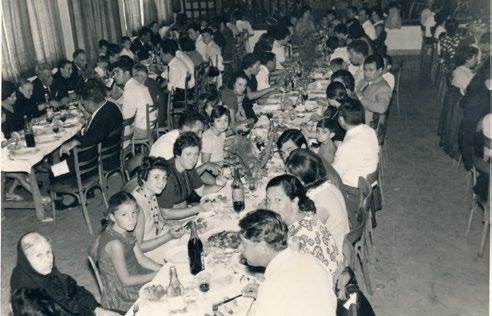
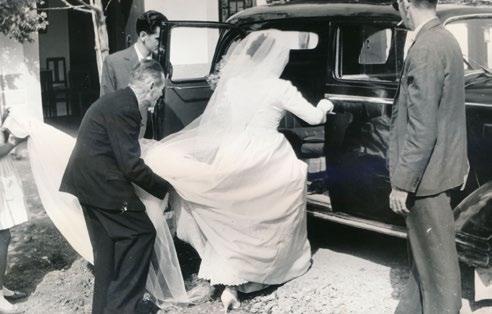





Las Dalias invita al amor. Seis parejas muy vinculadas al mercado nos desvelan la fórmula de sus relaciones. Pura química, pese a que provienen de países, contextos e, incluso, épocas diferentes. Pero, conversación tras conversación, emergen muchos puntos comunes. Además de la inevitable atracción física de los primeros días, escuchándolos es fácil percibir coincidencias que enlazan el ansia de libertad con el apetito de descubrir y la pasión por la cultura. Lo carnal transformándose en espiritual. Canciones, libros, películas, pinturas y moda, moda forman en cada una de estas historias de amor un fondo común que no admite separación de bienes. Con ese hilo han tejido historias que, llegados en muchos casos a los últimos años de unas vidas vividas con intensidad, son dignas de ser contadas.
Las Dalias opens the doors to love. Six couples closely linked to the market reveal the formula of their relationships. Pure chemistry, despite hailing from different countries, backgrounds and even eras. Yet, conversation after conversation, patterns emerge. In addition to the inevitable physical attraction of the early days, listening to each couple reveals certain coincidences—a craving for freedom, an appetite for discovery, a passion for culture. The carnal transforms into the spiritual. Songs, books, films, paintings and fashion form in each of these love stories a common background that does not admit separation of assets. With that thread, they have woven stories that, having arrived in many cases at the last years of lives lived with intensity, are worthy of being told.
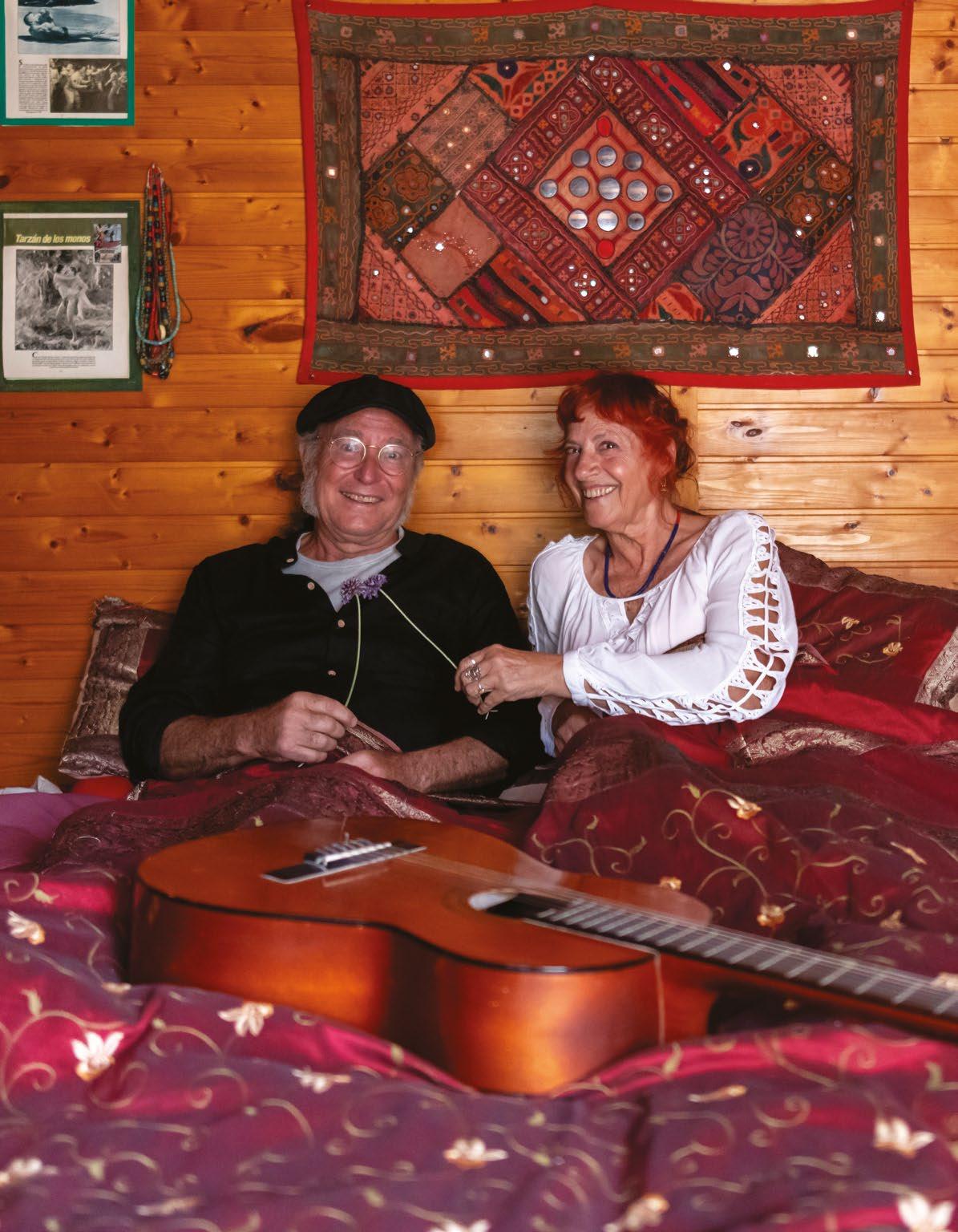

Djin, pelo a lo Beatle y chaqueta de tweed rojiza, se acerca a la barra y pide una copa. Al otro lado, Mora se pregunta: ¿quién es ese tío? No reconoce al adolescente que, muchos años antes, aprovechaba su cuerpo rotundo para fingir mayoría de edad y colarse en el mismo bar en el que están. Los ochenta llegan a su ecuador y el Lovers es el templo de la noche de Düsseldorf. Ella lleva décadas reuniendo allí a la crème de la bohemia alemana. Hay hippies y hay punks porque la dueña es un poco de cada. En Ibiza, donde ha sido musa y modelo de la boutique Paula’s, los peluts la consideran su reina. Y, a la vez, siempre a la última, celebra la ola de modernidad que encabeza Nina Hagen. Como no es un rostro anónimo, cuando pide la copa, él sabe perfectamente a quién tiene delante. Juntos, intensifican su magnético atractivo. Antes de conocerse han tenido hijos, así que al reunirse hacen borrón y cuenta nueva. La relación echa raíces en la isla porque en el norte ibicenco se sienten libres. Ella combina su gusto innato en el vestir con la habilidad para el ganchillo que aprendió de su abuela suiza. El puesto donde vende la ropa que diseña y confecciona impulsa la fama de Las Dalias: Paloma Picasso, Brigitte Bardot,
MIRADAS QUE SE DEDICAN MIENTRAS
ESCUCHAN EL RELATO DEL OTRO
la propia Hagen, o diseñadores como Saint-Laurent, Versace o Gaultier compraron (y se inspiraron) allí. Él, hijo de un hombre de campo que domaba caballos con la misma destreza con la que construía casas, reforma de arriba a abajo el hogar que comparten en sa Vénda des Rubió, el valle donde se encuentran Aubarca y Balanzat. Planta un huerto. Cría sus propios animales. Nunca ha dejado de encerrarse en un taller para esculpir en piedra y en madera. Ochenta seis años, seis nietos y un bisnieto tiene Mora. Setenta y tres cuenta Djin. Dos perritos (el cachorro Chiqui y, nombre inevitable, Amore) les guardan. No mengua el brillo de las miradas que se dedican mientras escuchan el relato del otro. Mantienen la complicidad que transpiraban al performar a dúo en las fiestas más famosas de Ibiza. Regado con arte, el amor nunca se marchita.
Djin, sporting Beatles-style hair and a reddish tweed jacket, strolls up to the bar and orders a drink. On the other side, Mora wonders, ‘Who is that guy?’ She doesn’t recognise the teenager who, many years ago, used his sturdy build to pass for an adult and sneak into the same bar where they now find themselves. The 1980s are in full swing, and Lovers is the epicentre of Düsseldorf’s nightlife. For decades, she has been attracting the creme of German bohemia to this spot. Hippies and punks alike frequent the place, reflecting the eclectic tastes of its owner. In Ibiza, where she has been both muse and model for the Paula’s boutique, the ‘peluts’ consider her their queen. Yet, always keeping up with the times, she embraces the modern wave led by Nina Hagen. Since she is no stranger, when she orders her drink, he knows
THEY MAINTAIN THE SAME CLOSENESS THEY DISPLAYED WHILE PERFORMING TOGETHER AT IBIZA’S MOST RENOWNED PARTIES
exactly who she is. Together, they exude a magnetic allure. Despite having children before they met, their reunion feels like a fresh start. Their relationship finds solid ground on the island, where they both feel liberated. She combines her innate sense of style with the crochet skills passed down from her Swiss grandmother. The stall where she sells her designs at Las Dalias has attracted the likes of Paloma Picasso, Brigitte Bardot, Nina Hagen and renowned designers such as SaintLaurent, Versace and Gaultier, who not only purchased from her but also drew inspiration from her creations. He, the son of a man who was equally adept at taming horses and building houses, renovates their shared home in sa Vénda des Rubió valley, where Aubarca and Balanzat meet. He tends to a vegetable garden and raises animals. His passion for sculpting in stone and wood has never waned. Mora, at eighty-six years old, has six grandchildren and one great-grandchild. Djin is seventy-three. Two little dogs, the puppy Chiqui and the aptly named Amore, keep them company. The spark in their eyes remains as bright as ever as they listen to each other’s tales. They maintain the same closeness they displayed while performing together at Ibiza’s most renowned parties. Nurtured by art, their love never fades.
Dentro del Jai-Ca quedaba algo de luz aunque ya fueran las cuatro de la madrugada. Como Álex conocía bien al dueño del bar se tomó la confianza de llamar a la puerta. Entró sin sospechar que, además de irse a dormir con las primeras luces, conocería a su compañera de vida. Luisa había bajado a la Barceloneta desde Gràcia con unas amigas. La conexión con el desconocido fue instantánea. Hablaron de cine. De música (ella era pianista clásica y él amaba el rock progresivo). De literatura. Los libros dieron pie a una primera cita que no debía parecer una primera cita. Luisa había estudiado Filología Hispánica y andaba detrás de La montaña mágica. Álex, de oficio librero, era la persona perfecta para conseguírselo. Con su moto, rodaba por la ciudad visitando fondos de colecciones descatalogadas que luego vendía en su propio negocio. Cumplir el encargo de su crush, como dicen los jóvenes de ahora, no sería muy difícil. La novela de Thomas Mann fue la primera piedra de un camino que atraviesa cuarenta años. El viaje cambió de rumbo cuando un amigo les invitó a conocer Ibiza. Ella había dejado las clases en un colegio privado. Él cerró su librería y dudaba si aceptar una oferta para trabajar en la de una gran editorial. Ya habían coqueteado con la vida de mercaderes en las ferias barcelonesas. Se miraron y comprendieron que las
‘LA MONTAÑA MÁGICA’ FUE LA PRIMERA PIEDRA DE UN CAMINO QUE ATRAVIESA CUARENTA AÑOS
rutinas y su relación eran como el agua y el aceite. Que, quizás, sus corazones fueran más rurales que urbanitas. La mudanza afianzó la confianza mutua. Aprendieron a cultivar un huerto, a comprender a las abejas, a moverse como peces en las aguas de una isla mucho más virgen y libre. Su primera vocación fueron las marionetas: Luisa las vestía de hilo y Álex las animaba. El sombrero lo pasaban en la Marina. En Las Dalias hicieron nido a finales de los ochenta. Han reinventado su puesto media docena de veces. Ahora venden camisetas estampadas con una impresora 3-D, pero hubo un tiempo en que disfrutaban viendo a los niños investigar con los juegos de ingenio que ellos mismos fabricaban. ¿Será el amor una manera de jugar eternamente?
Inside Jai-Ca, a hint of light lingered even as the clock struck four in the morning. Being acquainted with the bar owner, Álex felt comfortable enough to knock on the door. Little did he know that this late-night visit would lead him to his life partner. Luisa had ventured from Gràcia to Barceloneta with her friends. The connection between her and the stranger was instant. They conversed about cinema, music (she, a classical pianist, and he, a lover of progressive rock) and literature. Discussing books sparked a first encounter that didn’t feel like a typical first date. Luisa, a graduate in Hispanic Philology, was in search of a copy of The Magic Mountain. Álex, a professional bookseller, was the perfect person to source it for her. Riding his motorcycle, he scoured the city for collections of out-of-print books,
THEY LEARNED TO TEND A GARDEN, TO UNDERSTAND BEES, TO NAVIGATE THE WATERS OF A MUCH MORE PRISTINE AND LIBERATED ISLAND
later selling them in his own store. Fulfilling his crush’s request, as young people say nowadays, was no tall order. Thomas Mann’s novel marked the beginning of a journey that has spanned forty years. Their path took a turn when a friend invited them to visit Ibiza. Luisa had left her job teaching at a private school, while Álex closed his bookstore, contemplating an offer to work at a major publishing house. Having already dabbled in the life of merchants at Barcelona’s fairs, they both realised that their routines and their relationship were as different as water and oil. Perhaps their hearts were more attuned to rural life than to the urban bustle. The relocation to Ibiza strengthened their bond. They learned to tend a garden, to understand bees, to navigate the waters of a much more pristine and liberated island. Their initial passion was for puppetry: Luisa crafted their outfits while Álex brought them to life. They entertained in La Marina, eventually settling in Las Dalias in the late eighties. Over the years, they have reinvented their business several times. Currently, they sell T-shirts printed with a 3-D printer, but there was a time when they delighted in watching children explore the puzzles they had crafted themselves. Could love be a perpetual game?


Se conocieron en los tiempos del colegio. Eran unos críos que se llevaban bien, pero se perdieron de vista. Pasaron los años y, en la veintena, cuando se reencontraron, Massimo trabajaba como artesano. Entonces surgió una improvisada atracción y, al poco tiempo, ya estaban juntos. El nomadeo que ambos ansiaban fue la argamasa de una pareja que pasó la década de los setenta viajando por el mundo. Recorrían casi todo el mapamundi (sólo les quedó pendiente Oceanía), regresaban a Italia para vender en mercados sus artesanías de piel y volvían a coger sus pasaportes para volar lejos. Más tarde, en los ochenta, llegaron sus dos hijos. Y la casa de campo que tenían en la Toscana, donde además de trabajar el cuero producían aceite, se convirtió en un espacio un poco estrecho cuando descubrieron Ibiza. Un viaje transformó a la isla en el hogar que siempre habían buscado, un lugar donde nadie cuestionara su forma de emplear los días, de entregarse al arte (Massimo es músico), de vivir con ligereza. Calle de la Virgen, es Canar, Sant Carles. Gioia y Massimo exploraron los ambientes ibicencos hasta que hallaron en Las Dalias el puerto donde desembarcar la ropa que confeccionaban con las telas
MOZZARELLAS DE GRANJA ARTINA ESTÁ CONDENSADO
COMPARTIDO POR GIOIA Y MASSIMO
adquiridas durante unos inviernos en los que seguían viajando a Asia. Avanzando por la madurez, Gioia y Massimo no dejaron de descubrir pasiones. Reinventándose gracias a la curiosidad. Ella, después de explorar estilos como el Adlib, se especializó en diseñar ropa infantil. Él, aunque provenga de una familia urbanita, continuó sumergiéndose en las faenas del campo y buceó en la agroalimentación artesanal. En su casa de Sant Rafel montaron un obrador para elaborar quesos. Utilizaron leche fresca de la granja de Santa Gertrudis hasta que cerró y, entonces, compraron sus animales para disponer de una vaquería propia. En el cremoso sabor de las mozzarellas de Granja Artina está condensado el cariño compartido por Gioia y Massimo después de caminar juntos durante medio siglo.
They met during their school days and got along well, but lost touch as they grew older. In their twenties, when they reconnected, Massimo was working as an artisan. An unexpected attraction blossomed, and soon they were a couple. Their shared desire for a nomadic lifestyle became the foundation of their relationship, leading them to spend the seventies travelling the world. They explored almost every corner of the globe (only missing Oceania), returning to Italy to sell their leather crafts at markets before embarking on their next adventure. In the eighties, their two children were born. Their country house in Tuscany, where they not only worked with leather but also
THEIR EXPLORATION OF IBIZA LED THEM TO LAS DALIAS, WHERE THEY SOLD THE CLOTHING THEY MADE FROM FABRICS ACQUIRED DURING THEIR WINTERS IN ASIA
produced oil, began to feel small when they discovered Ibiza. A single trip transformed the island into the home they had always longed for, a place where their way of life was accepted without question, where they could fully dedicate themselves to art (Massimo is a musician) and live freely. Calle de la Virgen, es Canar, Sant Carles. Their exploration of Ibiza led them to Las Dalias, where they sold the clothing they made from fabrics acquired during their winters in Asia. As they grew older, Gioia and Massimo continued to discover new passions, reinventing themselves through their curiosity. Gioia, after exploring styles like Adlib, focused on designing children’s clothing. Massimo, despite coming from an urban background, immersed himself in rural activities and became involved in artisanal agriculture. In their home in Sant Rafel, they established a workshop for making cheeses. They used fresh milk from the Santa Gertrudis farm until it closed, then acquired their own animals to have their own dairy farm. The creamy taste of Granja Artina’s mozzarellas embodies the shared love of Gioia and Massimo after fifty years of companionship.
Juan es catorce años mayor que Juan. Cuando se conocieron, uno pasaba ya los treinta y el otro tenía poco más de veinte. Bastó una mirada. Cuando vio a aquel jovencito en la calle, Juan Torrens se enamoró. Sin dudarlo. El azar y un traslado por motivos de trabajo desde Valls, quiso que el flechazo fuera en Sabadell, la ciudad donde se había criado su tocayo Juan López. Casi tres décadas después, el amor, transformadas las llamas del principio en confortables brasas, todavía calienta. La clave, dicen ambos, es la diferencia de caracteres. López es torrencial y explosivo, extrovertido y dicharachero. Torrens, en cambio, destaca por su mesura y timidez, por ser comprensivo y elegante. El pasado compartido no fue una balsa de aceite. La moda les chiflaba a ambos y, por eso, primero en Tarragona, tuvieron una tienda de ropa (de algodón, la fabricaban en Nepal). Pero este proyecto no les acababa de llenar. Deshicieron su vida para montarla de cero en Costa Rica. Se compraron una casa en el Parque Nacional de Tortuguero y quisieron abrir un alojamiento de bungalows. La experiencia salió mal por un problema de salud. Al regresar, ni se planteaban volver a trabajos rutinarios (jefe de logística, vendedor de seguros). Ibiza fue el salvavidas. Metieron sus cosas en una furgoneta y subieron a un barco que les llevó hasta una
EN LAS DALIAS, DONDE VENDEN LA ROPA QUE ELLOS MISMOS
DISEÑAN BAJO LA MARCA CÁÑAMO
IBIZA, TODO EL MUNDO LOS CONOCE
COMO ‘LOS JUANES’
isla que ya conocían. La visitaban cada pocas semanas porque un hermano de Juan López ya vivía aquí. Después de ellos, su madre y dos hermanas más han seguido sus pasos. En Las Dalias, donde venden la ropa que ellos mismos diseñan bajo la marca Cáñamo Ibiza, todo el mundo los conoce como los juanes. En el mercado han encontrado una gran familia: la fuente que les da el caliu que siempre buscaron.
Juan is fourteen years older than Juan. When they met, one was already in their thirties and the other was just over twenty. It only took one look. When Juan Torrens saw that young man on the street, he fell in love. Without hesitation. Fate and a work transfer from Valls meant that the love at first sight happened in Sabadell, the city where his namesake Juan López had grown up. Nearly three decades later, their love, with the flames of the beginning transformed into comfortable embers, still warms them. The key, they both say, is the difference in
IBIZA WAS THEIR LIFELINE.
THEY PACKED THEIR THINGS INTO A VAN AND BOARDED A BOAT THAT TOOK THEM TO AN ISLAND THEY ALREADY KNEW
their characters. López is torrential and explosive, extroverted and talkative. Torrens, on the other hand, stands out for his moderation and shyness, for being understanding and elegant. Their shared past was not all smooth sailing. They both loved fashion, which is why they first had a clothing store (made of cotton, manufactured in Nepal) in Tarragona. But this project did not quite fulfil them. They dismantled their lives to start anew in Costa Rica. They bought a house in the Tortuguero National Park and wanted to open a bungalow accommodation. The experience went wrong due to a health problem. Upon their return, they didn’t even consider going back to routine jobs (logistics manager, insurance salesman). Ibiza was their lifeline. They packed their things into a van and boarded a boat that took them to an island they already knew. They visited it every few weeks because one of Juan López’s brothers already lived there. Following their lead, their mother and two more sisters also moved there. In Las Dalias, where they sell the clothing they design themselves under the brand Cáñamo Ibiza, everyone knows them as the ‘Juans’. In the market, they have found a great family: the source that gives them the warmth they always sought.


Pancho disfrutaba de la brisa en Aigües Blanques cuando vio pasar a Anto. Caminando por la orilla, al bonaerense, aquella tanita rubia le pareció una suerte de garota de Ipanema. No se le acercó, pero volverían a encontrarse, noches después, en una fiesta. Fue entonces cuando Anto se fijó en aquel rioplatense de pelo largo y camisa abierta. Era mayor, diecisiete años, pero igual que le estaba ocurriendo a ella mientras acababa aquel verano del 90, había encontrado la felicidad en Ibiza. Sonaba la música cuando sus miradas se encontraron. La atracción se coció a fuego lento y ocurrió lo inevitable. Disfrutaron de lo lindo. Salían de noche, pero seguían viviendo con intensidad cuando amanecía. Anto dejó su empleo como animadora en hoteles, rechazó una oferta para ir a trabajar la temporada de invierno a Canarias y, con Pancho, empezó a vender en Las Dalias la ropa que fabricaban durante sus viajes a Bali. Él descubrió que su novia era un alma libre, que no casaba con los convencionalismos de su Milán natal. Y ella escuchó la historia de su novio, que en los setenta había cruzado el charco y recorrido Europa hasta emparejarse con una sueca: la madre de un hijo con el que nunca ha perdido el contacto pese
COMBINARON SUS MANERAS DE SER, PRACTICARON EL CARIÑO Y ARMARON
UNA RUTINA EN TORNO LAS DALIAS.
ALLÍ HAN OFRECIDO ARTESANÍAS
DE PIEL Y, DESDE HACE UNOS AÑOS, JOYERÍA CHAPADA EN ORO
a que Estocolmo es un recuerdo lejano. La cuerda que unía a la tana y al porteño se fortaleció. Combinaron sus maneras de ser, practicaron el cariño y armaron una rutina en torno Las Dalias. Allí han ofrecido artesanías de piel y, desde hace unos años, joyería chapada en oro. Pero su puesto esconde un secreto en forma de chucherías. Anto siempre lleva consigo una bolsa. Los niños y niñas que se acercan saben que, mientras sus padres se prueban las joyas, les espera una sonrisa y un dulce regalo.
Pancho was enjoying the breeze at Aigües Blanques when he saw Anto pass by. Walking along the shore, the blonde from Buenos Aires seemed to him like a kind of ‘girl from Ipanema’. He didn’t approach her, but they would meet again, nights later, at a party. It was then that Anto noticed the long-haired, open-shirted Rioplatense. He was older, seventeen years her senior, but just like her, as the summer of ‘90 came to an end, he had found happiness in Ibiza. The music was playing when their eyes met. The attraction simmered slowly and the inevitable happened. They had a great time. They went out at night, but they continued to live intensely as the dawn broke. Anto left her job as
THE MUSIC WAS PLAYING WHEN THEIR EYES MET. THE ATTRACTION SIMMERED SLOWLY AND THE INEVITABLE HAPPENED
an entertainer in hotels, turned down an offer to work the winter season in the Canary Islands, and with Pancho, started selling the clothing they made during their trips to Bali at Las Dalias. He discovered that his girlfriend was a free spirit, not fitting the conventions of his native Milan. And she listened to his boyfriend’s story, who in the seventies had crossed the pond and travelled Europe until he paired up with a Swede: the mother of a son with whom he has never lost contact, even though Stockholm is a distant memory. The bond between the Italian and the Argentinean strengthened. They combined their ways of being, practised affection and built a routine around Las Dalias. There they have offered leather crafts and, for a few years now, goldplated jewellery. But their stall hides a secret in the form of sweets. Anto always carries a bag with her. The boys and girls who approach know that, while their parents try on the jewellery, a smile and a sweet treat await them.
Se conocieron en el Parque del Retiro hace más de cincuenta años. Jackie había estudiado la lengua de Cervantes en Estados Unidos y, al acabar la universidad, quiso venir a España para practicar lo aprendido. Carlos, licenciado en Filología Románica, acababa de empezar su carrera como traductor. Él venía de comprar unos libros en la Cuesta de Moyano y la vio pasar con unos pantalones muy modernos y, por el corte de aquellos vaqueros, imaginó que sería americana. Acertó, era de Nueva Jersey. Empezaron a hablar. En castellano, aunque él dominaba el inglés, lengua (una de las cinco con las que trabaja) de la que ha traducido a autores como Beckett, Joyce, Faulkner y, sobre todo, Henry Miller. No tardaron mucho en mudarse a Ibiza, un lugar bonito donde vivir, según decía Carlos. La conocía de unas vacaciones. A Jackie le sobraba mundo –había estado en Colombia antes de viajar a Madrid–, pero poco sabía de una isla que, rápidamente, le pareció fascinante. Con el fondo que acumulaban se les ocurrió que una librería de segunda mano era un buen proyecto a compartir. La bibliofilia les llevó hasta Las Dalias, donde llevan décadas guiando a lectores
GUIANDO A LECTORES ENTRE VIEJAS
EDICIONES DE NOVELAS, ENSAYOS O POEMARIOS
entre viejas ediciones de novelas, ensayos o poemarios. Aunque su hijo trabaja de profesor de Educación física en Extremadura, Jackie y Carlos no se han movido de Ibiza. Al principio, plena época hippie, vivieron en una casa sin luz eléctrica ni agua corriente. Ahora, los cincuenta mil ejemplares, como mínimo, que les ocupan y acompañan, están bien ordenados. De un lado, los que forman parte del catálogo de su puesto en el mercado. De otro, sus bibliotecas personales. Allí, aunque los gustos hayan podido cambiar, reposan los títulos que estaban leyendo el día que sus caminos se cruzaron. El vagabundo, de Khalid Gibran, en el caso de Carlos. Siddhartha, de Hermann Hesse, en el de Jackie.
They met in Parque del Retiro over fifty years ago. Jackie had studied the language of Cervantes in the United States and, after finishing university, she wanted to come to Spain to practise what she had learned. Carlos, with a degree in Romance Philology, had just begun his career as a translator. He had come from buying some books in Cuesta de Moyano and saw her passing by in very modern pants, and from the cut of those jeans, he imagined she was American. He was right; she was from New Jersey. They started talking. In Spanish, although he was fluent in English, a language in which he has translated authors like Beckett, Joyce, Faulkner and, above all, Henry

Miller. They didn’t take long to move to Ibiza, a beautiful place to live, as Carlos said. He knew it from a holiday. Jackie was well-travelled— she had been in Colombia before journeying to Madrid—but knew little about an island that quickly seemed fascinating to her. With the background they had, they thought a second-hand bookstore was a good project to share. Their love for books led them to Las Dalias, where they have been guiding readers among old editions of novels, essays and poetry for decades. Although their son works as a physical education teacher in Extremadura, Jackie and Carlos have not moved from Ibiza. In the beginning, during the height of the hippie era, they lived in a house without electricity or running water. Now, the fifty thousand copies, at minimum, that occupy and accompany them are well-organised. On one side, those that are part of the catalogue of their stall in the market. On the other, their personal libraries. There, although tastes may have changed, rest the titles they were reading the day their paths crossed: The Wanderer by Khalil Gibran, in Carlos’ case, and Siddhartha by Hermann Hesse, in Jackie’s.

 by
by

RESPONSABLE DE CONTABILIDAD, ADMINISTRACIÓN Y RECURSOS HUMANOS DE LAS DALIAS
HEAD OF ACCOUNTING, ADMINISTRATION AND HUMAN RESOURCES AT LAS DALIAS
“THE HIPPIE SPIRIT MUST LIVE ON, BUT MY JOB IS TO SEE THAT THEIR TAX DETAILS AND PAPERS ARE ALL IN ORDER!”
Arsen Voronyy T F Laura Ferrer ArambarriSiempre hay una historia interesante detrás de la pregunta qué te trajo a Ibiza, tan habitual entre los que no nacieron en esta tierra pero la sienten como propia. A Luisa Reyes la trajo el amor pero a ella le gusta decir que también fue el destino. Y esta historia lo demuestra: En 1969 sus abuelos hicieron las maletas desde Almería para trabajar en Ibiza. Su madre era entonces un bebé. Cuando ese bebé cumplió dos años regresó de la mano de su abuela a Andalucía, mientras el abuelo se quedaba en la isla trabajando durante unos años más. En 1980 volvieron definitivamente a Almería. Detrás dejaban más de 10 años de vida en Ibiza, con todos los amigos, experiencias y recuerdos que eso supone.
Y fue precisamente su abuela quien, nostálgica de aquellos años, trajo por primera vez a Luisa y a una de sus hermanas de vacaciones a la isla. Era el año 2000.
There’s always an interesting story behind the question, what brought you to Ibiza, which is so common among those who were not born here and yet feel a part of the island. For Luisa Reyes, it was love, but she likes to say it was also destiny. And this story proves it: In 1969, her grandparents left Almeria to work in Ibiza. Her mother was a baby at the time. When that baby was two years old, she was taken back to Andalusia by Luisa’s grandmother, while her grandfather stayed on the island to work for a few more years. In 1980, the family returned to Almeria for good, leaving behind in Ibiza more than 10 years of life, friendship, experiences and memories.
And it was precisely her grandmother who, nostalgic for those years, brought Luisa and one of her sisters to the island for the first time on holiday. That was in the year 2000.

Lo que podía haberse quedado en unas vacaciones fugaces se convirtió en toda una vida cuando, unos años después, mientras estudiaba en la Universidad, se cruzó en su camino un chico ibicenco. Fue entonces cuando se tornó en la isla de todos sus veranos… hasta que decidieron establecerse en Ibiza.
DALIAS, LUISA REYES HA APORTADO
SU CAPACIDAD DE TRABAJO, SU
GUSTO POR EL ORDEN Y POR LA PERFECCIÓN EN TODO LO QUE HACE
Licenciada en Administración y Dirección de empresas y especializada en Dirección Financiera, Luisa Reyes se ocupa de la Contabilidad, Administración y Recursos Humanos de Las Dalias desde 2015; casi diez temporadas en las que ha aportado su capacidad de trabajo, su gusto por el orden y la perfección en todo lo que hace. Digitalizar algunas operaciones básicas del día a día, como los pagos de las cuotas del mercadillo a través de domiciliaciones, son algunas de sus contribuciones, algo que no ha sido nada fácil porque algunos artesanos no tenían número de cuenta, correo electrónico o teléfono, “ni fijo ni móvil”. “El espíritu de los hippies debe pervivir, ¡pero mi trabajo es que tengan los datos fiscales y la documentación en orden!”, bromea.
Y es que Luisa Reyes supo de inmediato, desde aquel 5 de febrero en el que comenzó a trabajar en las oficinas de Las Dalias, que este lugar no se iba parecer en nada a las anteriores empresas en las que había trabajado, donde reinaba un ambiente más formal. “En mis primeros días entró por la puerta un señor vestido de todos los colores y con ropas superpuestas. Me bastó ese instante para saber que Las Dalias era un lugar muy especial”, dice con una sonrisa.
Y así ha sido. Salir de la oficina mientras Shakira intenta pasar desapercibida o descubrir que el coche de Justin Bieber bloquea el acceso no son situaciones que se den en el día a día de otros despachos de contabilidad y administración.
What might have remained a fleeting holiday became a whole lifetime when a young man from Ibiza crossed her path a few years later, while she was studying at university. At that point, the island became the backdrop of all her summers... until the two decided to settle down in Ibiza.
With a Degree in Business Administration and Management and having specialised in Financial Management, Luisa Reyes has been in charge of Accounting, Administration and Human Resources at Las Dalias since 2015. For almost ten seasons, she has been sharing her work skills and her taste for order and perfection in all that she does. The digitisation of some of the basic day-to-day transactions, including the flea market fee payments through direct debit, are some of her contributions. And this has not always been easy, as some of the artisans did not have bank accounts, email addresses or telephones, “neither landline nor mobile”. “The hippie spirit must live on, but my job is to see that their tax details and papers are all in order,” she says jokingly.
As of 5 February, the day Luisa Reyes first joined the Las Dalias offices, she knew right away that this place would be nothing like the previous companies she had worked for, where the atmosphere was more formal. “ On one of my first few days, a man came through the door dressed in every colour you can think of, with overlapping layers. That moment was all it took for me to realise that Las Dalias was a very special place,” she says with a smile.
LEAVING THE OFFICE AS SHAKIRA TRIES TO GO UNNOTICED OR DISCOVERING THAT JUSTIN BIEBER’S CAR IS BLOCKING THE ACCESS ARE NOT EVERYDAY OCCURRENCES AT OTHER ACCOUNTING AND ADMINISTRATION OFFICES
And so, it was. Leaving the office as Shakira tries to go unnoticed or discovering that Justin Bieber’s car is blocking the access are not everyday occurrences at other accounting and administration offices.

La prueba la tiene casi cada día, porque siempre ocurre algo diferente que rompe la rutina “o entra alguien por la puerta con una propuesta sorprendente”. Y Luisa es una todoterreno que se adapta a cualquier circunstancia. Un verano pidieron al personal de la oficina que participase en un desfile de moda de un Night Market de Las Dalias y otra vez en un shooting de fotos para Piratas de Ibiza, la marca de moda de Las Dalias. “Estaba cambiándome de ropa en la oficina y me decía a mí misma: Vaya líos en los que me meto”, comenta entre risas.
She gets proof of this almost every day, as there is always something different that breaks the routine “or someone comes through the door with a surprising idea”. And Luisa is an all-rounder who adapts to any circumstance. One summer, the office staff were asked to take part in a fashion show at a Las Dalias Night Market and again in a photo shoot for Piratas de Ibiza, the Las Dalias fashion brand. “I was changing clothes in the office and saying to myself, I definitely get myself into some messes,” she says, laughing.
“VA A SONAR MUY FRIKI PERO TENGO
EXCELS PARA TODO: ME DIVIERTO PONIENDO FILTROS, FÓRMULAS, TABLAS DE COLORES, FONDOS...”
Luisa Reyes disfruta su trabajo porque es una persona de números, de analítica, de estadística. Le apasionan tanto las matemáticas que incluso ha acudido a competiciones cuando era adolescente. “Va a sonar muy friki pero tengo Excels para todo: me divierto poniendo filtros, fórmulas, tablas de colores, fondos... de hecho creo que es la asignatura de la Universidad a la que más rendimiento le he sacado. Tengo hasta libros de Excel. Para mí, la herramienta estrella”, explica, consciente de que puede sonar un tanto extraño esa pasión por el famoso programa de hojas de cálculo.
Su trabajo es de todo el año, no de temporada, porque la planificación es clave cuando se habla de números y contabilidad. En invierno, antes de los meses más intensos, está inmersa en la analítica de datos, que Las Dalias emplea para saber cómo ha ido la temporada: las cifras de aforo y vehículos del mercadillo, qué zonas funcionan mejor y qué se puede mejorar, si suben o bajan las ventas dependiendo de los días y las horas, la facturación de las zonas de restauración en función del horario…
…y el calor está comenzando a ser un problema. Se nota que cada año es más intenso y el mercadillo tiene que tomar medidas, crear más zonas de sombra y de descanso, especialmente para el mercadillo de los sábados. “Es un reto y un tema importante que se está estudiando”, avanza.
Luisa Reyes enjoys her work because she likes numbers, analytics and statistics. She is so passionate about mathematics, that she even took part in competitions as a teenager. “This is going to sound very nerdy but I have Excels for everything: I find it fun to set up filters, formulas, colour charts, backgrounds... in fact, I think this was the subject I got the most out of at university. I even have Excel books. For me, it’s my number one tool”, she explains, well aware that this passion for the famous spreadsheet programme may sound a bit odd.
Her work is year-round, non-seasonal, since planning is key when it comes to numbers and accounting. Over the winter, before the peak months, she immerses herself in data analysis, which Las Dalias uses to assess how the season has gone: the figures for foot traffic and the number of vehicles at the flea market; what areas work the best and which ones can be improved; whether sales go up or down based on the day and time of day; the turnover for the restaurant areas in relation to the time of day; etc.
...and the heat is becoming a problem. It is noticeably more intense every year and the flea market needs to take measures and create more shaded areas and rest areas, especially for the Saturday market. “It’s a challenge and an important issue that we’re currently looking into,” she says.
Luisa Reyes is a restless spirit who never stops learning new things... or moving. She loves tough sports like CrossFit and has even taken part in Hyrox competitions, which combine CrossFit with running. “I try to train 3-5 days a week. I’m a total daytime person and I’ve found a lot of likeminded people in this sport,” she says. For Luisa, the perfect plan is not to go clubbing until the wee hours of the morning, but to get up

Luisa Reyes es un espíritu inquieto y no puede parar de formarse… ni de moverse. Los deportes que la atrapan son los duros, como el crossfit, e incluso ha acudido a competiciones Hyrox, que combinan crossfit con running. “Intento entrenar de 3 a 5 días a la semana. Soy una persona completamente diurna y en este deporte he encontrado mucha gente afín a mí”, relata. Y es que el plan perfecto de Luisa no es ir de discotecas hasta las tantas sino levantarse temprano un domingo para ir correr por la playa de Ses Salines. Viajar con su mochila es otra de sus pasiones y ya está preparando su próxima aventura.
SON LOS DUROS, COMO EL CROSSFIT, E INCLUSO HA ACUDIDO A COMPETICIONES HYROX, QUE COMBINAN CROSSFIT CON RUNNING
early on a Sunday and run along the beach of Ses Salines. Backpacking trips are another passion for her and she is already planning her next adventure.
As she approaches her tenth year with the company, she shares that what she likes most about Las Dalias is that it is still a family business, even though it has grown so much over the past 70 years. “Every day, Juanito Marí and his sister Lucía are in the office with us. And every morning, Juanito’s mother, Francisca Juan, who I lovingly call ‘Grandma’, goes out for her usual walk in the sunshine. At 93 years old, she is the living image of the Las Dalias family. I love to see her and say hello; I really admire and respect her. She reminds me of my own grandmother, a truly grand woman. I’ve sometimes asked her daughter Lucía, ‘what does she eat to be in such great shape at 93?’. In a word, there is a family atmosphere that Luisa has never felt at other companies. “Juanito is at my side every day, and after spending nearly every day together for 10 years, I can say that he’s not just my boss. I really empathise with him,” she admits.
A punto de cumplir diez años en la empresa, explica que lo que más le gusta de Las Dalias es que sigue siendo un negocio familiar aunque haya crecido tanto en estos 70 años. “Cada día, Juanito Marí y su hermana Lucía están en la oficina con nosotros. Y, cada mañana, la madre de Juanito, Francisca Juan, a la que llamo con cariño abuela, sale a dar su habitual paseo al solecito. Con sus 93 años es la viva imagen de lo familiar de Las Dalias. Me encanta verla y saludarla, me causa admiración y respeto. Me recuerda a mi abuela, grandiosa toda ella. Le digo a su hija Lucía: ¿pero, qué come para llegar así a los 93 años?”. Se crea, en suma, un ambiente familiar que no ha vivido en otras empresas. “Juanito está todos los días a mi lado y, después de 10 años juntos todos los días, puedo decir que no es solo mi jefe. Empatizo mucho con él”, confiesa.
Muy contenta con el equipo de trabajo actual, “muy profesional y comprometido”, Luisa Reyes mira al futuro con optimismo: “Las Dalias tiene mucha vida por delante. Juanito tiene una mente inquieta y siempre está pensando qué hacer. Estoy segura de que aún hay muchas páginas que escribir del mercadillo de Las Dalias por el mundo”.
Very pleased with the current team, which she describes as “very professional and committed”, Luisa Reyes looks to the future with optimism: “Las Dalias has a long life ahead of it. Juanito has an enterprising mind and is always thinking about what to do next. And I have no doubt that there are still many more pages to be written about the Las Dalias flea market around the world”.


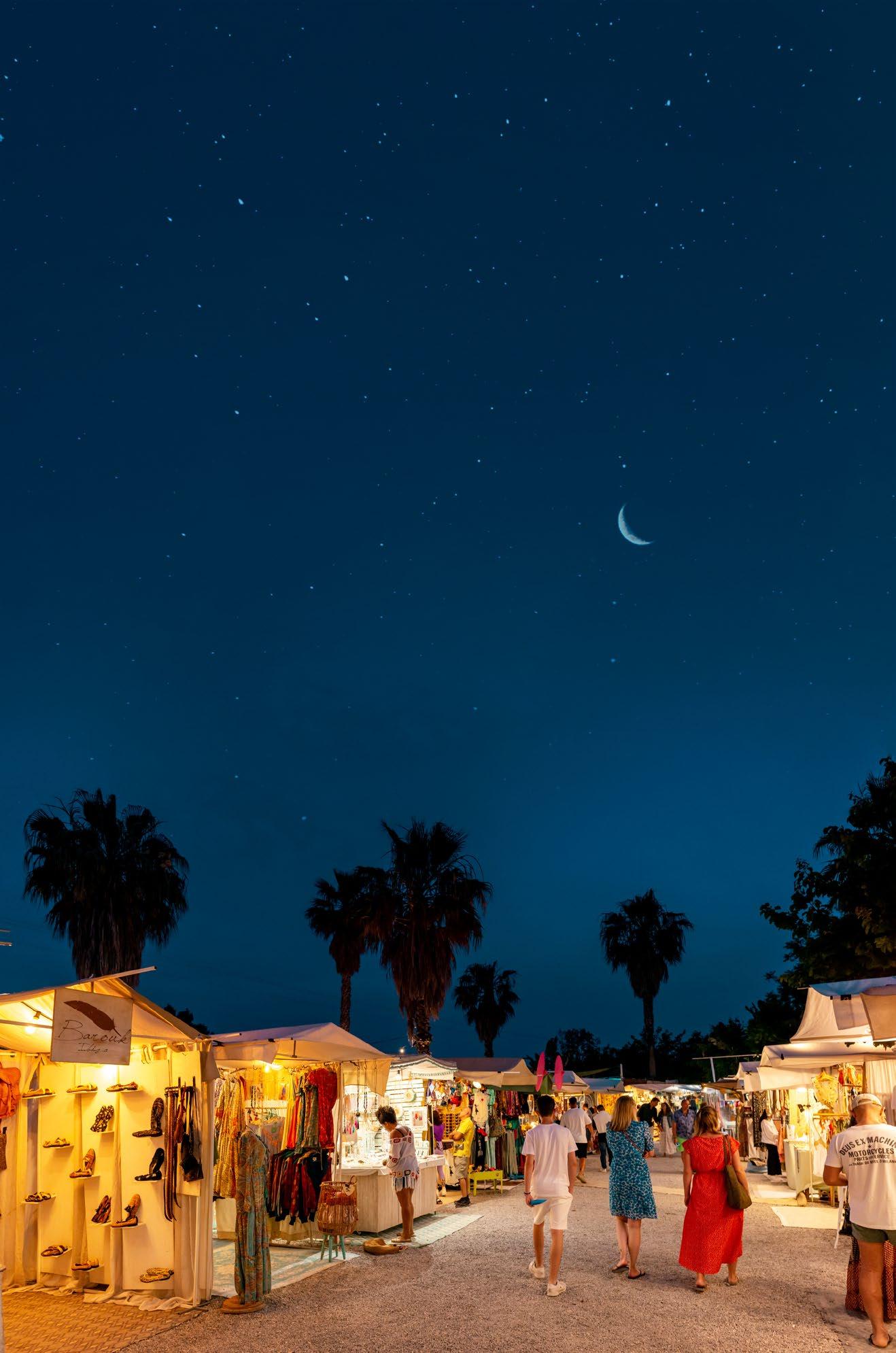
from June to September, a wondrous journey under the stars. +info lasdalias.es
from 18 h
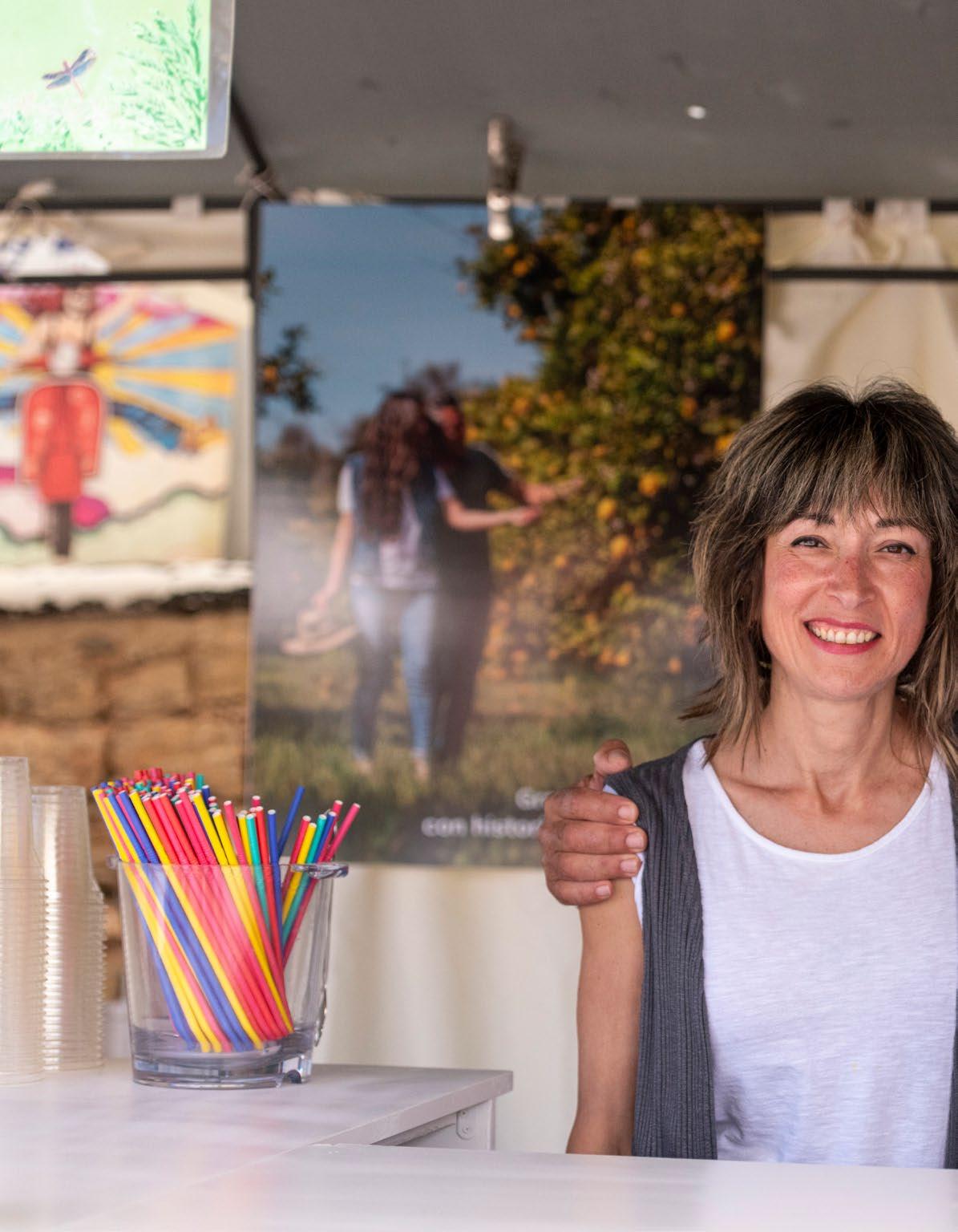
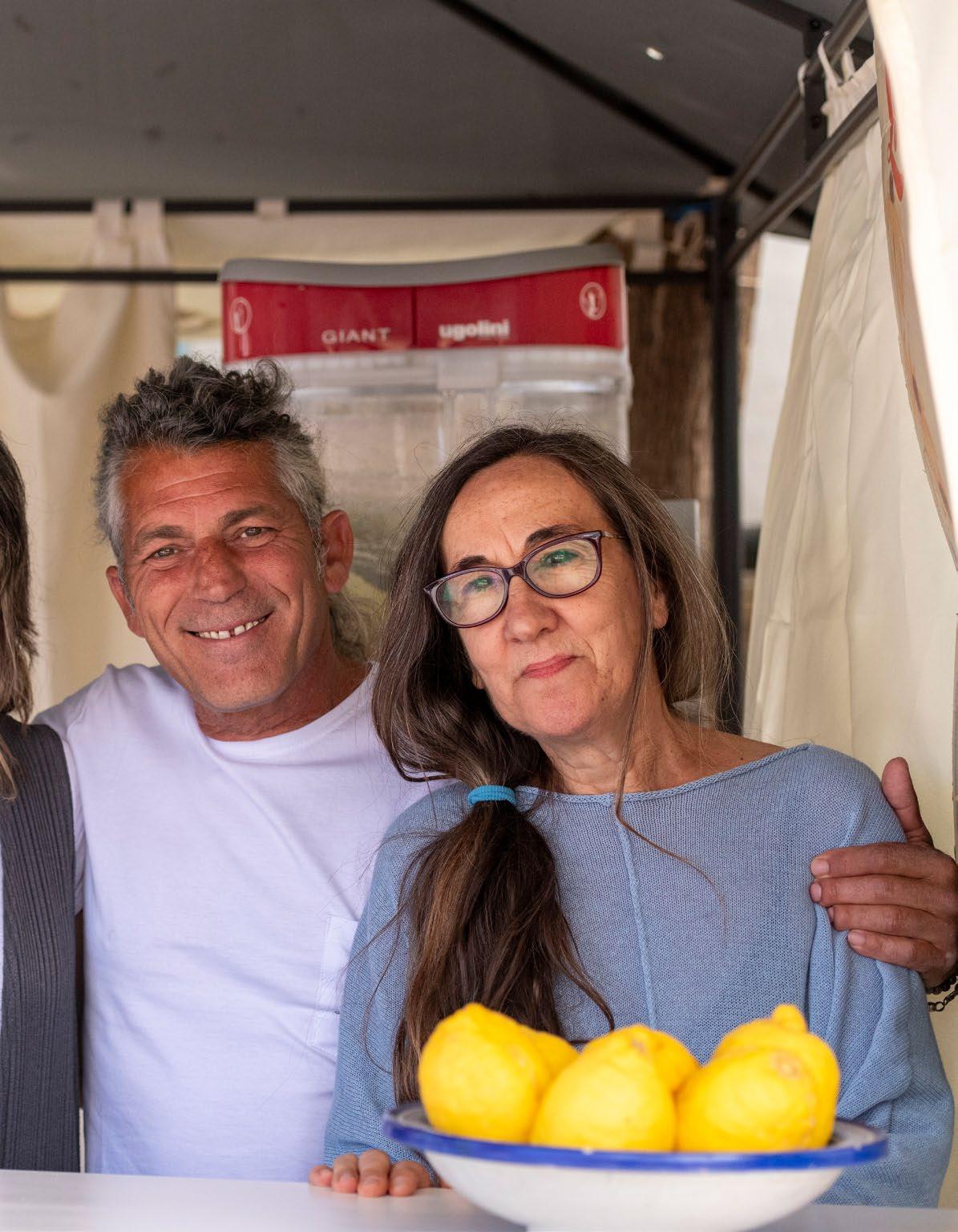
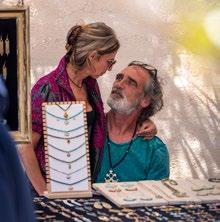

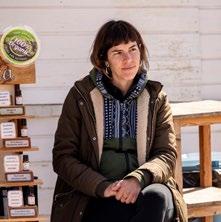

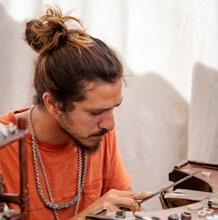



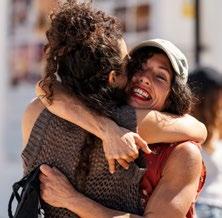



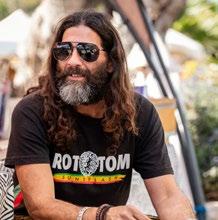









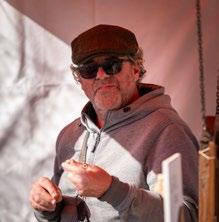
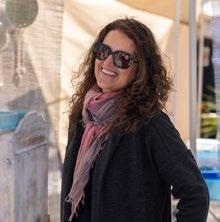

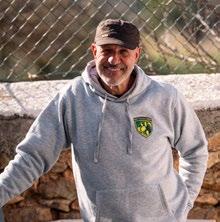


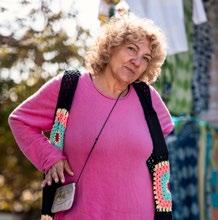




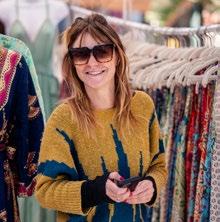


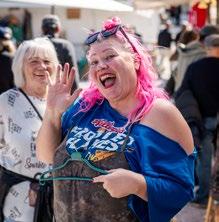
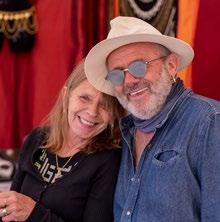

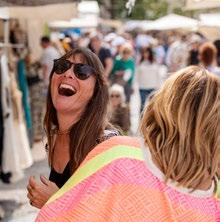

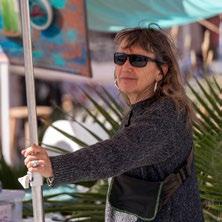



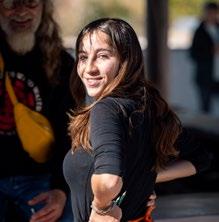


En este número, dedicado al Poder del amor, no podemos pasar por alto una efeméride bastante curiosa, y es que el Mercadillo abrió sus puertas un 14 de febrero, día de San Valentín, de 1985. Es decir, que su historia está, de algún modo, marcada por la fecha del amor por antonomasia.

Make love not war, es decir, Haz el amor, no la guerra es un lema que fue acuñado por primera vez por quienes se oponían a la Guerra de Vietnam. Muchos de los hippies que llegaron a Ibiza en los años 60 y que después encontraron en Las Dalias su punto de reunión y refugio, eran precisamente americanos huyendo de ser alistados en esa terrible guerra. Su espíritu pacifista y partidario del amor en un sentido amplio, alimentó el surgimiento del mercadillo.
Casi 40 años después, el amor lo vemos en las familias que se han formado en estas cuatro décadas y en las parejas que han encontrado el amor entre los puestos, en los conciertos o compartiendo tiempo en el jardín. Las Dalias ha sido marco de esos romances y también de otras formas y gestos de amor cotidiano como la solidaridad entre mercadilleros, el trato atento y detallista al cliente o la pasión que ponen los artesanos en sus creaciones únicas.
In this issue, dedicated to the Power of Love, we can’t overlook a rather curious coincidence: back in 1985, the street market first opened on the 14th of February - Valentine’s Day. In other words its history is, in a way, marked by the day of love par excellence.
Make love not war is a slogan that was first coined by opponents to the Vietnam War. Many of the hippies who came to Ibiza in the 1960s and who later found a meeting place and haven in Las Dalias were Americans fleeing from being enlisted in that terrible war. Their spirit of pacifism and support for love in the broadest sense of the word helped the street market to come about.
NOW, ALMOST 40 YEARS LATER, LOVE CAN BE SEEN IN THE FAMILIES THAT HAVE FORMED OVER THE PAST FOUR DECADES

Now, almost 40 years later, love can be seen in the families that have formed over the past four decades, as well as in the couples who’ve found love among the market stalls, at the concerts or by sharing some time in the garden. Las Dalias has been the setting for these romances as well as for other forms and expressions of everyday love, such as the solidarity between stallholders, the conscientious, meticulous way that customers are attended and the passion invested by the artisans in their unique creations.
A Juanito de Las Dalias le gusta hablar caro y huir de las mitificaciones. Por eso recuerda que este mercadillo comenzó por un fracaso. La galería de arte que habían montado a principios de los años 80 él y la galerista Helga Watson-Todd no generó ingresos —aunque sí muchas alegrías y una vinculación con el arte que nunca se ha roto—, de modo que tuvieron que pensar en otras ideas para revitalizar el bar y el restaurante. A Helga se le ocurrió montar un pequeño mercadillo y Juanito aceptó la propuesta, aun a sabiendas de que a su padre no le iba a hacer mucha gracia llenar el negocio de peluts, que es como se conocía a aquellos jóvenes melenudos.


Juanito from Las Dalias likes to be forthright and avoid hyperbole. That’s why he reminds us that the street market actually came about thanks to a flop. The art gallery set up by himself and gallery owner Helga Watson-Todd in the early 1980s had failed to make any money (although it did generate a lot of happiness and a link with art that has never been broken), so they had to think of other ways to revitalise the bar and restaurant. Helga came up with the idea of setting up a small street market and Juanito accepted, even though he knew that his father wouldn’t be very happy about filling up the business with peluts, as the long-haired youngsters were called.
Empezaron muy modestamente, con cinco puestos y sin la menor idea de que aquello se convertiría en lo que ha sido después. Nació y creció los primeros años en mitad de una vorágine un poco alocada y, con el tiempo, se ha profesionalizado, creando un equipo que ahora funciona como un reloj con un jefe que huye de los despachos y prefiere pisar la gravilla y mantener un trato directo, cordial y natural con todos los implicados en el engranaje.
A punto de cumplir 40 años, el Mercadillo de Las Dalias se ha consolidado como una experiencia ineludible en cualquier visita a Ibiza. Un vibrante punto de encuentro de locales y turistas en un marco único de colores, aromas y música. Tras este éxito hay mucho trabajo… y mucho amor.
They started out very modestly, with five stalls and without the slightest inkling that the market would become what it is today. It was born and grew, in the first few years, within the midst of a somewhat crazy maelstrom but it’s gradually become more professional, creating a team that now works like clockwork with a boss who avoids offices and prefers to get his hands dirty and keep up a direct, cordial and natural relationship with all those involved.
About to celebrate its 40th anniversary, Las Dalias street market has established itself as an unmissable experience during any visit to Ibiza. A vibrant meeting place for both locals and tourists in a unique setting of colours, aromas and music. Behind this success there’s a lot of hard work... and a lot of love.

SANT CARLES DE PERALTA
PARKING PRIVADO
PARKING PRIVADO
SANTA EULÀRIA DES RIU




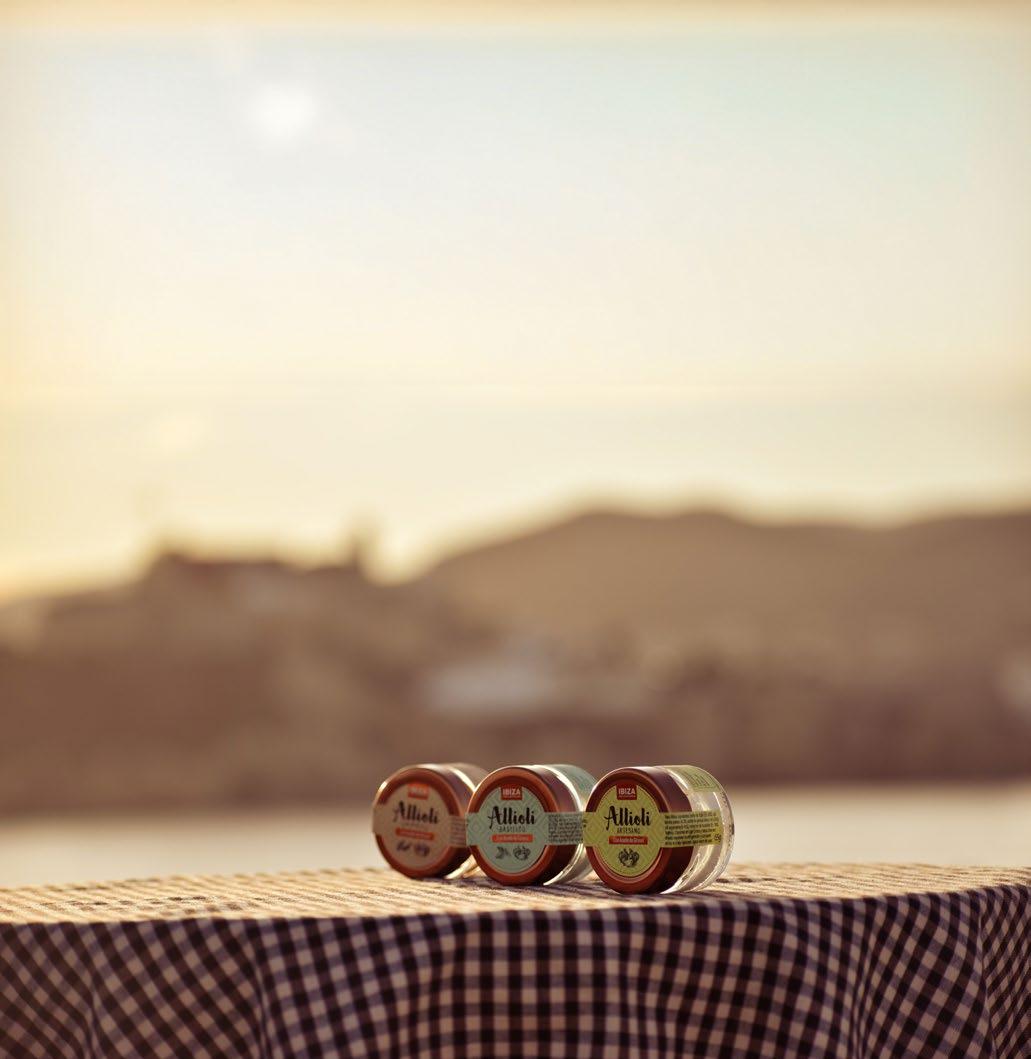
“PEACE MUST START FROM WITHIN THE HEART AND THE BEING”

El amor, la paz, la familia y el agradecimiento. Estos son los cuatro ejes en torno a los que giró el ritual más querido de Las Dalias: el Pago a la Tierra.
Peace, love, family and gratitude. These are the four cornerstones of the most beloved Las Dalias ritual: Giving Back to the Earth.
L.F.A. Ximena Topolansky / Arsen Voronyy T F


Cada año lo conduce con sabiduría María Valdivia, la ‘mujer medicina’, que siempre encuentra las palabras sencillas y exactas para tocar el corazón de todas las personas que se unen a esta magnética ceremonia.
Un ritual ancestral con el que Las Dalias da las gracias por una nueva temporada haciendo una ofrenda a la naturaleza en forma de frutos como el aceite, el vino, el arroz o las algarrobas del campo ibicenco. Una manera de corresponder a la madre tierra por todo su amor y generosidad: “Entregar a la tierra alimentos y entregar, a través de estos alimentos, nuestro corazón, es decirle gracias a la madre tierra por todo lo que tengo; por todo lo que he cosechado”.
LAS PALABRAS SENCILLAS Y EXACTAS PARA TOCAR EL CORAZÓN DE TODAS
LAS PERSONAS
Las reflexiones de Valdivia son una guía para quien quiera encontrar la paz y la espiritualidad en lo más cercano y sencillo: uno mismo y la naturaleza.


Each year, this celebration is led by the wisdom of Maria Valdivia, the ‘medicine woman’, who always finds the ideal, simple words to move the hearts of all who take part in this powerful ceremony.
VALDIVIA’S INSIGHTS ARE A USEFUL GUIDE FOR ANYONE WHO SEEKS PEACE AND SPIRITUALITY IN THE SIMPLEST AND MOST IMMEDIATE THINGS: ONESELF AND NATURE
Through this ancient ritual, Las Dalias gives thanks for a new season, with an offering to nature in the form of the fruit of the land, such as olive oil, wine, rice and the carob beans of the Ibizan countryside. This is a way to give back to Mother Earth for all her love and generosity: “By giving the earth food and giving our heart through those foods, we are expressing our gratitude to Mother Earth for all we have; for all that we have harvested”.
Valdivia’s insights are a useful guide for anyone who seeks peace and spirituality in the simplest and most immediate things: oneself and nature.









































FROM 02 JUN TO 29 SEP










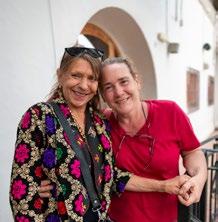



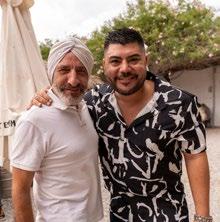
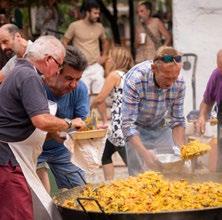





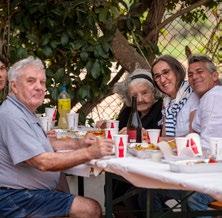




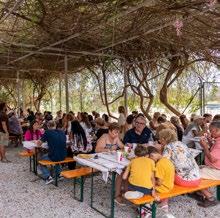

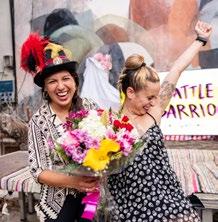



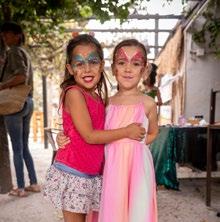
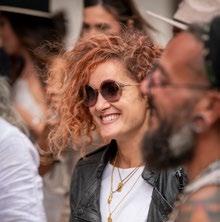










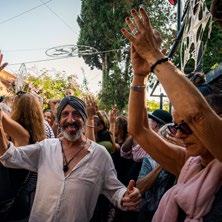

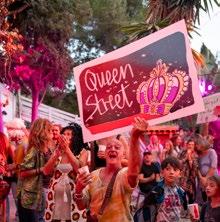

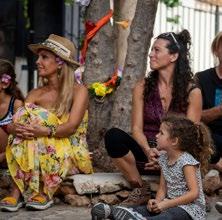

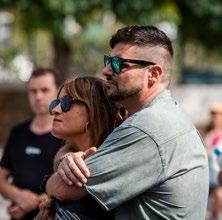




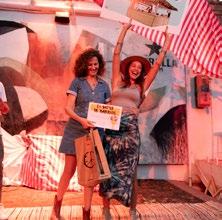


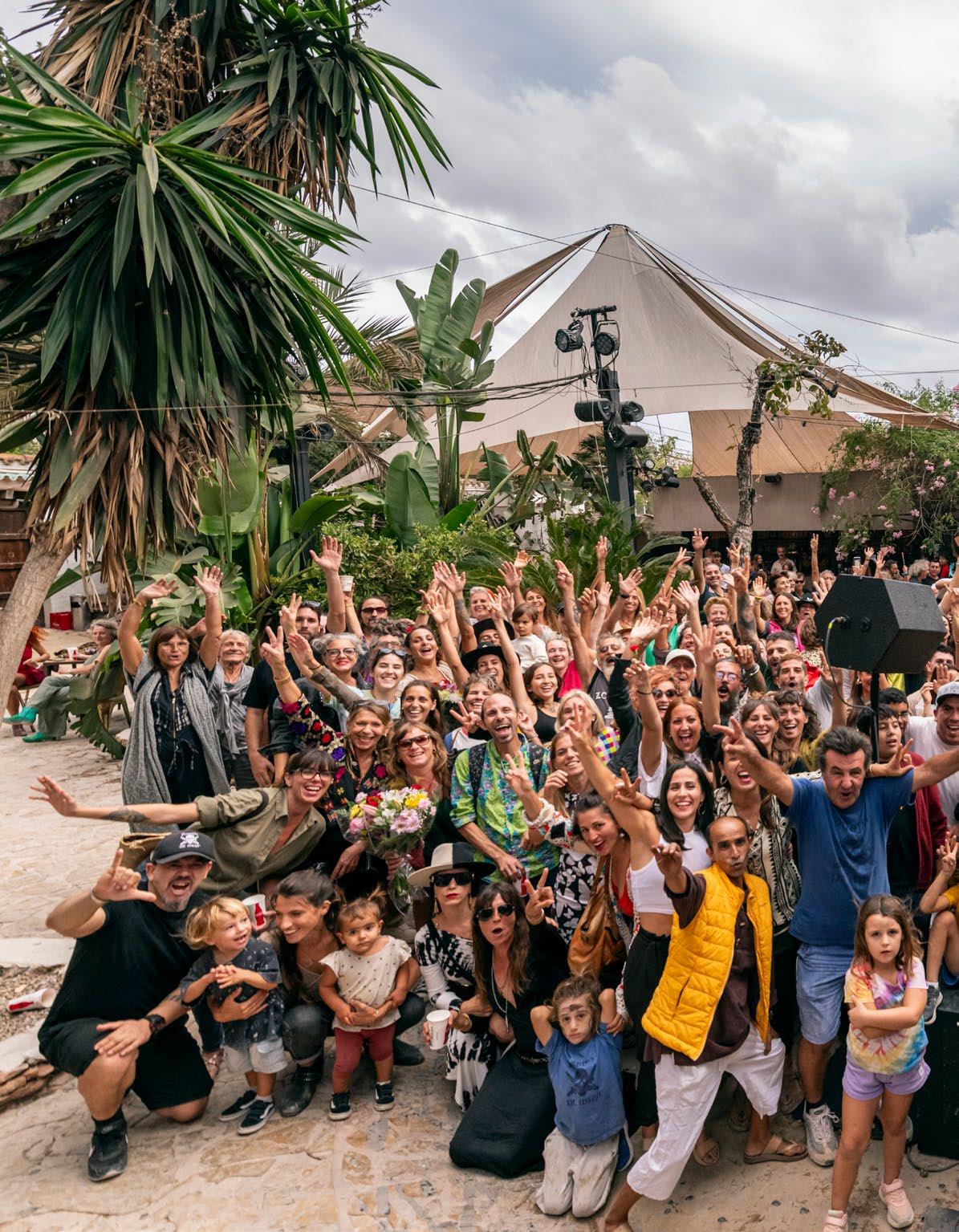

Dedicación, originalidad, perseverancia, el deseo de mejorar y la voluntad de ofrecer un producto único. Cada uno de los 400 mercadilleros, artesanos y artistas que forman parte de Las Dalias, tanto en el Mercadillo de Día como en los Night Markets, tiene algo especial que ofrecer a los visitantes. Cada uno de ellos no solo presenta su producto, sino también una historia única y un valor diferenciador que enriquece Las Dalias. Además, cada año, coincidiendo con el Family Day —el día en el que celebramos el final de la temporada y expresamos gratitud por pertenecer a esta próspera comunidad— se revelan los nombres de los ganadores como Mejores Puestos. Estos premios son especialmente emocionantes porque es el público de Las Dalias quien decide los ganadores mediante sus votos.
Dedication, originality, perseverance, the desire to improve and the willingness to offer a unique product. Each of the 400 market vendors, artisans and artists who are part of Las Dalias, in both the Day Market and the Night Markets, has something special to offer visitors. Each of them not only presents their product but also a unique story and a differentiating value that enriches Las Dalias. Moreover, every year, on Family Day—the day when we celebrate the end of the season and express gratitude for belonging to this thriving community—the names of the winners for Best Stands are revealed. These awards are particularly exciting because it is the Las Dalias attendees who decide the winners through their votes.


LAS ALMARITAS CAPTURE THE HEARTS OF LAS DALIAS VISITORS
Véronique Petit, Joss, Maï, Lena y Leon Le Turquais son Las Almaritas. Un puesto de artesanía totalmente familiar que lleva ya trece años formando parte de Las Dalias y que siempre ha estado entre los más valorados por el público. Maï responde en nombre de una familia que sigue creciendo.
—¿Cómo os hace sentir estar de nuevo entre los puestos más votados y, este año, además, en el número uno?
—¡Nos sentimos muy agradecidos! Es un gran honor recibir este premio trece años después de empezar esta aventura con Las Dalias. Hacemos lo que nos gusta y sentir el cariño de la gente es encantador.
Véronique Petit, Joss, Maï, Lena and Leon Le Turquais make up Las Almaritas. A fully family-run craft stall that has been part of Las Dalias for thirteen years and has consistently been highly valued by the public. Maï represents a family that continues to expand.
“How does it feel to once again be among the most voted stalls and, this year, to be in the number one spot?”
“We’re incredibly grateful! It’s a tremendous honour to receive this award thirteen years after embarking on this journey with Las Dalias. We do what we love, and feeling people’s warmth is truly delightful.”
—¿Es un puesto completamente familiar?
— Así es. Nuestra madre (Véronique ) y nosotras, las hijas, (Maï y Lena) llegamos a Ibiza en 2010 buscando un cambio de vida. Hoy somos una tribu con Leon, Joss y Noraan. Nos apoyamos entre nosotros y, cuando uno no puede, siempre está el otro para ayudarle.
—¿Cuál es la clave del éxito de Las Almaritas?
—Que cada persona puede elegir y participar en la creación de su propia pulsera o de su propio collar. Son piezas sencillas y pequeñas, con un precio accesible. Son mucho más que un objeto: Se las llevan grabadas con una palabra o una frase y los abalorios están cargados de significado, como la flor de la vida o el sol y la luna.
—Para muchas personas es su recuerdo de Ibiza, ¡no se quitan la pulsera en años!
—¡Sí! Y eso nos encanta. De hecho, mucho tiempo después regresa gente y nos enseña las pulseras que llevan desde hace años; a veces ya son apenas un hilo que cuelga pero no se la han quitado porque les recuerda ese viaje a Ibiza tan especial. Es algo mágico para nosotros porque viajamos con ellos a muchos lugares del mundo, siendo el recuerdo de Ibiza. Nos gusta preguntar a la gente de dónde es y a dónde van las pulseras… Estados Unidos, Holanda, Alemania… ¡Es tan lindo!
—En Las Almaritas hay que tomarse un rato, desacelerar el ritmo frenético y pararse a crear…
—Claro. Nunca hemos venido al mercadillo con la idea de ‘vamos a hacer dinero’. No. Lo que nos gusta es crear cosas con la gente, pasándolo bien. Eso es parte de la magia. La gente nota que estamos dispuestos a disfrutar del momento en su compañía.
–Recibís este premio cuando se cumple el 70 aniversario de Las Dalias, ¿es algo especial para la familia?
—Mucho. Estamos muy agradecidos de poder formar parte de este 70 aniversario de Las Dalias con Juanito, su hermana Lucía, su madre y el recuerdo del abuelo… Una familia que lleva tantos y tantos años poniendo amor en este lugar. Si estamos en Ibiza y podemos vivir aquí es gracias a Las Dalias.
“Is it entirely a family-run stall?”
“That’s right. Our mother (Véronique) and us, the daughters (Maï and Lena), arrived in Ibiza in 2010 seeking a change of pace. Today, we form a tribe with Leon, Joss and Noraan. We lean on each other, and when one can’t, there’s always someone else to lend a hand.”
“What’s the secret to Las Almaritas’ success?”
“That each individual can choose and take part in creating their own bracelet or necklace. They’re simple, small pieces, priced affordably. They’re more than just objects: They’re taken away engraved with a word or phrase, and the beads are imbued with meaning, like the flower of life or the sun and moon.”
“For many people, it’s their memory of Ibiza; they keep the bracelet on for years!”
“Exactly! And we love that. In fact, long after, people come back and show us the bracelets they’ve been wearing for years; sometimes they’re barely hanging on by a thread, but they haven’t taken them off because it reminds them of that very special trip to Ibiza. It’s something magical for us because we travel with them to many places around the world, carrying the memory of Ibiza. We enjoy asking people where they’re from and where the bracelets are going... the United States, the Netherlands, Germany... It’s so lovely!”
“At Las Almaritas, you have to take your time, slow down the frantic pace, and stop to create...”
“Exactly. We’ve never come to the market with the idea of “let’s make money”. No. What we enjoy is creating things with people, having a good time. That’s part of the magic. People notice that we’re willing to enjoy the moment with them.”
“You’re receiving this award as Las Dalias celebrates its 70th anniversary; is this something special for the family?”
“Very much so. We’re very grateful to be part of this 70th anniversary of Las Dalias with Juanito, his sister Lucía, his mother and the memory of the grandfather... A family that has been putting love into this place for so many years. If we’re in Ibiza and can live here, it’s thanks to Las Dalias.”

ILUMINA, THE STALL THAT MESMERISES WITH ITS LAMPS
MADE OF IBIZA WOODS AND MINERALS
Philippe Depardiu, chileno, ha tomado las riendas de Ilumina, que lleva solo dos años en Las Dalias y las dos temporadas ha resultado premiado entre los tres primeros puestos. No está nada mal. “Desde luego no lo esperaba, me hace sentir muy bien”, confiesa Philippe.
—Dos años y dos podios. ¿Cuál es el secreto de Ilumina?
—¡Las ganas de vender que tengo! [bromea] Es un producto único y eso a la gente le llama mucho la atención. Utilizo maderas autóctonas de la isla, de sabina y olivo, combinadas con minerales energéticos translúcidos, que dejan pasar la luz, como la amatista, la fluorita, el cuarzo rosa y ahumado, la calcita verde, amarilla y naranja… casi todos procedentes de India y Brasil.
Philippe Depardiu, from Chile, has taken the reins of Ilumina, which has been in Las Dalias for only two years and has been awarded among the top three positions for both seasons. Not bad at all. “I certainly didn’t expect it; it makes me feel very good,” Philippe confesses.
“Two years and two podiums. What’s Ilumina’s secret?”
“The desire to sell that I have! [he jokes] It’s a unique product, and that really catches people’s attention. I use native woods from the island, such as juniper and olive, combined with translucent energetic minerals that let light through, such as amethyst, fluorite, rose quartz and smoky quartz, green, yellow and orange calcite... almost all coming from India and Brazil.”
—¿De modo que no solo son lámparas decorativas sino energéticas?
—Exacto, tienen la energía y las propiedades de los minerales. Hacemos combinaciones para dormir y descansar, para el equilibrio mental, protectoras de energía, para eliminar las malas energías del hogar...
—Y los visitantes qué valoran más: ¿la estética o las propiedades?
—Hay gente que solo se fija en la estética y otra solo en las propiedades, pero hay personas que valoran ambas. De modo que es un trabajo que exige hablar con el cliente y de esa interacción también se explica el cariño de los visitantes.
—Y, además de vender, ¿qué es lo que más disfrutas?
—De la energía de mis compañeros y el apoyo de Juanito y de Isabel, que siempre están guiándonos. Isabel, por ejemplo, nos aconsejó sobre la estética del puesto, que antes era mucho más oscuro y ahora los resultados son mucho mejores.
—En los Night Markets el puesto de Ilumina es de los más llamativos, precisamente por la luz.
—No es raro escuchar un ¡guau! cuando lo ven y eso nos encanta.
—Feliz entonces de formar parte de esta familia de 70 años.
—Mucho. Cuando yo vine a postular para un puesto, la gente me decía: ¡Olvídate! Porque hay una lista de espera de dos años para entrar. Pero cuando les enseñamos nuestro producto les gustó tanto que nos dieron un espacio. Eso nos hace muy felices. Es nuestro escaparate más grande, de eso no hay ninguna duda. Gracias a ellos nos han conocido fuera de España e incluso hacemos encargos.
“So, these aren’t just decorative lamps but also carry energy?”
“Exactly, they possess the energy and properties of minerals. We create combinations for sleep and relaxation, for mental equilibrium, as energy shields, to dispel negative energies from the home...”
“And what do visitors value more: the aesthetics or the properties?”
“Some people focus solely on aesthetics, while others solely on properties, but there are those who appreciate both. So, it’s a job that involves engaging with customers, and through that interaction, the visitors’ fondness is also explained.”
“And besides selling, what do you enjoy the most?”
“The camaraderie of my colleagues and the support from Juanito and Isabel, who always guide us. For instance, Isabel offered her advice on the stall’s aesthetics, which used to be much darker, and I get much better results now.”
“In the Night Markets, Ilumina’s stall stands out, especially due to its lighting.”
“It’s quite common to hear a “wow!” when they see it, and we’re thrilled by that.”
“So, you’re happy to be part of this 70-year-old family.”
“Absolutely. When I applied for a stall, people would say: Forget it! Because there’s a two-year waiting list to get in. But when we showed them our product, they liked it so much that they gave us a space. That brings us immense joy. It’s our grandest display, without a doubt. Thanks to them, we’ve gained recognition beyond Spain, and we even receive orders.

IMAGINATIVE ARTESANO, STONES WITH HEART AND FANTASY
Edyta Gaça, de Polonia, y Cristhian Gracia, de Colombia, son la pareja que forma Imaginative Artesanos. Atesoran ya tres premios del público de Las Dalias en los ocho años que llevan en el mercadillo.
—¿Por qué cree que, de entre 400 puestos, los visitantes se han fijado en ustedes?
—Por el trabajo artístico y artesanal que ofrecemos y la atención a los detalles. Siempre estamos tratando de que las piezas queden lo mejor posible, con mucho cariño y detalle.
—¿La gente visita el puesto como quien recorre una galería de arte?
—Sí, hay gente que aprecia el trabajo y es una gran satisfacción. Nos quedamos siempre con el interés que despiertan las piezas.
Edyta Gaça, from Poland, and Cristhian Gracia, from Colombia, are the duo behind Imaginative Artesano. They’ve already garnered three awards from the Las Dalias public in the eight years they’ve been at the market.
“Why do you think, among 400 stalls, visitors have noticed you?”
“It’s because of the artistic and artisanal work we offer, along with the attention to detail. We’re always striving to ensure the pieces are the best they can be, with meticulous care.”
“Do people visit the stall as if they were browsing an art gallery?”
“Yes, some people appreciate the craftsmanship, and it’s incredibly fulfilling. We always value the interest the pieces evoke.”
—¿Y los materiales?
—Empleamos madera de pino para la base, y creamos con piedras, cristales y azulejos que encontramos en la playa. Lo complementamos dibujando sobre la piedra.
—Algunas piezas son más decorativas y otras más humorísticas o poéticas…
—Así es, en unas destaca más la composición de las piedras que la pintura que llevan. Es un trabajo de imaginación.
Tenemos piezas para niños, adultos, parejas y tienen gran éxito las dedicadas a las profesiones: médicos, dentistas, fisioterapeutas...
—¿Cualquier piedra es un potencial cuadro?
—Sí. Y si no lo vemos en el momento, después buscaremos su sentido. Después de ocho años ya tenemos ideas muy claras pero, en otros momentos, nos tomamos un tiempo para imaginar nuevos diseños y crear de la nada.
—¿A lo largo de los años han comprobado que hay ideas que funcionan más que otras?
—Sí. Desde el principio han gustado muchos los diseños de parejas bajo la luna, porque es como un escenario ideal, de noche, amor, pareja, quietud… y otros los hemos retirado porque ya no funcionaban igual, como unos que teníamos inspirados en la serie Walking dead, que se llamaba Walking dad y llamaban mucho la atención. Al pasar de moda la serie ya ha desaparecido el interés. Es divertido porque vas imaginando cosas nuevas y vas cambiando cosas a lo largo del tiempo.
—¿Qué significa para vosotros formar parte de la gran familia de Las Dalias en su 70 aniversario?
—Estamos muy agradecidos, no solo porque nos han dado la oportunidad de tener un puesto aquí sino porque nos han ayudado a crecer. Empezó como algo muy pequeño y con el apoyo de Isabel, Lucía, Juanito y de todos nos han hecho evolucionar artísticamente. Estar en el 70 aniversario es un orgullo. Estar en un lugar tan reconocido a nivel mundial es estupendo para nosotros.
“And the materials?”
“We use pine wood for the base and create with stones, crystals and tiles that we find on the beach. We enhance them by drawing on the stone.”
“Some pieces are more decorative, while others are more humorous or poetic...”
“That’s correct, in some, the composition of the stones shines more than the painting they carry. It’s a product of imagination. We offer pieces for children, adults, couples, and those dedicated to professions are particularly successful: doctors, dentists, physiotherapists...”
“Is any stone a potential canvas?”
“Absolutely. And if we don’t see it at the moment, we’ll search for its meaning later. After eight years, we already have very clear ideas, but sometimes we take time to envision new designs and create from scratch.”
“Have you found over the years that some ideas work better than others?”
“Absolutely. From the start, designs of couples under the moon have been popular because it’s like an ideal setting: night-time, love, couple, stillness... and others we’ve phased out because they didn’t have the same appeal anymore, like some inspired by the Walking Dead series, called Walking Dad, which garnered a lot of attention. As the series fell out of fashion, so did the interest. It’s enjoyable because you’re constantly imagining new things and evolving over time.”
“What does it mean for you to be part of the big Las Dalias family on its 70th anniversary?”
“We’re very grateful, not only because they’ve given us the opportunity to have a stall here but also because they’ve helped us grow. It started as something very small, and with the support of Isabel, Lucía, Juanito and everyone, they’ve helped us evolve artistically. Being part of the 70th anniversary is a source of pride. Being in such a globally recognised place is fantastic for us.”

L.F.A.
Ximena Topolansky T F
El Mercadillo de Las Dalias es un lugar muy peculiar. Si piensas que se trata tan solo de decenas de puestos colocados aquí o allá en función de motivos peregrinos tenemos que decirte que ¡en absoluto!
Todo está muy bien pensado y organizado. De tal modo que hay zonas con mercadilleros y artesanos bastante fijos que, a lo largo de las temporadas, crean estrechos vínculos y se ayudan. Uno te deja una pinza para el toldo, el otro te presta el datáfono, uno te acerca un café y el otro simplemente te escucha cuando la jornada se hace más dura bajo el sol de agosto.
Echándole humor y desenfado, los mercadilleros han creado unos ‘barrios’ que dan nombre a esas zonas que
The Las Dalias flea market is a very unique place. If you think it’s just a few dozen stalls positioned here and there based on a bunch of whimsical motifs, we’ve got news for you: not at all!
Everything is very thoroughly planned and organised. This means that there are areas with quite permanent vendors and craftspeople who have developed close alliances over the course of many seasons and who help each other out. One will lend you a clip for your canopy, another will lend you a payment terminal, someone else will bring you a coffee and yet another will simply listen to you when you’re having a tough day under the August sun.
With humour and a light-hearted spirit, the vendors have created barrios, or ‘neighbourhoods’ with names for the areas
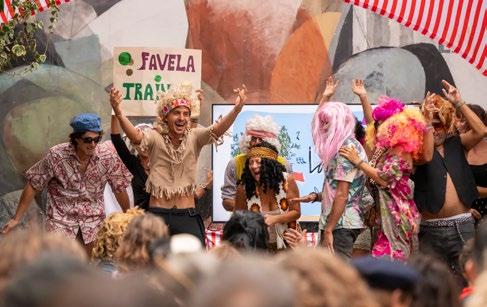

comparten durante tantos meses. Al igual que en un vecindario, los mercadilleros de cada barrio se ayudan, hacen sus mejoras y también tienen sus reivindicaciones.
Y, como no podía ser de otro modo, surge la competencia. Todo esto confluyó en la divertida Batalla de Barrios del Family Day, el día de celebración del final de la temporada alta.
Tras la ceremonia del Pago a la Tierra y tras degustar una paella para 400 invitados cada barrio mostró un vídeo en el que definía su idiosincrasia. El humor y la calidad de la edición del vídeo del barrio conocido como ‘El Sahara’ se llevó el premio del jurado, pero todos los trabajos merecieron el aplauso del resto de compañeros y compañeras.
‘La Favela’, ‘Los Ángeles de Nacho’, ‘El Torrente’, ‘Calle lo Más’, ‘Soul Bar’, ‘La Calle de la Vida’, ‘Barrio Alto’, ‘Queen Street’, ‘Los Zumos’ y ‘El Jardín del Edén’ son los barrios de este clan de artesanos que sabe que, con humor y compañerismo, la temporada se sobrelleva mucho mejor.
El divertido monólogo de Txaro Kandler puso la guinda a un día muy divertido para agradecer la temporada, reír y disfrutar de la gran familia Dalias.


that they share for so many months at a time. Much like what you might see in a real neighbourhood, the stallholders in each of these barrios help each other, they make their improvements and they also have their demands.
And, as can be expected, competition arises. All this came together at the fun-filled ‘Battle of the Barrios’ on Family Day, the day of celebration that marked the end of the high season.
After the Giving Back to the Earth ceremony and a paella for 400 guests, each neighbourhood presented a video that defined its specific idiosyncrasy. Thanks to its humour and the quality of its editing, the video of the neighbourhood known as ‘El Sahara’ won the award of the judges’ panel, yet all the entries were deserving of everyone’s applause.
‘La Favela’, ‘Los Ángeles de Nacho’, ‘El Torrente’, ‘Calle lo Más’, ‘Soul Bar’, ‘La Calle de la Vida’, ‘Barrio Alto’, ‘Queen Street’, ‘Los Zumos’ and ‘El Jardín del Edén’ are the neighbourhoods of this clan of artisans who fully understand that with humour and companionship, the season is so much easier.
Txaro Kandler’s amusing monologue rounded off a fun day of gratitude for the season, laughter and enjoyment for the great Las Dalias family.
Ibiza es un lugar especial, de eso no cabe duda, y hay muchas razones que lo explican. La esencial es que cobija a personas de prácticamente todas las nacionalidades del mundo, cada una con su historia; cada una con sus vivencias, sabiduría y filosofía.
Las Dalias On Stage, una serie de entrevistas a personajes de la isla, invita compartir esas vivencias con el resto del mundo a través de unas conversaciones pausadas y distendidas donde hay tiempo para escuchar y aprender mucho de cada personaje, pero también de la historia de la isla… y de esas anécdotas que solo pasan en Ibiza.
Voces de dentro y de fuera de Las Dalias como David Benito, María Valdivia, Diego Calvo, Maria Àngels Ferrer, Carlos Martorell, Laurent Nobileau, Clara Mantel, Sebastián Cardona, Puchi Tibet o el propio Juanito de Las Dalias han pasado por los micrófonos de esta propuesta, entrevistados por Emil Montgomery.
La intención de este proyecto ha sido comunicar internacionalmente todo lo que sucede en Las Dalias y también en Ibiza, para que se entienda que este lugar no es solo un sitio para turistas o de paso sino que contribuye a generar cultura, espiritualidad y arte, a la vez que valora las tradiciones y se ha erigido en templo musical para la comunidad ibicenca.
Algunas de las entrevistas ya se pueden disfrutar online. Sorprendentes, inspiradoras o simplemente entretenidas, todas ellas tienen algo que las hace plenamente disfrutables.
Ibiza is undeniably special, with numerous reasons to support this claim. Its essential charm lies in its ability to embrace people from nearly every nationality, each with their own story, experiences, wisdom and philosophy.
Las Dalias On Stage, a series of interviews with individuals from the island, invites us to share these experiences with the world through unhurried and relaxed conversations. Here, there is ample time to listen and learn from each character, as well as from the island’s history and the unique anecdotes that only occur in Ibiza.
Voices from both inside and outside Las Dalias, including David Benito, María Valdivia, Diego Calvo, Maria Àngels
Ferrer, Carlos Martorell, Laurent Nobileau, Clara Mantel, Sebastián Cardona, Puchi Tibet and Juanito from Las Dalias, have graced the microphones of this series, interviewed by Emil Montgomery.
The aim of this project has been to globally convey everything that unfolds in Las Dalias and Ibiza, emphasising that this place is not merely a tourist destination or transient stop, but a hub that fosters culture, spirituality and art. It also cherishes traditions and has evolved into a musical sanctuary for the Ibiza community.
Some interviews are already available to enjoy online. Whether surprising, inspiring or simply entertaining, each interview has a unique quality that makes it thoroughly enjoyable.
Todas las entrevistas en:


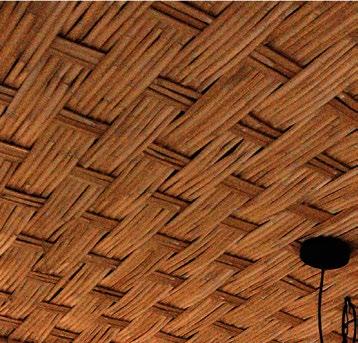

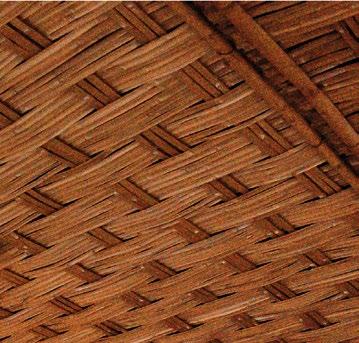





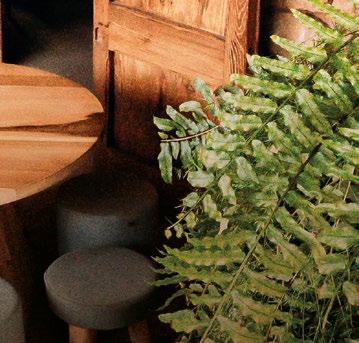
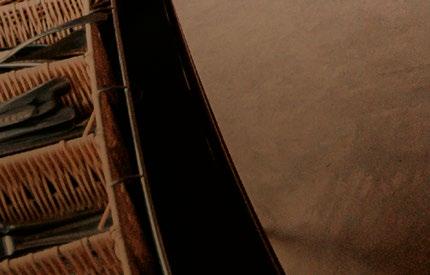



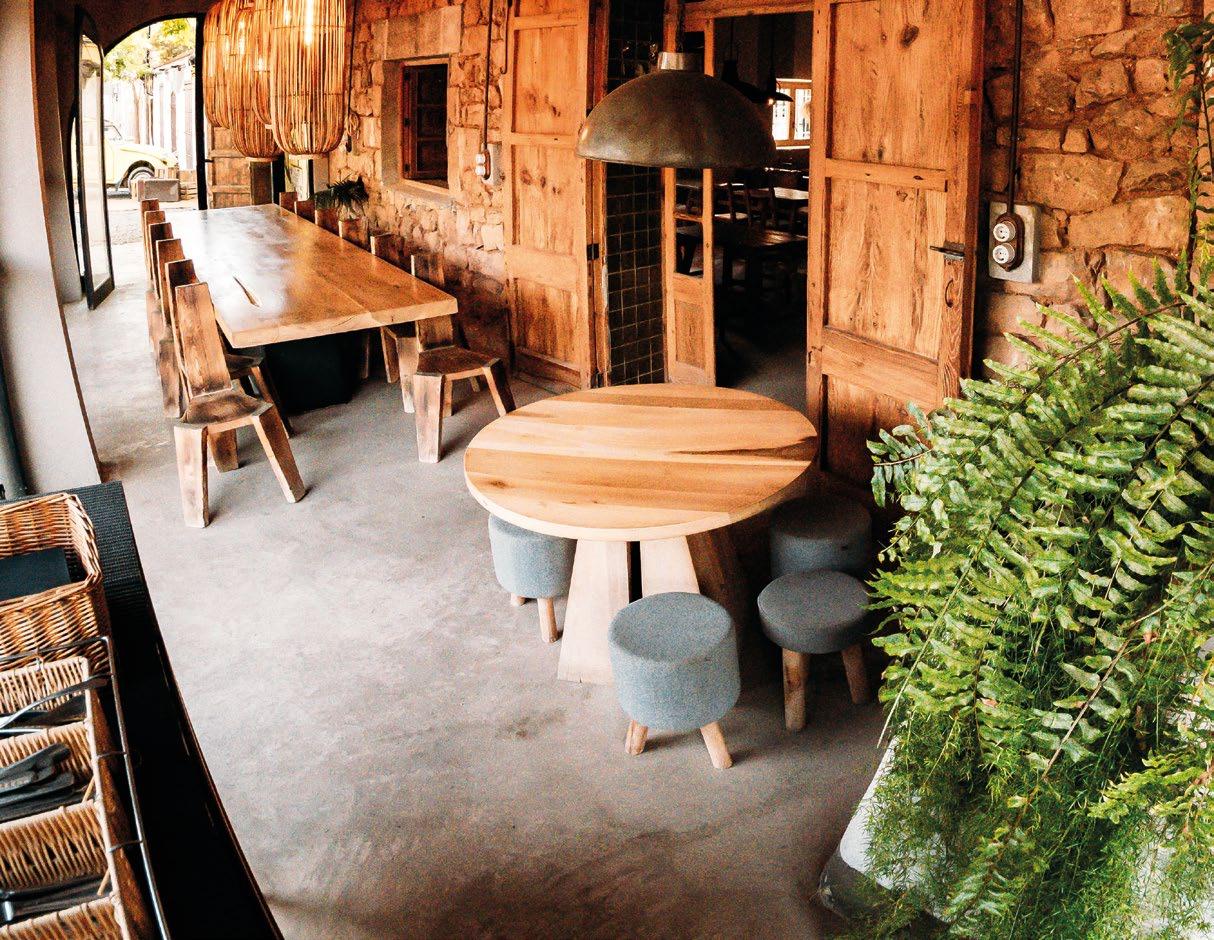
Es un sábado por la mañana de invierno y un grupo de visitantes de cierta edad curiosea por el jardín exterior de Las Dalias mientras espera a que llegue el autobús de vuelta al hotel. Son turistas del Imserso, el programa español de vacaciones para las personas mayores. Se han parado, sorprendidos, delante de las piezas de Paulo Viheira que emergen entre la flora autóctona de este rincón de naturaleza y arte.
—A mí esta escultura me parece como de los indios americanos.
—Sí, es verdad, y esta otra tiene mucho color, me gusta mucho. Es como un retablo de Iglesia. Me transmite alegría
La conversación, cazada al vuelo, capta perfectamente el espíritu del Jardín Más Artístico de Las Dalias: que el arte salga al encuentro del visitante.
Un proyecto que se puso en marcha en 2023 y que no hace sino confirmar el compromiso de Las Dalias con el arte desde sus inicios, hace 70 años. Este lugar no solo ha acogido a músicos, escritores, filósofos, cantantes, actrices y actores sino que ha sido espacio y mecenas del arte al albergar una galería en los años 80, exposiciones periódicas en los años 90 y, más recientemente, dando espacio a LiberArte, una maravillosa experiencia de creación libre.
It’s a winter Saturday morning and several visitors of a somewhat advanced age wander around the outside garden of Las Dalias while waiting for the bus that will take them back to the hotel. These visitors have come over with Imserso, a Spanish holiday programme for senior citizens. With wonder, they have stopped in front of Paulo Viheira’s art pieces that emerge from among the local flora in this little corner of nature and art.
—I think this sculpture looks like it was made by American Indians.
—Yeah, that’s true, and this other one is really colourful. I quite like it. It’s like a church altarpiece. It gives off a sense of joy.
Overheard on the fly, this conversation impeccably sums up the spirit of the Las Dalias Jardín Más Artístico: the art comes out to meet the visitor.
Launched in 2023, this project is further evidence of the Las Dalias commitment to art, which dates from the institution’s origins, 70 years ago. Not only has Las Dalias hosted musicians, writers, philosophers, singers and actors, it has also served as a venue and a sponsor of art, housing a gallery in the 1980s, hosting periodic exhibitions in the 1990s, and more recently, providing space for LiberArte, a wonderful free-creation experience.
El Jardín Más Artístico ya se puso en marcha hace 30 años y ahora se ha recuperado con obra de Paulo Viheira, que irá dando paso a la de otros creadores.
La obra de este artista brasileño afincado en Ibiza es absolutamente reconocible y llena de personalidad. Desde su taller crea piezas que conforman un universo propio, cálido y colorista, como tan bien supieron ver esos turistas, gracias al uso de la madera de cedro y a la pintura en bloques de color. Un color que distingue sus obras, en las que el predominio de la figura humana, el amor por la naturaleza y la devoción por la isla de Ibiza son protagonistas.

Esculturas, pinturas, tallas y murales conforman buena parte de la obra del autor, de la que podemos ver una muestra en el Jardín Más Artístico.
The Jardín Más Artístico began 30 years ago and has recently been recovered with the works of Paulo Viheira, which will gradually be making way for other artists.
THE COORDINATOR OF THIS PROJECT, ISABEL LAMBOUR, REMINDS US THAT THE GOAL IS TO PROVIDE “VISIBILITY TO THE WORKS OF IBIZA’S MOST CREATIVE AND INNOVATIVE PEOPLE”
The work of this Brazilian-born Ibiza-based artist is absolutely identifiable and full of personality. As aptly noted by the visitors, in his studio, he uses cedar wood and blocks of colour to create pieces that form a warm, colourful universe of their own. Indeed, colour is the hallmark of his works, which give centre stage to the human figure, a love of nature and a passion for the island of Ibiza.
Sculptures, paintings, carvings and murals make up the bulk of this artist’s work, a sampling of which can be seen in the Jardín Más Artístico.
The coordinator of this project, Isabel Lambour, reminds us that the ultimate goal is to provide something as important as “visibility to the works of Ibiza’s most creative and innovative people”, who often find it difficult to display their pieces in public.
SE HA RECUPERADO CON LA OBRA DE PAULO VIHEIRA
La coordinadora del proyecto es Isabel Lambour, que recuerda que el objetivo último es ofrecer algo tan importante como “visibilidad al trabajo que realizan las personas más creativas y creadoras de Ibiza” y que no siempre tienen fácil mostrar su trabajo al público.
Una simbiosis en la que todos salen ganando porque Las Dalias sabe que dar espacio al arte es abrir compuertas a la multiculturalidad y a todos los universos que caben en esta isla. Y lo más importante: que el arte salga a la calle, que salga al encuentro de la gente, que lo vean como algo cercano, asequible y estimulante. Estimular, finalmente, eso que llamamos ‘amor al arte’.

A symbiosis where everyone wins, as Las Dalias understands that providing a space for art means opening the floodgates to multiculturalism and to all the worlds that find their place on this island. And most importantly, by allowing art to come out into the street to meet the people, art itself becomes approachable, accessible and stimulating. In a word, to promote what we at Las Dalias like to call the ‘love of art’.
AND LAS DALIAS, A STORY OF LOVE AND MUTUAL
Las Dalias lleva 70 años trabajando día a día con amor y pasión por lo suyo en todas las facetas: mercadillo, restauración, bar… Un trabajo que no busca más reconocimiento que el del cliente pero que, a lo largo del tiempo, ha recogido también el cariño de instituciones públicas, privadas y empresas que han valorado con premios y reconocimientos ese tesón y esas ganas de querer hacerlo siempre lo mejor posible. El más reciente de todos ha sido el Premio de Honor de Etalentum 2023 a Juan Marí, Juanito de Las Dalias.
La empresa de selección de personal Etalentum reconoce a aquellas organizaciones que practican las mejores políticas de recursos humanos y el Premio de Honor recayó en Juan Marí. En su discurso, Juanito recordó los inicios de Las Dalias, que se ha convertido en un icono de la isla de Ibiza, visitado por 35.000 personas cada semana y con una plantilla de 100 trabajadores.
Las Dalias recibió en 2018 el Premio Diario de Ibiza a la Innovación Empresarial, un galardón que reconoce la trayectoria de esta casa y que recibió Juanito, en el transcurso de la gala conmemorativa del 125 aniversario del periódico.
Each day over the last 70 years, Las Dalias has been putting its love and passion into every aspect of its work, from the flea market, to its restaurants, its bar, and much more. Although this work has sought only the recognition of its customers, over time Las Dalias has also received the love and appreciation of public and private institutions and companies, which have honoured and awarded it for itst drive and determination to always do its very best. The most recent of all those awards was the 2023 Etalentum Honour Award to Juan Marí, “Juanito” of Las Dalias.
The staff recruitment company Etalentum celebrates the organisations with the best human resources policies, and in 2023 the Honour Award went to Juan Marí. In his speech, Juanito recalled the beginnings of Las Dalias, which has become an icon of Ibiza, receiving 35,000 visitors each week, with a staff of 100 workers.
In 2018, Las Dalias received the Diario de Ibiza Business Innovation Award, in recognition of the company’s long history. Juanito was presented the award at the newspaper’s 125th anniversary gala.
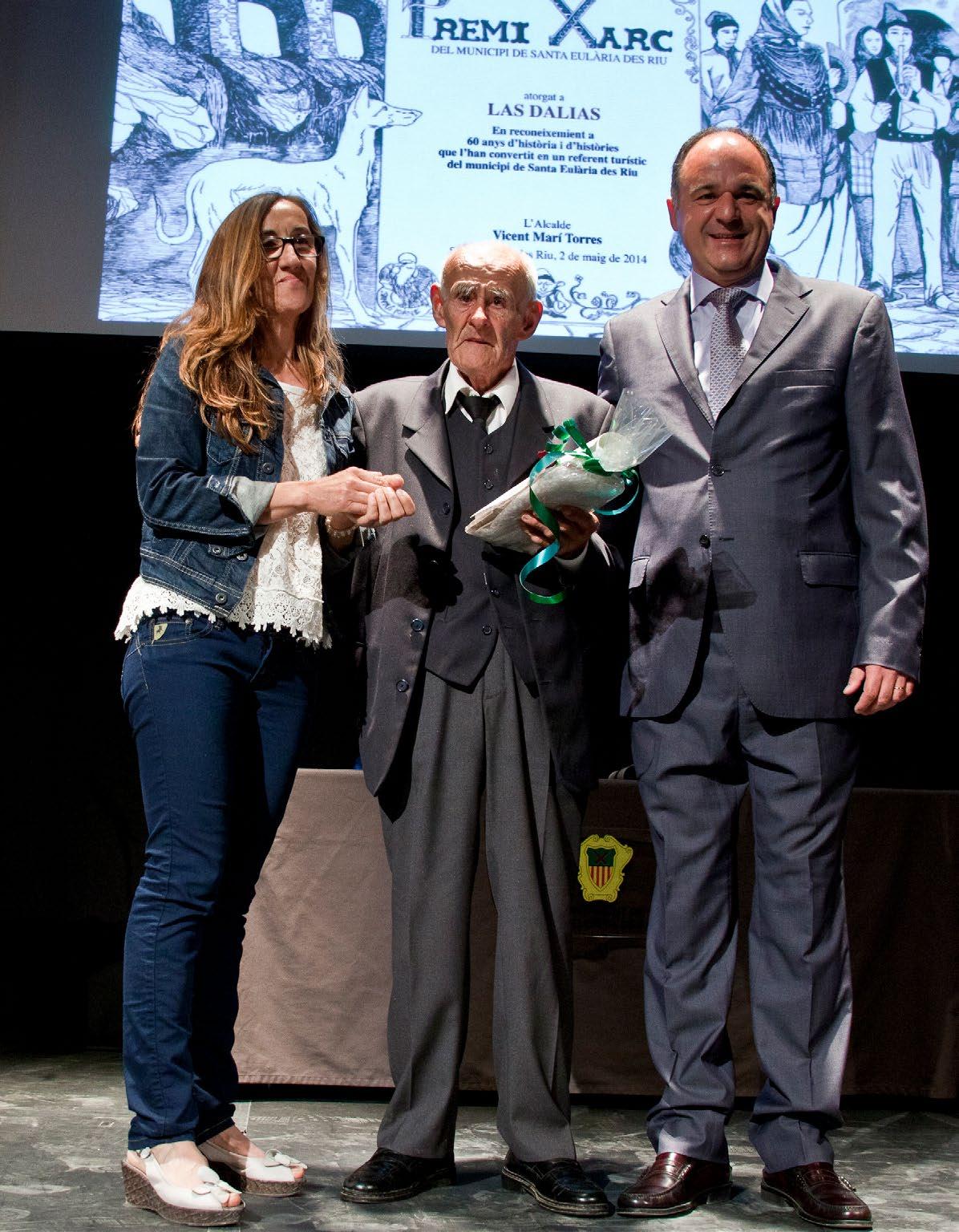 Lucía Marí, Juan Marí Juan y Vicent Marí, en la entrega de los Premios Xarc del Ayuntamiento de Santa Eulària.
Lucía Marí, Juan Marí Juan y Vicent Marí, en la entrega de los Premios Xarc del Ayuntamiento de Santa Eulària.
El Govern de les Illes Balears concedió a Las Dalias el Premio de Turismo 2016 por su contribución a la imagen exterior de las islas. Y es que, desde su nacimiento en 1954, Las Dalias ha sabido adaptarse a las tendencias, evolucionar y convertirse en referencia internacional de Ibiza.
El Ayuntamiento de Santa Eulària reconoció en 2014 la labor de promoción turística de Las Dalias. El alcalde, Vicent Marí, entregó al fundador, Juan Marí Juan, la placa que acredita a Las Dalias como Lugar de Interés Turístico Municipal.
El Ayuntamiento de Santa Eulària otorgó a Las Dalias el Premio Xarc en 2014, un galardón con el que distingue a las personas o entidades del municipio que sobresalen por su trayectoria profesional y proyección social, cultural y artística. El fundador, Juan Marí Juan, y su hija Lucía Marí recogieron el premio en una emotiva ceremonia.
Premio Posidonia de la Cámara de Comercio a la Excelencia Empresarial 2013
La Cámara de Comercio, Industria y Navegación de Ibiza y Formentera concedió a Las Dalias el Premio Posidonia 2013 a la Excelencia Empresarial. La Cámara reconoció así la trayectoria de la marca y su contribución a la dinamización de la economía insular y al turismo de Ibiza, así como la revitalización de la imagen de la isla asociada al mercadillo y a las actividades culturales que acoge.
En 2008, la Escuela de Turismo distinguió a Las Dalias con el Premio a la Creatividad e Innovación, destacando su evolución desde 1954 y el hecho de que el mercadillo se ha convertido en “un perfecto mestizaje de nacionalidades y culturas, conviviendo pacíficamente y proyectando una imagen colorista y positiva de la isla”.
The Govern de les Illes Balears awarded Las Dalias the 2016 Tourism Award for its outstanding contribution to the image of the islands abroad. In fact, since its inception in 1954, Las Dalias has managed to adapt to trends, evolve and become an international flagship for Ibiza.
Santa Eulària Town Council in 2014
In 2014, the Santa Eulària Town Council acknowledged the work of Las Dalias in promoting tourism. The Mayor, Vicent Marí, presented the founder, Juan Marí Juan, with a plaque designating Las Dalias a Site of Municipal Tourism Interest.
In 2014, the Santa Eulària Town Council awarded Las Dalias the Xarc Award, which honours individuals or organisations within the municipality that stand out for their professional achievements and their social, cultural and artistic importance. The founder of Las Dalias, Juan Marí Juan, and his daughter, Lucía Marí, were there to receive the award during a moving ceremony.
Chamber of Commerce 2013 Posidonia Award for Business Excellence
The Chamber of Commerce, Industry and Navigation of Ibiza and Formentera awarded Las Dalias the 2013 Posidonia Award for Business Excellence. In doing so, the institution recognised the long history of the brand and its positive contribution to the economy and tourism in Ibiza, as well as the revitalisation of the island’s image in association with the flea market and the cultural activities that it hosts.
In 2008, the School of Tourism presented Las Dalias with the Award for Creativity and Innovation, underscoring the company’s evolution since 1954 and the fact that the flea market has become “an ideal melting pot of nationalities and cultures that peacefully coexist and project a colourful and positive image of the island”.

TU SUPERMERCADO EN SAN CARLOS
CARRETERA SAN CARLOS KM 12 SANTA EULALIA DEL RÍO
Entiendo la filosofía como una técnica cuyo material principal de trabajo son las ideas filosóficas, al igual que las areniscas son de la arquitectura, los números de las matemáticas, las medicinas del médico o los cuantos de la física cuántica.
La cosa se complica cuando hablamos de otras realidades; cuál es la técnica para las emociones o los sentimientos. Podemos decir la psicología o la neurociencia. Y se complica más si cogemos lo que entendemos por amor. ¿Cuál es la técnica que se ocupa del amor? Estaremos de acuerdo en que no hay una técnica que se ocupe fundamentalmente del amor.
Esto ubica al amor en una posición sobre la cual muchas técnicas quieren hacerle materia para sí mismas: religiones, cosmovisiones, filosofías, terapias, sectas, teorías, ciencias… Cada una de ellas expondrá sus argumentos para ubicar la idea de amor en su corpus, con una propuesta de la posición del amor en el mundo que proponen. A partir de aquí, todo lo que puede decirse sobre el amor estará sometido a los parámetros de la visión del mundo que le dé su lugar.
Kant nos enseñó que una visión del mundo, cualquiera que sea, está organizada sobre tres ideas principales: la referida a las experiencias internas del yo, la referida a la experiencia del mundo externo y un tercer grupo que reúne todas las ideas que los otros dos grupos no pueden abarcar. Por ejemplo, las ideas de infinito, perfección, libertad, sentido o amor (si extraemos esta última de no ser más que una experiencia meramente psicológica, biológica o corporal).
I view philosophy as a technique in which philosophical ideas are the main work materials, the way sandstone is for architecture, numbers for mathematics, medicine for the doctor and quanta for quantum physics.
It becomes more complex when we are talking about other realities; like what technique handles emotions or feelings? We could say that would be psychology or neuroscience. And it becomes still more complex if we think about what we understand to be love. What is the technique that takes in love? We may agree that there is no technique that fundamentally works with love.
This makes love susceptible to be coopted by many different techniques: religions, worldviews, philosophies, therapies, cults, theories, sciences, etc. Each will present its reasoning for the use of the concept of love within its own corpus, with a proposed position of love in the world that it advocates. From there on, everything that can be said about love will be subjected to the parameters of the worldview that gives it its place.
Kant taught us that any worldview is structured around three main ideas: the idea pertaining to the internal experiences of the self, the idea pertaining to the experience of the external world, and a third group that brings together all the ideas that cannot be contained by the other two groups. For example, the ideas of infinity, perfection, freedom, meaning and love (if we consider the latter as something more than a merely psychological, biological or bodily experience).

¿Y cuál es el lugar de la idea de amor en mi visión del mundo?
Como intentaré mostrar, por definición, la existencia, muy en el fondo, es un juego y a mí hoy me gusta jugar con las ideas filosóficas, entre ellas la del amor. ¿Y qué supuesto referente le otorgo en el mundo?
Nuestra experiencia humana está radicalmente condicionada por la idea de que el mundo tiene un origen o un inicio (big bang, dios…) o, si se le considera sin principio ni fin, que tiene unas sustancias o esencias fundamentales y primigenias de las cuales luego se deriva o se permea lo demás. Una idea muy extendida es que el amor es una de ellas.
Muchas experiencias filosóficas, religiosas y místicas ubican al amor en el origen, en lo sustancial, lo esencial o fundamental. En muchas corrientes de sabiduría y conocimiento, esa fuerza o motor principal que lo mueve todo compite con otras propuestas de esencias fundamentales además del amor. Al amor se le hace convivir con la voluntad, la energía, la inteligencia, la conciencia, dios… Todas estas ideas pueden jugar como cartas fundamentales en el juego de la vida para explicarnos y acomodarnos en un marco
And what is the place for the idea of love in my vision of the world?
As I will attempt to demonstrate, the very essence of existence is ultimately, by definition, a game; and today I am enjoying playing with philosophical ideas, and among them, that of love. And what sort of reference point do I assign to it in the world?
Our human experience is radically conditioned by the notion that there was a beginning or origin to the world (the Big Bang, God, etc.). Alternatively, if we deem it to have neither a beginning nor an end, we are influenced by the idea of the world as having some fundamental and primordial substances or essences from which all other things then derive or emanate. It is often widely believed that love is one of those essential elements.
In fact, love is viewed as the basic, essential substance and source of many philosophical, religious and mystical experiences. In many schools of thought, that primary driving force that moves everything competes with other concepts of fundamental essence, in addition to love. Love is made to coexist with volition, energy, intelligence, consciousness and God, among others. All these ideas can act as the
que nos permita vivir con cierto sentido. Sensu stricto, eso es solo una idea que nos ubica la experiencia de amor que tenemos en la existencia.
Sea como sea que ubiquemos al amor en nuestro juego de la vida, ya sea una esencia única, una esencia entre otras o un condimento más entre los muchos de las experiencias del mundo, sí parece claro que el amor acontece con el inexorable paso del tiempo, el cual actuará al igual que con otras sustancias, como acompañante. En coordenadas einstenianas podemos hablar de una sustancia espaciotemporal, es decir, que el tiempo además de sucesión es extensión y, por lo tanto, el amor, en lo que tiene de espacio temporal, sucede y se extiende (o se contrae).
Mi posición, frente a la existencia de un origen, es que la espaciotemporalidad es eterna dándose infinitos sucesos y extensiones o contracciones.
¿Y qué sucede cuando un ser humano en particular dispone de todo el tiempo del mundo? Que se enfrenta al aburrimiento como forma sustancial. El mundo se aburre. ¿Y qué podemos hacer para sobrellevar ese momento de aburrimiento? Además de aceptarlo y, en ocasiones, sumergirnos en él como parte de las experiencias, es común que los seres humanos luchen contra él. Que la existencia luche contra él. ¿Cómo? Como los niños. Además de olvidando, jugando.
Y es en este juego infinito del niño, donde la existencia se ve obligada a abrirse a todas las posibilidades, desde las más sublimes hasta las más abominables y es en este juego del niño donde surge el amor fati como acomodo en todo lo que ocurre, incluso lo más doloroso, creando nuestras propias reglas y significados en nuestras visiones del juego de la vida. Podría no ser así, en algún momento no era así y en algún momento no será así y volverá a ser así, en este eterno retorno de lo mismo consecuencia de la existencia, que es tan eterna que da tiempo a que vuelva a ocurrir lo mismo. Incluso en el amor.

fundamental playing cards in the game of life, to explain and fit us into a framework that allows us to live with a certain sense of meaning. Strictly speaking, this is merely an idea that positions our experience of the love in our existence.
Regardless of how we choose to position love in our game of life, whether as a single essence, an essence among others, or just another flavour among the many that form part of our experiences of the world, it does seem clear that love takes place with the inexorable passage of time, which will act as a companion, as it does with other substances. In Einsteinian coordinates, we can speak of a spacetime substance, meaning that time is not only a sequence, but also an expansion; therefore, in terms of the space-time continuum, love happens and expands (or contracts).
From my perspective regarding the existence of an origin, the spacetime continuum is eternal, with infinite events and infinite expansions and contractions.
So what happens when a given human being has all the time in the world? They find themselves confronted with boredom as a form of substance. And what can one do to overcome that moment of boredom? Apart from accepting it and at times diving into it as part of our experience, human beings often fight it. How? The way children do. Not only by forgetting, but also by playing.
And it is in that child’s endless game where existence is forced to open up to all possibility, from the most sublime to the most abominable. And it is also in that child’s game where amor fati emerges as solace to everything that happens, including the most painful events, creating our own rules and meanings in our conceptions of the game of life. It may not be so, at some point it was not so, and at some point in the future it will not be so, and it will be so again, in this eternal return to the same, the consequence of existence, which is so eternal that it allows time for the same thing to happen again. Even in love.
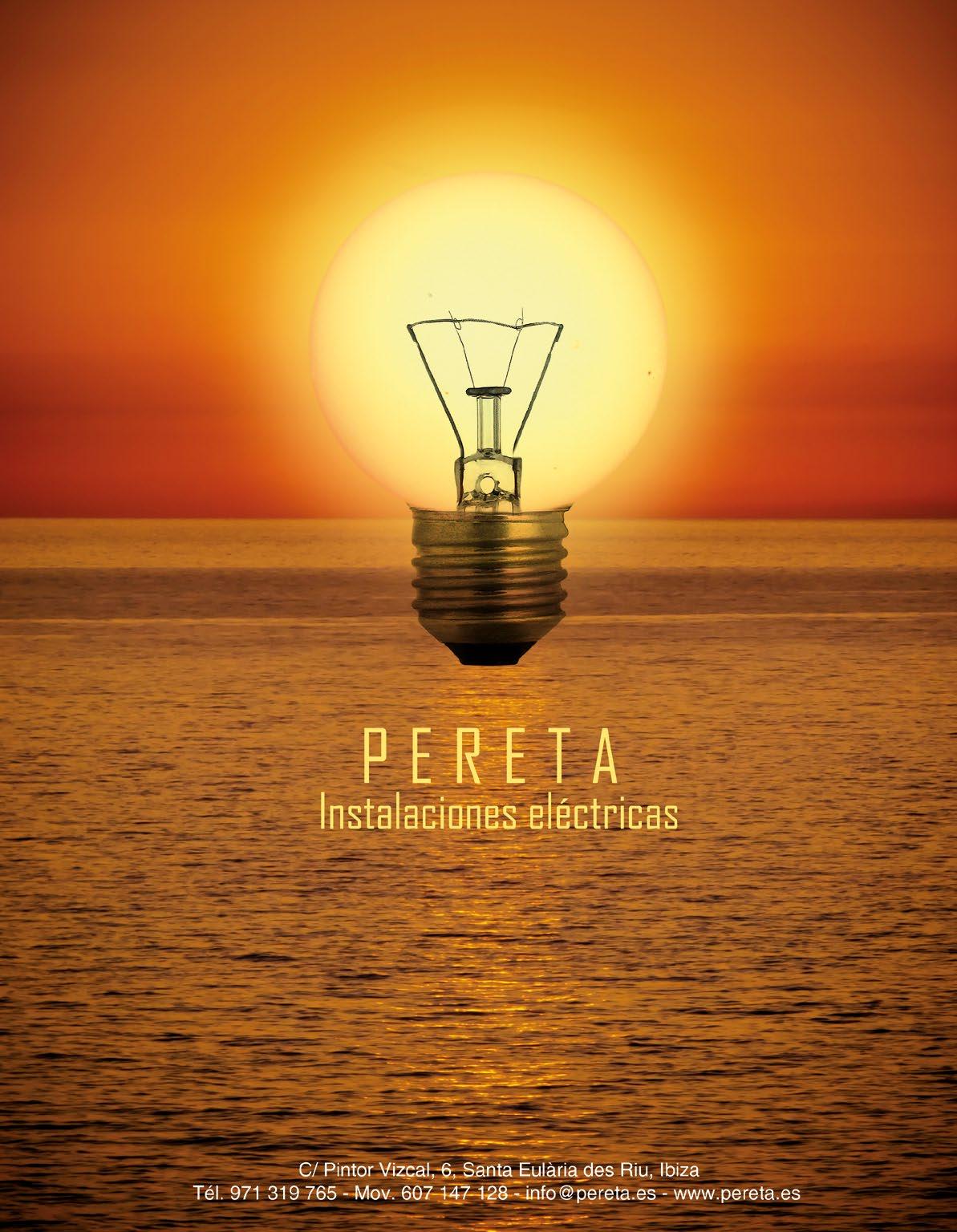


La sala Akasha cumple dos años mirando al futuro pero también es el momento de recordar de dónde venimos: de aquellos bailes de los años 50, en pleno franquismo, cuando Las Dalias ofrecía un punto de encuentro y fiesta a una juventud sedienta de diversión.
The Akasha room celebrates its second anniversary looking towards the future, but it’s also a moment to remember our roots: from the dances of the 1950s, during Franco’s regime, when Las Dalias provided a meeting point and a party for a youth thirsty for fun.
70 YEARS PULSING TO THE RHYTHM OF THE TIMES

Metonimia. Un detalle, una palabra, la parte que se asocia con un todo, que al escucharse evoca automáticamente un concepto mayor. Las Dalias tiene ese poder. Inmediatamente trae a la mente el local y su atmósfera única, la sucesión de estancias y rincones, la gente que conforma una vivencia muy personal. Pero provoca mucho más, un sentimiento de comunidad que trasciende décadas y modas, que entra por la puerta más directa al alma, a lomos del caballo desbocado de la música. Las Dalias ha palpitado siempre al ritmo de los tiempos y ya van 70 años. Del salón de baile que convocaba a los jóvenes de alrededor para marcarse un agarrado, a los maestros de los platos que se turnan en la cabina de Akasha. La música no para. No parará.
Metonymy. A detail, a word, the part associated with a whole, that when heard automatically evokes a greater concept. Las Dalias possesses that power. It immediately conjures the venue and its unique atmosphere, the succession of rooms and corners, the people who form a very personal experience. But it evokes much more, a sense of community that transcends decades and fashions, that enters through the most direct door to the soul, on the back of the runaway horse of music. Las Dalias has always pulsed to the rhythm of the times, and it’s been 70 years. From the dance hall that summoned young people from around to dance together, to the masters of the turntables who take turns in the Akasha booth. The music doesn’t stop. It won’t stop.

Con las décadas doradas de los 80 y 90, el norte de la isla se convierte en la meca de músicos de medio mundo que acudían a grabar sus discos. La inspiración llega en cualquier sitio, pero para traducir eso a sonido casi no había mejor sitio en el mundo que los Estudios Mediterráneo, en una enorme casa payesa de Sant Llorenç. Frankie Goes To Hollywood, Paul Young, Nina Hagen, Nena, Kathryn and The Waves, New Order, Happy Mondays, Judas Priest o Sham 69 son algunas de las rutilantes estrellas de una constelación de bandas que pasaron por allí. Su director durante varios años, Mariskal Romero, y Las Dalias formaron una alianza simbiótica que alumbró una era de conciertos de bandas punteras como nunca antes se había vivido en la isla y en el sitio menos esperado. Entre ellos, Barricada, Medina Azahara, Ángeles del Infierno, Revólver, Los Rebeldes, La Frontera o Sangre Azul, que impresionaron al mismísimo Brian May en la sala, sin olvidar el desembarco argentino que siguió al gran Charly García: Moris, Celeste Carballo o Los Abuelos De La Nada, con un imberbe Andrés Calamaro a los teclados de los de Miguel Abuelo.

El acuerdo se convirtió en una especie de ritual: según acababan de grabar, se subían al escenario de Las Dalias para tocar los nuevos temas. Así ajustaban su directo para las giras y, a cambio, la chiquillada local tenía la oportunidad única de escucharles a un precio increíblemente bajo por obra y gracia de Juanito Marí.
El matrimonio alumbraría también una pléyade de bandas locales que se foguearían teloneando a los foráneos, con músicos como Victor Gresely; Jon Michel (que evolucionará hasta ser uno de los creadores de Namasté); Joan Barbé; Cristóbal Mascaró; David Serra; Manolo Díaz con años de giras con grandes como Ariel Roth, Raimundo Amador o Nacho García Vega a sus espaldas; Miquel Botja; Dennis Herman o Cayetano Sánchez, tan bueno que el padre del power pop, Paul Collins, se lo quiso llevar a Nueva York.
With the golden decades of the ‘80s and ‘90s, the north of the island becomes the mecca for musicians from around the world who came to record their albums. Inspiration can strike anywhere, but when it comes to translating that into sound, few places in the world rivalled Estudios Mediterráneo. Housed in a vast traditional farmhouse in Sant Llorenç, it welcomed a constellation of bands, including Frankie Goes to Hollywood, Paul Young, Nina Hagen, Nena, Kathryn and The Waves, New Order, Happy Mondays, Judas Priest and Sham 69. For several years, its director, Mariskal Romero, and Las Dalias formed a symbiotic alliance that brought a new era of concerts by leading bands, an experience unlike anything the island had ever seen, and in the least expected place. Among them were Barricada, Medina Azahara, Ángeles del Infierno, Revólver, Los Rebeldes, La Frontera and Sangre Azul, who even impressed Brian May in the hall. Not to forget the Argentine musicians who followed Charly García’s footsteps: Moris, Celeste Carballo and Los Abuelos De La Nada, with a young Andrés Calamaro on keyboards from Miguel Abuelo’s band.
LAS DALIAS FORMARON JUNTO A ESTUDIOS MEDITERRÁNEO
UNA ERA DE CONCIERTOS DE BANDAS
PUNTERAS COMO NUNCA ANTES
SE HABÍA VIVIDO EN LA ISLA
The routine became a kind of ritual: after finishing a recording, they would perform on the Las Dalias stage to showcase their new tracks. This helped them refine their live shows for tours, and in return, local youngsters could hear them at incredibly low prices, thanks to Juanito Marí.
The marriage also gave rise to a multitude of local bands that honed their skills by opening for international acts, featuring musicians like Victor Gresely; Jon Mitchel (who would later become one of the creators of Namasté); Joan Barbé; Cristóbal Mascaró; David Serra; Manolo Díaz, who had toured with greats like Ariel Roth, Raimundo Amador and Nacho García Vega; Miquel Botja; Dennis Herman; and Cayetano Sánchez, so talented that the father of power pop, Paul Collins, wanted to take him back to New York.

Barricada en Estudios Mediterráneo. Foto de www.barricada.net

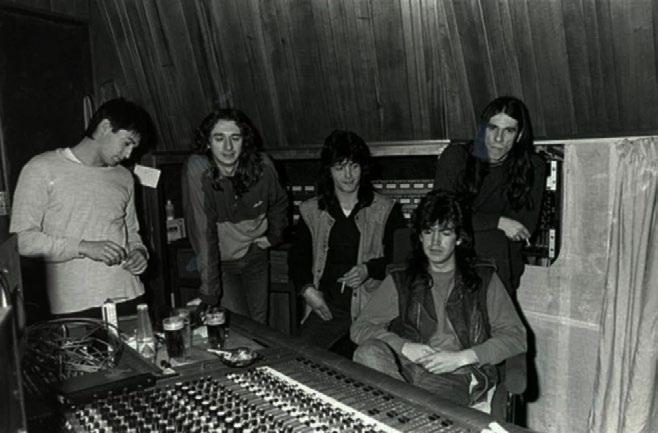



Y todos esos nombres son importantes porque forman parte de esa celebración de la música que fueron en esos años los tributos musicales, que empezaron en Las Dalias y llegaron a tomar las plazas de la isla. John Lennon, al que lograrían que se le dedicara una calle en Santa Eulària, Police, The Rolling Stones, Creedence Clearwater Revival, Pink Floyd o el mismísimo día en que la música murió, el 3 de febrero de 1959, fueron el leit motiv de sesiones épicas para las que se contó con apariciones estelares de artistas como Loquillo, Carlos Segarra, Javi Andreu y otros tantos que lo dejaban todo para tocar con sus amigos de la isla, tan implicados como Díaz, que dejó a su pareja recién parida para no faltar a la cita de esa noche: el homenaje a Lennon. «¡Ha sido niño!», anunció mientras se aseguraba la guitarra para alborozo general mientras empezaba a tocar ‘Ticket to Ride’. Aquello era una familia.
LOQUILLO, CARLOS SEGARRA, JAVI ANDREU Y OTROS TANTOS
Llegarían después los desayunos reggae, con Glasford, las tardes con Manolo Fernández mientras se inventaba el flamenco chill y los anocheceres con Lenny Ibizarre, Joan Ribas y el nacimiento de una escena diferente, espiritual y orgánica, en lo que empezó siendo el punto de encuentro de los artesanos de la isla y cristalizó en Namasté con Merel y Alok. Todo ello salpimentado con conciertos algo más esporádicos con Nacho García Vega, Parkinson DC, Vídeo, Paul Collins o el carismático Lee Rocker, el contrabajista de Stray Cats, sin olvidar a Las Mentiras, el dúo creado ad hoc con Álex Olmedo para un bolo a dos guitarras en el jardín y que anticipó la segunda juventud de Coque Malla. O el gran Javier Vargas, que llegó desamparado con dos americanos y acabó tocando todo el verano. El resto es la historia de una amistad que le hace volver siempre.
All these names are significant because they were part of the musical tribute celebrations that characterised those years, starting at Las Dalias and eventually expanding to the squares of the island. John Lennon, who was honoured with a street in Santa Eulària, Police, The Rolling Stones, Creedence Clearwater Revival, Pink Floyd and even the day the music died, 3 February 1959, were the inspiration for epic sessions featuring appearances by artists like Loquillo, Carlos Segarra, Javi Andreu and many others who were dedicated to playing with their friends from the island. They were as committed as Díaz, who left his newborn to ensure he didn’t miss the Lennon tribute that night. ‘I’ve had a baby!’ he announced, securing his guitar to the cheers of the crowd as he began to play ‘Ticket to Ride’. It was a family.
The reggae breakfasts came later, with Glasford; afternoons with Manolo Fernández as he invented flamenco chill; and evenings with Lenny Ibizarre, Joan Ribas and the birth of a different, spiritual and organic scene. It all began as a meeting point for the island’s artisans and crystallised into Namasté with Merel and Alok. This was complemented by more sporadic concerts featuring Nacho García Vega, Parkinson DC, Vídeo, Paul Collins and the charismatic Lee Rocker, the bassist of Stray Cats. Not to mention Las Mentiras, the duo created ad hoc with Álex Olmedo for a two-guitar gig in the garden, which anticipated Coque Malla’s second youth. Javier Vargas, who arrived destitute with two Americans and ended up playing all summer, added to the mix. The rest is the story of a friendship that always brings him back.
Over the years, Las Dalias has regularly filled up with live music again, riding the waves of fusion and mischief with friends of the house like Mari from Chambao, Juanito Makandé, Muchachito Bombo Inferno, Amparanoia, el Canijo de Jerez, Tomasito and los Canteca de Macao, before and after breaking up in a final concert, of course, in the garden. Albert Pla, Concha Buika, la Pegatina and even the one and only Wyoming have their place. Once again, the transatlantic wave returns, with La Bersuit and Los Auténticos Decadentes among the perpetrators of new memorable nights. In a list like this, we cannot forget the creator of hits that stir the conscience, Dani Macaco, or the greatest of all those musicians with big hearts and open ears, Manu Chao, for whom Las Dalias became too small. That night in May 2015 is one of those that you treasure for a lifetime just to say, ‘I was there’.

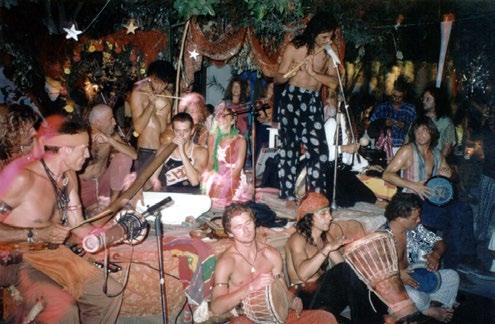




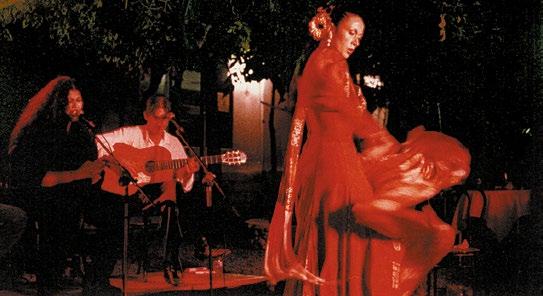
Con los años, Las Dalias se vuelve a llenar regularmente de música en vivo, a lomos del mestizaje y el canalleo con amigos de la casa como la Mari de Chambao, Juanito Makandé, Muchachito Bombo Inferno, Amparanoia, el Canijo de Jerez, Tomasito o los Canteca de Macao, antes y después de descomponerse en un último concierto, como no, en el jardín. Albert Pla, Concha Buika, la Pegatina o hasta el mismísimo Wyoming tienen su sitio. De nuevo vuelve la onda transatlántica, con La Bersuit o Los Auténticos Decadentes entre los perpetradores de nuevas noches memorables. En una lista así no puede faltar tampoco el creador de hits que agitan la conciencia, Dani Macaco, ni el más grande de todos esos músicos de corazones grandes y orejas abiertas, Manu Chao, para quien el recinto de Las Dalias se quedó pequeño. Esa noche de mayo de 2015 es de las que se atesoran toda una vida para decir aquello de «estuve allí».
Hay más casos. Prácticamente todos los boomers de la isla sostienen haber estado en aquel mítico concierto de Bob Marley en Ibiza, aunque la plaza de toros estaba muy lejos de estar llena. La cuenta no sale pero lo rigurosamente cierto es que para cenar esa noche, el jamaicano y su séquito eligieron Las Dalias. Donde han estado infinidad de veces y casi siempre por separado los integrantes de los Rolling Stones o Bob Geldoff, Mike Olfield, Roger Taylor, Dave Holland —quien incluso se animó a organizar un gran concierto, Rock Night, que acabó en fiasco empresarial— y tantos otros. ¿Qué les atrae? ¿La comunidad, la atmósfera que se respira, la música que la evoca?
Para explicarlo, lo mejor es hacerlo desde el principio. Cuando un carpintero dejó el cincel para meterse a hostelero con un nuevo local que abrió pegado al camino que lleva a la exigua aldea de Sant Carles (poco más que dos casas, una tienda, el camposanto y la blanca iglesia ciclópea). Juan Marí tenía claro que en su local quería música y programó bailes desde el principio en el pequeño tinglado de ramas de pino de detrás del bar. Juan Dalias, como se le conoció pronto, se esmeró en traer a lo más granado de la isla, incluso apadrinó la formación de bandas como los HiFi, integrada por gente de Sant Carles con Toni Colomar a la cabeza. Debían haber actuado en la inauguración (el 4 de noviembre de 1954) pero llegaron tarde para acumular las cuatro horas de repertorio que
There are more stories. Practically all the boomers on the island claim to have been at that legendary Bob Marley concert in Ibiza, although the bullring was far from being full. The numbers don’t add up, but what is rigorously true is that for dinner that night, the Jamaican and his entourage chose Las Dalias. The members of the Rolling Stones, not to mention Bob Geldoff, Mike Olfield, Roger Taylor, Dave Holland—who even dared to organise a big concert, Rock Night, which ended in a business fiasco—and many others have visited countless times, almost always separately. What attracts them? The community, the atmosphere, the music that evokes it?
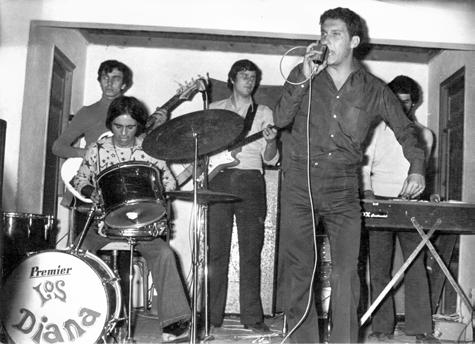
To explain, it’s best to start from the beginning. Back when a carpenter set aside his chisel to become a host with a new venue he opened next to the road that leads to the tiny village of Sant Carles (little more than two houses, a shop, the cemetery and the white cyclopean church). Juan Marí knew that he wanted music in his venue, and he scheduled dances from the beginning in the small pine branch shed behind the bar. Juan Dalias, as he soon became known, made an effort to bring the best of the island, even sponsoring the formation of bands like HiFi, made up of people from Sant Carles with Toni Colomar at the helm. They were supposed to perform at the opening (on 4 November 1954) but they arrived late to accumulate the four hours of repertoire they needed and didn’t debut until Christmas Eve. And there they played for the next 12 years. Going to the dance became another way of announcing that one was going to Las Dalias for those long sessions of light music.
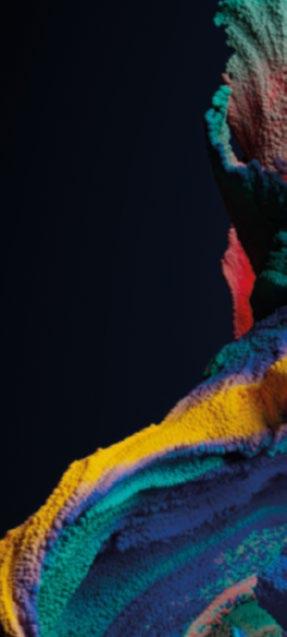
















EVERY WEDNESDAY FROM 29 MAY TO 09 OCT











necesitaban y no debutaron hasta Nochebuena. Y ahí tocaron durante los 12 años siguientes. Ir al baile se convirtió en otra forma de anunciar que se acudía a las Dalias para esas largas sesiones de música ligera.
A GRUPOS COMO LOS TRES DE LA ISLA, LOS BASURONS O LOS DIANA, LA BANDA QUE CREARON PEPE
GAMBA Y EL RECIENTEMENTE
DESAPARECIDO TITO ZORNOZA
La nómina de músicos incluyó a grupos como Los Tres de la Isla, los Basurons o Los Diana, el grupo de Pepe Gamba y el recientemente desaparecido Tito Zornoza, que empezaron siendo casi niños, tanto que había que ir a buscarlos a la ciudad de Ibiza con toda su impedimenta. Juan se ocupaba de darles una buena merienda antes de actuar y siempre los consideró el mejor grupo que ha tocado allí.
Pero el inquieto Juan Marí ya pensaba en el siguiente salto, aprovechando el incipiente turismo: la barbacoa. Aquello atrajo colas de autobuses en saraos organizados con Viajes Ibiza. Por 125 pesetas, 75 céntimos de euro, incluía pollo au gogó, vino y sangría hasta bien entrada la madrugada con músicos como Es Macs o Es Amics. Se llegaban a juntar medio millar de turistas, todos muy bien vestidos. Juan Dalias también fue pionero en buscar fuera grupos prometedores, como los Shox, Los Yonders, Los Llamas o los Àngels Blaus, incluso un cuadro flamenco granaíno
Ahora, Akasha. El salón de bodas, bailes, musicales y conciertos se reinventa para llevar la experiencia al siguiente nivel gracias a la tecnología y al talento que acepta el reto de sacarle todo el jugo. Imagina una acústica que no agreda los sentidos, con subwoofers personalizados, y capaz de inyectar de forma natural ese sonido prístino y sin distorsiones, usando tu cuerpo como caja de resonancia. Y que el encargado de hacerte llegar esas oleadas sensoriales sea Sven Väth o Hernán Cattaneo. Con invitados de la talla de Jan Blomqvist, Laurent Garnier, Groove Armada o Fatboy Slim. Elevar la música a lo más orgánico, emoción pura, y compartirlo. Eso es comunidad.
The roster of musicians included groups like Los Tres de la Isla, Los Basurons and Los Diana, as well as Pepe Gamba’s group and the recently deceased Tito Zornoza, who started when they were practically children, to the extent that they had to be fetched from the city of Ibiza with all their gear. Juan made sure to give them a good snack before performing and always considered them the best group to have played there.
However, the restless Juan Marí was already contemplating the next step, capitalising on the growing tourism: the barbecue. This drew busloads of people to events organised with Viajes Ibiza. For 125 pesetas, 75 cents, it included all-youcan-eat chicken, wine and sangria until well into the early hours, with musicians like Es Macs and Es Amics. Up to five hundred tourists would gather, all dressed very elegantly. Juan Dalias was also a pioneer in scouting promising groups from other places, such as the Shox, Los Yonders, Los Llamas and the Àngels Blaus, and even a flamenco group from Granada.
HOWEVER,
THE RESTLESS JUAN MARÍ WAS ALREADY CONTEMPLATING THE NEXT STEP, CAPITALISING ON THE GROWING TOURISM: THE BARBECUE. THIS DREW BUSLOADS OF PEOPLE TO EVENTS ORGANISED WITH VIAJES IBIZA
Now, Akasha. The wedding hall, dances, musicals and concerts are reinvented to elevate the experience thanks to technology and talent that embrace the challenge of maximising its potential. Imagine acoustics that don’t assault the senses, with customised subwoofers capable of naturally injecting pristine, distortion-free sound, using your body as a resonating chamber. And imagine that the one delivering these sensory waves is Sven Väth or Hernán Cattaneo, with guests like Jan Blomqvist, Laurent Garnier, Groove Armada and Fatboy Slim. This is about elevating music to its most organic, pure form of emotion, and sharing it. That’s what community is all about.





EXPLORING THE SOUNDS OF IBIZA.
AKASHA ELEVATES THE ELECTRONIC EXPERIENCE

En el corazón vibrante de Ibiza, un lugar emerge como el epicentro de la música electrónica de vanguardia y la cultura de club: Akasha y su Ibiza Sound Movement.
Este espacio meticulosamente diseñado y con una programación estudiada y coherente es mucho más que un simple club; es un santuario sonoro donde los ritmos eclécticos y la calidad excepcional del sonido se unen para crear una experiencia única.
At the beating heart of Ibiza, one place emerges as the epicentre of cuttingedge electronic music and club culture: Akasha and its Ibiza Sound Movement.
This meticulously designed venue with its thoughtful, coherent programming is much more than just a club; it’s a haven of sound where eclectic rhythms and exceptional sound quality come together to create a unique experience.

En Akasha, la selección de artistas es un arte en sí mismo. Cada nombre en el cartel es cuidadosamente seleccionado para explorar una amplia gama de géneros electrónicos. Desde talentos locales emergentes hasta iconos internacionales de la escena, el objetivo esencial es fomentar una comunidad de artistas y amantes de la música, moldeando una identidad sonora que resuena con un estilo orgánico incomparable. Las fiestas Namasté, Ethereal y Nido se han vuelto ya religión para sus fans, mientras que una lista increíble de dj, entre los que brillan nombres como los de Fatboy Slim, Sven Väth, Luciano, Jan Blomqvist, Damian Lazarus, Dubfire o HOSH, elevan la experiencia.
Dentro de las paredes de Akasha, cada detalle está meticulosamente diseñado para crear una experiencia inmersiva y memorable. Desde el diseño interior hasta la producción de eventos, todo se cuida para garantizar que los asistentes sean transportados a un mundo de música y comunidad. Más que un lugar para bailar, Akasha aspira a ser un punto de encuentro donde se forjen conexiones y se celebre la pasión por la música electrónica.
En el corazón de esta experiencia se encuentra el sonido. Potenciado por THE SOUND IBIZA (TSI), el sistema de altavoces personalizados y subwoofers, que crea una experiencia auditiva incomparable. Libre de distorsiones y con una potencia cautivadora, el sonido en Akasha se convierte en una fuerza viva que no solo se escucha, sino que se siente.
Además de ser un destino para los amantes de la música electrónica, Akasha se involucra en la comunidad con eventos puntuales de sanación a través del sonido y viajes visuales, en los que la música se convierte en una herramienta para la elevación espiritual y la conexión humana.
En definitiva, Akasha no es solo un club, es un movimiento dedicado a elevar la experiencia electrónica a nuevas alturas.
At Akasha, the selection of artists is an art in itself. Each name on the line-up is carefully chosen to explore a wide range of electronic genres. From emerging local talent to international icons of the electronic scene, the essential aim is to foster a community of artists and lovers of music, shaping an identity of sound that resonates with an incomparable organic style. The Namaste, Ethereal and Nido parties have become like a religion for fans, whilst an incredible DJ roster, including names such as Fatboy Slim, Sven Väth, Luciano, Jan Blomqvist, Damian Lazarus, Dubfire and HOSH, truly elevate the experience.
PAREDES DE AKASHA, CADA DETALLE ESTÁ METICULOSAMENTE DISEÑADO
Within the walls of Akasha, every detail is meticulously planned to create a memorable immersive experience. From interior design to event production, everything is taken care of to ensure that clients are transported into a world of music and community. More than just a place to dance, Akasha aspires to be a meeting point where connections are forged and a passion for electronic music is celebrated.
At the heart of this experience is sound, which is powered by THE SOUND IBIZA (TSI), the custom speaker and subwoofer system that creates an unparalleled listening experience. Free from distortion and with captivating power, Akasha’s sound becomes a living force that’s not only heard but also felt.
As well as being THE place to go for fans of electronic music, Akasha is also involved in the local community with special sound healing events and visual journeys, in which music becomes a means of spiritual upliftment and human connection.
Ultimately, Akasha’s more than just a club; it’s a movement dedicated to elevating the electronic experience to new heights.
lasdalias.es

akashaibiza.com

EDITA: LAS DALIAS
DIRECCIÓN Y PRODUCCIÓN: Laura Ferrer Arambarri
AUTORAS Y AUTORES INVITADOS: Carme Chaparro, Antonio Colinas, Ben Clark, Rodrigo Blanco Calderón, Javier Serapio, Pablo Sierra del Sol y Eva Tur Antonio
REDACCIÓN: Cristina Marí, Silvia Castillo, Pablo Sierra del Sol, Xescu Prats, Felip Cirer, Antonio Martínez Beneyto y Laura Ferrer Arambarri
FOTOGRAFÍA: Arsen Voronyy, Vicente Luis Marí, Ximena Topolansky, Pedro Sebastián Candela, Jordi Serapio y Alejandro Iborra Ventura
DOCUMENTACIÓN: Pere Seguí
DISEÑO/MAQUETACIÓN: Sergio G. Barragán y Ruth Prieto
ILUSTRACIONES: Marcos Torres, Untaltoni, José Ramón Lapuerta, Sergio G. Barragán
CÓMIC: Aura Gold
PORTADA: Marcos Torres
TRADUCCIONES: Mallol i Associats y Ben Clark
JURADO DEL PREMIO INTERNACIONAL DE CUENTO ‘LAS DALIAS’: Maribel Andrés Llamero, Laura Ferrer Arambarri y Ben Clark, coordinador del concurso
PUBLICIDAD: David Ferrer Serra y Luisa Reyes
¿HABLAMOS?: Las Dalias (+34) 971 326 825
www.lasdalias.es / magazine@lasdalias.es
IMPRIME: Rotimpres / DL: I-85-2013
AGRADECIMIENTOS: Consell Insular d’Eivissa, Consell de Formentera, Ajuntament de Santa Eulària des Riu, Ajuntament d’Eivissa, Ajuntament de Sant Antoni de Portmany, Ajuntament de Sant Josep de sa Talaia y Ajuntament de Sant Joan de Labritja, a Las Dalias Team y a todas las empresas de Ibiza y Formentera que respaldan nuestras iniciativas. Un agradecimiento muy especial a las familias de Sant Carles que han cedido imágenes de sus álbumes familiares de las primeras bodas y celebraciones en el restaurante de Las Dalias
